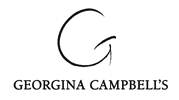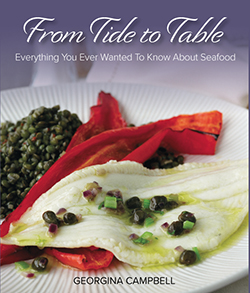Article SPECIAL IRISH FOODS & THE PEOPLE WHO MAKE THEM
Caherbeg Free Range Pork Products
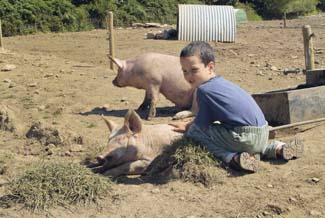
 With St Patrick’s Day being the main event in March, it’s a natural time for Irish people to think about our traditional foods – and there’s nothing more traditional than pork and bacon. The pig was probably the first domestic animal to be brought to this country and, while it may seem a long way from post-tiger Ireland, it’s not all that long since “the gentleman who pays the rent” played an important role in rural households.
With St Patrick’s Day being the main event in March, it’s a natural time for Irish people to think about our traditional foods – and there’s nothing more traditional than pork and bacon. The pig was probably the first domestic animal to be brought to this country and, while it may seem a long way from post-tiger Ireland, it’s not all that long since “the gentleman who pays the rent” played an important role in rural households. Pork is incredibly versatile, providing great variety of flavour and texture and the meat is so tender that any fresh cut is suitable for virtually all cooking methods, including roasting and grilling.
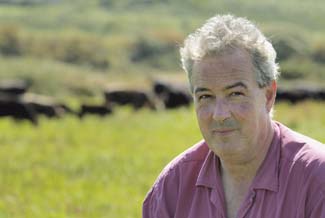
Consumers today are often disappointed to find that many of the apparently Irish branded bacon and cooked ham products sold in supermarkets actually use imported meat, which may not necessarily be as good as we expect it to be; to be sure, look out for products carrying the Bord Bia Quality Mark, which are produced to the highest standards and are traceable from farm to fork.
And, although most Irish pigs are now intensively produced, it’s encouraging to see that a growing number of small specialist farmers are producing free range pork and bacon products, which are available from the producers themselves (who often offer an online service), specialist butchers and farmers’ markets. This is food with real flavour and texture and, not only is the product itself well worth seeking out, but there’s always a story behind it too.
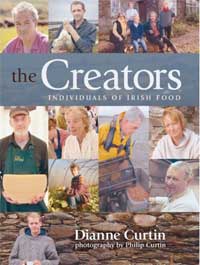 You’ll find plenty of these in Dianne Curtin’s book The Creators (Atrium/Cork University Press, EUR29.95), which highlights some of the best artisan products in County Cork and the families who produce them – including the story of free range pig farmers Willie and Avril Allshire (023 48474; caher@caherbegfreerangepork.ie), who rear their Saddleback-cross pigs as naturally as possible without antibiotics and growth promoters for their renowned Caherbeg free range pork products and Rosscarbery Recipe sausages.
You’ll find plenty of these in Dianne Curtin’s book The Creators (Atrium/Cork University Press, EUR29.95), which highlights some of the best artisan products in County Cork and the families who produce them – including the story of free range pig farmers Willie and Avril Allshire (023 48474; caher@caherbegfreerangepork.ie), who rear their Saddleback-cross pigs as naturally as possible without antibiotics and growth promoters for their renowned Caherbeg free range pork products and Rosscarbery Recipe sausages. Look for them in specialist outlets such as On The Pig’s Back at The English Market in Cork; selected SuperValu stores in Co Cork, eg Carrigaline; Walsh Fine Food & Wines in Naas, Co Kildare; various SuperValu and specialist outlets in Dublin, including Nolan’s of Clontarf, Morton’s of Ranelagh and Thyme Out in Dalkey.
For further information, click here to visit their website.
RECIPE - TOAD IN THE HOLE
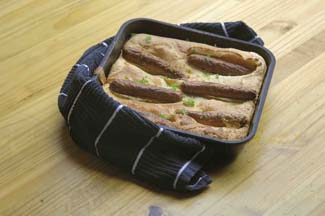 Top quality sausages such as the Allshires’ range are the key to this simple family dish from The Creators, which was one of author Dianne Curtin’s favourite after school dinners as a child and is perfect for the time of year.
Top quality sausages such as the Allshires’ range are the key to this simple family dish from The Creators, which was one of author Dianne Curtin’s favourite after school dinners as a child and is perfect for the time of year. Sometimes, when her mother made this, she would add half a peeled and grated onion to the mix, which prevents the batter billowing up as much as it does without it, but gives a lovely, oniony taste.
Rosscarbery Recipe sausages are available as traditional, traditional gluten free, spicy tomato and (perhaps best of all for this dish) Cumberland.
Click here for recipe for Toad in the Hole
Arctic Charr

.jpg) Arctic charr is a fish highly prized for its meaty texture and mild, yet distinctive flavour. Since the last ice-age charr have thrived in the cold, pure water of glacial lakes on Ireland’s Atlantic seaboard - elusive to anglers because of their habit of lurking at the bottom of the deep lakes.
Arctic charr is a fish highly prized for its meaty texture and mild, yet distinctive flavour. Since the last ice-age charr have thrived in the cold, pure water of glacial lakes on Ireland’s Atlantic seaboard - elusive to anglers because of their habit of lurking at the bottom of the deep lakes.
Now, thanks to an innovative aquaculture enterprise based on sustainability, eco-friendliness and harmony with its natural environment, this tasty fish is more widely available. It was the natural presence of Arctic charr in nearby Lough Talt that inspired Bill Carty and his wife Mari Johnston to redevelop structures previously used for mushroom farming to create a state-of-the-art fish farm on Bill’s small family farm at the foot of the Ox Mountains near Tubbercurry in Co. Sligo. They are the first to farm Arctic charr in Ireland - and Cloonnacool Arctic Charr is Ireland’s first re-circulation fish farm.
 In nature, charr live close to the bottom and young and old get along well together; indeed they fail to thrive unless they are able to stay in close proximity to each other, which makes them ideal candidates for farming. The aim at Cloonacool is to keep the fish as close to their natural environment as possible, and they are fed with pure spring water with nothing added except food and oxygen – no chemicals, antibiotics or colourings are used.
In nature, charr live close to the bottom and young and old get along well together; indeed they fail to thrive unless they are able to stay in close proximity to each other, which makes them ideal candidates for farming. The aim at Cloonacool is to keep the fish as close to their natural environment as possible, and they are fed with pure spring water with nothing added except food and oxygen – no chemicals, antibiotics or colourings are used.
After use in the tanks, the water is filtered through the Sligo limestone and natural reed beds before recirculation: the reeds, which are cut to the ground each winter, take up nutrients from the water - and, when this natural filtration process is complete, it is pure enough to be fed back into the tanks. (Biological filters ensure that ammonia and C02, which accumulate naturally, are removed from the water.)
Although only introduced to the market in 2006, this fish has already proved a hit in Ireland with both chefs and discerning diners, who delight in the white meaty flesh with a taste that is between trout and halibut. A very healthy food, it is low in fat, rich in Omega 3 and a source of many essential nutrients. Arctic charr is served in leading restaurants, and available from selected fishmongers and many farmers' markets.
.jpg) Recipe:
Recipe:
Arctic Charr with Lemon Butter and Flaked Almonds
Click here for recipe
Carrigbyrne Cheeses
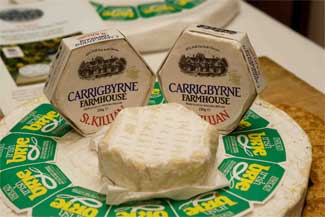
 Carrigbyrne St Killian is one of Ireland’s longest-established and most popular farmhouse cheeses – easily recognisable (even when sold as an own-brand, eg M&S) by its presentation in a smart hexagonal box, this camembert style cheese has been made since 1982 by dairy farmers Patrick and Juliet Berridge on their family farm close to Adamstown in Co. Wexford, along with their other cheeses, St Brendans and Irish Brie.
Carrigbyrne St Killian is one of Ireland’s longest-established and most popular farmhouse cheeses – easily recognisable (even when sold as an own-brand, eg M&S) by its presentation in a smart hexagonal box, this camembert style cheese has been made since 1982 by dairy farmers Patrick and Juliet Berridge on their family farm close to Adamstown in Co. Wexford, along with their other cheeses, St Brendans and Irish Brie. 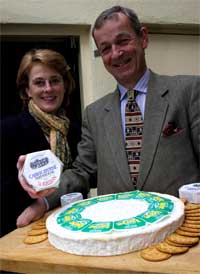 When young St Killian is firm and light-flavoured, but when you cut through the smooth white rind of a well-matured cheese, a rich creamy paste spills out, full of all the delicious grassy, light flavours of the sunny south-east. Consistent quality and regular supply make Carrigbyrne one of the most widely available Irish farmhouse cheeses - always on sale in specialist shops and in Tesco, Dunnes, Superquinn, Supervalue, M&S, and Waitrose in the UK and also Metro in Germany - one of their greatest areas of growth.
When young St Killian is firm and light-flavoured, but when you cut through the smooth white rind of a well-matured cheese, a rich creamy paste spills out, full of all the delicious grassy, light flavours of the sunny south-east. Consistent quality and regular supply make Carrigbyrne one of the most widely available Irish farmhouse cheeses - always on sale in specialist shops and in Tesco, Dunnes, Superquinn, Supervalue, M&S, and Waitrose in the UK and also Metro in Germany - one of their greatest areas of growth. The Berridges (together with French cheesemaker Alain Girod, who joined them 1986) have won regularly at Irish, British and international cheese competitions since the mid-80s, including taking the Best Irish Cheese at the 2007 World Cheese Awards – and a 2009 Irish Food Writers Guild Award of Excellence.
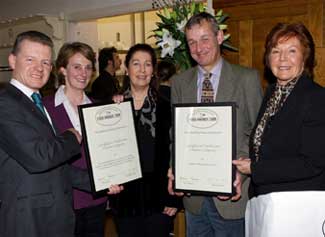 Carrigbyrne is also known for various recycling and other environmentally exciting projects – the reason for a second Irish Food Writers Guild Award, given ‘to acknowledge Irish food producers whose production process has succeeded in having a positive environmental impact on one or more of the following areas: water, waste, energy, by-products and packaging.’ The Berridges were the first winners of this new Environmental Award, and the number and variety of environmentally-friendly initiatives practised by them is astonishing.
Carrigbyrne is also known for various recycling and other environmentally exciting projects – the reason for a second Irish Food Writers Guild Award, given ‘to acknowledge Irish food producers whose production process has succeeded in having a positive environmental impact on one or more of the following areas: water, waste, energy, by-products and packaging.’ The Berridges were the first winners of this new Environmental Award, and the number and variety of environmentally-friendly initiatives practised by them is astonishing. An early and enthusiastic champion of protecting the environment, Patrick installed an anaerobic digestor 12 years ago, designed to take slurry from the dairy farm and waste from the cheese plant. Bacteria converts organic matter to methane which can be used for heat power and even transport fuel. It produces 450 cubic metres of biogas every day, running an old two-cylinder engine which generates electricity. The compost is spread on the farmland. With Celtic Compost, they plan a unit for food waste and anticipate selling electricity back through the grid. Patrick is also involved in processing forest-thinnings into chips for central heating for local hotels.
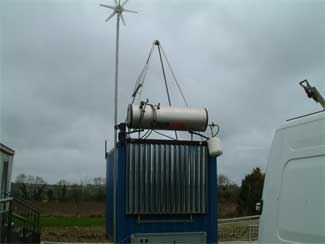 A member of the local Leader Renewable Energy Group, Patrick has also designed a travelling Eco-Cabin - an Aladdin’s cave of tricks made from environmentally-friendly bits and bobs, it’s a project for youngsters to have fun and develop an interest in renewable energy. A little windmill generates 36 watts, powering long-life bulbs, TVs and charging mobile phones. An 80 watt flat screen solar panel and a traditional solar panel heat water for a 200 litre water tank. The cabin also has a sun oven to cook meals and even a model car powered by hydrogen produced from water. As you’d expect, this imaginative educational project is welcomed with excitement when it arrives in a Wexford schoolyard!!
A member of the local Leader Renewable Energy Group, Patrick has also designed a travelling Eco-Cabin - an Aladdin’s cave of tricks made from environmentally-friendly bits and bobs, it’s a project for youngsters to have fun and develop an interest in renewable energy. A little windmill generates 36 watts, powering long-life bulbs, TVs and charging mobile phones. An 80 watt flat screen solar panel and a traditional solar panel heat water for a 200 litre water tank. The cabin also has a sun oven to cook meals and even a model car powered by hydrogen produced from water. As you’d expect, this imaginative educational project is welcomed with excitement when it arrives in a Wexford schoolyard!!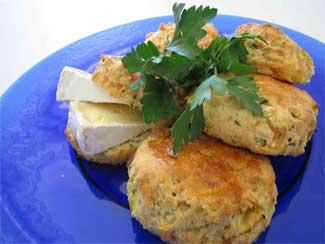 RECIPE: Camembert, Apple & Chive Scones
RECIPE: Camembert, Apple & Chive Scones Savoury cheese scones are a delicious way of using up oddments of cheese – grated hard cheese is more usual but other cheeses including camembert/brie styles can be used, remembering that the proportion should be about half fat to flour. They may not rise as high as standard scones, but will be very tasty and nutritious served simply with a bowl of home-made soup.
Click here for recipe
St Tola Organic Goats Cheese
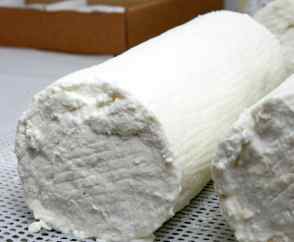
 The revival and development of Irish farmhouse cheesemaking over the last 30 years has seen some extraordinary enterprises take root and thrive – including St. Tola Organic Goats Cheese, which is produced in the West of Ireland by Siobhan Ni Ghairbhith on the family farm at Inagh, Co. Clare; a village just south of The Burren and nine miles north-west of Ennis, it is easily identified by the Biddy Earley Brewery at the cross roads, which was Ireland’s first brewery pub.
The revival and development of Irish farmhouse cheesemaking over the last 30 years has seen some extraordinary enterprises take root and thrive – including St. Tola Organic Goats Cheese, which is produced in the West of Ireland by Siobhan Ni Ghairbhith on the family farm at Inagh, Co. Clare; a village just south of The Burren and nine miles north-west of Ennis, it is easily identified by the Biddy Earley Brewery at the cross roads, which was Ireland’s first brewery pub.Handmade organic cheeses containing no additives or preservatives, the St. Tola cheeses are mild when young, becoming more distinctive in flavour as they mature. The soft St. Tola range includes logs (both light flavoured fresh cheese and full-flavoured mature); individual crottins, which are usually sold fresh but can be matured on request; and slices.
St Tola hard cheese is a round, creamy coloured cheese a little like a mature cheddar, with a hard rind and a deliciously tangy, nutty flavour. It’s made in several sizes, including a small one (200g) which is perfect for hampers and picnics. The latest addition to the range is St Tola Feta Style, with a springy texture and mild salty flavour; used fresh it is ideal for crumbling into salads, and it keeps its shape in cooking.
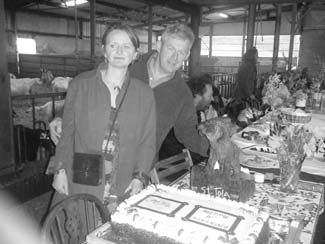 For Siobhan, 2009 marks ten years of producing these outstanding cheeses, which have won many awards, including recent success at the Great Taste Awards, British Cheese Awards and National Organic Awards and also one of the carefully selected accolades from the Irish Food Writers’ Guild, who only commend three or four very special products each year.
For Siobhan, 2009 marks ten years of producing these outstanding cheeses, which have won many awards, including recent success at the Great Taste Awards, British Cheese Awards and National Organic Awards and also one of the carefully selected accolades from the Irish Food Writers’ Guild, who only commend three or four very special products each year. 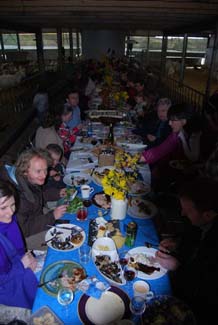 Guests who came to celebrate Siobhan’s first decade got a tour of the farm and cheesehouse to see how the cheeses are produced (visitors are always welcome, by prior arrangement, including school tours). Guests of honour included Meg Gordon, the original cheese maker of St Tola who first started producing the cheese in 1982 with her late husband Derrick Gordon, and a feast showcasing local produce was served in the goat house while the herd of over 200 goats looked on and entertained the visitors as they dined on fresh mussels and oysters, Burren Rack of Lamb (supplied by Burren Life Project), Organic Pork from Crowes Butchers, salads by Jam Bakery and of course St Tola Cheese tartlets, cheesecake and cheeseboard, all accompanied by organic wines provided by Mary Pawle Wines.
Guests who came to celebrate Siobhan’s first decade got a tour of the farm and cheesehouse to see how the cheeses are produced (visitors are always welcome, by prior arrangement, including school tours). Guests of honour included Meg Gordon, the original cheese maker of St Tola who first started producing the cheese in 1982 with her late husband Derrick Gordon, and a feast showcasing local produce was served in the goat house while the herd of over 200 goats looked on and entertained the visitors as they dined on fresh mussels and oysters, Burren Rack of Lamb (supplied by Burren Life Project), Organic Pork from Crowes Butchers, salads by Jam Bakery and of course St Tola Cheese tartlets, cheesecake and cheeseboard, all accompanied by organic wines provided by Mary Pawle Wines. Availability: Unusually for a goat cheese, the St Tola range is available all year. It is served in many good restaurants (including, in Co Clare, the Earl of Thomond Restaurant at Dromoland Castle, Gregans Castle Hotel and Berry Lodge); it may be purchased throughout Ireland at supermarkets including Tesco and Superquinn, specialist suppliers such as Sheridans and many independent grocers. Also available from selected outlets in Britain, including Neals Yard Dairy.
For further details, visit www.st-tola.ie
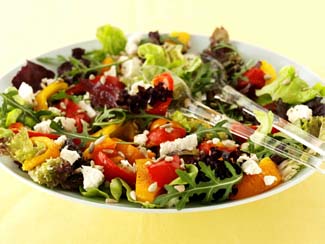 RECIPE: ROASTED PEPPER AND GOATS CHEESE SALAD
RECIPE: ROASTED PEPPER AND GOATS CHEESE SALAD This colourful salad can be on the table in a flash if the peppers are prepared ahead – they are also edible raw, of course, but the flavour is harsh and they tend to be indigestible so it is well worth taking a little trouble to get a tender texture and sweet flavour. Mixing off extra virgin olive oil with sunflower oil makes for a lighter flavoured dressing, if preferred; salt may not be needed as the cheese has a salty flavour.
Click here for recipe
Connemara Smokehouse Products
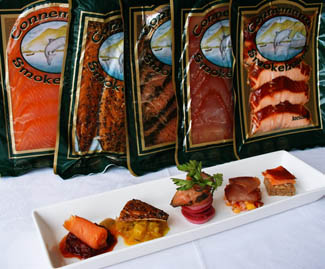
 Smoked fish has always been an important part of Irish life, valued both for its flavour (very useful for making a simple diet more interesting) and its good keeping qualities. And it’s never been more popular than it is today, as discerning diners, chefs and home cooks all take pride in seeking out the very best smoked fish available.
Smoked fish has always been an important part of Irish life, valued both for its flavour (very useful for making a simple diet more interesting) and its good keeping qualities. And it’s never been more popular than it is today, as discerning diners, chefs and home cooks all take pride in seeking out the very best smoked fish available. A number of top quality artisan producers all around Ireland are making a wide range of excellent products, each with its own special signature – and foodies often have fun identifying each one specifically, judging by the size, texture, colour and flavour of the fish to see the man (or woman) behind the product on the plate, and the area it comes from.
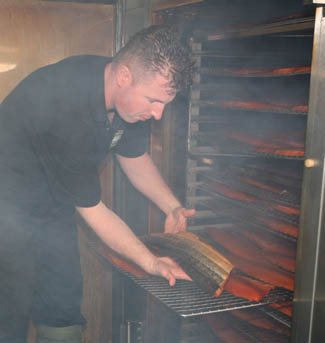 One of the best fish smokers in the west of Ireland is Graham Roberts of Connemara Smokehouse, and visitors to Connemara are in for a treat when they see the smokehouse signed between Clifden and Ballyconneely – it’s well worth allowing time to call in and see the Roberts family’s business, and of course, buy one or two treats to take home.
One of the best fish smokers in the west of Ireland is Graham Roberts of Connemara Smokehouse, and visitors to Connemara are in for a treat when they see the smokehouse signed between Clifden and Ballyconneely – it’s well worth allowing time to call in and see the Roberts family’s business, and of course, buy one or two treats to take home. They were the first winners of the BIM Product Innovation Award in 2003, and have won an impressive array of awards for their products both in Ireland and internationally, including the Great Taste Awards. And not only does Connemara Smokehouse smoked tuna feature in both editions of Rick Stein’s ‘Food Heroes’ books, but he also carries it on the menu at his famous Cornish restaurant, The Seafood Restaurant, in Padstow.
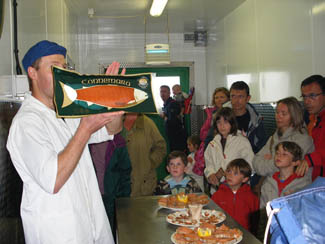 Salmon is the most popular fish and they produce a range of delicious products including Smoked Salmon, Gravadlax, Honey Roast Smoked Salmon and Hot Smoked Salmon (in Wild, Organic & farmed); other less well known but (at least) equally desirable regular products are Smoked Tuna, Honey Roast Smoked Tuna, Smoked Tuna Mousse, and Plain & Peppered Smoked Mackerel. They sometimes also make Kippers, Smoked Cod, Smoked Eels, Hot Smoked Trout, and Wild Smoked Trout.
Salmon is the most popular fish and they produce a range of delicious products including Smoked Salmon, Gravadlax, Honey Roast Smoked Salmon and Hot Smoked Salmon (in Wild, Organic & farmed); other less well known but (at least) equally desirable regular products are Smoked Tuna, Honey Roast Smoked Tuna, Smoked Tuna Mousse, and Plain & Peppered Smoked Mackerel. They sometimes also make Kippers, Smoked Cod, Smoked Eels, Hot Smoked Trout, and Wild Smoked Trout.It’s most fun to buy from the smokehouse at Bunowen Pier near Ballyconneely, but the more popular products are also easily available from normal retail outlets, including good supermarkets, and you can order from the full range online (www.smokehouse.ie).
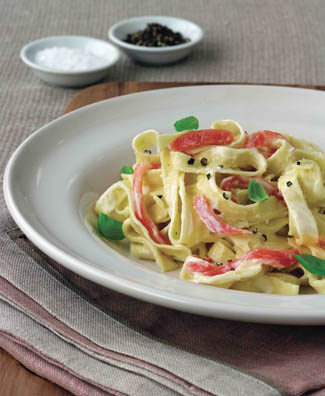 RECIPE: Smoked Salmon Tagliatelle with Parmesan Cream
RECIPE: Smoked Salmon Tagliatelle with Parmesan Cream For such a simple dish, this smoked salmon recipe from From Tide To Table turns out very stylishly, and it’s a great dish to keep in mind for when you need to get something tasty on the table in a hurry.
There is a general rule that you should never add Parmesan to a fish-based pasta dish - but this recipe is the exception to the rule.
Click here for recipe
Murphys Ice Cream
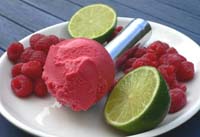
 We may not always like the rain but it makes for great grass – the key to Ireland’s well-earned reputation for wonderful dairy produce. For the last few decades, that rich creamy milk has been the foundation for the ever-growing number of superb handmade cheeses that are now so familiar that we almost take them for granted - and, more recently, a surprising number of entrepreneurs looking for a niche product have taken to making artisan ice creams.
We may not always like the rain but it makes for great grass – the key to Ireland’s well-earned reputation for wonderful dairy produce. For the last few decades, that rich creamy milk has been the foundation for the ever-growing number of superb handmade cheeses that are now so familiar that we almost take them for granted - and, more recently, a surprising number of entrepreneurs looking for a niche product have taken to making artisan ice creams. And very good a lot of it is too - what the best examples all have in common is a commitment to quality products using the very best local ingredients, which has the world beating a path to their doors. The extremely successful Murphys Ice Cream, made by brothers Seán & Kieran Murphy in Dingle, Co Kerry, is a good example.
 Anyone visiting Dingle lately will know the cheerful blue and white Murphys Ice Cream shop, where you can have a really good coffee and a slice of one of Sean’s wife Wiebke’s fabulous German gateaux, as well as the full range of their ice creams. It was so successful that they opened a Killarney shop, and then they wrote a book about it all too, The Book of Sweet Things (Mercier Press, €19.99), so their recipes are there for everyone to share.
Anyone visiting Dingle lately will know the cheerful blue and white Murphys Ice Cream shop, where you can have a really good coffee and a slice of one of Sean’s wife Wiebke’s fabulous German gateaux, as well as the full range of their ice creams. It was so successful that they opened a Killarney shop, and then they wrote a book about it all too, The Book of Sweet Things (Mercier Press, €19.99), so their recipes are there for everyone to share. The brothers are American, but visited Ireland often when growing up because their father is from Cork. They felt so at home in Dingle that they decided to find a way to live there - and, with the help of the milk from the black Kerry cows, the idea of making ice cream for a living was born. Now almost the whole family has relocated to Kerry, including their Aunt Carol, their father’s sister who taught them all about good home cooking.
It’s a great success story and, written in Kieran’s languid laid-back style, The Book of Sweet Things makes an enjoyable read. But at the heart of it there’s a serious business message and there’s loads of practical stuff there too – an emphasis on the importance of using the best ingredients, suggestions for where to find them, and information on equipment and safety. Every recipe that contains eggs includes instructions on pasteurisation, and they wisely suggest that readers visit the Food Safety Authority of Ireland’s website, www.fsai.ie.
As well as the shops in Dingle and Killarney, Murphys ice cream scoops are available in Powerscourt Townhouse Café, Dublin; McCambridges Food Emporium, Galway; The Blue Haven Hotel, Kinsale; and Nude Food in Dungarvan, Co Waterford. Tubs are also sold at a growing number of specialist food outlets – see www.murphysicecream.ie for details.
Seasonality is key to the Murphys philosophy, and there’s no better time to try some summer favourites.
Nell’s Old Fashioned Fruit Cup
 “Long before Murphys Ice Cream opened its doors on Strand Street, a woman named Nell Grandfield made ice cream from scratch in the very same building and delighted generations of customers. She used fresh cream from the Dingle creamery, and appreciative patrons would stop by Nell’s on their way to the cinema for an ice cream or a chocolate.
“Long before Murphys Ice Cream opened its doors on Strand Street, a woman named Nell Grandfield made ice cream from scratch in the very same building and delighted generations of customers. She used fresh cream from the Dingle creamery, and appreciative patrons would stop by Nell’s on their way to the cinema for an ice cream or a chocolate. Twenty years after Nell shut her doors, my brother and I leased her shop, and we soon met her former customers and heard the stories. Many of them still come in to Murphys, and although our equipment is more modern, our ingredients more exotic, and we cost more than 6 pence, I do think that Nell would have approved.
She was best known for ice cream served in a dish with fruit, and this is a slightly more gourmet version of her fruit cup.”
Click here for recipe
Earl Grey (Tae) Ice Cream
 “A few years after I left school, I found myself living in Somerville, a suburb of Boston. In nearby Cambridge, there was a famous little ice cream shop we used to frequent. They were known for strange and wonderful flavours, and one day I found Earl Grey ice cream in their cabinet. I ordered it, but I didn’t expect to like it half as well as I did. Now, as I play around with the ice cream and learn more about chemistry, I know that the tannins in tea cut sweetness. Earl Grey tea generally has a mix of different black teas, including Darjeeling and China tea, but it is the bergamot that really make it distinctive. If you want an adult ice cream that will surprise your guests, this is one to try.”
“A few years after I left school, I found myself living in Somerville, a suburb of Boston. In nearby Cambridge, there was a famous little ice cream shop we used to frequent. They were known for strange and wonderful flavours, and one day I found Earl Grey ice cream in their cabinet. I ordered it, but I didn’t expect to like it half as well as I did. Now, as I play around with the ice cream and learn more about chemistry, I know that the tannins in tea cut sweetness. Earl Grey tea generally has a mix of different black teas, including Darjeeling and China tea, but it is the bergamot that really make it distinctive. If you want an adult ice cream that will surprise your guests, this is one to try.”Click here for recipe
Raspberry (Sú Craobh) Sorbet
 Not all the Murphys recipes use milk, cream and eggs – they also make great sorbets and this is probably the best of all. “Raspberry is a regal fruit - both the colour and taste are so deep and intense it’s perfect for a sorbet, where the experience of the fruit is unencumbered by distractions. The ingredients are simple - water, sugar, raspberries, and a bit of lemon or lime. Outside of eating fresh raspberries off the cane, it will be hard to find a raspberry experience so potent.”
Not all the Murphys recipes use milk, cream and eggs – they also make great sorbets and this is probably the best of all. “Raspberry is a regal fruit - both the colour and taste are so deep and intense it’s perfect for a sorbet, where the experience of the fruit is unencumbered by distractions. The ingredients are simple - water, sugar, raspberries, and a bit of lemon or lime. Outside of eating fresh raspberries off the cane, it will be hard to find a raspberry experience so potent.” Click here for recipe
Strawberry (Sú Talún) Ice Cream
 This is not a very difficult ice cream to make. “Although” Kieran says, “We beg you to find fresh, ripe strawberries. There’s a farm in Co. Wicklow called ‘Sweetbank’ that gives us fruit and sells our ice cream in their farm shop. We come back with crates that perfume our production facility for days. Perhaps this should be saved for those warm days when the kids are off school and need to be entertained. Making ice cream with them might well be just as enjoyable as eating it when it comes out of the freezer.”
This is not a very difficult ice cream to make. “Although” Kieran says, “We beg you to find fresh, ripe strawberries. There’s a farm in Co. Wicklow called ‘Sweetbank’ that gives us fruit and sells our ice cream in their farm shop. We come back with crates that perfume our production facility for days. Perhaps this should be saved for those warm days when the kids are off school and need to be entertained. Making ice cream with them might well be just as enjoyable as eating it when it comes out of the freezer.” Click here for recipe
Clandeboye Estate Yoghurt
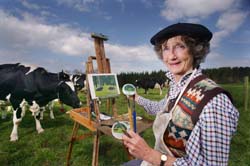
 It’s not hard to see why Clandeboye Estate Yoghurt stands out from the crowd: not only is it made with milk from Clandeboye’s prized herd of Holstein and Jersey cows, but the eye-catching packaging is based on an oil painting of those very cows and the estate by their owner, Lady Dufferin, who is a talented artist.
It’s not hard to see why Clandeboye Estate Yoghurt stands out from the crowd: not only is it made with milk from Clandeboye’s prized herd of Holstein and Jersey cows, but the eye-catching packaging is based on an oil painting of those very cows and the estate by their owner, Lady Dufferin, who is a talented artist. Northern Ireland’s only locally made cows milk yoghurt, it contains no additives or preservatives and is blended by hand using traditional techniques that produce a rich creamy texture without high fat content. The milk is prepared and cultured very gently over 24 hours in small batches, which helps to develop both flavour and texture; available in Natural and Greek styles, it is ideal for eating on its own, or with fresh berries (or with Clandeboye’s own granola, perhaps) or for using as a recipe ingredient.
Like many other farms, Clandeboye needed to find ways to diversify, and they identified a niche in the market for a locally produced speciality brand of yoghurt; then, working with Loughry College at Cookstown, they were able to get the product off the ground in a relatively short time scale.
Turning the business idea into a commercial reality was the work of David Crawford, the first Northern Irish graduate of the University College Cork’s Diploma in Speciality Food Production. The course, which has the collaboration of key figures in Irish food including Darina Allen from Ballymaloe and Giana Ferguson of the Gubbeen Cheese, was developed in response to the needs of the growing number of small scale specialist food enterprises across Ireland.
“Financial investment aside, it’s the time and energy that goes into this dairy herd that is central to the success and great taste of Clandeboye Estate Yoghurt. Our products are all about nature and goodness, using my own oil illustrations on the packaging is a unique way of communicating these values to our customers.” explains Lady Dufferin. “At full tilt, we will have the potential to produce yoghurt from 750,000 litres of milk from our herd, that’s about 3 million pots a year - not bad for 80 cows!”
Widely stocked in shops throughout Northern Ireland (outlets are listed on their website, www.clandeboye.co.uk), Clandeboye Estate Yogurt is on the breakfast menu at all Hastings Hotels, Galgorm Manor Hotel and served at Café Sol in Dublin. You’ll also find it at Avoca Shops, specialist delis and farmers markets in Ireland – and customers are also very welcome to call to the Estate Dairy on Crawfordsburn Road, beside the Clandeboye Lodge Hotel, to buy the product and see the cows for themselves.
RECIPES
Rhubarb and Granola Smoothies
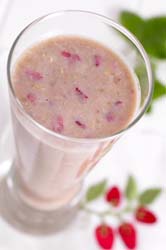 This recipe for a filling and healthy smoothie is from Stephen Jeffers at the popular Bangor restaurant Jeffers by the Marina. Stephen, a staunch supporter of quality local produce and former resident chef at the Clandeboye Estate, was pleased to discover that there was a local artisan alternative to mass-produced yogurts - for more of his recipes visit www.clandeboye.co.uk
This recipe for a filling and healthy smoothie is from Stephen Jeffers at the popular Bangor restaurant Jeffers by the Marina. Stephen, a staunch supporter of quality local produce and former resident chef at the Clandeboye Estate, was pleased to discover that there was a local artisan alternative to mass-produced yogurts - for more of his recipes visit www.clandeboye.co.uk Click here for recipe
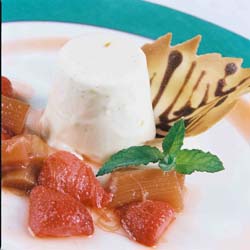 Vanilla Yoghurt Bavarois with Stewed Rhubarb & Strawberries
Vanilla Yoghurt Bavarois with Stewed Rhubarb & Strawberries This beautiful yoghurt-based dessert from Carrig Country House on beautiful Caragh Lake, near Killorglin in Co Kerry, would make a stylish finale for a dinner party.
Click for recipe
Mountain Lamb
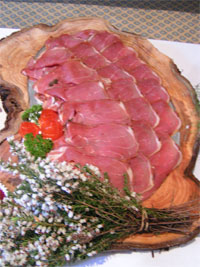
 Mention lamb to most people and it is likely to summon up images of spring - green fields and daffodils, with fluffy lambs gambolling around – but, tasty as tender young lowland lamb may be in spring and summer, there’s a completely different and more characterful variety that comes into season later in the year: mountain lamb.
Mention lamb to most people and it is likely to summon up images of spring - green fields and daffodils, with fluffy lambs gambolling around – but, tasty as tender young lowland lamb may be in spring and summer, there’s a completely different and more characterful variety that comes into season later in the year: mountain lamb.Mountain lamb is a smaller, leaner product, with more muscle and the distinctive flavour of the heathers and mountain herbs it has been reared on. Produced naturally in the wild and likely to be organic by definition, it comes from the hills and mountains of rugged areas like Connemara, Kerry and the Comeragh Mountains, and is one of Ireland's most interesting speciality foods.
The lambing season is later in mountainous areas, so this special meat follows on from lowland lamb, coming onto the market during the autumn and early winter, usually from September until December. This delicious product is increasingly appreciated by a discerning market, both domestic and international; seen on many an upmarket restaurant menu these days, it has the potential to transform the prospects for hill farmers, for whom this gourmet product should command a premium price.
Better still, for both producer and consumer, is when added-value comes into the equation – next time you’re in the West of Ireland, call in to that very special butcher McGeough’s of Connemara (Camp Street, Oughterard, Co Galway Tel: 091 552351). Here, not only can fresh meats of the area be bought , including aromatic Connemara lamb (September – December), but - among other speciality products - you’ll also find James McGeough’s famous air-dried lamb: superb!
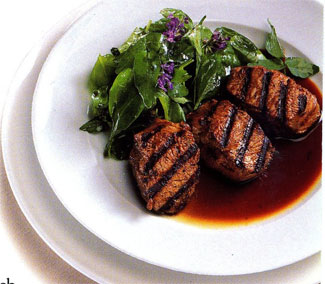 Grilled Mountain Lamb in a Salad
Grilled Mountain Lamb in a Salad Click for recipe
Black Pudding
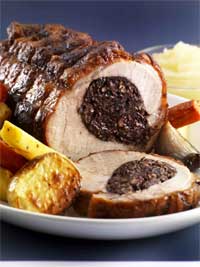
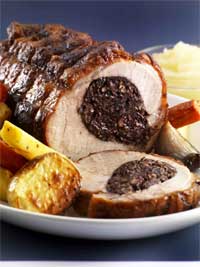 “The pig was probably the first domestic animal to be brought to Ireland and many country people can remember the time when most rural households killed at least one pig a year. It was a complicated business, with the men and women each having their particular jobs.
“The pig was probably the first domestic animal to be brought to Ireland and many country people can remember the time when most rural households killed at least one pig a year. It was a complicated business, with the men and women each having their particular jobs. The men did the killing, cleaning, butchery and salting, while the women dealt with the trotters, internal organs and any other parts which were to be cooked fresh. The hams were usually put into a blend of salt, saltpetre and brown sugar for several days and then smoked, preferably over oak chippings.
Afterwards, they were hung up on iron hooks from a beam called 'the meat stick' which ran across the kitchen, where turf smoke from the open hearth gave it a special Irish flavour.
Black pudding was made with the blood, chopped fat, oatmeal, herbs and seasoning; this mixture was loosely filled into lengths of the cleaned intestines, tied in circles and then boiled. Next came ‘the parcelling out’, when portions of the fresh meat and black pudding were sorted out for the neighbours and delivered by the children of the house - this was a very important custom as a number of households exchanging gifts after a killing meant that fresh meat was available much more often.”
(‘Good Food From Ireland’, Grafton Books 1991).
Today there is a sense that we may be coming full circle – recent years have seen an unprecedented resurgence of interest in farming practice, domestic gardening and everything to do with small production.
While pork production is going through a difficult phase at the moment, demand for free range and/or organic pork is rising and, although demand still exceeds supply, it is becoming more widely available – we have recently enjoyed supplies of free range saddleback, for example, from Nigel Cobbe’s online company Simply Sourced, which delivers to your door (with no delivery charge on orders over €100, nationwide).
Speciality pork products have always been a strength in Ireland and really good black pudding, especially, has been consistently easy to find. Thanks to that great butcher, the late Eddie Twomey, the West Cork town of Clonakilty is known internationally for its deliciously grainy pudding, and there are many others throughout Ireland – some made in small quantities by individual butchers for local consumption, others reaching a wider market.
Annascaul Black Pudding, for example, has been made in Ashe’s butchers shop in this pretty village on the Dingle Peninsula since 1916, and the puddings made to the original recipe, without artificial additives or preservatives, by Thomas Ashe today are sought after throughout Kerry and beyond.
Up in Newport, Co Mayo, people travel great distances to buy Kelly’s black and white puddings and sausages; a unique product is the traditional ‘putóg’ black pudding, where the casing was made using a sheep’s stomach. They run their own abbatoir, have recently completed a new production unit and have an export licence – all evidence of consumer support for this great traditional product.
Roast Loin of Pork with Black Pudding Stuffing, served with Roasted Vegetables & Apple Sauce
In this whole wholesome recipe from Roly's Café & Bakery (Gill & Macmillan), you get the benefit of both delicious good quality pork – and an artisan black pudding. Simple, traditional Irish food at its best.
Click for recipe
Euro-Toques
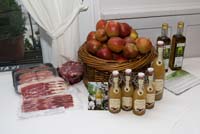
 When presenting their annual Food Awards at Dublin’s Bang Cafe in November, chefs group Euro-toques Ireland the called on the government to establish a ‘safety net’ support system to ensure the survival of indigenous food businesses.
When presenting their annual Food Awards at Dublin’s Bang Cafe in November, chefs group Euro-toques Ireland the called on the government to establish a ‘safety net’ support system to ensure the survival of indigenous food businesses. “What we are talking about are simple, but effective measures to defend artisan production and encourage rural enterprise”, said Chef Feargal O’Donnell, Commissioner-General of Euro-toques Ireland. “At the moment the regulatory requirements and compliance costs are making many businesses uncompetitive, deterring new food enterprises and wiping out many existing ones. In many cases producers are being asked to invest in facilities that they will never recoup the cost of. Many of these people wish to remain small and just to supply locally. We believe a different approach is needed”.
Euro-toques are calling for independent assessment, by a new or existing group made up of regulators and industry representatives, of cases where compliance costs are putting food businesses under threat or where they are being told they can no longer carry out traditional or artisan production methods.
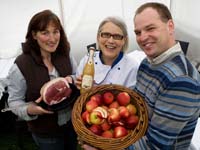 Food producers must be able to sell at a reasonable price and still make a decent margin, overheads and capital costs can often make this impossible. They say that proven traditional practices need to be recognised as safe and inexpensive alternatives to meeting food safety requirements must be looked at.
Food producers must be able to sell at a reasonable price and still make a decent margin, overheads and capital costs can often make this impossible. They say that proven traditional practices need to be recognised as safe and inexpensive alternatives to meeting food safety requirements must be looked at. In addition they will ask the Food Safety Authority and government for a guarantee that not one single indigenous food producer will be forced out of business without this ‘safety net’ process being employed. The ‘safety net’ system was proposed by Euro-toques founder Myrtle Allen, and Euro-toques is joined in making this call by Slowfood Ireland, the TASTE Council, the Artisans Forum, Cork Free Choice Consumer Group, Good Food Ireland and Growing Awareness.
Euro-toques Ireland, the Irish branch of the European Community of Chefs & Cooks, presents annual Food Awards to food producers, and occasionally individuals or organisations, who have made an outstanding contribution to Irish food. Nominations are put forward by Euro-toques member chefs and recipients are carefully selected by their Food Committee. The awards are now in their 13th year.
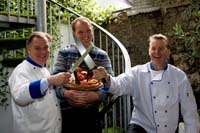 This year’s winners were:
This year’s winners were:• Woodside Farm, Leamlara, Co. Cork for their free range pork and pork products
• Happy Heart Organic Rapeseed Oil from Drumeen Farm in Urlingford, Co. Kilkenny
• The Apple Farm, near Cahir, Co. Tipperary for their range of apple and fruit varieties and excellent juices and fruit produce.
• Solaris Botanicals, Galway, for their organic whole leaf speciality and herbal teas.
A special award was presented to farmers’ co-operative group
• Connemara Hill Lamb Ltd for registration of Connemara Hill Lamb as a Protected Geographical Indication (PGI) under the EU food quality scheme.
Each award was introduced by a Euro-toques Member Chef.
“Four out of our five awards this year are for companies who are first and foremost farmers, but who have innovated and added value to their produce”, said O’Donnell, “These are the people keeping rural Ireland alive and are in many cases keeping the next generation on the land. All five winners have sustainability and environmentally sound practices at the heart of what they do. We absolutely must ensure the survival of these enterprises”.
The awards ceremony was attended by a who’s who of the Irish food industry including Euro-toques chefs, Ross Lewis (Chapter One), Derry Clarke (lEcrivain), Neven Maguire (MacNean House & Restaurant), Darina Allen (Ballymaloe Cookery School) and Euro-toques founder Myrtle Allen (Ballymaloe House). Minister of State for Food & Horticulture Trevor Sargent addressed the event and presented the winners with their awards. Canapés, featuring the award winning produce, were prepared by Graham Neville, head chef of Restaurant Forty One @ Residence on St. Stephen’s Green.
2009 Award Winners
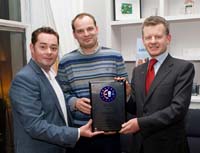 THE APPLE FARM – Apples, Fruit & Fruit Juices
THE APPLE FARM – Apples, Fruit & Fruit JuicesMoorstown, Cahir, Co. Tipperary
Award presented by Euro-toques Chef Neven Maguire of MacNean House & Restaurant, Blacklion, Co. Cavan
The Traas family have been growing fruit, primarily apples, at ‘The Apple Farm’ in Moorstown near Cahir in Co. Tipperary since the 1960s. Con Traas now grows up to 70 varieties of apples, about 20 of these commercially. In addition he grows several different varieties of strawberries, raspberries, cherries, plums and pears. In autumn 1996, on the morning of this wedding, Con began to produce his own apple juice, and his little green bottles with the ‘Karmine’ brand have since become familiar in cafes and food shops all over the country.
While the fruit is sold primarily from the farm shop and in local outlets, Con’s juices gained popularity nationwide, and he expanded the range with blends including his own soft fruits. Recently he has launched ‘The Apple Farm of Tipperary’ Sparkling Apple Juice, which he believes may be the only natural unsweetened carbonated fruit juice on the market.
All their farming and production is carried out in an environmental and quality conscious manner, with integrated pest control systems and hand-harvesting of fruit. All of their products are made entirely with their own fruit.
Euro-toques Ireland recognised the Apple Farm for promoting biodiversity, retaining Irish horticulture and producing top quality fruit and fruit juices.
Contact: Con Traas Tel: 052 744 1459
E: con@theapplefarm.com W: www.theapplefarm.com
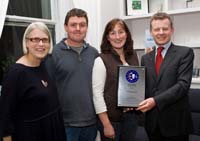 WOODSIDE FARM – Free Range Pork, Bacon & Sausages
WOODSIDE FARM – Free Range Pork, Bacon & SausagesBallincurrig, Leamlara, Co. Cork
Award presented by Euro-toques Chef and Slowfood Ireland President Darina Allen of Ballymaloe Cookery School
Martin & Noreen Conroy established a small mixed farm near Leamlara near Midleton in County Cork six and a half years ago. Now, although they retain a mix of cattle, sheep, chickens, ducks, and geese, the mainstay of Woodside Farm is pigs, which they rear in a full outdoor free range system.
The Conroys breed and rear pure traditional Saddleback and Gloucestor Old Spot Pigs, which they butcher and process themselves. Martin and Noreen are assisted in the enterprise by their five children particularly their eldest sons Alan (18) and Matthew (16) who take special interest in the farming and butchery aspects respectively.
The Conroys feed their pigs exclusively on locally grown rolled wheat and their own selection of vegetables, to produce a slow-maturing, flavoursome meat. Their fresh pork, dry-cured bacon and ham, and high quality sausages are sold exclusively at their stall in Midleton market, and they sell only their own meat.
The pigs travel just six miles to Midleton to be slaughtered by a local butcher and the same trip to be sold at market, which combined with the use of local feedstuffs, means their produce has virtually no carbon footprint.
For an excellent truly local food, produced sustainably on a real family farm, with excellent animal welfare and use of rare breeds, Euro-toques presented Woodside Farm with a 2009 Food Award.
Contact: Noreen Conroy Tel: 087 2767206
E: macconraoi@hotmail.com W: www.woodsidefarm.ie
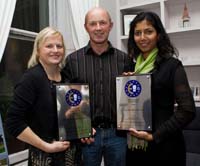 SOLARIS BOTANICALS – Organic Whole Leaf Speciality & Herbal Teas
SOLARIS BOTANICALS – Organic Whole Leaf Speciality & Herbal TeasUnit 3, Ballybane Enterprise Centre, Galway
Award presented by Euro-toques Food Committee Member Chef Brid Torrades of Osta Cafe & Wine Bar and Tobergal Lane Cafe, Sligo Town
Solaris Botanicals is a young Galway-based company with expert knowledge and a unique offering, which has already won them export markets in Italy, France the UK, Sweden, Greece and as far afield as Saudi Arabia. Founded by partners Jorg Muller and Karin Wieland, who are both qualified medical herbalists, the company produces a wide range of top quality whole leaf organic speciality and herbal teas.
These hand-picked, whole leaf loose teas, from organic plantations, freshly blended using traditional methods hold unique health properties, containing 95% more anti-oxidants than normal bag teas. In addition to a range of top quality black tea blends, green tea, white tea, and Pu Ehr Tea, they utilise the medical backgrounds to produce a selection of herbal blends which treat an array of complaints and ailments.
Far from being purely a health product, however, the quality of ingredients and freshness of the blends mean all their teas have full aroma and flavour. All their products are sold in beautiful 100% biodegradable sustainably sourced packaging and they have recently introduced a biodegradable silk tea bag range for foodservice.
Solaris Botanicals elevate tea blending to a fine art and, at a time when we need a little calm, are ensuring tea becomes the new coffee.
For an innovative product, based on passion and expertise, with an environmental conscience and excellent business practices, Euro-toques selected Solaris Botanicals for a 2009 Food Award.
Contact: Jorg Muller/Prea Munion Tel: 091 442 450
E: Solarisherbs@gmail.com W: www.solarisbotanicals.com
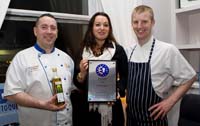 DRUMEEN FARM HAPPY HEART ORGANIC RAPESEED OIL
DRUMEEN FARM HAPPY HEART ORGANIC RAPESEED OILUrlingford, Co. Kilkenny
Award presented by Euro-toques Food Committee Member & Chair of the TASTE Council Evan Doyle, of Brooklodge Hotel, Macreddin, Co. Wicklow
Drumeen Farm near Urlingford, County Kilkenny has been farmed organically by Ben & Charlotte Colchestor for 35 years. In January this year their daughter Kitty, who had left home early to pursue a career in sales but later gave it up to carry out aid work in Africa, found herself back on the family farm and looking for a meaningful livelihood. She had heard a lot about the health properties of rapeseed oil, and turned her attention to the organic oilseed rape her father had already been growing for 5 years, one of only 3 farmers in the country doing so.
After completing an Enterprise Ireland Start your own Business course, she set about producing organic rapeseed oil. What started as a feasibility study on the 27 of June this year, turned out to be a highly successful product launch resulting in Drumeen Farm’s Happy Heart Rapeseed Oil finding its way to markets stalls and store shelves all over the country.
The rapeseed is dried at low temperatures and the oil is produced in small batches on a weekly basis from the first gentle cold pressing, using no chemicals, to ensure the high vitamin, anti-oxidant and omega levels are maintained. Apart from cholesterol reducing properties which rival both olive and sunflower oil, this oil has a subtle nutty flavour, making it perfect for sweet and savoury cooking and for salads.
Importantly the oil is part of a sustainable, holistic farm system, where the remainder of the rapeseed provides a protein rich and nutritious organic feed for the animals and all the rapeseed used is grown on the farm.
Unfortunately a fire in the drying machine in September meant that the entire final harvest of rapeseed was destroyed and, because Kitty does not want to compromise the integrity and principles of her product by importing rape, there will be very limited availability of her oil until next summer. Euro-toques chefs and many already dedicated customers will wait impatiently for next year’s harvest.
Contact: Kitty Colchestor Tel: 087 9265423
E: info@drumeenfarm.com W: www.drumeenfarm.com
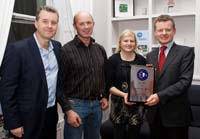 SPECIAL AWARD
SPECIAL AWARDCONNEMARA HILL LAMB LTD – Cooperative group of Connemara Hill Lamb farmers
Corr Na Mona, Connemara, Co. Galway.
Award presented by Euro-toques Commissioner Ross Lewis, of Chapter One Restaurant, Dublin
Connemara Hill Lamb Ltd is a cooperative of over 70 hill lamb farmers in the Connemara region who came together in 1999 to examine how the could develop a market for what they believed was a unique, quality product. Initially the created a logo for ‘Connemara Hill Lamb’ and sought out local markets, but they quickly began to investigate the possibility of registering the name as a ‘Protected Geographical Indication’ under the European food quality system.
From 2002, when their application began, until February 2007 when the name was finally protected, they painstakingly researched and compiled information to prove the origins and authenticity of the product, to describe in detail the breed, production methods, environment and diet of the animal and the characteristics of the resulting meat.
The result is that the name ‘Connemara Hill Lamb’ is now legally protected and can be used only to describe lamb born and reared in the Connemara Hills from black-faced horned ewes, feeding on a unique mixture of grasses and herbs, as well as their mother’s milk, throughout their lives.
The meat is available from June to January. Carcass weight for these lambs is typically less than half that of lowland breeds, weighing about 10kg. In appearance it is a lean carcass, rose red in colour, solid deep texture with a light cover of fat. The lamb has a natural succulent flavour and taste with a very pronounced aroma.
For their forward-thinking approach, their efforts to maintain traditional ways of farming and protect the unique ‘terroir’ of their product, Euro-toques recognised Connemara Hill Lamb Ltd with a Special Award and gave special recognition to M&K Meats, who distribute the product to Dublin restaurants.
Contact: Áine Ní Chiarragáin Tel: 09495 48798
E: connemarahilllamb@eircom.net W: www.connemarahilllamb.ie
Simply Sourced
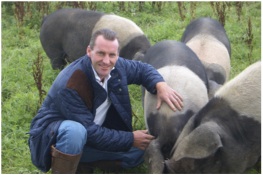
 “Delicious honest wholefood” is what Nigel Cobbe promised in July 2009 when he launched his online free-range meat service SimplySourced (www.simplysourced.net; 087 057 0000) – and that’s exactly what he delivered, by offering free-range Saddleback pork and rare breed Long Horn beef to customers in Dublin and Wicklow.
“Delicious honest wholefood” is what Nigel Cobbe promised in July 2009 when he launched his online free-range meat service SimplySourced (www.simplysourced.net; 087 057 0000) – and that’s exactly what he delivered, by offering free-range Saddleback pork and rare breed Long Horn beef to customers in Dublin and Wicklow. “The response was overwhelming,” he says, “We seemed to tap into a demand and a frustration from our customers at not being able to source high quality, ethically produced meat. As a result we have expanded both our product range and our delivery capability to deliver nationwide. Providing a hassle-free and professional link between small passionate food producers and our customers, we now also offer free range chicken and turkey, lamb and wild shot venison.”
Responding to demand, SimplySourced has expanded the range offered to include Sheridans cheeses, Java Republic coffee, Janets Country Fayre relishes, On The Pig’s Back terrines & patés and Ditty’s oatcakes – all awarding-winning Irish companies supplying superb products that are very much in demand by discerning customers – and also some carefully selected European larder foods such as cured meats from Spain and Italy, Dijon mustards, premium Italian olive oils, balsamic vinegar, organic pasta and risotto rice. (Always good to see quality speciality products, of course, but one can’t help hoping the focus will remain Irish.)
Offering Morphy Richards slow cookers was an inspired decision (we wouldn’t be without ours, it’s in use every day), and further products are planned for the site, which is finding a ready niche as Ireland’s first speciality foods website to make its mark by offering reliable supplies of free-range and rare breed meats and poultry.
Meats are sourced from Irish farmers who use natural, free-range production methods, without antibiotics, hormones or growth promoters. Traditional rare breeds have true old-fashioned flavour thanks to their innate qualities and traditional methods - dry hand curing, proper hanging (at least 21 days for beef) and professional butchery. Orders are butchered to customer requirements and are delivered to your door for immediate use or freezing for up to 6 months.
Although free-range meats have a reputation for being expensive, prices are surprisingly reasonable (with free delivery throughout Ireland for orders over €100, for smaller orders a flat rate of €10 to any Irish address) and, although you can create your own combination of cuts shoppers trying the system can choose from a variety of suggested great value boxes - from tasting boxes up to a full, bespoke butchered Saddleback pig!
Just remember that rare breeds tend to be smaller (and more uneven in size) than mass produced animals – this should not be disappointing as they make up in flavour anything they may lack in size.
Having been lucky enough to be among that happy band of satisfied customers who can now tuck into free range pork amongst other delicious treats, my only negative comment is just a suggestion: more apple please, in the pork & apple gourmet burgers – although it seems ungracious to complain of ‘too much pork’ in a burger …
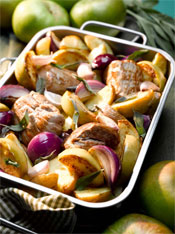 Recipe for Pork and Bramley Bake
Recipe for Pork and Bramley BakePork and Bramley apples are natural partners, and this versatile one-pot supper makes an easy family meal.
Click for recipe
Chocolate

 Quality chocolate production is perhaps an unexpected speciality for Ireland but, although the main ingredients are of course imported, it has become an important – and increasingly successful – area of artisan production throughout the country.
Quality chocolate production is perhaps an unexpected speciality for Ireland but, although the main ingredients are of course imported, it has become an important – and increasingly successful – area of artisan production throughout the country. What’s more, it’s one of the few that seem to be recession-proof; we all need our little treats, apparently, and – unlike many of the things we had become used to in recent years - the feel-good factor induced by a good chocolate is not beyond reach, so sales are surging as never before.
Google ‘Irish chocolates’ and you will be amazed at the number of speciality brands that come up – alongside the best-known names such as Butlers (Dublin), Lily O’Briens (Kildare) and Lir (Kerry), you’ll find many others dedicated to quality (many of them endorsed by prestigious awards) including Aine (Co Cavan), Gallweys (Waterford) and Danucci (Louth) and small highly specialised producers like Wilde (Clare), ChocOneill (Longford), Eve (Cork), Lorge (Kerry) and Skelligs (made in remote Ballinskelligs, on the Ring of Kerry, and renowned for their beautiful hand painted wooden boxes).
These, and many more – the list could be very long – are producing beautiful confectionery to a very high standard, so the message is: when looking for that chocolate treat, make sure you Buy Irish!
What is It?
Chocolate is a product of the seed or ‘bean’ of the cacao tree, which is native to Central and South America. The kernels are ground, releasing the fat known as ‘cocoa butter’ and producing cocoa solids which, when cooled and hardened, becomes unsweetened chocolate; the amount of cocoa butter in chocolate products is a guide to quality – the higher the percentage, the better the chocolate is likely to be.
Valrhona, keenly sought by patissiers for its purity, is known as ‘the Ferrari of chocolates’ and available up to 85% cocoa butter. Sugar is added to cocoa solids to make ‘plain chocolate’, milk (fresh, dried or condensed) is added to produce ‘milk chocolate’, and white chocolate is made from cocoa butter (no cocoa solids).
Where Can I Get It?
Many chocolate brands in a wide range of grades are easily available – interest in quality chocolate has grown so much in recent years that even the top brands, such as Valrhona and Green & Black’s, are easily available in various grades from specialist food stores and some of the better supermarkets.
What Can I Do With It?
Good quality plain chocolate is very versatile in the kitchen, making an excellent flavouring for everything from cakes, biscuits, icings and sauces to specialist desserts, ice creams and handmade chocolates – professional chocolatiers would use ‘chocolate couverture’ (chocolate with a very high cocoa butter content and long shelf life) for covering their chocolates, but good quality plain chocolate is fine for home cooks.
Although we generally think of chocolate in sweet dishes and confectionery, unsweetened chocolate (or cocoa powder) is used in savoury dishes, especially sauces for game, and sometimes seen on restaurant menus. Making our own chocolates at home can be fun – and few can resist a rich chocolate cake or well-made dessert.
For anyone who thinks they may have an allergy, lookout for Celtic Chocolate, a quality range made in Co Meath; it includes ‘Fine Dark Chocolate’ a cocoa-rich chocolate which is dairy-free making it suitable for vegans, vegetarians and anyone on a dairy-free diet and – their latest product – a dairy free white chocolate.
 Recipe for DUNBRODY KISS
Recipe for DUNBRODY KISSThis is the signature dessert at the romantic Dunbrody House Hotel (with cookery school and spa) at Arthurstown, Co Wexford. A perfect finale for a special meal, the recipe from TV chef / proprietor Kevin Dundon really isn't that difficult to make. It is an intensely chocolatey experience and never fails to impress - just make sure you use the best possible quality chocolate.
Kevin says “There is no doubt in my mind that there is something about chocolate that is addictive - it contains several stimulants, including caffeine and pleasure-inducing endorphins - no wonder it tastes so good!”
Click for recipe
Knockdrinna Meadow Sheeps Cheese
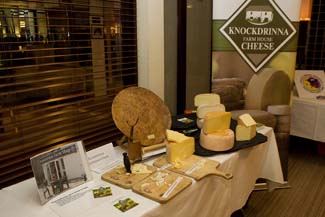
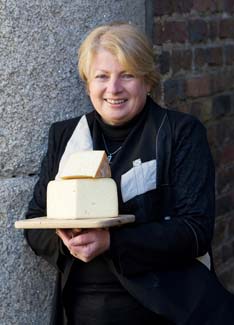 Helen Finnegan’s wonderful sheeps’ cheese has attracted much praise – most recently earning one of just five of the Irish Food Writers Guild Food Awards.
Helen Finnegan’s wonderful sheeps’ cheese has attracted much praise – most recently earning one of just five of the Irish Food Writers Guild Food Awards. Having long yearned to do something on her husband Robert’s family farm located bang in the middle of the village of Stoneyford, Co. Kilkenny, Helen began making cheese in the back kitchen six years ago, as an experiment, using goats milk from a neighbour; as each one tasted better than the last, she became hooked.
She began winning industry awards and is now highly regarded as a farm cheesemaker producing a variety of cheeses – and it was in response to consumer demand that she began making Knockdrinna Farmhouse Sheeps Cheese.
Made from March to October (with milk from a previous Guild award winner Henry Clifton-Browne’s flock) this is a distinctive cheese with a golden rind produced by washing three times a week with organic white wine, which Helen believes is a major factor in the development of the flavour.
 Acidic when young, a caramel flavour gradually emerges and, by 4-6 months, when it is probably at its best, a characteristic robust, sweeter earthiness develops. Knockdrinna cheeses are made on farm in a purpose-built unit inserted into an old farm building that holds the temperature and humidity in the curing rooms really well.
Acidic when young, a caramel flavour gradually emerges and, by 4-6 months, when it is probably at its best, a characteristic robust, sweeter earthiness develops. Knockdrinna cheeses are made on farm in a purpose-built unit inserted into an old farm building that holds the temperature and humidity in the curing rooms really well.Farmers’ markets led to speciality shops like Sheridan’s and, remarkably soon, to winning Irish and UK cheese competitions and providing employment for four people. Long term viability was an issue. With no wish to expand further and go the supermarket route, another old stone building was converted into a farm shop, open five days a week. The whey is used to feed their own free-range pigs and flavour their pork and dry-cured bacon.
The cheeses are available in farmer’s markets, specialist Delis, Sheridans and from the Finnegan’s own farm shop. [Knockdrinna Farmhouse Cheese, Stoneyford, Kilkenny. Tel: 056 7728446; www.knockdrinna.com ]
© Recipe created by Derry Clarke, L'Ecrivain, for the 2010 Irish Food Writers Guild Food Awards
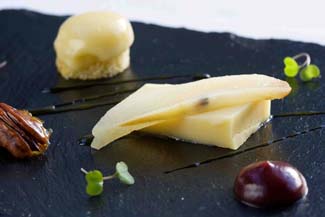 Knockdrinna Meadow sheeps cheese, rarebit with port & pear purée and candied pecans
Knockdrinna Meadow sheeps cheese, rarebit with port & pear purée and candied pecansClick for recipe
Fermanagh Free Range Chicken
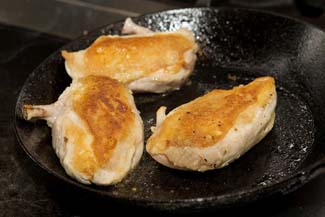
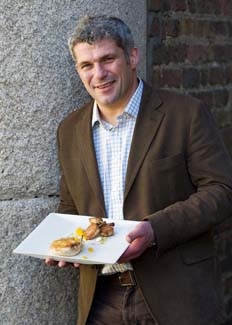 Kettyle Irish Foods is an innovative food company producing a variety of speciality food products developed out of the 500 acre family farm in Co Fermanagh, which had mainly reared beef for export to Europe and beyond.
Kettyle Irish Foods is an innovative food company producing a variety of speciality food products developed out of the 500 acre family farm in Co Fermanagh, which had mainly reared beef for export to Europe and beyond.In 2004 Maurice Kettyle realised that there was a niche market for the very best of Irish food products such as dry-aged beef, Lough Erne Lamb, naturally reared Irish rose veal and really good chickens.
The beef, in particular, is now well known and is credited on many of the best restaurant menus in Ireland and Britain. The chicken, however, has been a well-kept secret until recently. Chicken with a texture and well-developed flavour that attracts the attention of the leading chefs and speciality food retail outlets is a rare bird these days – and, in recognition of the excellent eating quality of Fermanagh Free Range Chickens, Kettyle Irish Foods received an Irish Food Writers' Guild award last month.
 Maurice Kettyle, with the aim of producing chicken that is good to eat, has developed a programme that involves good husbandry, good welfare, good feeding and a carefully thought out processing system. These chickens are genuinely free to roam and scratch around outside in paddocks.
Maurice Kettyle, with the aim of producing chicken that is good to eat, has developed a programme that involves good husbandry, good welfare, good feeding and a carefully thought out processing system. These chickens are genuinely free to roam and scratch around outside in paddocks. The combination of exercise and a carefully planned programme enables the chickens to grow slowly and naturally without having to resort to restricting their diet to stop them getting too big.
Like all animals, a stress-free end has a beneficial effect on the eating quality. Add skilled butchery, a process that does not use water, and the end result is tender, fully-flavoured, succulent flesh - chicken like it used to be. A real treat.
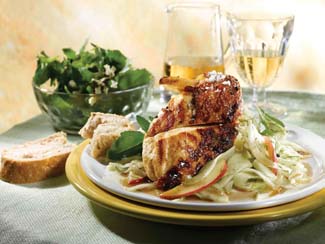 Chicken Breast with Fennel and Rocket Salad
Chicken Breast with Fennel and Rocket SaladSimple and special, this takes only 30 minutes to cook, and the salad can be prepared ahead. Its simplicity makes this an ideal dish for cooking free range chicken, allowing the flavour and texture to speak for itself.
Click for recipe
Nicky's Plaice Smoked Salmon
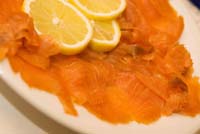
 Smoked salmon is a popular speciality food all around Ireland, and it is surprising how much its character can vary, in colour, texture and flavour. There tends to be a noticeable difference in texture between the muscular wild salmon (or farmed fish that have been raised in strong tidal waters offshore, eg Clare Island salmon) and salmon from inshore fisheries where the fish have less exercise, resulting in softer flesh.
Smoked salmon is a popular speciality food all around Ireland, and it is surprising how much its character can vary, in colour, texture and flavour. There tends to be a noticeable difference in texture between the muscular wild salmon (or farmed fish that have been raised in strong tidal waters offshore, eg Clare Island salmon) and salmon from inshore fisheries where the fish have less exercise, resulting in softer flesh. And, generally speaking, very orange flesh is likely to the result of additives to the feed of farmed salmon, making paler fish more desirable. But the smoking process also has to be taken into account and that varies a great deal from one smoker to another – each has their ‘secret recipe’, which makes the product unique.
An interesting example is the highly-regarded smoked salmon prepared by Nicky’s Plaice (+353 (0)1 832 3557) on the West Pier in Howth, Co Dublin; established in 1959, it is the oldest shop on the pier – and here the traditional process ensures the salmon is a rich orange/brown colour.
 People travel from far and wide to purchase Nicky’s smoked salmon, and the area’s leading seafood restaurant, The King Sitric, is proud to name Nicky’s Plaice as sole suppliers – as they have done for many years. Proprietor/chef Aidan MacManus goes misty-eyed when talking about this product, which is made in one of the few remaining traditional smokeries, to a secret recipe devised by Nicky McLoughlin, the recent recipient of an Irish Food Writers’ Guild Lifetime Achievement Award. Nicky is now semi-retired and his son Martin runs the business, but he is careful to maintain the traditions that make their salmon special.
People travel from far and wide to purchase Nicky’s smoked salmon, and the area’s leading seafood restaurant, The King Sitric, is proud to name Nicky’s Plaice as sole suppliers – as they have done for many years. Proprietor/chef Aidan MacManus goes misty-eyed when talking about this product, which is made in one of the few remaining traditional smokeries, to a secret recipe devised by Nicky McLoughlin, the recent recipient of an Irish Food Writers’ Guild Lifetime Achievement Award. Nicky is now semi-retired and his son Martin runs the business, but he is careful to maintain the traditions that make their salmon special.They say that time is really the secret ingredient, as Nicky’s Plaice use “an age-old process established some 200 years ago, and traditional methods, to ensure that the distinctive consistency and the taste that people have come to savour in our smoked salmon remains constant.”
The salmon is smoked over oak wood shavings ‘for hours’; this is now done in a kiln specially designed by Martin McLoughlin, that ensures an unchanged process while incorporating the requirements of modern hygiene codes and regulations.
The fish is skinned, trimmed, sliced and pin boned so it is ready to use, without waste; it is sold with a 21 day best-before date but, as it is fresh, it can be frozen if required. Incidentally, Nicky’s Plaice is one of the few fishmongers offering natural un-dyed smoked cod, haddock and herring - and probably the only one offering fish cookery classes.
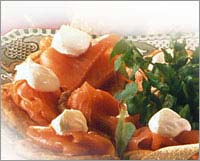 Smoked Salmon on Potato Cakes with Soured Cream
Smoked Salmon on Potato Cakes with Soured CreamIt’s hard to beat the classic way of serving smoked salmon – with good brown soda bread, a grinding of black pepper and a squeeze of lemon – but, when a change is called for, this makes a very good, easy to prepare starter. The potato cakes can be made ahead and reheated - and they could also be frozen until needed, if required, then defrost and reheat as below.
Serves 6
Click for recipe
Omega Direct Irish Organic Beef - Farming with Altitude
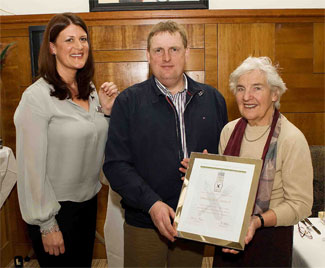
 Joe and Eileen Condon’s farm close to the Knockmealdown mountains in Co Tipperary, is a model farm for a state initiative “Farming with Altitude”, which has been developed to encourage use of the 450,000 acres of commonage in Ireland.
Joe and Eileen Condon’s farm close to the Knockmealdown mountains in Co Tipperary, is a model farm for a state initiative “Farming with Altitude”, which has been developed to encourage use of the 450,000 acres of commonage in Ireland. On their hill farm they produce exceptionally flavoursome beef, traceable from mountain to marketplace, using farming methods that are a model of sustainability.
The story begins in 1992 when Joe and Eileen moved back to Ireland after a period abroad, acquired ‘a rambling tract of hill land’, and converted to organic farming. Then, with a view to producing entirely grass-fed beef on their farm they explored different breeds, settling on Galloway, a breed with a double coat of hair, thick skin and the ability to thrive outside in harsh weather conditions.
The animals graze outdoors all year round so the land is fertilised directly, doing away with the need for artificial fertilisers.
The stocking rate is geared to a level that discourages scrub and encourages plant diversity. A recent ecological survey revealed 64 different plant species per hectare - a diet that is ideal for producing well-flavoured beef, it is also thought to increase levels of omega 3 and reduce methane emissions, as well as helping to build up the soil and prevent flooding.
A few miles away in Lismore, a respected craft butcher takes care of slaughtering. The whole carcass goes back to the farm (including all the interesting cuts like tongues and tails that are now often dumped) to a new on-farm packing unit for their company Omega Beef.
From there it is sold direct to restaurants, and retailed at Ardkeen Artisan and Fine Food Store, Waterford City, at local farmers’ markets (Dungarvan every Thursday; Waterford City Ardkeen, second Sunday of the month) and online (www.omegabeefdirect.ie). To order online you download a form, complete it and post with a cheque – a choice of three boxes is offered, with delivery available anywhere in Ireland.
Omega Beef employs a modern traceback system, plus an open farm gate policy, whereby customers are welcome to visit by arrangement and see this unique low-impact organic beef farm first-hand.
The 2010 Irish Food Writers’ Guild Environmental Award was presented to Joe and Eileen Condon, in recognition of their achievements in sustainable farming.
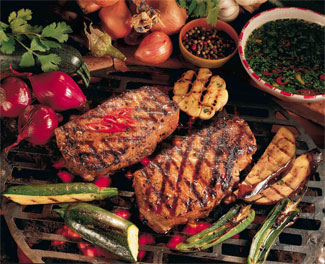 RECIPE: Steak with Grilled Summer Vegetables
RECIPE: Steak with Grilled Summer VegetablesA simple seasonal grill, to cook on the barbecue or in the kitchen.
Click for recipe
Blueberries
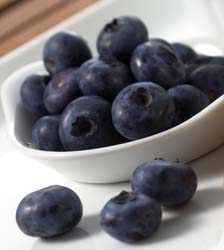
 Now widely recognised as a ‘superfood’, blueberries are virtually fat and cholesterol free, low in calories, high in vitamins A and C high in dietary fibre, high in calcium, require little sweetening - and have more antioxidants than most other fruits and vegetables...
Now widely recognised as a ‘superfood’, blueberries are virtually fat and cholesterol free, low in calories, high in vitamins A and C high in dietary fibre, high in calcium, require little sweetening - and have more antioxidants than most other fruits and vegetables...All this, and much more, can be said of their health-giving properties but, aside from all that, they’re absolutely delicious – and, although most of the blueberries in shops are imported (check the label), they’re in season in Ireland now!
What’s more, thanks to last winter’s severe cold, which reminded them of home and suited them to a tee, the high bush American blueberries grown on cutaway bog at Derryvilla Blueberry Farm (www.derryvillablueberries.com) in Co Offaly are producing a bumper crop this year.
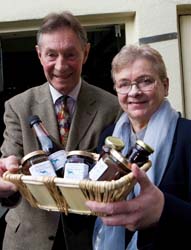 The Derryvilla Blueberry Farm is owned by John Seager and managed by Nuala O’Donoghue. Blueberry farming is labour intensive; at the start of each year the bushes are hand pruned and the grasses cut. They then flower in May and by mid-July, weather permitting, handpicking begins.
The Derryvilla Blueberry Farm is owned by John Seager and managed by Nuala O’Donoghue. Blueberry farming is labour intensive; at the start of each year the bushes are hand pruned and the grasses cut. They then flower in May and by mid-July, weather permitting, handpicking begins.They’re closely related to the native Irish fraughan or bilberry, a fruit associated with celebration, feasting and fertility, and the much bigger cultivated berry is a juicy, versatile fruit that can be used in the same ways, fresh or in baking, desserts, preserves and drinks.
The history of Derryvilla Blueberry Farm involves a number of dedicated farming pioneers including, for the last five years, Nuala O’Donoghue who has been involved, in particular, with development of the innovative Blueberry Tonic and delicious blueberry preserves – both of which are out-sourced to other well-known artisan food producers such as Con Traas of The Apple Farm in Clonmel and Ciara Morris of Slieve Bloom Foods.
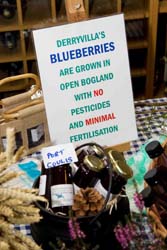 No pesticides are used at Derryvilla and most of their delicious, naturally grown berries and the products made with them – a tangy blueberry tonic and preserves - are supplied directly to fruit traders and selected retailers, or sold at Farmleigh Food Market (www.farmleigh.ie.)
No pesticides are used at Derryvilla and most of their delicious, naturally grown berries and the products made with them – a tangy blueberry tonic and preserves - are supplied directly to fruit traders and selected retailers, or sold at Farmleigh Food Market (www.farmleigh.ie.) But there is also a farm shop on site, and the popular “pick your own” option makes a great family day out during the summer months.
RECIPE:
Blueberry Crisp Rice Cobbler
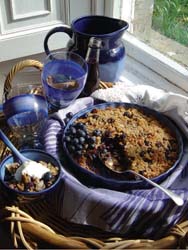 Prannie Rhatigan’s cookbook, ‘The Irish Seaweed Kitchen’ (see August Cookery Feature) includes some lovely dessert recipes. Prannie and her family enjoy picking blueberries at Derryvilla Blueberry Farm (www.derryvillablueberries.com) and they are in season now, so the timing is perfect for making this cobbler.
Prannie Rhatigan’s cookbook, ‘The Irish Seaweed Kitchen’ (see August Cookery Feature) includes some lovely dessert recipes. Prannie and her family enjoy picking blueberries at Derryvilla Blueberry Farm (www.derryvillablueberries.com) and they are in season now, so the timing is perfect for making this cobbler. Blueberries are ‘superfoods’, best eaten uncooked, either fresh or in smoothies from frozen, but they’re also delicious cooked. Prannie says this dish also works well using rice milk and spelt flour; similarly, oat flakes could be used instead of rice flakes.
Seaweed Used: Nori
Serves: 6
Click for recipe
Castlefarm Organic Farm Foods
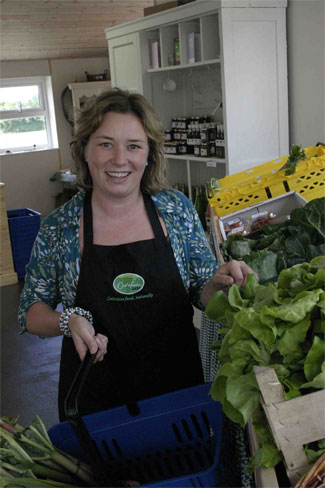
 Although we are now a widely urbanised society, a high proportion of Irish people have country connections - yet there were worrying signs, during the boom years, of growing disconnection with our rural roots.
Although we are now a widely urbanised society, a high proportion of Irish people have country connections - yet there were worrying signs, during the boom years, of growing disconnection with our rural roots. But all that is changing as concern about the economy, and issues like food security and provenance, are all stimulating a fresh appreciation of seasonal, local produce - and inspiring thousands to grow their own food, often on allotments.
Energetic, passionate and multi-talented people like Peter and Jenny Young, fourth generation custodians of a170-acre organic farm between Athy and Kilcullen, are making a valuable contribution to this changing scene with their open farm policy (tours arranged), farm shop and communications skills.
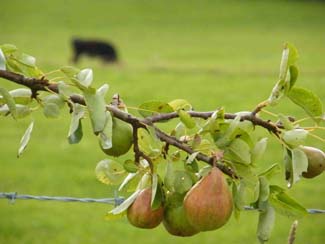 While mainly dairy (Jersey cross and British Friesian cows), plus organic tillage, poultry and beef, Castlefarm is rapidly diversifying; certified organic in 2008, they grow organic vegetables and fruit, produce honey - and their milk is now used by local cheesemaker Elizabeth Bradley of Carlow Cheese (www.carlowfarmersmarket.ie) to make Castlefarm Natural (gouda style) and Shamrock (with fenugreek) cheeses; Kildare’s first farmhouse cheese, it’s easily recognised by its distinctive green wax coating.
While mainly dairy (Jersey cross and British Friesian cows), plus organic tillage, poultry and beef, Castlefarm is rapidly diversifying; certified organic in 2008, they grow organic vegetables and fruit, produce honey - and their milk is now used by local cheesemaker Elizabeth Bradley of Carlow Cheese (www.carlowfarmersmarket.ie) to make Castlefarm Natural (gouda style) and Shamrock (with fenugreek) cheeses; Kildare’s first farmhouse cheese, it’s easily recognised by its distinctive green wax coating. Castlefarm Farm Shop sells their own and other quality local produce and “Visitors will not only receive a warm country welcome, but will leave having learnt something new about farming and experience a real food and taste sensation.”
Jenny also has a stall at Athy Farmers’ Market and Craft Fair every Sunday, and both she and Peter are influential journalists. A powerhouse package if ever there was one.
Castlefarm Organic Farm Foods
Narraghmore near Athy Co Kildare
(www.castlefarmshop.ie; +353 (0)59 863 6948 / +353 (0)87-678 5269)
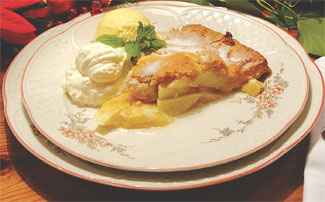 RECIPE: Double Crust Apple Pie
RECIPE: Double Crust Apple Pie Everyone’s favourite comfort food to round off an autumn meal - this version of the traditional apple plate pie is from Irish Country House Cooking, The Blue Book Recipe Collection.
Serves 8
Click for recipe
Flahavan's Oats
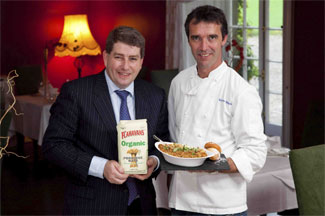
 One of the unsung heroes of the Irish food scene, oats are widely grown, inexpensive, nutritious and extremely versatile. There’s much more to oats than breakfast but, whether in porridge or other oat-based dishes like granola, their slow-release energy means they’re pretty much the perfect start to the day.
One of the unsung heroes of the Irish food scene, oats are widely grown, inexpensive, nutritious and extremely versatile. There’s much more to oats than breakfast but, whether in porridge or other oat-based dishes like granola, their slow-release energy means they’re pretty much the perfect start to the day. Growing conditions in Ireland suit oats well and this sixth generation family firm has been milling oats at Kilmacthomas for over 200 years, making it one of Ireland’s longest-running family businesses. All of their standard oats are produced in Ireland, and they’re actively encouraging more Irish organic oat production to meet demand.
Over a million servings of Flahavan’s porridge are consumed nationwide each week, so we’re told, and the taste of the nation was confirmed in recent Great Taste Awards when two of their products - Flahavan’s Organic Porridge Oats and Flahavan’s Organic Jumbo Oats - were awarded a Gold Star for their texture and taste.
Rightly keen to emphasise their versatility, Flahavans commission recipes from celebrity chefs such as Kevin Dundon (of nearby Dunbrody House Hotel) and - very useful for everyday ideas - there’s a handy booklet of Mary Flahavan’s own Simple Oat Recipes too.
Flahavan’s Oats
E. Flahavan & Sons Limited Kilnagrange Mills Kilmacthomas Co Waterford
(+353 (0)51 294107; www.flahavans.com)
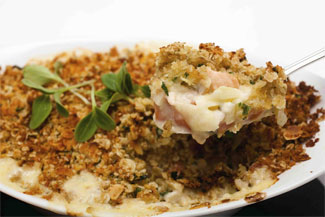 RECIPE: Fish Pie with Oat Topping
RECIPE: Fish Pie with Oat Topping Everybody loves a good fish pie, and it is a versatile dish that can be varied with the seasons. Using the oats that are an important crop in the South-East region, the crumble topping used here makes a nice variation on the usual potato or pastry.
Fresh fish from ports like Helvick, Kilmore Quay and Duncannon is easily available in the South-East (and distributed throughout the country), and the combination can be varied - the special mixtures sold in chunks by fishmongers may also be used instead of fillets in this recipe, but be careful not to overcook them.
Smoked fish is especially useful in winter, but don’t use more than half the quantity of at the most, as the strong flavour will overpower other ingredients.
This pie can be assembled and grilled to serve immediately, or prepared ahead then reheated and browned in the oven.
Serves 4-6
Click for recipe
Handmade Christmas Puddings
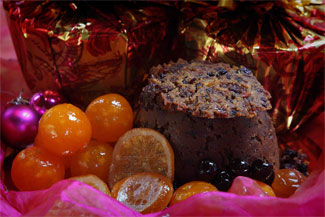
 Festive baking is a joy and many people especially enjoy both making and eating the traditional plum pudding, which is a very appealing hot dessert throughout the colder months.
Festive baking is a joy and many people especially enjoy both making and eating the traditional plum pudding, which is a very appealing hot dessert throughout the colder months. Artisan producers offer good alternatives for anyone who hasn’t time to make their puddings and some outstanding traditional examples to look out for in Ireland include Seerys (+353 (0)59 9142461 www.seerys.ie) of Tinryland, Co Carlow, who have earned an international reputation for their traditional Irish fruit cakes and puddings, notably Christmas specialities products, and those made at at Florrie Purcell’s The Scullery (+353 (0)86 174 4402), of Nenagh, Co Tipperary who include individual Christmas puddings in their often-praised traditional range.
More unusually, Arun Kapil’s Green Saffron Christmas Pudding is made in Midleton, Co Cork, home to Ireland’s most famous family-run spice business.
 Country Choice of Nenagh, Co Tipperary are renowned for many things including the range and quality of their baking ingredients (also available in their shop, see In Season), and have earned a great reputation for their Christmas puddings.
Country Choice of Nenagh, Co Tipperary are renowned for many things including the range and quality of their baking ingredients (also available in their shop, see In Season), and have earned a great reputation for their Christmas puddings. Each year Peter and Mary Ward mix over a thousand puddings by hand, to avoid damaging the texture of the fruit:
“At Country Choice each evening in the dark days of November and December, we make tons of Christmas puddings in our kitchen behind our shop in Kenyon Street in Nenagh. We make all our traditional puddings by hand in our kitchen sink without the use of electric mixers etc.” explains Peter.
“We use the best fruit in the world from Malaga muscatel raisins to whole peel from Catalayud in Spain, to glacé apricots and melons. We use local organic carrots, Nenagh butter and free range eggs from Mrs. Mooney in Roscrea.
We are very particular with the texture of our puddings and we make sure not to boil the fresh fruit flavour out of them. Our Christmas puddings taste of orange and lemon and butter and fruit. We post them all over the world for our customers as gifts.”
(Available from the shop in Nenagh, and online from their website, where you can also see details of the particular fruits used.)
This version of the Traditional Christmas Pudding is a favourite in my own family. Quite similar to the Country Choice pudding, it’s especially light, as it contains only breadcrumbs and no flour, and it is best made with premium fruit, which can include beautiful whole glacé fruits, and fresh spices.
Store puddings in a cool and dry place, or refrigerate. Makes two 2-pint/1 litre puddings, each serving 8.
Click for Christmas Pudding Recipe
ChocoNeill Handmade Chocolates

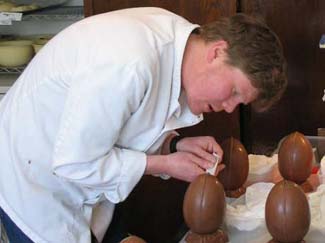 Quality chocolate production is on of Ireland’s biggest recent artisan success stories, and Aughnacliffe, Co Longford is a very special destination for chocolate connoisseurs as this is where Jamie and Beatrice O’Neill make the outstanding ChocOneill range at their workshop in Dunbeggan, Aughnacliffe (+353 (0)86 212 8067; www.choconeill.ie).
Quality chocolate production is on of Ireland’s biggest recent artisan success stories, and Aughnacliffe, Co Longford is a very special destination for chocolate connoisseurs as this is where Jamie and Beatrice O’Neill make the outstanding ChocOneill range at their workshop in Dunbeggan, Aughnacliffe (+353 (0)86 212 8067; www.choconeill.ie).
They specialise in single origin chocolate and use fresh, seasonal ingredients, so the range is constantly changing and has a shorter shelf life than most chocolates – all adding to the sense of special treat. While new products are added on a regular basis, they are particularly known for their sumptuous truffles and pralines.
 Scrupulous attention to detail is the O’Neills’ hallmark, from the selection of ingredients – including single bean (Criollo, Trinitario and Forastero, from Mexico, Venezuela, Ecuador and Madagascar) and single plantation plain chocolate, and also local Irish seasonal ingredients such as fresh raspberries and Wicklow honey – to the care taken with hand tempering and individually dipping their chocolates, to give them ‘perfect shine and snap’, and beautiful, thoughtfully designed packaging.
Scrupulous attention to detail is the O’Neills’ hallmark, from the selection of ingredients – including single bean (Criollo, Trinitario and Forastero, from Mexico, Venezuela, Ecuador and Madagascar) and single plantation plain chocolate, and also local Irish seasonal ingredients such as fresh raspberries and Wicklow honey – to the care taken with hand tempering and individually dipping their chocolates, to give them ‘perfect shine and snap’, and beautiful, thoughtfully designed packaging.
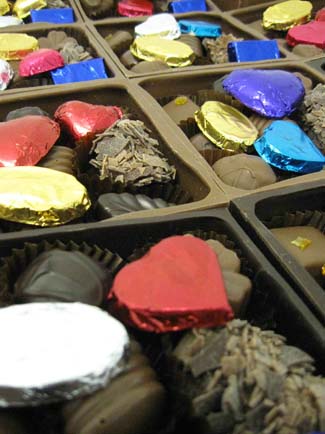 A charming speciality – although the contents will vary – is their Boîte en Chocolat (Chocolate Box), which is made like a proper lidded box or an Easter egg, with a 70% chocolate or milk chocolate shell encasing a selection (or your personal choice) of fresh chocolates, truffles and pralines. This saves on wasteful packaging – and means that almost every scrap of what you buy can be eaten, right down to the last finger-licking chip!
A charming speciality – although the contents will vary – is their Boîte en Chocolat (Chocolate Box), which is made like a proper lidded box or an Easter egg, with a 70% chocolate or milk chocolate shell encasing a selection (or your personal choice) of fresh chocolates, truffles and pralines. This saves on wasteful packaging – and means that almost every scrap of what you buy can be eaten, right down to the last finger-licking chip!
Choconeill also do a range of special occasion chocolates such as Valentine’s Day, Mother’s Day and Christmas, wedding favours, chocolate hampers and corporate gifts – its seems there is nothing this talented team has overlooked, and they also like nothing better than the challenge of a special commission if you want something different.
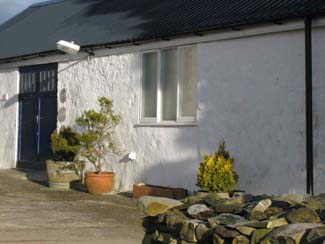 Almost all current products can be bought at Naas Farmers’ Market (Saturdays); online from their excellent website (weekday courier service, from as little as €6), or directly from the workshop - visit by appointment on weekdays, please phone in advance. [Also at: 6D Lakelands, Naas, Co. Kildare.]
Almost all current products can be bought at Naas Farmers’ Market (Saturdays); online from their excellent website (weekday courier service, from as little as €6), or directly from the workshop - visit by appointment on weekdays, please phone in advance. [Also at: 6D Lakelands, Naas, Co. Kildare.]
Cuinneog
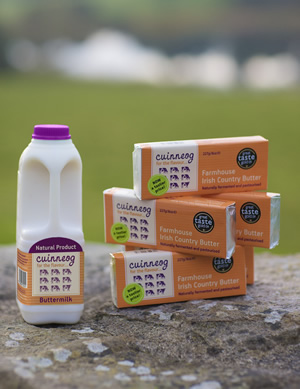
 On the family farm near Castlebar in Co Mayo, Tom and Sheila Butler have run their business Cuinneog Dairy Products (www.cuinneog.com) since 1990.
On the family farm near Castlebar in Co Mayo, Tom and Sheila Butler have run their business Cuinneog Dairy Products (www.cuinneog.com) since 1990. They specialise in the production of once-familiar dairy products which are now almost unique – Irish farmhouse country butter and natural buttermilk. Originally known as ‘Sheila’s Country Butter’, the business was re-launched recently as Cuinneog, which is the Irish word for ‘churn’.
It was originally made in a traditional wooden churn and, although stainless steel churns are now used, the product is unchanged and still made by traditional methods – and now, smartly re-packaged, this fuller-flavoured butter and natural buttermilk is appreciated by a wider public.
Irish country butter was once made routinely on most small-scale dairy farms, but it is now hard to come by. So a product like Cuinneog, which has a unique flavour and is part of the long tradition of butter making in Ireland, is very welcome and has attracted a lot of well-earned praise.
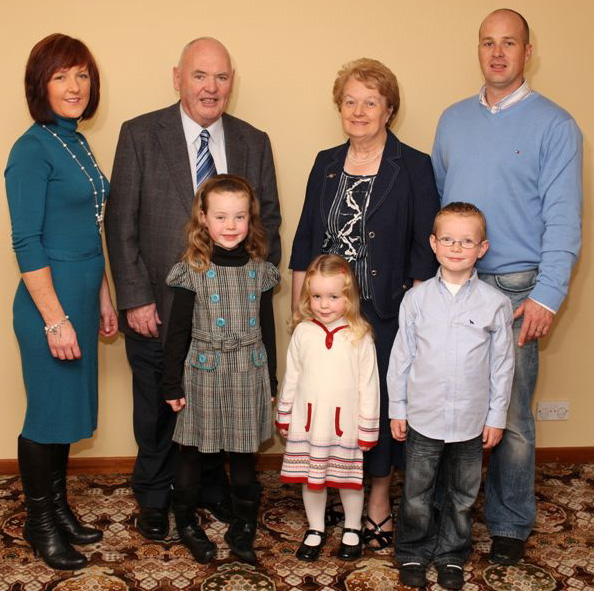 It was the reason that the Butlers were selected to be one of just five recipients of an EirGrid Euro-Toques Food Award in 2010, for example, and these Good Food Ireland members have also won Gold in the Great Taste Awards (2006 and 2009).
It was the reason that the Butlers were selected to be one of just five recipients of an EirGrid Euro-Toques Food Award in 2010, for example, and these Good Food Ireland members have also won Gold in the Great Taste Awards (2006 and 2009).Both Cuinneog Irish Farmhouse Country Butter and Cuinneog Natural Buttermilk (which is a by-product of the butter-making process) are available nationwide, in branches of Superquinn, SupeValu, Dunnes Stores, Tesco, Asda, Centra, Spar & Londis.
RECIPE:
Hazelnut Coffee Cake
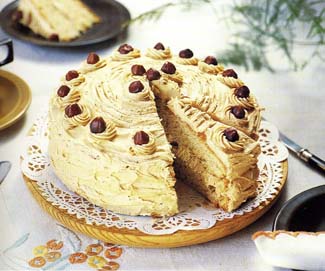 Using quality butter makes all the difference in baking, as my mother always said, and this was one of my father’s favourite cakes.
Using quality butter makes all the difference in baking, as my mother always said, and this was one of my father’s favourite cakes. Coffee and nuts combine well in cakes - walnuts are most usual, but hazelnuts make an even better combination as you’ll find when you try this simple but attractive cake, which is from my 1992 cookbook, Meals For All Seasons (available only from Ireland-guide .com).
Click for recipe
O'Neill Foods Dry-cured Bacon and Ham

 The excellent dry-cured bacon and ham produced in Co Wexford by O’Neill Foods was one of the winners at the 2011 Irish Food Writers' Guild Food (IFWG) Awards.
The excellent dry-cured bacon and ham produced in Co Wexford by O’Neill Foods was one of the winners at the 2011 Irish Food Writers' Guild Food (IFWG) Awards. Having been born into a fairly small farm on the slopes of Slieve Bhuidhe, near Ferns in Co Wexford, where the family devoted some of the land to growing strawberries and raspberries that do so well in the sunny South-East, Pat O’Neill was initiated into hands-on high quality food production from an early age.
Pat chose a career in food, qualified in food quality control and spent a decade working in two highly regarded meat production companies in the region, Slaney Meats and Callan Bacon. Then, in 2004, he decided to set up on his own, and to specialise in that most important (and, until recent years, sadly neglected) area of traditional Irish food, hand-crafted, dry-cured bacon and hams.
The production unit in Ferns was designed and fitted to his own specification. His aim was to produce tender, well-flavoured bacon and ham, all meat for your money, low in salt, with no phosphates and no added water - just pure tasty bacon. That is what you get and that’s why O’Neill’s Foods have won an IFWG award. It’s a world away from commercially wet-cured bacon.
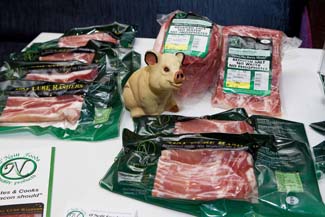 Dry-curing involves hand rubbing a mixture of sugars and salt into every piece of meat, turning and reapplying over a period of up to three weeks for the hams and about two weeks for smaller pieces.
Dry-curing involves hand rubbing a mixture of sugars and salt into every piece of meat, turning and reapplying over a period of up to three weeks for the hams and about two weeks for smaller pieces.Pat supplies to many leading chefs in the south-east including Eugene O’Callaghan of Kelly's Hotel of Rosslare who (much to Pat’s delight) won the Georgina Campbell Hotel Breakfast of the Year in 2011.
Pat’s business supports two full-time and two part-time jobs and a living for Pat, his wife and three small children. Output has grown 10% every year. With good cost control, Pat has not increased his prices for over five years and the product gives real value for money.
As well as selling wholesale into specialist food shops, butchers and restaurants, Pat runs stalls at Gorey and Enniscorthy Farmers’ Markets and, in cooperation with a Wexford lamb producer, at other markets including Dun Laoghaire. Currently, to meet demand, he is working on producing smoked bacon, pancetta and bacon lardons.
RECIPE:
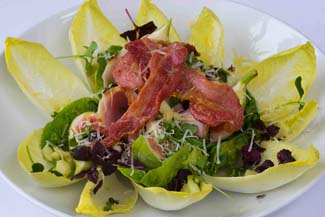 O'Neills Dry-Cured Bacon salad with figs and an apple & honey dressing
O'Neills Dry-Cured Bacon salad with figs and an apple & honey dressingThis lovely dish was created by Derry Clarke of the acclaimed Dublin restaurant, L'Ecrivain, for the lunch held to celebrated the Irish Food Writers Guild Awards 2011 - which showcased all of the award-winning products (see main Cookery Feature).
Although served as starter or ‘between course’ on this occasion, the quantities are generous and this would easily make a summery main course to serve at least four. It would also be good as part of a buffet selection for a party, served on a platter.
Click for recipe
Sheridans Cheesemongers
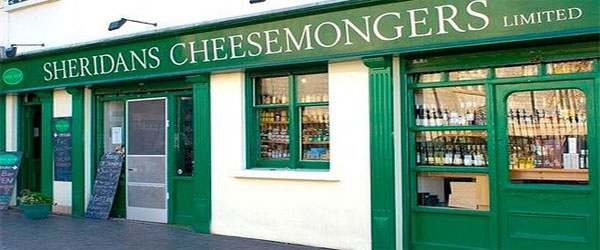
 Where would our producers be without those who sell their foods, and who help them to reach the public in prime condition? Recent weeks have seen unprecedented media interest and public discussion focusing on Irish produce, the people who make it and – most importantly – the places where they sell it.
Where would our producers be without those who sell their foods, and who help them to reach the public in prime condition? Recent weeks have seen unprecedented media interest and public discussion focusing on Irish produce, the people who make it and – most importantly – the places where they sell it. So, we’re happy to go slightly off-theme this month by highlighting some exceptional people who nurture, distribute and sell artisan products, rather than make it – and whose passion for artisan cheeses (notably maturing them and then selling them at their peak of perfection) has been a crucial factor in the success story that is Irish Farmhouse Cheese.
Sheridans Cheesemongers (www.sheridanscheesemongers.com) is one of the true greats in the quality Irish foods sector and its development over the last three decades has been fundamental to the growth of Irish farmhouse cheese.
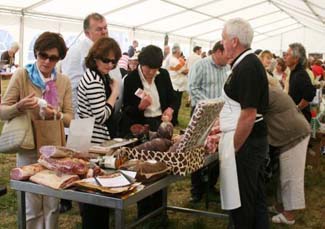 Brothers Seamus and Kevin Sheridan started the business that is now a household name by selling cheese at Galway farmers’ market many moons ago and their partner, Fiona Corbett, joined them in 1997. They now have shops in Galway and Dublin and, since 2007, their headquarters has been in a converted 19th century railway station in Carnaross, north Co Meath.
Brothers Seamus and Kevin Sheridan started the business that is now a household name by selling cheese at Galway farmers’ market many moons ago and their partner, Fiona Corbett, joined them in 1997. They now have shops in Galway and Dublin and, since 2007, their headquarters has been in a converted 19th century railway station in Carnaross, north Co Meath. They received the Ellison award from An Taisce for restoration and conservation of the building, where there is also a shop – and it is the venue for their second Irish Food Festival, on 29th May, and event which brings together many of the country’s greatest artisan food producers..
They are not just famous for their wonderful shops, but most of all for the close relationships forged with cheesemakers (now extended to other small food producers) and their passionate care of their cheeses, which are kept in a temperature controlled environment and minded like babies as they mature.
Whether it be a single portion sold to a customer or a delivery to a hotel or restaurant, their cheeses are only released at the peak of their perfection.
The Sheridans team have been singled out for many honours down the years, including Irish Food Writers’ Guild Good Food Awards, and they have most recently been presented with the 2011 Restaurants Association of Ireland Mike Butt Award.
Speaking at the presentation, former RAI President Paul Cadden commented, “As a nation we are back to basics and it has been the mantra of our Association to support local producers and buy Irish. Therefore, when you see a group of people like Fiona, Kevin and Seamus flying the flag for Irish Cheese and artisan producers they deserve and must be rewarded. They are truly passionate and have passed on that drive, determination and belief to so many small producers. They have also helped elevate the standard of Irish cuisine in restaurants by supplying such excellent product.”
RECIPE:
Warm Salad of Gubbeen Cheese and Bacon
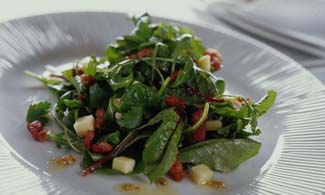 This delicious salad is a favourite of one of Ireland’s most highly esteemed chefs, Rory O’Connell (www.rgoconnell.com; +353 (0)86 851 6917), who is known for a pure, simple style that highlights the quality of seasonal and artisan ingredients. He gives intensive one-day classes at his home at Ballycotton in East Cork. It was selected as one of the recipes published in our new food tourism book, Ireland For Food Lovers (Epicure Press, €20)
This delicious salad is a favourite of one of Ireland’s most highly esteemed chefs, Rory O’Connell (www.rgoconnell.com; +353 (0)86 851 6917), who is known for a pure, simple style that highlights the quality of seasonal and artisan ingredients. He gives intensive one-day classes at his home at Ballycotton in East Cork. It was selected as one of the recipes published in our new food tourism book, Ireland For Food Lovers (Epicure Press, €20)Serves 6
Click for recipe
Rapeseed Oil
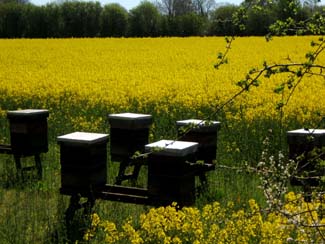
 A new product which looks set to play an important role in Ireland’s agriculture and cuisine is RAPESEED OIL and, while the changes this crop brings to the landscape are not universally welcome, the product itself is proving to be a very acceptable alternative to imported olive oil.
A new product which looks set to play an important role in Ireland’s agriculture and cuisine is RAPESEED OIL and, while the changes this crop brings to the landscape are not universally welcome, the product itself is proving to be a very acceptable alternative to imported olive oil. An early success story is Kitty Colchester’s Happy Heart extra virgin rapeseed oil (www.secondnatureoils.com/ www.drumeenfarm.com), which is also branded ‘Second Nature’.
 It is grown on Drumeen Farm, near Urlingford, Co Kilkenny, which was established by her parents Ben and Charlotte in 1976 and is the longest-established organic farm in Ireland; the ethos continues - no potentially hazardous synthetic chemicals, fertilisers or GM seeds are used - and the culinary quality of the oil is ensured by cold pressing the seed weekly, to retain the maximum nutritional value and taste.
It is grown on Drumeen Farm, near Urlingford, Co Kilkenny, which was established by her parents Ben and Charlotte in 1976 and is the longest-established organic farm in Ireland; the ethos continues - no potentially hazardous synthetic chemicals, fertilisers or GM seeds are used - and the culinary quality of the oil is ensured by cold pressing the seed weekly, to retain the maximum nutritional value and taste. And taste good it does - although the official launch was delayed until autumn 2010 (with national distribution in place at that stage), Euro-Toques Ireland had already selected it for one of their highly valued Food Awards the previous year, following successful trials.
 Then, earlier this year, the Presidential seal of approval was added to the accolades, when the Kilkenny organic cold pressed rapeseed oil was one of the special products selected by Executive Chef (and prominent Euro-Toques member) Ross Lewis of Chapter One Restaurant for a menu (see full menu below) that showcased the best of Irish produce at the wonderful State Dinner at Dublin Castle, hosted by The President of Ireland Mary McAleese and Dr. Martin McAleese in honour of Her Majesty Queen Elizabeth II and His Royal Highness The Duke of Edinburgh on the occasion of their first state visit to Ireland.
Then, earlier this year, the Presidential seal of approval was added to the accolades, when the Kilkenny organic cold pressed rapeseed oil was one of the special products selected by Executive Chef (and prominent Euro-Toques member) Ross Lewis of Chapter One Restaurant for a menu (see full menu below) that showcased the best of Irish produce at the wonderful State Dinner at Dublin Castle, hosted by The President of Ireland Mary McAleese and Dr. Martin McAleese in honour of Her Majesty Queen Elizabeth II and His Royal Highness The Duke of Edinburgh on the occasion of their first state visit to Ireland. 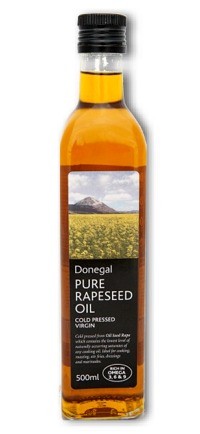 Another successful producer is the Donegal Rapeseed Oil Company (www.donegalrapeseedoilco.com), which is a small, locally owned operation based at Raphoe in Co Donegal. A Good Food Ireland member, the company was set up by Austin Duignan and Stephen Allen in 2009 to Donegal Virgin Rapeseed Oil for culinary use.
Another successful producer is the Donegal Rapeseed Oil Company (www.donegalrapeseedoilco.com), which is a small, locally owned operation based at Raphoe in Co Donegal. A Good Food Ireland member, the company was set up by Austin Duignan and Stephen Allen in 2009 to Donegal Virgin Rapeseed Oil for culinary use. They work with a number of individual small farms in Donegal and Northern Ireland, and have selective distribution in place in much of the country – so, with strong market demand established, the enterprise is already enjoying success.
Further innovation in this rapidly developing sector is to be found at the Derrycamma Farm near Castlebellingham in Co Louth, where the Rooney family have joined the growing band of farmers who grow oilseed rape for culinary use, in addition to their existing product range of free range chickens and eggs, and traditional crops of wheat, barley and oats.
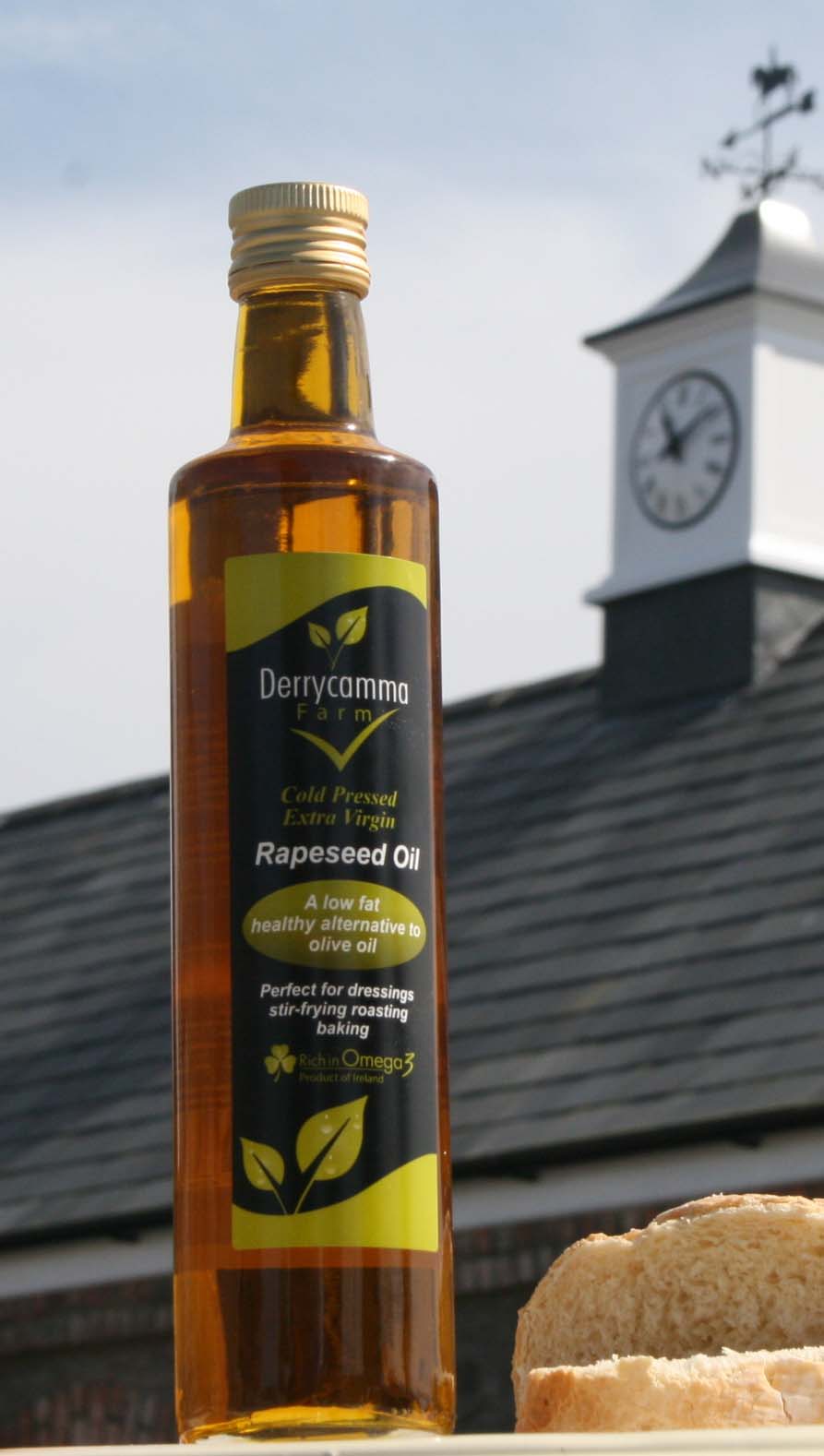 Derrycamma Farm Rapeseed Oil (www.rapeseed-oil.ie) was launched at Ireland’s largest garden festival, Bloom, in 2010 and recently brought the first flavoured Irish rapeseed oil, Garlic & Chilli, to this year’s show.
Derrycamma Farm Rapeseed Oil (www.rapeseed-oil.ie) was launched at Ireland’s largest garden festival, Bloom, in 2010 and recently brought the first flavoured Irish rapeseed oil, Garlic & Chilli, to this year’s show.Farmers like these are finding a ready market for rapeseed oil as, not only is it a healthy alternative to other oils (having, for example, lower saturated fat and higher levels of Omega 3 than olive oil) but, most importantly, it does very well in taste tests such as the Great Taste Awards too – and consumers just love the beautifully short food miles. Look out for it in selected butchers, other speciality food shops and some of the better supermarkets.
--------
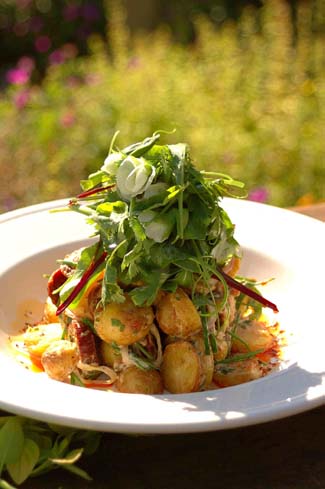 RECIPE: Warm new potato and Gubbeen chorizo salad
RECIPE: Warm new potato and Gubbeen chorizo saladIngredients from the walled kitchen garden at Ballyvolane House near Fermoy in Co Cork provide the basis for this delicious salad, which appears in Irish Country House Cooking (Epicure Press).
They also use Gubbeen chorizo, which is made by Fingal Ferguson at Schull, in West Cork and can be bought at farmers’ markets, good food shops, or by mail order (www.gubbeen.com).
The original recipe uses olive oil, but rapeseed oil can be used instead – and maybe also natural Karmine cider vinegar (www.theapplefarm.com/vinegar) and Highbank Orchard Syrup (www.highbankorchards.com), instead of the white wine vinegar and maple syrup.
Serves 4
Click for more
--------
.jpg) State Dinner hosted by The President of Ireland Mary McAleese
State Dinner hosted by The President of Ireland Mary McAleeseand
Dr. Martin McAleese
in honour of
Her Majesty Queen Elizabeth II
and
His Royal Highness The Duke of Edinburgh
MENU
Cured salmon with Burren smoked salmon cream and
lemon balm jelly, horseradish and wild watercress,
Kilkenny organic cold pressed rapeseed oil
Rib of Slaney Valley Beef, ox cheek and tongue
with smoked champ potato and fried spring cabbage,
new season broad beans and carrots with
pickled and wild garlic leaf
Carrageen set West Cork cream with Meath strawberries,
fresh yoghurt mousse and soda bread sugar biscuits,
Irish apple balsamic vinegar meringue
Irish Cheese Plate
Tea and Coffee
Château de Fieuzal, 2005, Graves Pessac-Léognan
Château Lynch-Bages, 1998, Pauillac
EXECUTIVE CHEF: Ross Lewis
CATERERS: With Taste
SUPPLIERS
Smoked salmon – Brigitta Hedda-Curtin, Burren Smokehouse, Lisdoonvarna, Co.Clare
Salmon – Clare Island organic salmon, Clare Island, Co.Mayo
Lemon balm – Paul Flynn, The Tannery cookery school gardens, Dungarvan, Co.Waterford
Organic cold pressed rapeseed oil – Kitty Colchester, Drumeen Farms, Co. Kilkenny
Wild watercress, cabbage, carrots, chive flower and garlic leaf – Denis Healy Farms, Co.Wicklow
Rib of beef – From a farm in Co Wexford, produced by Kettyle Irish Foods, Drumshaw, Lisnaskea, Co.Fermanagh
Ox cheek and tongue – M & K Butchers, Rathcoole, Co.Dublin
Black pudding – McCarthys of Kanturk, Kanturk, Co.Cork
Potatoes and spring onions – McNally family farm, Ring Common, Co.Dublin
Butter, milk, cream and crème fraîche – Alan and Valerie Kingston, Glenilen Farm, Drimoleague, Co.Cork
Irish apple balsamic vinegar and apples – David Llewellyn, Llewellyn orchard, Lusk, Co.Dublin
Strawberries – Pat Clarke, Stamullen, Co.Meath
Milk – Cleary family, Glenisk, Tullamore, Co.Offaly
Dittys Irish oatmeal biscuits – Robert Ditty, Belfast
Stoneground wholemeal flour – Kells wholemeal, Bennettsbridge, Co.Kilkenny
Buttermilk and butter – Cuinneog Ltd. Balla, Castlebar, Co.Mayo
Irish Cheeses
Glebe Brethan
Produced by David Tiernan in Dunleer, Co. Louth
Hard Comté style cheese made using raw cow’s milk from the Tiernan’s own herd of Montbéliarde cows.
Cashel Blue
Produced by the Grubb Family in Fethard, Co. Tipperary.
Semi-soft blue cheese, made using cow’s milk from their own and selected neighbouring farms.
Milleens
Produced by the Steele Family in Milleens on the Beara Peninsula, Co. Cork.
Semi-soft, washed rind cheese made in a classic Munster style from pasteurised cow’s milk.
Knockdrinna
Produced by Helen Finnegan in Stoneyford, Co. Kilkenny
Semi-firm goat’s milk cheese in the classic French Tomme style.
Achill Island Turbot
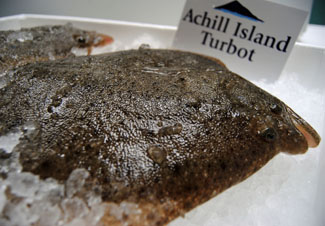
 Turbot is a flat fish with pure white flesh that is highly prized for its texture and flavour – a delicacy since Roman times, it is a favourite of that great seafood chef Rick Stein.
Turbot is a flat fish with pure white flesh that is highly prized for its texture and flavour – a delicacy since Roman times, it is a favourite of that great seafood chef Rick Stein.A large left-eyed flatfish, wild turbot (Scophthalmus maximus) is mainly found in sandy shallow waters throughout the Mediterranean, the Baltic Sea, the Black Sea and the North Atlantic, where it lives quietly on the ocean floor.
European turbot has an asymmetrical disk-shaped body, and has been known to grow up to 100 cm (39 in) long and 25 kg (55 lb) in weight; however wild stocks have been depleted in recent years, and landings are now unpredictable in size and quality.
In its natural habitat turbot lives a sedentary life, and it is ideally suited to land-based farming in pristine sea water; it is already successfully farmed in several countries, including Scotland.
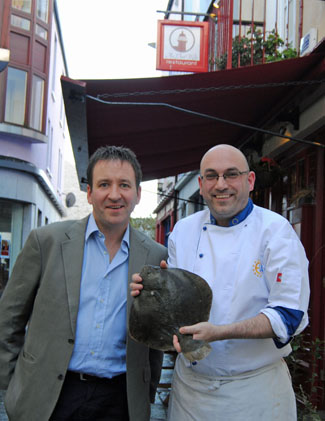 Now Michael Flanagan and Raymond Mairs’ turbot farm, Achill Island Turbot (+ 353 (0)98 47023; www.achillislandturbot.ie), at Bunnacurry on Achill Island, Co Mayo, looks set to become important in Ireland and beyond, as their top quality fresh turbot have taken the Irish the market by storm and the new facility is expected to reduce pressure on wild stocks.
Now Michael Flanagan and Raymond Mairs’ turbot farm, Achill Island Turbot (+ 353 (0)98 47023; www.achillislandturbot.ie), at Bunnacurry on Achill Island, Co Mayo, looks set to become important in Ireland and beyond, as their top quality fresh turbot have taken the Irish the market by storm and the new facility is expected to reduce pressure on wild stocks.Achill Island Turbot was established in 2008 with the objective of creating a world class recirculation aquaculture facility on the island; the recirculation system used has no negative impact to the surrounding environment and there is no visual impact on the sea coast.
Udaras na Gaeltachta has been a strong supporter of the business from the outset and BIM, the Irish Sea Fisheries Board, continue to work with the company to develop their business potential.
Sustainability is at the heart of the project and the quality fish they produce has been warmly welcomed, notably by Euro-Toques chefs.
In October 2010 members of this prestigious chefs’ association organised a trip to Co Mayo, to visit the farm and to taste the fish at the Westport seafood restaurant An Port Mór, where owner-chef Frankie Mallon prepared a special lunch to celebrate the arrival of the first Achill Island Turbot harvest.
Turbot in Tarragon and Soured Cream Sauce
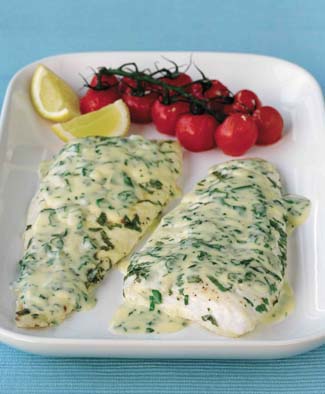 Try using Achill Island Turbot for this easy dish if you can get it. Whatever the source choose larger fish if possible, as you would with any flat fish, so that you get nice chunky fillets.
Try using Achill Island Turbot for this easy dish if you can get it. Whatever the source choose larger fish if possible, as you would with any flat fish, so that you get nice chunky fillets. As with other flat fish, turbot will yield four fillets, of which the upper two will be thicker. If turbot is unavailable, other flat fish such as John Dory or brill would be good alternatives; although not as sweetly flavoured as turbot, brill is also a fine fish and can be good value too.
It is quite difficult to distinguish a large brill from turbot but running your finger over the skin will soon tell you which is which as turbot have little lumps on their skin.
Click for Recipe
Sarahs Wonderful Honey
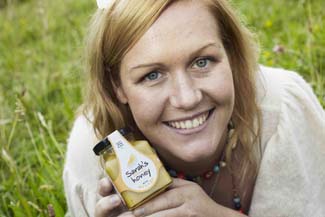
 'Sarah's Wonderful Honey' is the brainchild of Sarah Gough, who is General Manager of her family’s business, Mileeven Fine Foods, in Kilkenny. Founded in 1988 by her mother, Eilis Gough, the company is renowned for its quality produce - honey, organic preserves and other fine foods - and is one of the few mother-daughter run businesses in Ireland.
'Sarah's Wonderful Honey' is the brainchild of Sarah Gough, who is General Manager of her family’s business, Mileeven Fine Foods, in Kilkenny. Founded in 1988 by her mother, Eilis Gough, the company is renowned for its quality produce - honey, organic preserves and other fine foods - and is one of the few mother-daughter run businesses in Ireland.Although Mileeven has been known for its honey range for many years, ‘Sarah’s Wonderful Honey’ is a new concept - a multi-purpose product of pure honey with fruit or nuts added, it can be used as a spread, for cooking, glazes and dessert toppings.
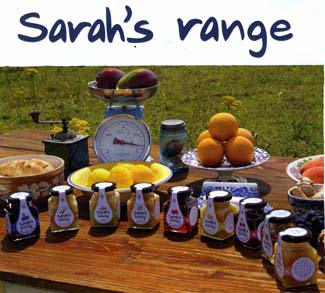 The range includes Ginger, Cinnamon, Lemon, Orange, Blueberries, Sour Cherries and Raspberries among the fruit flavours, and there is a nutty one with crunchy Walnuts.
The range includes Ginger, Cinnamon, Lemon, Orange, Blueberries, Sour Cherries and Raspberries among the fruit flavours, and there is a nutty one with crunchy Walnuts. The company has invested over €100,000 in developing the new range, and this innovative product has already started winning awards, including a Gold Star at the 2011 Great Taste Awards where Sarah's Scrummy Honey with Sour Cherries was singled out for 1 Gold Star.
Innovation is carried through to the marketing too, and an online film ‘Welcome to my world’ can be viewed at www.mileeven.com
The range is available from a number of gourmet and fine food retailers, including Avoca, and has been listed with Superquinn.
RECIPE: Honeyed Cajun Chicken with Mexican Salsa
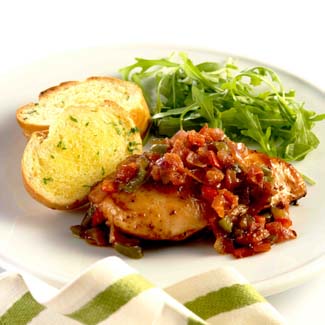 This recipe comes from the well known Euro-Toques chef, Feargal O’Donnell, of The Fatted Calf in Glasson, Co. Westmeath. Having devised it for a
This recipe comes from the well known Euro-Toques chef, Feargal O’Donnell, of The Fatted Calf in Glasson, Co. Westmeath. Having devised it for a Happy Heart campaign, the emphasis is on healthy as well as enjoyable eating. Use the honey of your choice
Serves 4
Click for recipe
Janets Country Fayre
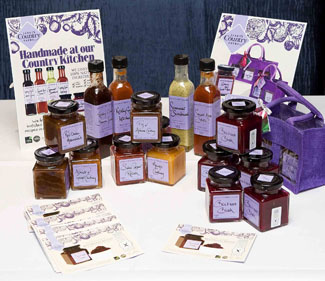
 Janet's Country Fayre range of handmade chutneys, relishes and sauces was among the many impressive Co Wicklow speciality foods showcased at the Taste Council Summer School at The BrookLodge Hotel, Macreddin in August 2011.
Janet's Country Fayre range of handmade chutneys, relishes and sauces was among the many impressive Co Wicklow speciality foods showcased at the Taste Council Summer School at The BrookLodge Hotel, Macreddin in August 2011. Made in both the traditional and contemporary style, these products are distinguished by their deliciously fresh homemade flavours and the stylish packaging that makes them stand out on tightly packed shelves – and they made excellent accompaniments to local charcuterie selection served at the Producers’ Dinner.
Janet Drew has won many an accolade for her products, including an Irish Food Writers' Award for her Beetroot Blush. Although the Guild was familiar with Janet’s full range of interesting products, they chose this one particular product because they “were intrigued that such a rich coloured, delicate flavoured, sweet-sour relish could be made from the humble Irish-grown beetroot and Irish apples.” Beetroot Blush is versatile and has proved a bestseller everywhere it goes on sale and is in great demand for Christmas hampers.
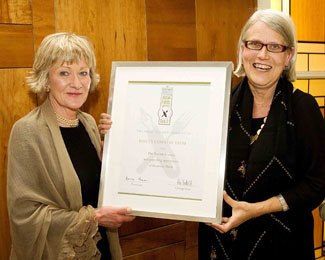 Janet’s journey from art historian in the National Gallery of Ireland to artisan producer is along and interesting one and, along the way, she acquired many skills that were to prove useful in her current career: in being creative on no budget, in public relations, marketing, packaging, and distribution. However, her ability to make and sell food goes back to her student days when she baked and sold cookies to earn enough to keep her first car on the road.
Janet’s journey from art historian in the National Gallery of Ireland to artisan producer is along and interesting one and, along the way, she acquired many skills that were to prove useful in her current career: in being creative on no budget, in public relations, marketing, packaging, and distribution. However, her ability to make and sell food goes back to her student days when she baked and sold cookies to earn enough to keep her first car on the road. Redundancy led to her making petit fours and fudge, to Poppies coffee shop in Enniskerry and, in 2005, to a commitment to develop Janet’s Country Fayre. She bought a unit in Rathcoole, Co. Wicklow, which is large enough to provide space for production, in-house design and label printing, and storage’; along with little help from other artisan food producers, she largely handles everything herself, including distribution.
From selling first at farmer’s markets, her extensive range is now widely available in selected SuperValus, speciality food shops, health food shops, and through a number of market stall holders. She also takes pride in supplying her top of the market (yet fairly priced) range as “own label product” to gourmet shops and restaurants.
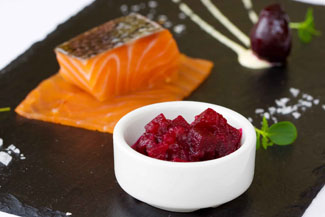 RECIPE: Whiskey cured smoked salmon with Janets Country Fayre Beetroot Blush and citrus mayonnaise
RECIPE: Whiskey cured smoked salmon with Janets Country Fayre Beetroot Blush and citrus mayonnaise[Recipe courtesy of Derry Clarke, proprietor-chef L'Ecrivain Restaurant, Dublin.]
Serves 4
Click for recipe
Comeragh Mountain Lamb
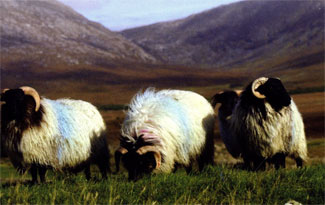
 Lamb is widely produced throughout Ireland, but the size, texture, flavour and season vary considerably depending on the terrain and climate, with the main division being between lowland lamb (large breeds, typically with the familiar creamy wool, early season) and upland or mountain lamb (smaller and very agile, typically black faced with a shaggy coat; later and leaner than lowland lamb, the flesh has a distinctive flavour).
Lamb is widely produced throughout Ireland, but the size, texture, flavour and season vary considerably depending on the terrain and climate, with the main division being between lowland lamb (large breeds, typically with the familiar creamy wool, early season) and upland or mountain lamb (smaller and very agile, typically black faced with a shaggy coat; later and leaner than lowland lamb, the flesh has a distinctive flavour). Mountain lamb is in season from early autumn to late winter and is much sought after by chefs; areas such as Kerry and Connemara are well known for their lamb (Connemara Hill Lamb has achieved European PGI status), but other less famous mountainous areas also have their own speciality produce – including the Comeragh Mountains, in County Waterford.
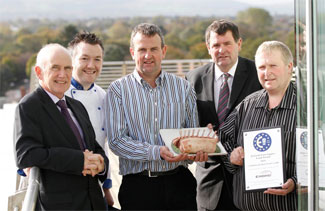 Championed by Michael Quinn, Executive Head Chef at Waterford Castle, farmer Willie Drohan of Comeragh Mountain Lamb was one of five producers honoured by Euro-Toques Ireland (www.euro-toques.ie) at their annual Food Awards in October.
Championed by Michael Quinn, Executive Head Chef at Waterford Castle, farmer Willie Drohan of Comeragh Mountain Lamb was one of five producers honoured by Euro-Toques Ireland (www.euro-toques.ie) at their annual Food Awards in October. Willie Drohan is the sixth generation of his family to herd sheep in the Comeragh Mountains in Co Waterford. The Scottish Black-faced sheep that Willie herds were introduced to the areas by landlords in 17th and 18th centuries. From the age of ten, Willie had a passion for shepherding sheep, an interest developed and nurtured by his family who passed on their tradition, skill and experience to him, that they in turn had learned from their ancestors.
Drohan’s flock roams free range over extensive areas of the Comeragh mountains. They graze over a much broader and more varied landscape than the lowland varieties. On the mountains, they eat grasses, herbs, wild flowers, heathers and drink natural spring water, all free from chemicals and pesticides.
Due to this fact they have significantly more omega 3 fatty acids in their tissues than average lamb. The lamb is slaughtered locally by an artisan butcher and is dry aged for ten days. All of this contributes to the unique, distinctive and delicate flavour of Comeragh Mountain lamb.
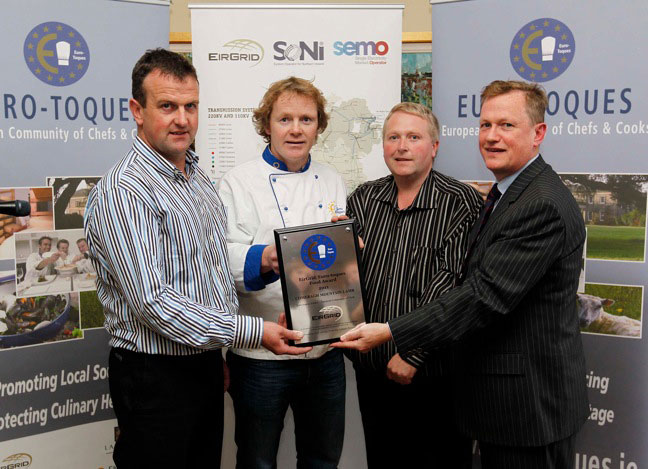 Through this award Euro-Toques gave recognition to a food with true ‘terroir’, a product of its natural surroundings, something that could not be recreated anywhere else, because the flavour results from the unique combination and variety of foodstuffs and environment. Like the other farmers awarded by Euro-Toques this year, Willie started putting a value on his product, creating a market for it and getting the price he needed and felt it deserved.
Through this award Euro-Toques gave recognition to a food with true ‘terroir’, a product of its natural surroundings, something that could not be recreated anywhere else, because the flavour results from the unique combination and variety of foodstuffs and environment. Like the other farmers awarded by Euro-Toques this year, Willie started putting a value on his product, creating a market for it and getting the price he needed and felt it deserved. Encouraged by Chef Michael Quinn from Waterford Castle, Willie now also supplies other restaurants directly, as well as Ardkeen Stores in Waterford (www.ardkeen.com) and farmers markets, and sells direct to consumers through his website, www.comeraghmoutainlamb.ie
The Irish branch of Euro-Toques, the international chefs’ association dedicated to promoting local sourcing and protecting culinary heritage was established by Myrtle Allen in 1986, with the assistance of three founding Commissioners, and its influence is growing each year.
[Presentation shot in Residence (L-R) Willie Drohan, Comeragh Mountain Lamb, Waterford, Michael Quinn, Executive Head Chef at Waterford Castle, Aidan Dunwoody, Comeragh Mountain Lamb, Waterford and David Martin, EirGrid]
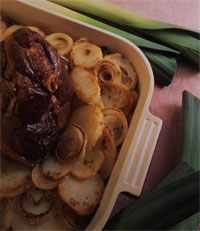 RECIPE: LAMB BOULANGÈRE
RECIPE: LAMB BOULANGÈREThis classic dish makes a lovely, easy Sunday roast for the colder months. The meat, vegetables and potatoes are all cooked together.
Serves 4-6.
Click for recipe
Green Saffron Spices
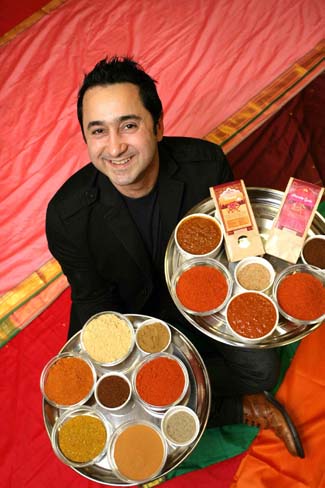
 Set up by Arun Kapil in 2007, Green Saffron Spices (www.greensaffron.com) is a Cork based company specialising in supplying premium, farm-fresh whole spices and blends.
Set up by Arun Kapil in 2007, Green Saffron Spices (www.greensaffron.com) is a Cork based company specialising in supplying premium, farm-fresh whole spices and blends. While the spices are not Irish, of course, in just a few years they have become an integral part of the Irish food scene and, aside from the quality of the fresh spices themselves, the company has earned a formidable reputation for the excellence of products using their spices, including a superb Christmas pudding and spice mixes for mulled wine – and recent accolades include the Entrepreneurial Award at the biennial Bord Bia Food and Drink Industry Awards.
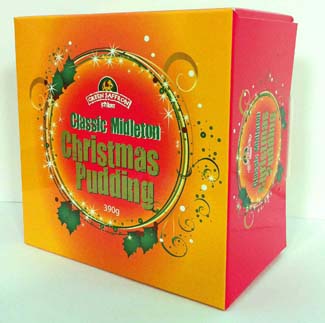 Family connections in India source the very best spices for Arun and his Green Saffron team, who then distribute them nationally, use them for their in-house curry nights (see website) and do the things which make them peculiarly Irish – such as creating a Christmas mixed spice blend for their Classic Midleton Christmas Pudding (soaked for 60 hours in Beamish stout, Jameson whiskey etc etc...) to make puddings that are accurately described as having “funky twist”. And the packaging is brilliant too, so they really stand out from the crowd.
Family connections in India source the very best spices for Arun and his Green Saffron team, who then distribute them nationally, use them for their in-house curry nights (see website) and do the things which make them peculiarly Irish – such as creating a Christmas mixed spice blend for their Classic Midleton Christmas Pudding (soaked for 60 hours in Beamish stout, Jameson whiskey etc etc...) to make puddings that are accurately described as having “funky twist”. And the packaging is brilliant too, so they really stand out from the crowd.And, in a dynamic combination of cultural traditions, Arun Kapil and Justin Green, of Ballyvolane House in Co Cork and the West Waterford restaurant, O’Brien Chop House in Lismore, regularly work together to bring special culinary (and perhaps theatrical) events to Ballyvolane House and O’Brien Chop House - sometimes with craft brewers’ Cormac O’Dwyer and Tom Dalton’s Dungarvan Brewing Company involved too, which makes for a heady mix.
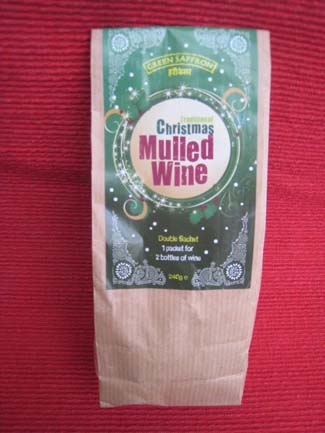 The Green Saffron spice mix for mulled wine makes an exceptionally pleasant hot drink, as I discovered at their stand at the recent Food & Wine Christmas Show – not at all over-sweetened, or cloying, with just the right degree of spicing to give an aromatic warming flavour without overpowering the base wine, it would certainly be the spice mix of choice for this taster.
The Green Saffron spice mix for mulled wine makes an exceptionally pleasant hot drink, as I discovered at their stand at the recent Food & Wine Christmas Show – not at all over-sweetened, or cloying, with just the right degree of spicing to give an aromatic warming flavour without overpowering the base wine, it would certainly be the spice mix of choice for this taster. Green Saffron products are available online and from farmers’ markets, select supermarkets and in over 80 speciality food, farm shops and cookery schools throughout Ireland including, Avoca, Donnybrook Fair and Fallon and Byrne.
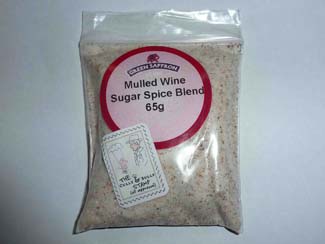 RECIPE: MULLED WINE
RECIPE: MULLED WINE Ingredients:
1 bottle of red wine (a big, full-on red, full of berry fruits. Something like an Australian, Californian or New Zealand Shiraz – either way it doesn’t need to cost too much)
OR 1 bottle organic Bramley apple juice (normal apple juice is fine, but you may need to add a some water to let the sweetness down a little)
1 Packet of Green Saffron Mulled Wine Spices
1 dash of Crème de Cassis (optional, but not recommended if using apple juice!)
Couple pieces of orange and lemon zest, pared from the fruit with a veg peeler works really well (optional)
How to put it together:
1. Pour your chosen bottle of wine (or apple juice) and the Green Saffron Mulled Wine Spices into a thick bottomed saucepan
2. Place the pan onto a gentle heat, stir and heat for a few minutes until the aromas send tingles down your spine and the wine is warm to the touch. DON’T ALLOW IT TO BOIL AS YOU’LL ONLY END UP LOSING THE ALCOHOL!!
3. Add the Crème de Cassis, orange and lemon zest (if using) and stir again.
4. Take off the heat, strain through a sieve into a suitable serving jug.
5. Serve, drink, enjoy…..Sláinte!!
The Foods of Athenry
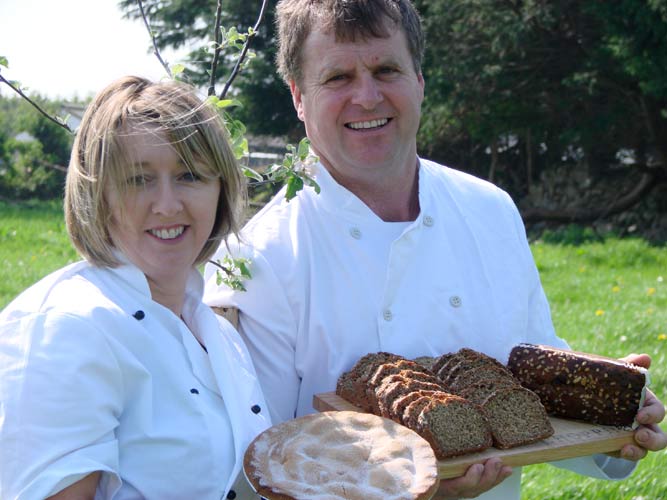
 When former dairy farmers Paul and Siobhan Lawless started their farmhouse bakery, “The Foods of Athenry” in 2000, a converted bicycle shed on their Co Galway farm was the unlikely setting for the new business.
When former dairy farmers Paul and Siobhan Lawless started their farmhouse bakery, “The Foods of Athenry” in 2000, a converted bicycle shed on their Co Galway farm was the unlikely setting for the new business. Basing their philosophy on the simple concept that they wouldn’t put anything into their products that they weren’t happy to give to their own family, their mission statement from the outset was to make “quality real food for food lovers, the food conscious and the dietary challenged, produced with integrity and mindful of the environment”.
They soon built up such a reputation for their healthily delicious home bakes with no additives (including salt, yeast, preservatives and hydrogenated fats), that growing demand led to moving the bakery into the old milking parlour and the business steadily grew.
As the business developed, they expressed their philosophy in many ways – they joined Good Food Ireland, for example; devised an innovative range of biodegradable packaging; and, with the help of Irish Seedsavers in Co Clare, planted an organic orchard of native variety of apple trees with almost-forgotten names like ‘Mother of Household’, ‘Lady Sudley’, and ‘Cavan Rose’ - and then established a colony of bees to pollinate the apples.
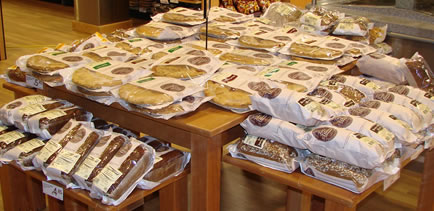 But the core is their impressive range of products, all produced by hand and using ingredients that are carefully selected to give the best balance of taste and nutrition. ‘Deliciously wholesome’ is the claim and it’s one they live up to, in their many popular ranges – scones, breads (including their own in-house bread mixes), cakes, pies, tarts and slices, seasonal specialities – and a specific range of ‘healthy options’ that includes a sugar-free tea brack and spelt breads. Whether or not a special diet is essential to your wellbeing, it’s great to find products that are so thoughtfully produced to be healthy yet without sacrificing flavour or texture.
But the core is their impressive range of products, all produced by hand and using ingredients that are carefully selected to give the best balance of taste and nutrition. ‘Deliciously wholesome’ is the claim and it’s one they live up to, in their many popular ranges – scones, breads (including their own in-house bread mixes), cakes, pies, tarts and slices, seasonal specialities – and a specific range of ‘healthy options’ that includes a sugar-free tea brack and spelt breads. Whether or not a special diet is essential to your wellbeing, it’s great to find products that are so thoughtfully produced to be healthy yet without sacrificing flavour or texture. Paul and Siobhan’s enthusiasm is infectious – I’ve met them at several events over the last few months, including the 2011 Blas na hEireann /Irish Food Awards in Dingle, where they took Gold for their Very Berry High Omega Granola (one of the many awards their products have won) and at Bloom last June, where they introduced me to their new gluten-free brack (predictably delicious!), little knowing that, by the end of the month, their precious bakery would be gutted by fire.
Yet, with typical courage and determination, they were back in business within 10 weeks after the fire – and, following a 2-star success for their gluten-free Christmas pudding in Britain’s Great Taste Awards, have since confounded even the most optimistic expectations by landing a deal to supply to Harrods of London. A pretty good year end by any standards, and they’re now back up to full production.
The Foods of Athenry products are widely available in the West of Ireland, including McCambridges, Mortons and Joyce’s of Knocknacarra, Galway; also Dunnes Stores in Blanchardstown, Dublin.
Distribution will no doubt widen as demand grows – check www.foodsofathenry.ie for current retail outlets.
Natasha's Living Food
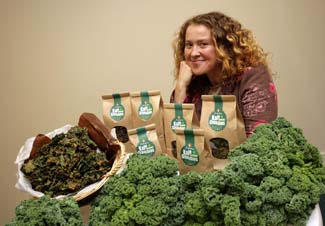
 A lot of things about Natasha Czopor’s ‘Natasha's Living Food’ are out of the ordinary, beginning with Natasha herself, who is representative of Ireland’s energetic and enterprising young cosmopolitan population - and she makes her products by hand in Stoneybatter, Dublin 7, which is near the Phoenix Park and not generally known as a manufacturing area of the city.
A lot of things about Natasha Czopor’s ‘Natasha's Living Food’ are out of the ordinary, beginning with Natasha herself, who is representative of Ireland’s energetic and enterprising young cosmopolitan population - and she makes her products by hand in Stoneybatter, Dublin 7, which is near the Phoenix Park and not generally known as a manufacturing area of the city.Specialising in health-conscious vegetarian speciality foods, her passion for ‘raw and living food’ is leading to the production of some very unusual cakes, confectionery, savouries and salads. ‘Free from’ goes far beyond the usual here.
Natasha’s products are free from animal products, and chemically processed or pasteurised ingredients - she never uses flour, dairy, wheat, eggs, meat or fish, which gives her products appeal to people with a range of allergies, although she does use nuts.
Ingredients (Fair-trade and organic for preference), arrive in their natural state, she loves using ‘superfoods’ – and she doesn’t heat ingredients beyond 118’F in order to protect the enzymes, vitamins and nutrients.
Homemade crackers may be flavoured with carrot and thyme, or more exotic flavours of Thai or Indian spices. Houmous dips are made with raw sprouted houmous, flavoured with cumin and coriander or parsley and black olive. Cakes include a cashew cream ‘cheese’ cake and raw chocolate & fruit torte, while the confectionery range includes raw chocolate bars.
At a time when the word ‘snack’ is almost synonymous with ‘junk food’, nibbles like her sprouted flax ginger snaps or living sunflower/Goji Sprinkles make a refreshing change - and one that really stands out from the crowd is Kale Crunchies, a healthy crisp alternative made from dried locally grown kale that recently earned Natasha’s Living Food the 2011 Innovation Award at the biennial Bord Bia Food and Drink Industry Awards.
‘Covered in sunflower seed paté, then dried at 40 degrees thus preserving the flavour, minerals and vitamins’ it really is a healthy snack. What a brilliant move to take an ordinary, everyday vegetable that is easily grown and inexpensive (even though this dark green leafy vegetable is a ‘superfood’) and use it to create an appealing alternative to the usually salt- and calorie-loaded crisp.
Natasha’s Living Foods are available through farmers’ markets, SuperValu, also selected speciality stores and restaurants.
For more information see www.natashaslivingfood.ie
Corleggy Farmhouse Cheeses
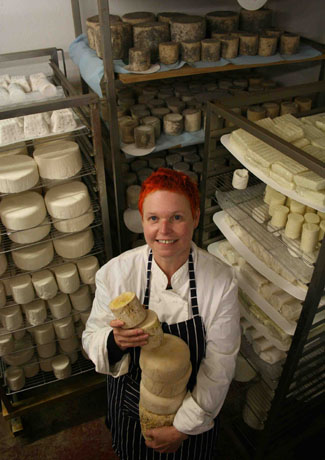
 In rich pasture land beside the River Erne, Silke Cropp makes her wonderful range of goat, sheep and cows’ milk cheeses. Silke is one of Ireland’s longest-practising cheesemakers, and the original, Corleggy, is a natural rind hard goats’ cheese with complex flavours.
In rich pasture land beside the River Erne, Silke Cropp makes her wonderful range of goat, sheep and cows’ milk cheeses. Silke is one of Ireland’s longest-practising cheesemakers, and the original, Corleggy, is a natural rind hard goats’ cheese with complex flavours. In addition, this dedicated artisan now makes Quivvy, a soft goats’ cheese preserved in oil; Drumlin, a hard raw cows’ milk cheese, named after the prettily undulating small hills that characterise the area and made in several flavours; and Creeny, a semi hard raw milk sheep’s cheese.
Handmade daily in small batches, the flavours vary according to season and maturity, but the quality is consistently superb and they’re much sought after by leading restaurants.
The hard cheeses, Corleggy and Drumlin, are delicious cooked as well as for the table and keep in rind for months, improving with age.
There is always a ready market for the limited production available - from carefully selected retailers, online, and from the markets that Silke attends (where you will also find her daughter Tina and her partner Oisin Healy, of Cr?epes in the City).
And Silke offers cheesemaking lessons, so - with time and patience – any enthusiast could have the satisfaction of learning how to make cheese too, although reaching the level of skill that has earned Silke the many awards that she has received down the years would be a daunting challenge.
For more information see the Corleggy Cheeses website
McCarthys of Kanturk
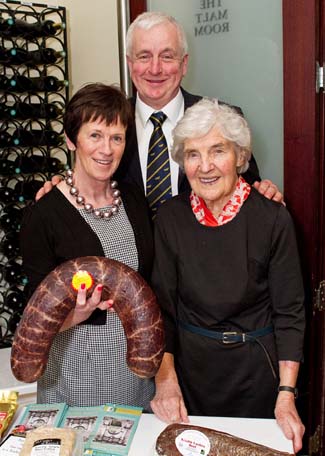
 Recently singled out by the Irish Food Writers Guild, who honoured them with an Award for their notable contribution to Irish food, McCarthy’s of Kanturk in Co Cork is an institution that is very definitely ‘worth a detour’.
Recently singled out by the Irish Food Writers Guild, who honoured them with an Award for their notable contribution to Irish food, McCarthy’s of Kanturk in Co Cork is an institution that is very definitely ‘worth a detour’.Jack McCarthy and his son Tim come from a long line of butchers. In 1892 Callaghan McCarthy, in despair at the poor meat he had bought, decided to give up being a baker and learn how to become a butcher. The family has since been perfecting their techniques and developing new and value-added meat products for five generations.
Guild members who have been judging butchers’ competitions for many years know well that the McCarthys have consistently won gold for the high standard of their traditional spiced beef, dry-cured bacon, interesting sausages and their ability in producing an ever-increasing range of cured, smoked and marinated beef, pork and lamb products, including particularly broad and innovative ranges of both continental-style charcuterie and traditional, fresh blood black puddings.
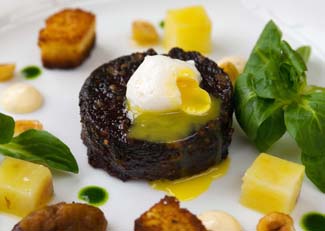 Recent highlights in the McCarthy’s career have ranged from a visit from 23 members of the French Brotherhood of the Knights of the Black Pudding, who presented Jack with a Gold Medal for his fresh blood pudding, to working with chef, Ross Lewis of Chapter One Restaurant, to create a bespoke pudding to serve at the state banquet celebrating Queen Elizabeth’s visit to Ireland in 2011.
Recent highlights in the McCarthy’s career have ranged from a visit from 23 members of the French Brotherhood of the Knights of the Black Pudding, who presented Jack with a Gold Medal for his fresh blood pudding, to working with chef, Ross Lewis of Chapter One Restaurant, to create a bespoke pudding to serve at the state banquet celebrating Queen Elizabeth’s visit to Ireland in 2011.They also introduced Ireland’s first “Practical Pig in a day” courses for chefs, single pig families and food lovers. The McCarthy’s approach combines the best of tradition with creativity – their products are superb and, if you can’t make it to Kanturk, they have an excellent online shop as well.
Natural Irish Cider
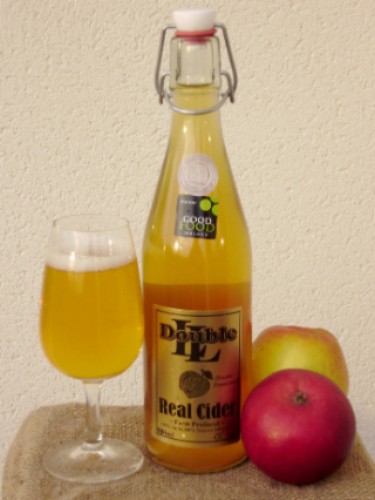
 There’s been a great shortage of quality cider in Ireland until recently, especially south of the border – but, fortunately, this gaping gap in the market is gradually being closed with the introduction of a number of artisan ciders in the last few years.
There’s been a great shortage of quality cider in Ireland until recently, especially south of the border – but, fortunately, this gaping gap in the market is gradually being closed with the introduction of a number of artisan ciders in the last few years.These include Double L Irish Cider from natural Irish apple juice supremo David Llewellyn in Lusk Co Dublin; made entirely from Irish apples (“No water, no sugar, no pussy-footing!”), it is usually blended from several varieties including Dabnett and Bramley to produce two levels of sweetness (‘Bone Dry’ and ‘Medium Dry’) although single variety ciders are also sometimes made.
Double L Irish Cider is available from farmers’ markets (Temple Bar & Dun Laoghaire) and, in bulk, from the farm, by arrangement. Cider making courses are offered occasionally, and David also produces other fruit juices and some wine.
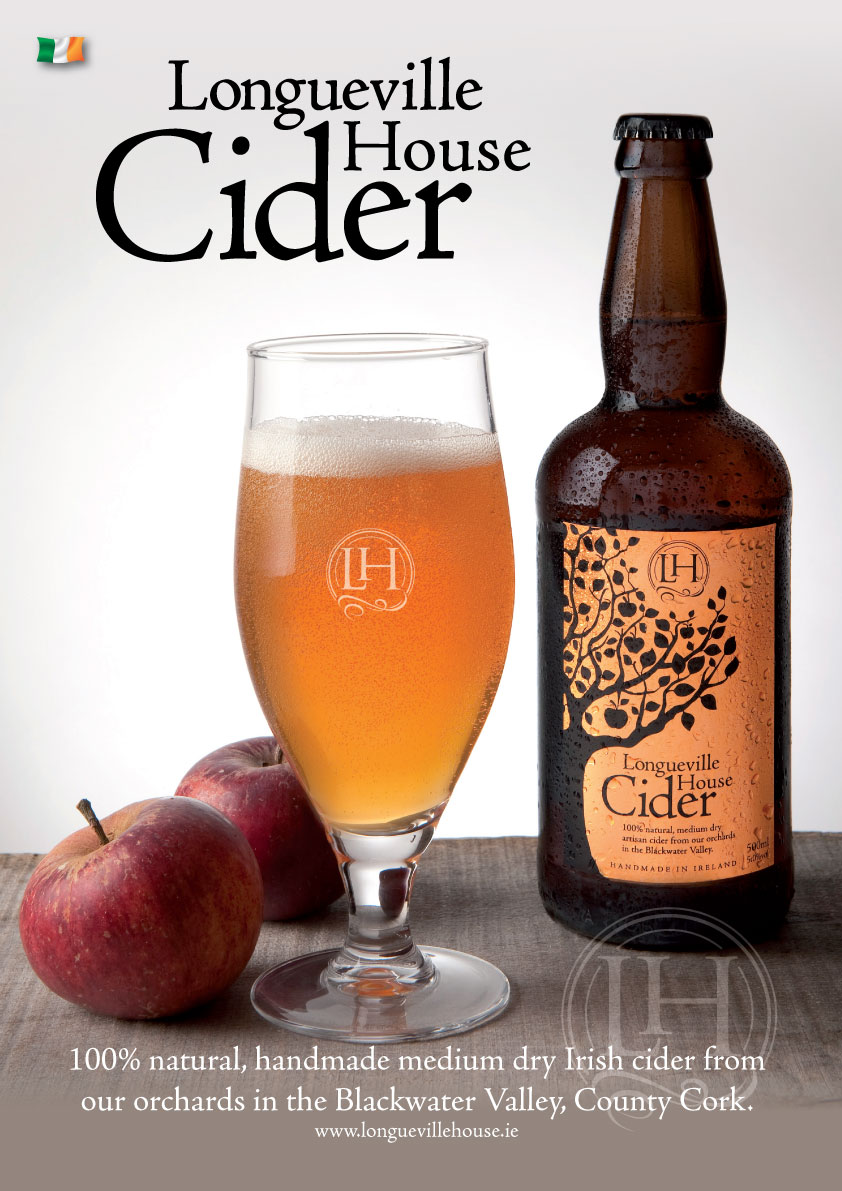 A more recent arrival is Longueville House Artisan Cider, which is made from their own apples by William & Aisling O’Callaghan of the renowned country house hotel and sporting estate, Longueville House, in Mallow, Co Cork. Famous for many things – the lamb from the estate, salmon from the river, wine (occasionally) from the small but picturesque vineyard - Longueville even produces (on an ongoing basis) Ireland’s only Vintage Apple Brandy.
A more recent arrival is Longueville House Artisan Cider, which is made from their own apples by William & Aisling O’Callaghan of the renowned country house hotel and sporting estate, Longueville House, in Mallow, Co Cork. Famous for many things – the lamb from the estate, salmon from the river, wine (occasionally) from the small but picturesque vineyard - Longueville even produces (on an ongoing basis) Ireland’s only Vintage Apple Brandy.It all started when William’s father, the late Michael O’Callaghan, planted 20 acres of Dabinett and Michelin cider apples at the north-west side of the property in 2000. He was a great wine lover, but he also loved Calvados and apples grow better than vines in Ireland.
Although not able to use the name, a similar product could be distilled in Ireland and the 40° Longueville Vintage Apple Brandy is now distilled annually and sold in 50cl bottles. William has recently rebranded the Apple Brandy and, having taken over from where his father left off, has brought the cider production to another level.
Once harvested each autumn, the Longueville apples are crushed and pressed in a cider press in the cider house on the farm. There are no colourings, additives or preservatives used at any stage during the production and manufacturing process - the pressed juice is just naturally fermented over time, to produce a rich amber coloured 5° strength cider which is then filtered, lightly carbonated and pasteurised. Medium-dry, with a fresh appley flavour, it is naturally thirst quenching and is best served chilled, without ice - the perfect summer drink.
Longueville House Artisan Cider can be purchased direct from Longueville House (www.longuevillehouse.ie; 5 cases or more) and it is retailed by off licences such as O’Brien’s, Redmond’s, Morton’s of Ranelagh, Donnybrook Fair Dublin aand Bradley’s Off Licence in Cork.
Glebe Brethan Cheese
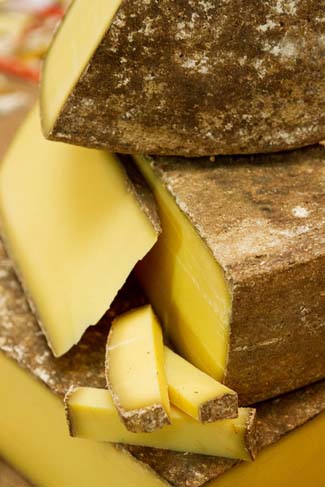
 Glebe Brethan is a superb gruyère-style cheese, handmade by the Tiernan family in the lush grasslands of Co Louth, where David Tiernan farms the land that was farmed by his father and grandfather before him.
Glebe Brethan is a superb gruyère-style cheese, handmade by the Tiernan family in the lush grasslands of Co Louth, where David Tiernan farms the land that was farmed by his father and grandfather before him.Named after the founder of a local monastic settlement, Glebe Brethan is an unpasteurised, thermophilic, artisan cheese made from the milk of Montbeliarde cows, a breed which originates in the mountainous of the Jura region of Eastern France, where their milk is also used to make cheese.
Made in great 45-kilo wheels and matured for up to 18 months, this magnificent cheese has won many awards, including a 2012 Irish Food Writers’ Guild Award, for “the consistent, excellent quality and complex flavour of Glebe Brethan Cheese” and a 2011 Euro-Toques Ireland Award.
It all began twenty years ago when, with a yen to make cheese, David began building up a specialist herd with two Montbeliarde cows. Now their descendants produce all the milk for Glebe Brethan cheese.
Montbeliarde are a hardy breed, powerful in appearance, yet placid in nature, and have the useful habit of searching the hedgerows for the sweetest grasses and tastiest herbs. The milk (half of which goes for liquid milk and for Bailey’s Cream Liqueur) clearly benefits from the good Louth land they graze for most of the year, and David grows wheat, barley and maize for winter feed.
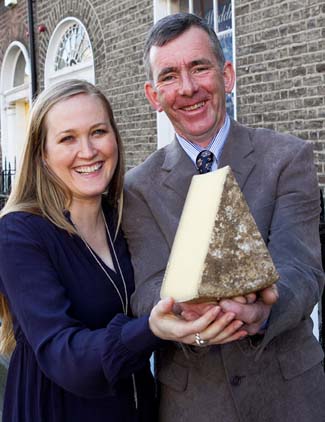 As a frequent visitor to France for breeders’ meetings, David spent a day at the Mamirolle National Dairy School and, as he says himself, “caught the cheese bug”.
As a frequent visitor to France for breeders’ meetings, David spent a day at the Mamirolle National Dairy School and, as he says himself, “caught the cheese bug”. At once, he ordered equipment and set about converting his dairy. To acquire the skills needed to make a cheese similar to the Gruyère cheese of the Jura region, he arranged for a young cheesemaker to come to Ireland from France to teach the family.
He came for two years and provided ongoing support as they developed and test-marketed Glebe Brethan Cheese. Just two years later, in 2006, they won the award for the best new cheese at the British Cheese Awards.
And success has followed them ever since, as this wonderful cheese – which is excellent in cooking, or as a breakfast or snacking cheese, as well as starring on the best of cheeseboards - becomes better known.
But David is not only known for his unpasteurised cheese; the fact that he also makes raw milk butter and sells raw milk – and is a passionate advocate of the benefits of raw milk – has seen him at the cutting edge of the recent debate surrounding Irish government proposals to ban raw milk.
His informed contribution to the debate is one of the many reasons that the ban has not yet taken place - and, raw milk supporters hope, may not now go ahead.
Triskel Goats Cheese
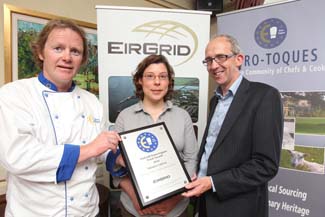
 Triskel Cheeses are hand-ladled French-style soft goats cheeses and a semi-hard cow’s cheese, made by Breton woman Anna Leveque in a small production unit at her home in Portlaw, Co Waterford, using locally sourced milk. Recently recognised by Euro-Toques in their 2012 EirGrid/Euro-Toques Food Awards, the Triskel cheeses are already popular with discerning chefs and were nominated by Euro-Toques chef Michael Quinn, of Waterford Castle Hotel. Anna’s partner is Philip Little, an apple farmer from Portlaw, and to everybody’s delight they introduced their 10 day old first baby, Lucie, to Ireland’s most enthusiastic foodie community by bringing her along to the awards.
Triskel Cheeses are hand-ladled French-style soft goats cheeses and a semi-hard cow’s cheese, made by Breton woman Anna Leveque in a small production unit at her home in Portlaw, Co Waterford, using locally sourced milk. Recently recognised by Euro-Toques in their 2012 EirGrid/Euro-Toques Food Awards, the Triskel cheeses are already popular with discerning chefs and were nominated by Euro-Toques chef Michael Quinn, of Waterford Castle Hotel. Anna’s partner is Philip Little, an apple farmer from Portlaw, and to everybody’s delight they introduced their 10 day old first baby, Lucie, to Ireland’s most enthusiastic foodie community by bringing her along to the awards.There are three Triskel Goats cheeses (Pyramid, Crottin and Bouche), all made from milk sourced from a goat farm in Camolin, Co. Wexford, and the curds are hand-ladled into the moulds in the typical French way. Anna also produces a semi-hard cow’s cheese, Gwenned, using milk sourced locally in Kilmeaden.
Euro-toques recognised Triskel Cheeses as “a unique style in the Irish cheese repertoire, both subtle and distinctive in taste and of excellent quality” and singled it out as “an outstanding Irish product, handmade using traditional methods and locally sourced raw materials”.
Anna spent much of her youth on her grandparents’ dairy farm in Brittany and went on to study agriculture in France. During her studies she worked on job placement for six months with Teagasc in Kildalton College and returned to work there when her studies were completed. During this time she had the chance to work with many Irish goat farmers and later she also spent time with a number of Irish cheesemakers. Finally, in 2009, her longterm interest in and passion for dairying and cheese-making culminated in her setting up her own production unit.
After much experimentation Triskel Cheese was born, and Anna’s wonderful range of French style soft goats cheeses is now available to both chefs (via La Rousse Foods and Sheridans) and consumers, who can buy from Sheridans outlets, including Ardkeen Stores; in the English Market at On the Pig’s Back; and in Ballymaloe Cookery School shop. It is also available at Farmer’s Markets in Midleton, Mahon Point, Kinsale, Mallow and Douglas.
Moyallon Guanciale
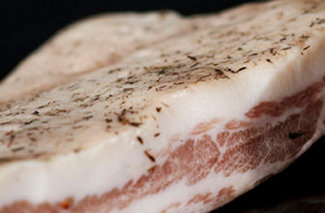
 Guanciale (pronounced gwan-chalie) is an unsmoked Italian bacon prepared with pig's jowl or cheeks. Its name is derived from guancia, Italian for cheek, and it is a delicacy of central Italy, particularly Umbria and Lazio.
Guanciale (pronounced gwan-chalie) is an unsmoked Italian bacon prepared with pig's jowl or cheeks. Its name is derived from guancia, Italian for cheek, and it is a delicacy of central Italy, particularly Umbria and Lazio.
It has an especially rich, sweet, salty porky flavour and a buttery texture; stronger and richer than other pork products, such as pancetta, it is traditionally used in dishes like pasta all'amatriciana and spaghetti alla carbonara. It is less easily available in Italy than it used to be but, thanks to the dedication of an inspired team at Hannan Meats, chefs seeking the authentic product can now source it from the pretty village of Moira in Northern Ireland.
Jilly Dougan and her former company Moyallon Foods have been highly regarded on the Irish food scene for decades, winning many accolades for their quality products (including a 2001 Irish Food Writers’ Guild Award for their Venison and Speciality Game). They’re now part of Hannan Meats, who wisely retained both the premium brand and Jilly herself, who divides her time between Moyallon and work connected with another of the area’s renowned food businesses, her husband Simon Dougan’s deli and bakery, The Yellow Door.
“Guanciale is an amazing ingredient - porky, rich, and delicately textured,” explains Jilly, “Since it is quite difficult to get, even in Italy, we decided (after much research) to make our own. To produce our version of guanciale, pork jowl, including the cheek is dry cured using salt, sugar, a mixture of spices, peppers and herbs and cured for a minimum of 3 weeks. During the curing process it is periodically anointed with red wine and garlic.”
, Peter Hannan (Hannan Meats) Nigel Barden (BBC Radio2).jpg) And Jilly is far from being alone in thinking their new product is amazing, as it wowed the judges like no other at this year’s Great Taste Awards.
And Jilly is far from being alone in thinking their new product is amazing, as it wowed the judges like no other at this year’s Great Taste Awards.
“Almost a case of making a silk purse out of a sow’s ear,” was the way Guild of Fine Food chairman, Bob Farrand, described Moyallon Guanciale in London earlier this month, when not only was it declared Best Speciality Food Product for Northern Ireland, but also Supreme Champion in Great Taste 2012 – topping the poll of over 8,800 products entered from the UK and Ireland. “This was doubly exciting as it is the second year that Northern Ireland has won this award, with George McCartney winning last year,” said Jilly, “Must be something in the water in Moira!!”
And, while it is clearly exceptional, guanciale is not the only star to be won by Hannan Meats this year – in total this remarkable quality-driven company achieved Great Taste Awards stars for no less than 20 of their products, nine of them under the Moyallon brand. Wow!
Gubbeen Bacon
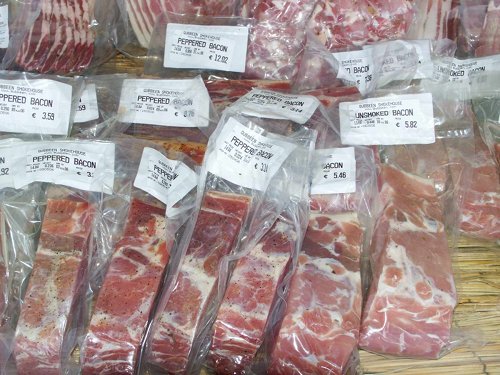
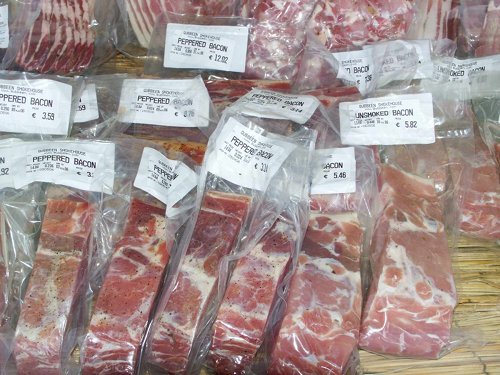 Gubbeen Farmhouse Products are made by the Ferguson family at their beautifully located dairy farm near Schull in West Cork. Tom and Giana Ferguson are the fifth generation to care for this lovely place, which is now synonymous with their beautiful semi-soft Gubbeen cheese - and, increasingly, the Gubbeen Smokehouse products made by their son, Fingal.
Gubbeen Farmhouse Products are made by the Ferguson family at their beautifully located dairy farm near Schull in West Cork. Tom and Giana Ferguson are the fifth generation to care for this lovely place, which is now synonymous with their beautiful semi-soft Gubbeen cheese - and, increasingly, the Gubbeen Smokehouse products made by their son, Fingal.
The dairy and pork businesses are interdependent - the various breeds of pigs enjoying a fine sea view from their large straw-filled pens, where their wholesome diet includes whey remaining from the cheese-making process - and Fingal also uses herbs supplied by his sister Clovisse in his much-admired range of smoked meats, hams, rashers, sausages and salamis.
The most popular products are ham and dry-cured bacon, which are available either smoked or green all year round. The rashers (loin and belly) are very pure, with no added water or unnecessary additives in the curing process. “I love strong bold flavours and I have strong principles of not using any ingredients that are not necessary, like MSG, phosphates or sulphurs,” Fingal states, so it should come as no surprise that his bacon is full of character, with excellent texture and a distinctive flavour – qualities that make it popular with chefs as well as home cooks.
Used fried or grilled in the traditional Irish breakfast, it cooks beautifully to make the must-have crisp rasher that seemed a thing of the past until recently. It’s great for warm salads, diced as a garnish, cooked in strips for pasta dishes, made into bacon rolls to accompany poultry or for nibbles with drinks, or as a garnish – anywhere where bacon is called for, dry cured bacon will make a better dish than ‘ordinary’ wet cured bacon.
Fingal Ferguson’s bacon (and his other smoked products) are widely distributed and can always be found at Schull, Skibbereen, Bantry and Mahon Point farmers’ markets.
The Fergusons also offer beautiful hampers – including, for example, Gubbeen cheeses, smoked salami, their own brand oatcakes (made by famous Northern Ireland bakers, Ditty’s of Castledawson) and chutney – all packed in lovely hand painted wooden trays, for delivery by courier or collection from selected farmers’ markets; order by phone or email.
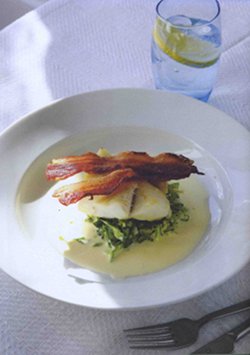 Roast Cod, Savoy Cabbage & Crispy Gubbeen Bacon
Roast Cod, Savoy Cabbage & Crispy Gubbeen Bacon
Fish, cabbage and bacon make a classic combination that’s perfect for Irish produce and Gubbeen bacon is Martin Shanahan’s ingredient of choice in this deliciously simple seasonal dish from Martin & Paul’s Surf’n’Turf (Quadrille), the cookbook based on the TV series of the same name. “A fabulous combination,” says Martin, “I love any fish or seafood with bacon, and the soft yet firm texture of the cod here is great with the crispy bacon.”
Serves 4
2 tbsp rapeseed oil, plus more for the cabbage
1 onion, finely chopped
1 savoy cabbage, shredded
sea salt
freshly ground white pepper
4 x 200g sustainably stocked cod steaks (no skin, no bone, no fear)
4 rashers of Gubbeen bacon, or other quality dry-cured bacon
200ml single cream
80g unsalted butter
Preheat your oven to 200°C/400°F/gas mark 6. In a pot, sweat the onion in a little oil for about two minutes. Add the cabbage and about 100ml of water. Stir and simmer for eight minutes. By this time the water will have evaporated (though drain off any that remains).
Meanwhile, heat the 2 tbsp of rapeseed oil in an ovenproof pan on the hob. Season the cod steaks. Place in the pan and brown for a minute on each side. Cover with foil and place in the hot oven for eight minutes. At the same time, put the bacon on a roasting tray in the oven.
Add the cream and butter to the cabbage and simmer for four minutes more. Place it on warmed plates with the cod and crisp bacon on top.
Goatsbridge Trout Caviar
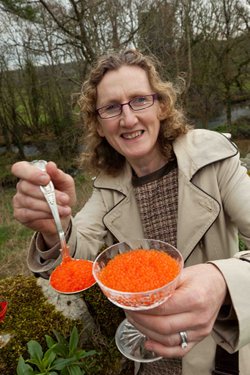
 A surprising number of small producers are bucking the system at the moment, doing well in businesses that you’d never expect to succeed in recession. One of these success stories is still in the making in deepest Kilkenny, where Ger and Mags Kirwan continue to develop the Goatsbridge Trout Farm at Thomastown, building on the established success of their excellent quality fresh and smoked rainbow trout.
A surprising number of small producers are bucking the system at the moment, doing well in businesses that you’d never expect to succeed in recession. One of these success stories is still in the making in deepest Kilkenny, where Ger and Mags Kirwan continue to develop the Goatsbridge Trout Farm at Thomastown, building on the established success of their excellent quality fresh and smoked rainbow trout.
But their latest product to reach the market may seem surprising in the current climate, as it’s one that has always been associated with luxury: caviar.
Caviar is basically salt-cured fish eggs, a speciality food that’s used mainly as an appetiser or garnish. The term is usually taken to refer to the ‘king’ of caviar, the inky black sturgeon roe, which is extortionately expensive, but other fish eggs can be used to make a similar product – and trout caviar, being a pretty red, is much more attractive than ‘real’ caviar.
Goatsbridge Trout Caviar has been going down a treat with chefs since March 2012, when restaurant trials began. More recently, they’ve brought this jewel-like treat to the consumer market, where it has also been well received – and what better time than Christmas to indulge, or to buy it as a novel present for a foodie friend.
It can be used in the same way as ‘regular’ caviar, and an ideal way to introduce it to friends and family over Christmas would be to use it as a garnish with smoked salmon: blini with smoked salmon and soured cream, topped a little spoonful of trout caviar would be delicious – and very festive.
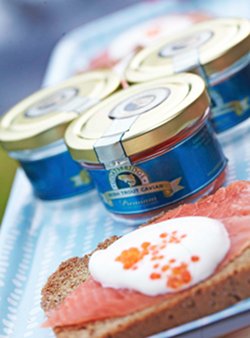 Goatsbridge Trout Farm is a member of the Kilkenny Food Trail and has always welcomed visitors by arrangement, but the welcome is growing along with the product range as a new visitor centre is due to open shortly. They’ll have a demo kitchen and a little smoke house and they’re also putting in an Aquaponics unit. They expect this to be a great attraction for school kids, and a friend has written a Syllabus which uses the idea to teach many aspects of science to children.
Goatsbridge Trout Farm is a member of the Kilkenny Food Trail and has always welcomed visitors by arrangement, but the welcome is growing along with the product range as a new visitor centre is due to open shortly. They’ll have a demo kitchen and a little smoke house and they’re also putting in an Aquaponics unit. They expect this to be a great attraction for school kids, and a friend has written a Syllabus which uses the idea to teach many aspects of science to children.
This is a highly sustainable business - previous generations of Gerard Kirwan's family took over where the Cistercian monks of old left off in this area, ensuring there's trout a-plenty here in the crystal clear Little Arrigle River in the Nore Valley. Enough, in fact, for the restocking of lakes, rivers and fisheries all around the country, and they deserve great credit for the way they are managing and developing their business, especially in these challenging times.
Along with their other products, Goatsbridge Trout Caviar is available through LaRousse as well as specialist shops around the country, including Cavistons, Donnybrook Fair, Fallon & Byrne, Nolans of Clontarf, Ardkeen Food Stores, Kilkenny Design Centre, and Keoghans of Cork.
They can also offer free delivery to anywhere in Ireland; just email details to info@goatsbridgetrout.ie or call Mags Kirwan on 086 818 8340. Goatsbridge Trout products, including the caviar, are also available online from Knockdrinna Farmhouse Cheese (www.knockdrinna.com), where Trout Caviar costs 50/100g jar €11.00/19.95 respectively.
Ronan Byrne aka The Friendly Farmer
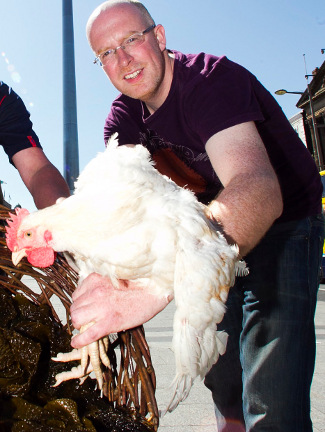
 Ronan Byrne - AKA The Friendly Farmer - is a familiar figure at Galway and Moycullen farmers’ markets, where he sells the free range meat and - especially - poultry - produced on the 35 acre farm outside Athenry in East Galway where he grew up, and which once belonged to his grandparents.
Ronan Byrne - AKA The Friendly Farmer - is a familiar figure at Galway and Moycullen farmers’ markets, where he sells the free range meat and - especially - poultry - produced on the 35 acre farm outside Athenry in East Galway where he grew up, and which once belonged to his grandparents.
He’s living proof that a small mixed farm can be viable, but it didn’t happen by chance. Having studied Agri-business & Marketing, he spent some time working in finance, marketing and promotions - and managing a large-scale dairy farm in Poland - before returning to the family farm with a plan to specialise in high quality produce for the local market.
Since setting up as The Friendly Farmer in 2007 he’s reared free range pigs, beef cattle, and seasonal poultry (turkeys, geese and ducks) on his traditional mixed farm, but the main focus is on pasture-reared chickens. His grass based system allows easy outdoor access to the flock and he produces 115 hubbard chickens a week.
Like the general public, it’s a challenge for chefs to source top quality chicken in Ireland and they just can’t get enough of Ronan Byrne’s birds, which won a prestigious Euro-Toques Food Award in 2012, following nominations by JP McMahon of Cava Restaurant Galway and John Coffey of Thyme Restaurant, Athlone. Commending “the taste and quality of his chickens in a blind taste,” Euro-Toques commented that “Chickens of this kind are highly sought after by Euro-Toques chefs and demand far outweighs supply. This is precisely the kind of product they are looking for.”
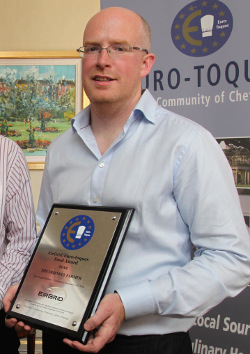 The Friendly Farmer chickens are sold direct from the farm, at Knockbrack near Athenry (087 620 3765); from selected retailers including McGeough’s Butchers, Oughterard; at Galway and Moycullen Farmers’ markets; and online where orders are accepted for 15 birds with no delivery charge - ideal for several families to share.
The Friendly Farmer chickens are sold direct from the farm, at Knockbrack near Athenry (087 620 3765); from selected retailers including McGeough’s Butchers, Oughterard; at Galway and Moycullen Farmers’ markets; and online where orders are accepted for 15 birds with no delivery charge - ideal for several families to share.
Dublin area collection points can sometimes be arranged (eg Rolestown Garden Centre, near Swords) and a more regular system for Dublin customers is planned. Ronan also sells directly to a number of quality-led restaurants in Galway, Roscommon, Athlone and even one in Donegal.
And things don’t stand still for The Friendly Farmer, who has a new on-farm abbatoir (a very encouraging development, considering how small abbatoirs were disappearing such a short time ago) and a few other developments in the pipeline for 2013.
Now if only we could think up some similarly enterprising ideas for rural restaurants, what a great thing that would be.
Kilbeggan Organic Porridge
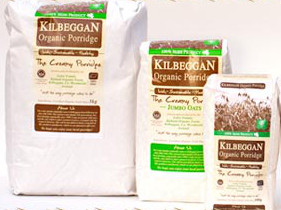
 “Oats Produced from Ballard Organic Farm, owned and operated by the Lalor family since 1844” is the proud proclamation on the Kilbeggan Organic Foods website and it says a lot about the principles of stewardship that Pat Lalor values so highly, and which saw him start the conversion to organic certification in 1999.
“Oats Produced from Ballard Organic Farm, owned and operated by the Lalor family since 1844” is the proud proclamation on the Kilbeggan Organic Foods website and it says a lot about the principles of stewardship that Pat Lalor values so highly, and which saw him start the conversion to organic certification in 1999.
Oats have always been an important crop on this Co Westmeath farm, initially for animal feed and then for supply to Ireland’s biggest porridge oats company Flahavans, whose organic sales have increased dramatically in recent years. Then, in 2011, Pat took the leap and - while still also supplying Flahavans - he started producing porridge from his own oats, and Kilbeggan Organic Porridge was born.
The timing was good and this quality product - which is available as jumbo (whole) oats and oatlets (finer) - has been a huge success, already winning awards including the Best Organic Grocery category at Bord Bia’s National Organic Awards in 2012. It’s distributed to speciality stores all over Ireland and in demand for its special texture and flavour as well as the ‘free from’ advantages.
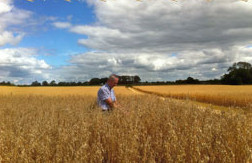 The health benefits of oats are now well understood and, while it’s an all year product, the slow release energy of porridge is especially welcome in the colder months and it couldn’t be easier: one cup of oats to three of water and a pinch of salt; leave overnight in a slow cooker or the slow oven of a range type cooker… Oats are also versatile in cooking, working very well in recipes that suit the Irish climate, including many of our traditional dishes.
The health benefits of oats are now well understood and, while it’s an all year product, the slow release energy of porridge is especially welcome in the colder months and it couldn’t be easier: one cup of oats to three of water and a pinch of salt; leave overnight in a slow cooker or the slow oven of a range type cooker… Oats are also versatile in cooking, working very well in recipes that suit the Irish climate, including many of our traditional dishes.
Agri-tourism is another important element of life on Ballard Farm, which is also an open farm (March- October) with facilities for visiting groups of up to 45 people, with or without an agricultural background.
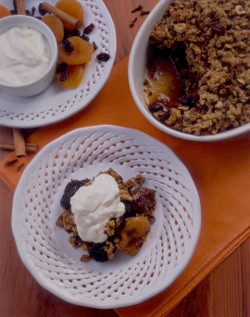 RECIPE Dried Fruit & Hazelnut Crumble
RECIPE Dried Fruit & Hazelnut Crumble
Dried fruit and nuts are complementary ingredients that make a natural partnership with oatmeal - as in this hot pudding that's as delicious as it is wholesome. This recipe goes back to the 1990s, when the Health Promotion Unit at the Department of Health and Children used to rope in every member of the Irish Food Writers’ Guild to contribute a recipe to their Healthy Food magazine, which was a great combination of healthy eating and exercise guidelines, news and favourite dishes. Time to bring it back me thinks.
SERVES 4-6
9oz/250g mixed dried fruit salad, e.g. pears, peaches, apples, prunes.
2oz/50g sugar, or to taste
Natural apple juice or water, as required
1 inch/5cm piece cinnamon stick
Grated rind and juice of 1 small lemon
Crumble Topping:
7oz/200g oat flakes
Pinch of salt
3oz/75g butter, melted
3oz/75g Demerara sugar
1 level tsp. mixed spice (optional)
2oz/50g hazelnuts
A few tbsp. water
The day before cooking, put the fruit into a pan with the cinnamon stick, sugar and enough apple juice or water to cover. Bring to the boil, then remove from the heat, add the finely grated lemon rind and the juice, cover and leave to soak overnight. (If you don’t have time for overnight soaking, use this microwave short-cut: in a Pyrex jug bring all to the to boil on High, then reduce to Low and microwave for 15-20 minutes or until fruit is plump and juicy).
Preheat a fairly hot oven 200°C/400°F/Gas Mark 6.
Butter a shallow baking dish.
To make the topping, put all except the last two ingredients into a mixing bowl and mix well. Mix a little water into the crumble mixture, so that it clings together slightly, then mix in the roughly chopped nuts.
Remove the cinnamon stick from the fruit, check prunes, etc., for stones, then arrange dried fruit on the base of the dish, with the juices.
Large pieces, e.g. half pears or peaches, may be cut to bite size if you like.
Scatter the topping over the fruit and bake in the pre-heated oven for 30-40 minutes, or until well-browned and crunchy on top.
Serve hot with chilled natural yogurt, whipped cream or ice cream.
NOTE: A mixture of oatmeal and wholemeal flour (or all wholemeal flour) may also be used. If using pre-soaked ‘ready to eat' dried fruit, less water is absorbed, judge liquids by appearance - the fruit base should be nice and juicy.
Highbank Orchard Syrup
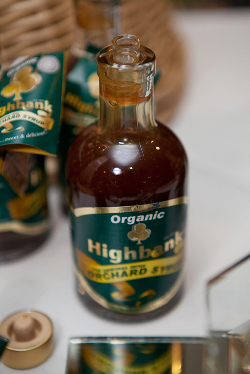
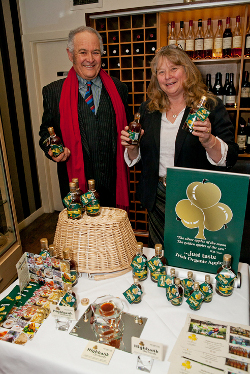 Apples grow well in many parts of Ireland and the limestone-rich soil of Co Kilkenny, where Rod and Julie Calder-Potts have farmed Higbank Organic Orchards since1969 (organically since 1994), is particularly suitable. Beginning with farm-gate sales of surplus apples, they produced fresh apple juice and apple concentrates to make wine - a product that attracted the interest of poteen-makers.
Apples grow well in many parts of Ireland and the limestone-rich soil of Co Kilkenny, where Rod and Julie Calder-Potts have farmed Higbank Organic Orchards since1969 (organically since 1994), is particularly suitable. Beginning with farm-gate sales of surplus apples, they produced fresh apple juice and apple concentrates to make wine - a product that attracted the interest of poteen-makers.
In creating their Orchard Syrup, Rod and Julie invented an intriguing product. Rod has a keen interest in balancing the three essential flavours of apples: acidity, sweetness and bitterness and, as he discovered, this is best achieved by blending traditional cider-apple varieties with dessert and culinary varieties.
One day, quite by accident, one of their concoctions became exceedingly concentrated on an ancient Aga cooker. After two years of fine-tuning this delicious syrup, a unique flexi-food emerged.
So Highbank Orchard Syrup was born; a versatile product that boasts a two-year shelf-life stored at room temperature. And, unwilling to waste the by-product, apple pulp, they found it could be used to make a fresh sparkling, non-alcoholic Driver’s Cider. And, unwilling to waste the potential of natural wild yeasts, they also developed an alcoholic drink, which they call Proper Cider.
 Highbank Orchard Syrup was one of the products recognised by the Irish Food Writers Guild at their 2013 Good Food Awards, and the development of the company has been assisted by the ongoing support of Bord Bia. For information and stockists visit www.highbankorchards.com
Highbank Orchard Syrup was one of the products recognised by the Irish Food Writers Guild at their 2013 Good Food Awards, and the development of the company has been assisted by the ongoing support of Bord Bia. For information and stockists visit www.highbankorchards.com
Highbank Ochard Syrup is a very versatile and delicious Irish-made product to use in cooking - anywhere where maple syrup is called for, for example, and for all kinds of glazes, and as a natural sweetener for cereals, yogurts and a hundred and one other applications
RECIPE: To celebrate St Patrick's Day, why not use Highbank Orchard Syrup in traditional style, with Irish bacon in Traditional Bacon and Cabbage with Mustard Sauce - “comfort food at its best”
Serves 6
1½ kg loin of Quality-Assured bacon, preferably dry-cured
1 carrot,
2 celery sticks
2 leeks
1 teasp. back peppercorns
Topping
1 tablesp. mustard (of your choice)
1 tablesp. oven-dried breadcrumbs
½ tablesp. Highbank Orchard Syrup, warmed
Knob of butter
Mustard Sauce
50g butter
25g flour
1 tablesp. mustard
250ml mixture cooking liquid and cream
1 kg cabbage, finely sliced
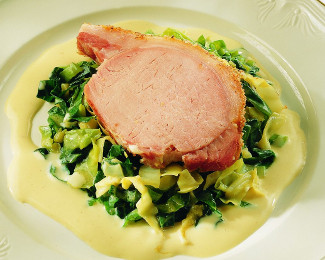 To Cook
To Cook
Weigh the joint then place in a saucepan with the chopped vegetables and the peppercorns, and add enough cold water to cover. Bring slowly to the boil over moderate heat, then turn down and simmer gently for approx. 20 minutes per 500g.
Preheat a fairly hot oven, Gas Mark 6, 200ºC (400ºF).
After the estimated time, remove the joint from the saucepan. Reserve the liquid; remove the rind and score the fat. Place the joint on a roasting dish; mix the mustard and bread-crumbs, runny Orchard Syrup and a knob of butter and spread this mixture over the joint.
Finish in the hot oven for 15-20 minutes.
To make the sauce
Melt the butter in a saucepan, then blend in the flour and mustard. Cook gently for a minute or two, then whisk in the reserved cooking liquid and cream. Bring to the boil, stirring. Reduce the heat and simmer gently for 3-4 minutes, stirring frequently.
The sauce should have the consistency of thin cream. Taste for seasoning and keep warm while you cook the cabbage and slice the bacon joint.
To cook the cabbage
Just before serving, cook the cabbage lightly in another saucepan with some of the cooking liquid. Drain well and toss in butter. Season to taste.
To serve
Slice the bacon and serve on a bed of cabbage, with a little of the mustard sauce and, of course floury potatoes, colcannon or mash.
Brewer's Gold Cheese - Special Irish Foods & The People Who Make Them
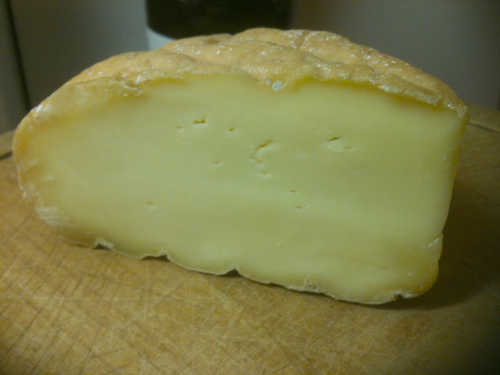
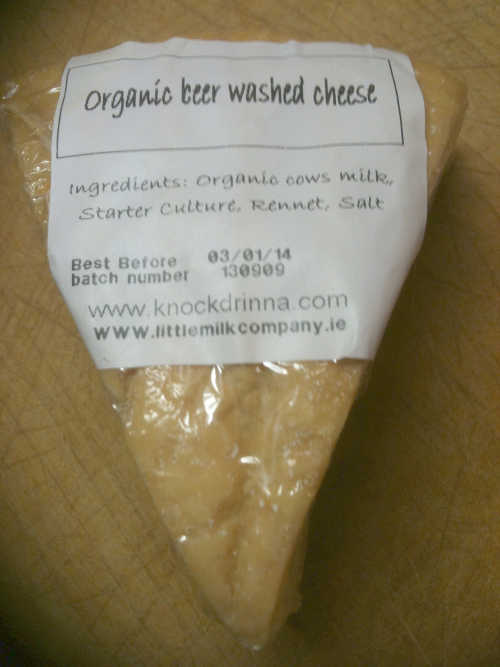 New artisan cheeses have been coming onto the Irish market in a pleasingly steady flow in recent years and, every now and then, something really unusual comes along. That can certainly be said of the latest cheese made by Helen Finnegan at the family farm in Stoneyford, Co Kilkenny, where the famous Knockdrinna range is produced.
New artisan cheeses have been coming onto the Irish market in a pleasingly steady flow in recent years and, every now and then, something really unusual comes along. That can certainly be said of the latest cheese made by Helen Finnegan at the family farm in Stoneyford, Co Kilkenny, where the famous Knockdrinna range is produced.
I first tasted ‘Brewer’s Gold’ at their stand at the RDS Craft and Design Fair - and it’s one of those cheeses that, once tasted, soon finds its way into the shopping basket.
Semi soft with a smooth golden yellow paste, it has an unusual, punchy flavour - and no wonder, as not only is it made with organic cow’s milk from the Little Milk Company (a group of 11 family-run organic dairy farmers in the Leinster/Munster region, who also produce some cheeses of their own), but it is rind-washed in Irish craft beers and ales including O’Hara’s Pale Ale, Dungarvan Brewing’s Red Ale, and Eight Degrees’ Red Ale.
This lovely golden cheese is aptly named, as ‘Brewer’s Gold’ is also a hop known for its sharp or pungent bittering quality - and yes, in this case eating the cheese rind and all could be recommended to get the full complexity of the flavours lent by the craft beers. Brewer’s Gold partners well with robust accompaniments - Ditty’s oatcakes, perhaps, and of course a glass of beer.
 To taste it for yourself, buy it fromone of the specialist food stores listed on knockdrinna.com (including Avoca, Sheridans, Fallon & Byrne, Ardkeen Good Food Store, Mannings Emporium and many more - or from their online store, where you can also buy all of their other cheeses (including Kilree, the British Cheese Awards 2011 Supreme Champion), seasonal hampers and gift packs in several sizes, cheeseboard selections, pestos and relishes, cheese serving slates, tickets for cheese making courses and gift vouchers.
To taste it for yourself, buy it fromone of the specialist food stores listed on knockdrinna.com (including Avoca, Sheridans, Fallon & Byrne, Ardkeen Good Food Store, Mannings Emporium and many more - or from their online store, where you can also buy all of their other cheeses (including Kilree, the British Cheese Awards 2011 Supreme Champion), seasonal hampers and gift packs in several sizes, cheeseboard selections, pestos and relishes, cheese serving slates, tickets for cheese making courses and gift vouchers.
Like Brewer’s Gold itself, which is a product of many combined talents, the Knockdrinna website reflects the strong community values of the region.
For here you’ll also find products from nearby Goatsbridge Trout Farm, including their very special trout caviar, hot and cold smoked trout, plus vouchers for smoking workshops and tours of the trout farm.
Porridge Oats
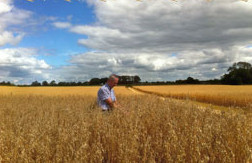
 Oats are among the most important crops grown in Ireland and, while we tend to take them for granted, we should value this simple, wholesome food for its goodness, notably its special slow-release energy and cholesterol reducing qualities - and, providing they are pure (ie uncontaminated by previous crops grown on the same land, or during the milling process), oats are suitable for most people with gluten intolerance.
Oats are among the most important crops grown in Ireland and, while we tend to take them for granted, we should value this simple, wholesome food for its goodness, notably its special slow-release energy and cholesterol reducing qualities - and, providing they are pure (ie uncontaminated by previous crops grown on the same land, or during the milling process), oats are suitable for most people with gluten intolerance.
Flahavans, the sixth generation family firm that has been milling oats at Kilmacthomas for over 200 years, making it one of Ireland's longest-running family businesses, is by far the biggest processor, buying a high proportion of the oats grown in Ireland and offering an ever-growing range of popular products. Most popular of all is their long-established Flahavan's Oatlets, while Flahavan's Organic Porridge Oats and Flahavan's Organic Jumbo Oats attract special praise for their texture and taste.
 Smaller brands include Kilbeggan Organic Oats, produced on Ballard Organic Farm in Co Westmeath where Pat Lalor, a former Flahavans supplier, now uses his oats to make oatlets (fine, creamy) and jumbo oats (larger, with more distinct texture). Like Flahavans, this much younger business has won many awards since the brand was established in 2011 (including a Euro-Toques Food Award in 2013), and it is becoming more widely distributed in Ireland and abroad - including the Dean & Deluca cafés and shops throughout the USA.
Smaller brands include Kilbeggan Organic Oats, produced on Ballard Organic Farm in Co Westmeath where Pat Lalor, a former Flahavans supplier, now uses his oats to make oatlets (fine, creamy) and jumbo oats (larger, with more distinct texture). Like Flahavans, this much younger business has won many awards since the brand was established in 2011 (including a Euro-Toques Food Award in 2013), and it is becoming more widely distributed in Ireland and abroad - including the Dean & Deluca cafés and shops throughout the USA.
This porridge with a difference is from Neven Maguire of MacNean House & Restaurant, who has teamed up with Flahavan’s to create a new range of quick and easy-to-prepare recipes using Irish oats.
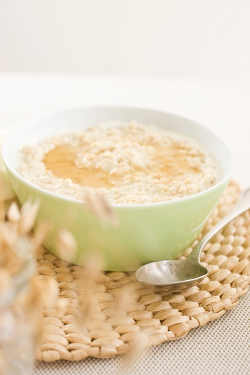 Porridge with Apple, Sultanas and Crème Fraiche
Porridge with Apple, Sultanas and Crème Fraiche
Great for these cold wintry mornings.
Serves 2-3
Ingredients
350 - 450ml Apple juice (according to desired consistency)
100g (3½ oz) Flahavan’s Progress Oatlets
½ apple grated
1 tbsp. sultanas
Freshly grated nutmeg to taste
1 tbsp. crème fraiche
Cooking and Serving Instructions
Place the oats and apple juice in a saucepan and bring to the boil.
Reduce the heat and simmer for 3-4 minutes until soft and creamy.
Add in the sultanas and grated apple and stir gently.
To serve, pour the porridge into a bowl and grate over a light dusting of fresh nutmeg.
Top with a spoonful of crème fraiche.
Butlers Chocolates - Special Irish Foods & The People Who Make Them
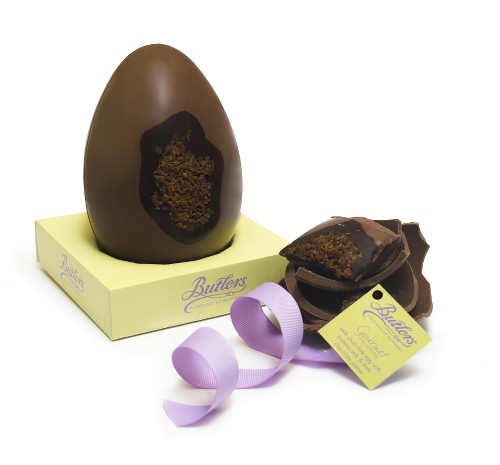
 Georgina Campbell
Georgina Campbell
Chocolate may once have seemed an unlikely speciality for artisan producers in Ireland to adopt in their droves, but it has proved a very successful one. There seems no limit to the Irish passion for chocolate and, fortunately for producers, no seasonal downs either, although there are pleasing peaks at Christmas, Valentines Day - and Easter.
A large number of skilled chocolatiers are now turning out top quality products all over the country and, while many of many of them are one-man (or woman) operations in small kitchens, there are also larger companies with a well-earned reputation for quality and innovation, of which Butlers Chocolates (www.butlerschocolates.com) is probably the oldest.
Dating back to 1932, the company was originally called Chez Nous and founded by an enterprising lady called Marion Butler who ran it until 1959 when it was taken over by the Sorensen family of Cork, who still run it today.
Enterprise and innovation have continued to bring success, with major milestones including the opening of the first Butlers Chocolate Café in 1998 (there are now more than fifteen in Ireland alone and the concept has exported very successfully to some surprising destinations, including New Zealand).
The Butlers Chocolate Cafés in both terminals at Dublin Airport are a very welcome sight, although a painful reminder of the missed opportunity to use our airport shopping areas specifically to showcase the best of Irish, as the original duty-free shops once did at Shannon Airport.
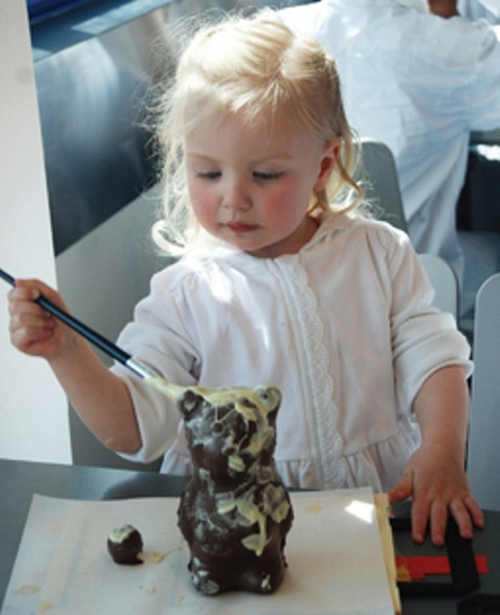 More recently the company opened the Butlers Chocolate Experience in north Dublin, which is now one of Dublin’s top attractions and includes a chocolate museum, chocolate cookery classes (with Ballymaloe trained demonstrator, Yvonne Carty) and children’s birthday parties as well as the factory tour. The tour takes an hour and a half and it’s best done on a weekday if you want to see the factory in action.
More recently the company opened the Butlers Chocolate Experience in north Dublin, which is now one of Dublin’s top attractions and includes a chocolate museum, chocolate cookery classes (with Ballymaloe trained demonstrator, Yvonne Carty) and children’s birthday parties as well as the factory tour. The tour takes an hour and a half and it’s best done on a weekday if you want to see the factory in action.
A great day out over the Easter hols, perhaps - but it’s very popular so booking is essential (small discount when booking online).
The Butlers Easter range is much in demand at the moment, of course, and there’s a great online shop offering a painless way to get everything from hot chocolate to seasonal treats or wedding favours.
Recipe From Apron Strings, Recipes from a Family Kitchen by Nessa Robins
“I grew up with a serious love of chocolate biscuit cake. For as long as I can remember, the popular treat that my mother would make was her famous chocolate biscuit cake. Never there a birthday party or a family gathering but a large tray of it was on offer. It was a perfectly simple recipe, and a lot less luscious than my own version, however it is still a recipe I use to today.
Jack loves orange-flavoured chocolate, and he also loved my Mam's biscuit cake. So for his eighth birthday I developed this recipe. The invigorating zestiness of orange along with the creamy chocolate gives such a wonderful depth of flavour to this cake. It is incredibly indulgent, so a little finger per serving will suffice. It benefits greatly from resting, tightly parcelled, in the fridge, so only pack in a picnic hamper just before leaving the house.”
Use any good quality dark chocolate (min. 60% cocoa solids) for this recipe. [All of the Butlers Chocolates bars can be used for cooking, notably their plain white and dark chocolate (70% cocoa solids); the range is available online from their website.]
Chocolate Orange Biscuit Cake
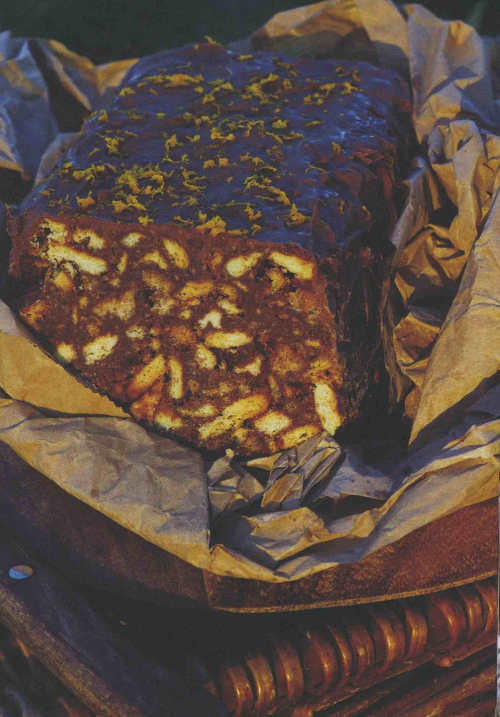 300g Marietta biscuits
300g Marietta biscuits
250g good quality dark chocolate
100 butter, melted
1 tsp drinking chocolate
½ tsp of orange extract
1 tin condensed milk
Topping:
100g milk chocolate, melted
½ an orange, zest only
Roughly crush the biscuits in a bowl.
Melt the chocolate, butter and drinking chocolate together in a large bowl over a saucepan of simmering water. Remove from the heat, and then stir in the orange extract and condensed milk.
Pour this chocolate mixture over the bowl of biscuits and stir well to combine all the ingredients.
Line a 2lb loaf tin with cling film (or baking parchment) and spoon the mixture into it. Place the tin in the fridge to set for at least 2 hours.
Place on a serving plate and drizzle with the melted chocolate and grate over the zest of half an orange.
The cake will keep in the fridge for 3 days.
Young Buck Cheese - Special Irish Foods & The People Who Make Them


If you haven’t come across a ‘Stitchelton’ before, the Northern Irish cheesemaker Mike Thomson of Newtownards, Co Down, would be happy to perform the introduction.
His recently launched Young Buck is a new blue cheese in the Stilton style - a category that has been dubbed ‘Stitchelton’ by makers of similar cheeses outside the designated Stilton area, who are not allowed to use the venerable blue cheese’s protected name and have adopted a much older version of it instead (which reputedly dates back to a reference in the 11th century Domesday Book).
Mike Thomson, who trades under the name Mike’s Fancy Cheeses (www.facebook.com/mfcheese; www.mfcheese.com), uses the unpasteurised milk from a single herd of Co Down Holstein-Friesian cows to make his cheese, which has quite a salty Stilton-like flavour and the characteristic knobbly crust; the blue-veined paste is smooth and creamy at the centre, with a chalkier, slightly crumbly texture towards the edges.
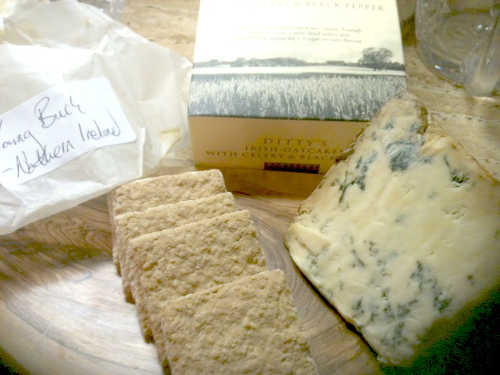
In Ireland, Sheridans Cheesemongers (www.sheridanscheesemongers.com) have welcomed Young Buck (“there are too few Irish blues,” comments Kevin Sheridan) and stock it in their Galway, Meath and Dublin shops.
While not a carbon copy of Stilton, Young Buck is a pleasing cheese. Like other blues, it works very well in a salad with pears and walnuts, and it teams agreeably with a fruity accompaniment such as Sheridans Fig Compote or a slice of quince cheese (aka ‘quince paste’). Well worth trying.
Achill Island Sea Salt - Special Irish Foods & The People Who Make Them
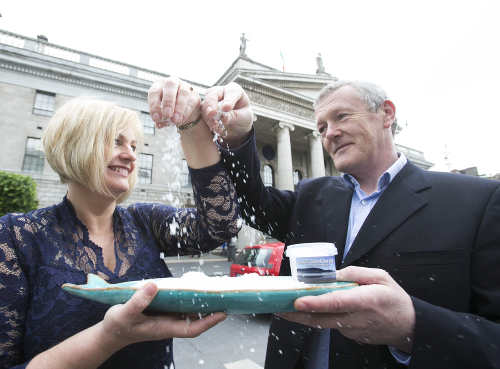
 Georgina Campbell
Georgina Campbell
New products (and themed books) are like buses, you wait for ages for one to come along and then suddenly there are several.
Despite our long, rugged coastline and clean Atlantic water, Irish sea salt was a long time coming, and now we have three - Irish Atlantic Sea Salt from West Cork, which is relatively well established; Oriel Sea Salt of Co Louth (a pouring salt, due on the retail market soon); and Achill Island Sea Salt (www.achillislandseasalt.ie), a small family-run Co Mayo business that was one of five recipients of the 2014 EirGrid Euro-Toques Food Awards, presented in May.
The business is very new, having been founded by Kieran, Marjorie and Sean O'Malley less than a year ago, in July 2013. Their aim was to revive the age-old tradition of salt production on Achill Island and to produce a hand harvested, sustainable and pure artisan product from the wild Atlantic waters of Keel Bay.
In time-honoured style, the business began in the family kitchen, where sea water collected in plastic buckets from Keel and Dooagh Bay was boiled in saucepans to evaporate the water so that the salt crystals could be harvested.
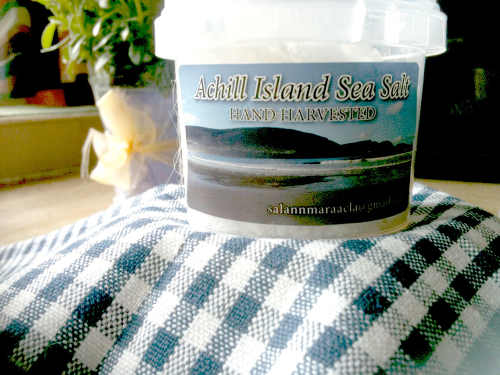 Achill Island Sea Salt is a natural product, with a soft, flaky texture similar to the benchmark sea salt product, Maldon Salt, and flavour between that and the intensely salty Irish Atlantic Sea Salt. Chefs particularly appreciate that the crystals break down quickly on food.
Achill Island Sea Salt is a natural product, with a soft, flaky texture similar to the benchmark sea salt product, Maldon Salt, and flavour between that and the intensely salty Irish Atlantic Sea Salt. Chefs particularly appreciate that the crystals break down quickly on food.
Euro-Toques Chefs and members of their Food Council were impressed with the salt for “its texture, taste and flaky appearance”; praised the O’Malley’s entrepreneurial spirit and determination in setting up a sustainable business on Achill Island.”
Achill Island Sea Salt attracted a lot of publicity from an early stage and, in order to increase production and meet demand from chefs and speciality food shops, the O’Malleys have now moved into a pilot plant beside their home in Keel.
As production increases it should become more easily available. It is displayed in shops and restaurants locally, and features on some Euro-Toques and other discerning menus in other areas too.
There is a list of stockists on their website, but online listings get dated easily so you may have to put a bit of work into finding Achill Island Sea Salt, but it’s worth the search. On a recent visit to Mayo, it was unavailable at Kelly’s of Newport, but we later spotted it at Café Rua in Castlebar (both listed stockists) and have since seen it on sale at Sheridans of Carnaross, Co Meath and the shops at Ballymaloe, Co Cork (not listed stockists). Other products in the pipeline are turf smoked sea salt; seaweed infused sea salt? and sea salt blended with various herbs and spices.
[Note: The Euro-toques Food Awards have been in existence since 1996. Their purpose is for Euro-toques chefs to identify the very best food being produced in Ireland for the benefit of fellow chefs and consumers, and above all the producers themselves, who are often very small operators.
In doing this they seek to highlight foods and production methods that may be in danger of being lost and to promote people who were producing food of the very highest quality and, above all, the best taste.
Producers are nominated by Euro-Toques member chefs who use their produce on their menu. The Euro-toques Food Council made up of 8 chefs from across Ireland carry out tastings, investigations and visits before choosing 5 winners each year. The awards have been sponsored by EirGrid since 2010.]
Baldwins Farmhouse Ice Cream - Special Irish Foods & The People Who Make Them
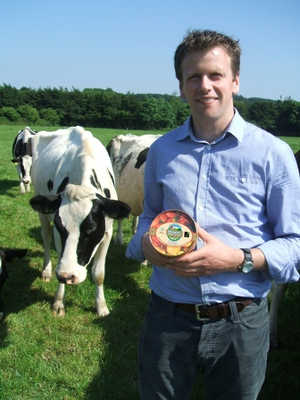
 Given Ireland’s lush grass and strong dairy tradition, it is not surprising that a lot of dairy farmers have diversified into ice cream production in recent years, and we are now fortunate to have quite a wide choice of high quality, small production ice creams - although distribution tends to be limited to their local area.
Given Ireland’s lush grass and strong dairy tradition, it is not surprising that a lot of dairy farmers have diversified into ice cream production in recent years, and we are now fortunate to have quite a wide choice of high quality, small production ice creams - although distribution tends to be limited to their local area.
One to look out for when visiting the south and south-eastern counties is Baldwins Farmhouse Ice Cream - and it was in fact their sign that drew our attention to chef Avril Fox’s newly opened shop and café, The Farran Pantry (021 743 2758 / Facebook:TheFarranPantry) just off the N22 Cork-Killarney road recently: if they were stocking Baldwins, this would probably be a quality operation. And, having demolished a tub of vanilla (always the best test), it was confirmed that a Baldwins treat would be as good an excuse as any to make a first visit this handy pitstop.
Baldwins Farm House Ice Cream is made on the family farm near Knockanore village in beautiful West Waterford. Having been inspired by a farms tour in Holland some years ago, Thomas Baldwin, with his parents John and Maria, now uses the milk and cream from their Holstein/British Friesian cross cows to produce an outstanding dairy ice cream.
Unlike many modern ice creams, it is made on a traditional crème anglaise base and in small batches, and uses a special pasteurising technique which protects the natural flavours - and the difference is obvious, in both the rich flavour and the lovely creamy texture.
The retail range includes classic vanilla, strawberry and half a dozen other popular flavours, and a much wider range is available for hotels and restaurants throughout the region, many of whom take pride in showcasing these excellent products. They also attend events, and have an ice cream cart which can be hired out for special occasions.
Look for their ice cream in speciality shops in the Waterford/Cork area, and in local restaurants including Farmgate, Midleton, and Electric, in Cork city. It is well worth seeking out.
Toonsbridge Irish Buffalo Products - Special Irish Foods & The People Who Make Them
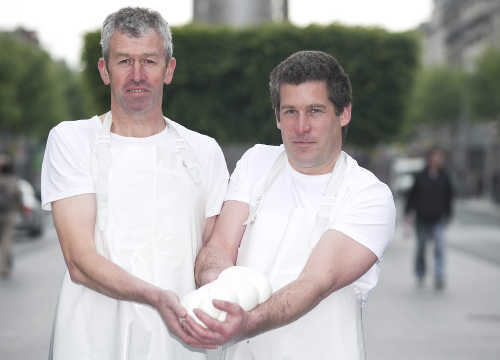
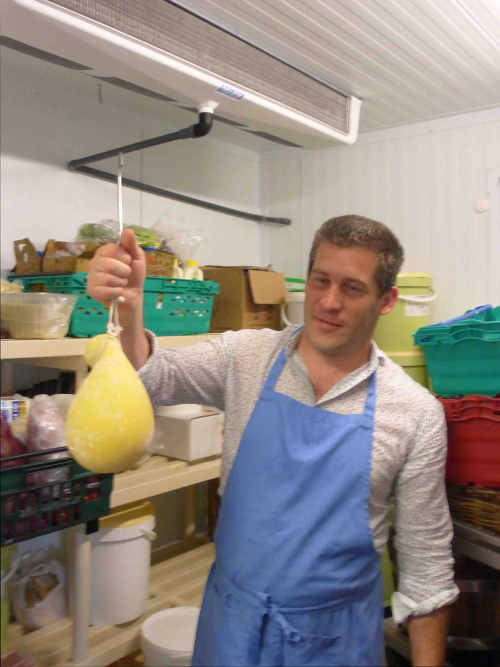 Georgina Campbell
Georgina Campbell
Toby Simmonds is a legend of alternative thinking in the Irish food world - in 1993 he started a venture that many said would never work, The Real Olive Company, at a stall in Cork’s English Market. It was a huge success.
Roll forward a couple of decades or so and he was doing it again, this time joining forces with neighbouring farmer Johnny Lynch, with the aim of establishing Ireland’s first water buffalo herd and producing raw milk buffalo cheese.
Now this newer venture at Toonsbridge Dairy, making Ireland’s only buffalo products - notably mozzarella, ricotta and a feta style cheese, along with numerous works in progress, including a stunning blue cheese - is a sensation. There’s a shop and weekend café (new pizza oven for summer 2014), and buffalo meat is also available.
The road from idea (classically born, over a pint) to production took them through many loops and turns but, eventually, the 31 young buffalo sourced from the Prince of Lombardia were happily installed on Johnny’s farm.
 Toby and Johnny spent time in Italy learning the traditional methods of mozzarella making, but their early attempts were not very successful. So local cheesemaker Sean Ferry (former producer of the famous thermophilic cheeses Desmond and Gabriel with Bill Hogan, now retired) was enlisted to help and an Italian mozzarella maker was invited over to Ireland, resulting in much better cheeses.
Toby and Johnny spent time in Italy learning the traditional methods of mozzarella making, but their early attempts were not very successful. So local cheesemaker Sean Ferry (former producer of the famous thermophilic cheeses Desmond and Gabriel with Bill Hogan, now retired) was enlisted to help and an Italian mozzarella maker was invited over to Ireland, resulting in much better cheeses.
In 2013 they upped the game again with the arrival of Franco Picciuolo, who had been working in the caseificio (cheese farm) where Toby and Johnny trained; the small changes that he initiated have resulted in some stunning cheeses, which are attracting much praise including a prestigious Eirgrid Euro-Toques Food Award (euro-toques.ie/tag/food-awards/) in 2014, citing “… the amazing quality of their mozzarella and for their innovative approach to bringing a foreign tradition into Ireland and making it their own. This effectively means that our kitchens can avail of the freshest grass-fed Irish mozzarella, which is precisely as mozzarella should be served.”
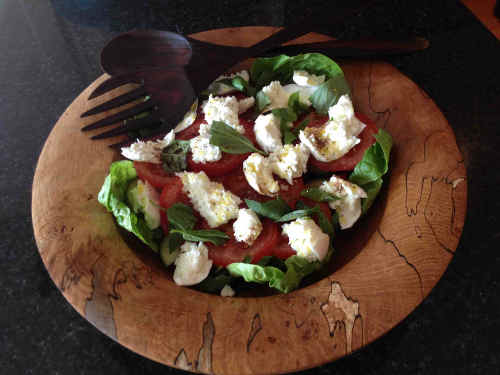 TRY the amazing fresh Toonsbridge Mozzarella Salad with rocket, little gem lettuce, strawberries, cucumber, tomatoes, basil leaves, and cracked black pepper with a drizzle of Donegal Rapeseed Oil and Llewellyn`s Irish Balsamic Cider Vinegar - a classic, why change it? See it served here in a very stylish Bunbury bowl (www.bunburyboards.com) from Lisnavagh, Co Carlow.
TRY the amazing fresh Toonsbridge Mozzarella Salad with rocket, little gem lettuce, strawberries, cucumber, tomatoes, basil leaves, and cracked black pepper with a drizzle of Donegal Rapeseed Oil and Llewellyn`s Irish Balsamic Cider Vinegar - a classic, why change it? See it served here in a very stylish Bunbury bowl (www.bunburyboards.com) from Lisnavagh, Co Carlow.
OR WHY NOT rustle up a hot supper of Chicken Breast Stuffed With Smoked Toonsbridge Mozarella and a Smear of Pesto, Wrapped In Parma Ham - delicious served on a bed of ratatouille with a Dalkey Mustard kick.
Ballyhoura Mountain Mushrooms - Special Irish Foods & The People Who Make Them
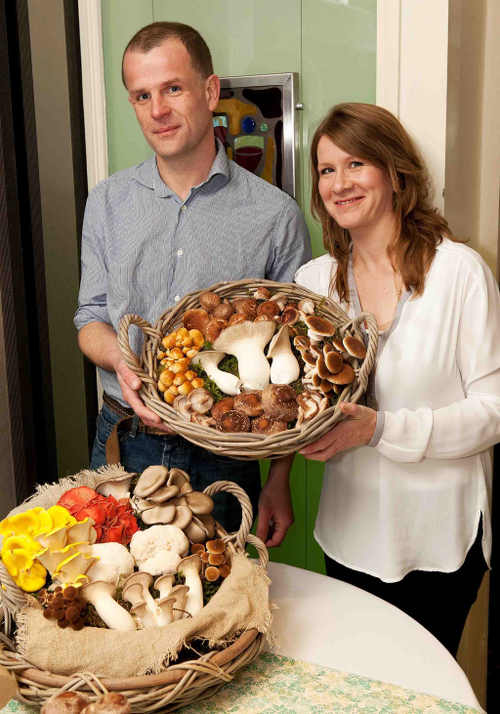
 Very much with the zeitgeist for wild and foraged foods, Lucy Deegan and Mark Cribbin’s enterprising north Cork company grows a unique range of speciality mushrooms - comprising everything from shiitake and oyster mushrooms to velvet pipionni and nameko.
Very much with the zeitgeist for wild and foraged foods, Lucy Deegan and Mark Cribbin’s enterprising north Cork company grows a unique range of speciality mushrooms - comprising everything from shiitake and oyster mushrooms to velvet pipionni and nameko.
Spores are inoculated into local wood including oak, birch and elder; and, harnessing the light and pure air of their location, the mushrooms thrive.
But not only do they grow these wonderful fungi, but they also supply a wide range of wild and foraged foods including plants like wild garlic, sorrel and wild strawberries in season as well as naturally occurring local fungi.
Not content with supplying the raw produce, they also offer dried mushrooms and an interesting range of mushroom products including marinated oyster & shiitake mushrooms, mushroom soups, wild mushroom and oyster mushroom paté.
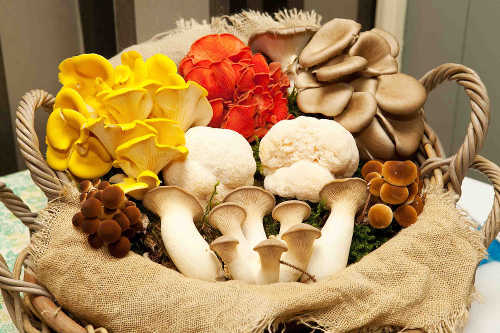 The marinated mushrooms and the oyster mushroom paté offer a superb vegetarian alternative for starters and light meals, and there are also special flavourings such as cep oils and mushroom seasoning powders - wild cep and shitake - that provide umami flavours that can give a real lift to food without the need for meat-based stocks.
The marinated mushrooms and the oyster mushroom paté offer a superb vegetarian alternative for starters and light meals, and there are also special flavourings such as cep oils and mushroom seasoning powders - wild cep and shitake - that provide umami flavours that can give a real lift to food without the need for meat-based stocks.
An extraordinary product to seek out is shiitake bacon, which just happens to taste like bacon, but without the pig, and has many uses as a replacement for bacon. Amazing.
You’ll spot Ballyhoura Mushrooms at farmers’ markets in the Cork area, and they also take stands at food shows. [Farmers’ Markets: Mahon Point (Thu, 10-2) Cornmarket Street (Sat 9-2) Midleton (Sat 9-1)]
Even before you taste them, you will instantly see why they have attracted so much praise, including awards from both the Irish Food Writers’ Guild and Euro-Toques (neither of which accept applications from producers, both are totally independent).
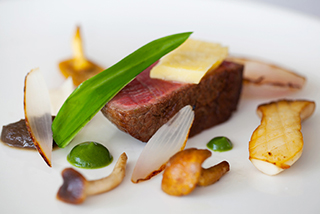 RECIPE: Dry-aged beef, Ballyhoura Mountain Mushrooms, Coolea cheese, parsley purée, wild garlic
RECIPE: Dry-aged beef, Ballyhoura Mountain Mushrooms, Coolea cheese, parsley purée, wild garlic
Recipe created for the Irish Food Writers’ Guild Awards 2014 by chefs Derry Clarke and Michael Hunter of l’Ecrivain restaurant, Baggot Street, Dublin 2.
This simple dish showcases Ballyhoura Mushrooms and another award winner, Coolea cheese, which is produced in the same area, alongside some quality dry-aged Irish beef.
Serves 4
for the beef
2 fillet dry-aged Irish steaks
freshly ground Irish Atlantic Sea Salt and black pepper
for the mushrooms
300g assorted Ballyhoura Mountain Mushrooms, cleaned
freshly ground Irish Atlantic Sea Salt and black pepper
1 tbsp Worcestershire sauce
for the parsley purée
200g fresh flat-leaf parsley
30ml olive oil
for the wild garlic
handful wild garlic, washed
1 tbsp butter
freshly ground Irish Atlantic Sea Salt and black pepper
to serve
4 generous slices Coolea cheese
Season the steaks and sear on a very hot pan, making sure to brown all sides. Cook medium-rare and leave to rest for at least five minutes.
Heat a clean pan, add a little rapeseed oil and toss the mushrooms for two minutes. Season and add a tablespoon of Worcestershire sauce. Transfer to a kitchen towel.
Remove the parsley leaves from the stalks. Place the stalks in a pot of boiling water for two minutes. Add the leaves and cook for a further two minutes. Remove from the heat and transfer to a bowl of iced water. Drain and blend in a food processor with the olive oil until smooth. Finally pass through a sieve.
Toss the wild garlic in a hot pan with the butter, season and sauté for 10-15 seconds.
To serve, cut the steaks in half. Place a slice of Coolea cheese on each piece of beef. Dot the plate with parsley purée and scatter the sautéed wild garlic over the beef.
Durcan's Spiced Beef - Special Irish Foods & The People Who Make Them
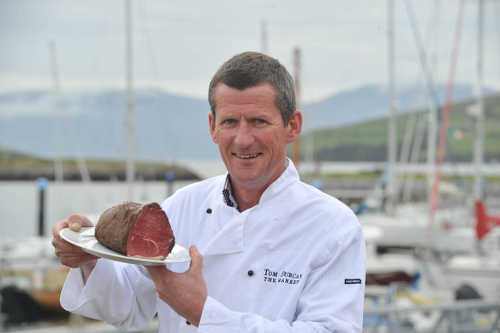
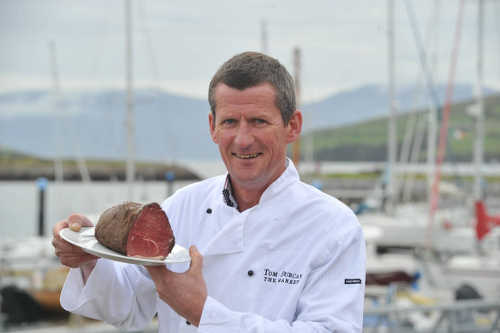 Georgina Campbell
Georgina Campbell
Tom Durcan Meats was established in 1985, so this is far from being one of Ireland’s longest-established butchers - but it is one of the most highly-regarded and, being right next to the fountain at The English Market, also very easy to find.
A member of the Craft Butchers Association of Ireland, Tom Durcan takes pride in sourcing meat locally and in the ‘farm to fork’ traceability of all of his meats, which are sought after by many discerning restaurateurs. The dry-aged beef is especially popular - but the product he’s most famous for is a Christmas speciality, the Cork Traditional Spiced Beef, which has won all kinds of competitions.
Most recently this unique traditional product picked up two awards at the Blas na hEireann Irish Food Awards which took place in Dingle, Co. Kerry in October. One of these was for the spiced beef itself and it also scooped “Best Export Opportunity”, which was sponsored by PanEuro Foods, while another of Tom’s products, Spiced Beef Carpaccio, won a Silver.
The annual ritual begins for Tom in October when he prepares the spice mix and starts to select the various joints - sometimes including lamb’s tongues as well a range of beef cuts - that will marinade for at least a month, maybe two.
They sell over a ton of spiced beef every Christmas and everyone has their own favourite way of cooking and serving it - but Tom likes his best served cold and sliced, “with caramelised Spanish onions, on crusty buttered white bread”.
The spiced beef is also available to buy pre-cooked and sliced from Centra and SuperValu supermarkets nationwide.
Tom Durcan’s advice on how to cook the perfect spiced beef:
Remove meat from all packaging, weigh it and place in a pot of cold water. Bring slowly to the boil and simmer gently for 50 minutes per kilo if it is to be eaten warm. To eat cold, cook for 40 minutes per kilo and leave to cool in the cooking liquid. Leaving the meat to cool in the cooking liquid helps to preserve its moistness for slicing.
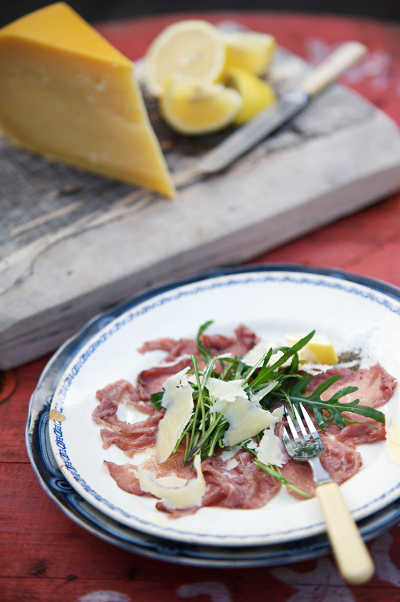 RECIPE: Spiced Beef Carpaccio
RECIPE: Spiced Beef Carpaccio
The classic thinly sliced raw beef ‘carpaccio’ has never been more popular and this recipe for from Denis Cronin, of the Mad Fish Restaurant at Cronin’s Pub, Crosshaven, Co. Cork, is a tasty example of spiced beef at its best.
Ingredients
Tom Durcan's spiced beef, uncooked
Fresh garden rocket or mustard leaves
Irish rapeseed oil or olive oil
Good mature hard farmhouse cheese - our favourite is extra mature Coolea Farmhouse Cheese
Sea salt and fresh ground pepper
Lemon wedge
Freeze the spiced beef. Then slice the beef in a meat slicer as fine as the machine will allow. The meat pieces should be almost see through.
Arrange the meat pieces on a cold plate, using roughly twelve slices, and covering the whole plate.
Place a bunch of leaves in the centre and drizzle with rapeseed or olive oil.
Finally garnish with shavings of cheese, a small wedge of lemon, with a side of fresh ground pepper and sea salt.
The beef will come to room temperature after approximately three or four minutes after slicing and is ready to be served immediately.
Mick Healy, Wild Irish Game - Special Irish Foods & The People Who Make Them
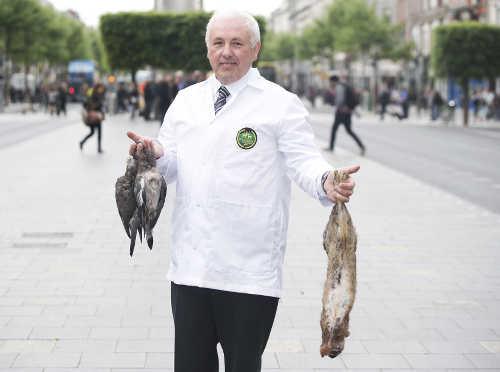
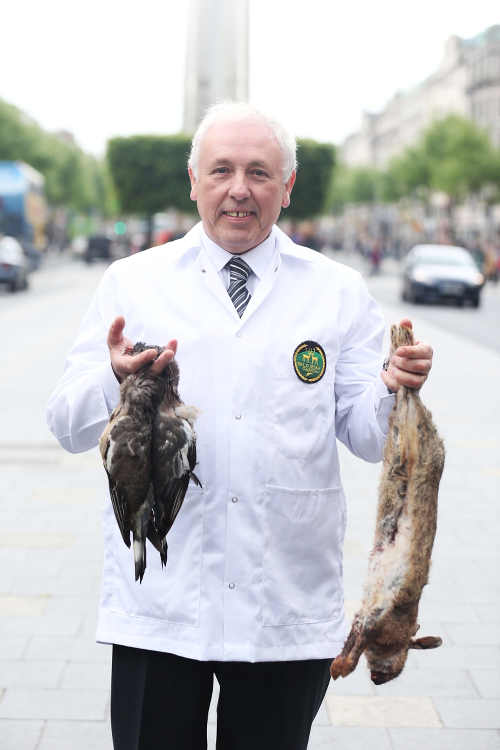 A fervent supporter of sustainable hunting and seasonality, Mick Healy was singled out for a 2014 Euro-Toques Award. Highlighting his ‘commitment to delivering the best and most sustainable wild game available’ he was also commended for ‘the quality of his products, which he handles with respect for tradition.’
A fervent supporter of sustainable hunting and seasonality, Mick Healy was singled out for a 2014 Euro-Toques Award. Highlighting his ‘commitment to delivering the best and most sustainable wild game available’ he was also commended for ‘the quality of his products, which he handles with respect for tradition.’
County Wicklow is well stocked with furred and feathered creatures, making it a perfect base for a man who’s mad about wild game and much of his produce will come from his own locality - although it’s also said that ‘he would drive to Connemara to fill the desire for a snipe or woodcook, or to the Slobs in Wexford for widgeon, teal or mallard and up to Louth for wild Irish hare.’
In season (October to February), Wild Irish Game offers the widest selection of quality wild game available in Ireland, including Sika deer, which is the predominant species found in Mick’s home patch.
He is Ireland’s only Department of Agriculture approved processor of wild game including pheasant, venison, rabbit, quail, guinea foul, grouse, mallard, teal, wigeon, snipe, partridge, woodcock, rabbit, and woodpigeon .
High standards, consistency and reliability are the Healy by-words, which is just the encouragement many consumers need to try cooking game - the well presented vacuum packed and, in some cases, frozen products are distributed to selected outlets and sold online.
Highbank Organic Gins - Special Irish Foods & Drinks & The People Who Make Them
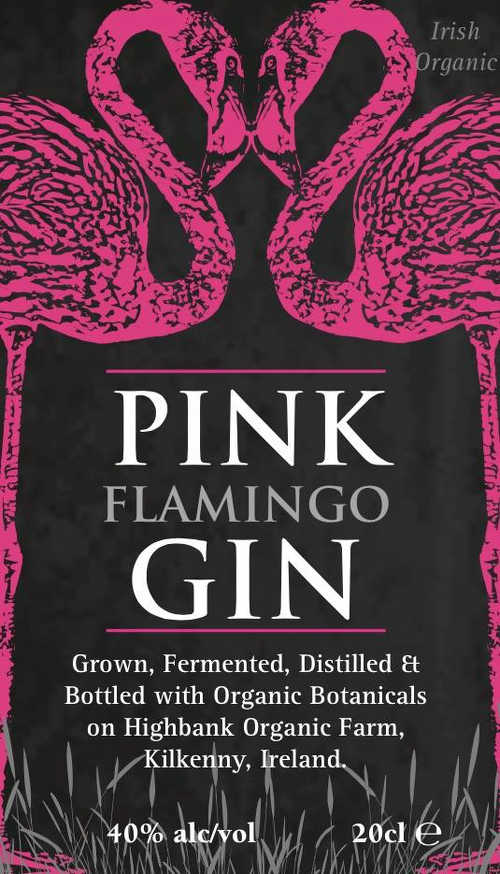
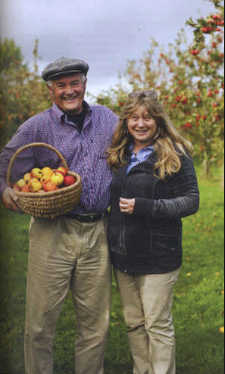 DEE LAFFAN spills the beans on Ireland’s newest, smallest – and only organic – distillery
DEE LAFFAN spills the beans on Ireland’s newest, smallest – and only organic – distillery
The rumour mill has been in overdrive for the past month that Highbank Farm & Organic Orchards, Co. Killkenny will be distilling a gin in early 2015. The good news is that the highly-aniticipated organic craft gin is being distilled as you read this and will be on the market next month.
Highbank Orchards is an organic farm, owned and run by Rod and Julie Calder-Potts, growing delicious apples and producing apple juice and, most famously, the superb Highbank Organic Syrup that has attractd many accolades including a highly respected Irish Food Writers’ Guild Award in 2013. They also produce fantastic organic craft ciders including Highbank Proper Cider, Drivers Cider and Medieval Cider.
“I really believe that small farmers need to process to survive, by adding value to customers. A lot of artisan farmers are doing that now and it should be celebrated in Ireland,” Julie commented.
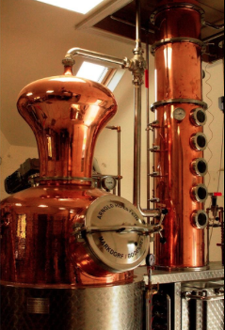 For the newest extension to their range, Rod and Julie acquired a small contemporary copper pot still, with rectification column, and began distilling in the first week of December 2014. In that first week of distilling, they produced Highbank Orchard schnapps, vodka, spirit, and liqueur, which is their apple brandy. Not bad for one week of distilling! These alcohols were launched on December 13th on the farm at a community launch, attended by many locals and supporters from further afield.
For the newest extension to their range, Rod and Julie acquired a small contemporary copper pot still, with rectification column, and began distilling in the first week of December 2014. In that first week of distilling, they produced Highbank Orchard schnapps, vodka, spirit, and liqueur, which is their apple brandy. Not bad for one week of distilling! These alcohols were launched on December 13th on the farm at a community launch, attended by many locals and supporters from further afield.
It is important to note that not only is their distillery the smallest in the country, it is the only organic spirit distillery in Ireland and also the only one where the raw material for the spirits is grown on the farm the distillery is based on. The 100% organic apple alcohol is made from their own apple crops, from field to bottle.
It was a natural progression that gin was next to be added to the list and Rod and Julie have been busy distilling and tasting and will be launching their two organic gins next month. Highbank Pink Flamingo Gin launches on Valentine’s Day, February 14th 2015, and Highbank Crystal Gin will also launch later in the month.
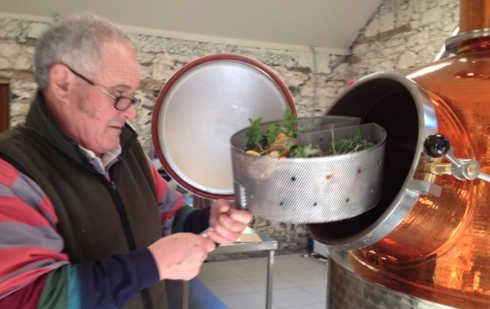 The recipe for the Organic Pink Flamingo Gin, especially what makes it pink, is a closely guarded secret and Julie’s lips are sealed on that particular detail! However, the known ingredients are the 100% organic alcohol, which is produced on the farm, with 14 botanicals and the classical gin aromatics including organic juniper, coriander flower, lavender.
The recipe for the Organic Pink Flamingo Gin, especially what makes it pink, is a closely guarded secret and Julie’s lips are sealed on that particular detail! However, the known ingredients are the 100% organic alcohol, which is produced on the farm, with 14 botanicals and the classical gin aromatics including organic juniper, coriander flower, lavender.
Taste and flavour are of the upmost importance to Rod and Julie, as with all of their products, and distilling drinks of the highest quality in small runs is their objective.
 “Highbank Pink Flamingo Gin is to be enjoyed over ice with a slice of lemon or lime. Very simple and flavoursome”, said Julie.
“Highbank Pink Flamingo Gin is to be enjoyed over ice with a slice of lemon or lime. Very simple and flavoursome”, said Julie.
Highbank Farm has also opened its gates to visitors in the past year becoming members of the agri-tourism sector. Domestic and international visitors can have a tour of the farm and distillery, with tastings included, and the opportunity to buy products from the farm shop.
Highbank Pink Flamingo Gin will be available in heart-shaped 50ml, 200ml and 500ml bottles and the normal shaped bottle will be availble in 700ml, from Highbank Farm shop, independent off-licences and on the menu in select fine dining restaurants.
As a bonus, Highbank Organic Pink Flamingo Gin will be available in limited heart-shaped bottles when launched for Valentine’s Day. The perfect gift for the gin lover in your life!
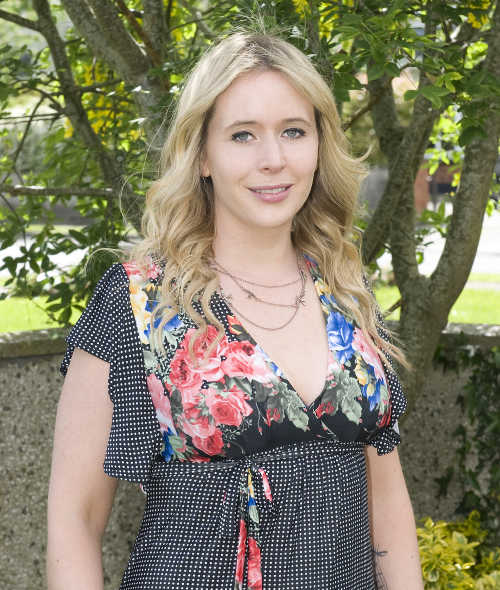 Dee Laffan is a freelance food writer and editor. Formerly editor of Easy Food magazine, she has written for the Irish Independent and Sunday Independent. She is a proud supporter of Irish producers and their products, and takes part in judging for food competitions including Blas na hÉireann and the Great Taste Awards. She is a member of the Irish Food Writers' Guild and secretary for Slow Food Dublin. Twitter @deelaffan
Dee Laffan is a freelance food writer and editor. Formerly editor of Easy Food magazine, she has written for the Irish Independent and Sunday Independent. She is a proud supporter of Irish producers and their products, and takes part in judging for food competitions including Blas na hÉireann and the Great Taste Awards. She is a member of the Irish Food Writers' Guild and secretary for Slow Food Dublin. Twitter @deelaffan
McCarthys of Kanturk - Special Irish Foods & Drinks & The People Who Make Them
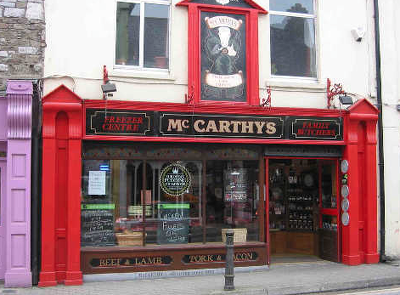
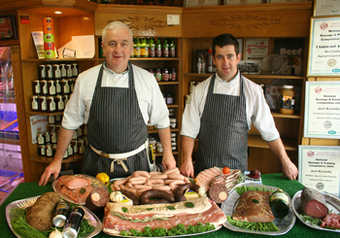 Dee Laffan talks to the fourth and fifth generation butchers, McCarthys of Kanturk, about their business - and their hugely popular Pig in a Day courses
Dee Laffan talks to the fourth and fifth generation butchers, McCarthys of Kanturk, about their business - and their hugely popular Pig in a Day courses
The excellence of McCarthy’s Butchers of Kanturk has long been celebrated; their meats are renowned countrywide and their legendary black pudding continues to make tongues wag and mouths salivate, even those from royal lineage!
Since the Queen was served their black pudding at the State Banquet during her visit in 2011, Jack and Tim McCarthy have been as busy as ever in the butchers shop and have also extended their business into the educational sphere, hosting The ‘Practical Pig’ day course.
“We held our first course two-and-a-half years ago; it was a great success, and people have been asking us about it since”, said Tim.
Jack McCarthy and his son, Tim, proudly represent the fourth and fifth generation of this famous butchers business. Through generations of their family, the skills, knowledge and recipes that are alive and well today in the shop in Kanturk, were handed down, passed on, and learned.
“We have family ledgers dating back to 1881”, Tim told me. “When you put that into perspective, that was 40 years after the famine! The information and recipes that are in those ledgers are the same that we use today. Our famous black pudding that’s on sale in the shop is the same recipe from the ledger, perhaps tweaked a bit over the years, but its origin is in there.”
 With that much ancestral skill being passed on to people through their “Practical Pig” courses, it is no wonder that the most recent one in January sold out weeks before the event itself. The recent day course received rave reviews from attendees, so no doubt the next one on April 26th will be even more keenly anticipated.
With that much ancestral skill being passed on to people through their “Practical Pig” courses, it is no wonder that the most recent one in January sold out weeks before the event itself. The recent day course received rave reviews from attendees, so no doubt the next one on April 26th will be even more keenly anticipated.
There are a number of reasons why the course came about, but the main one is that Jack and Tim found customers were yearning for knowledge on butchering. Even chefs would ask how they could get more from their pigs. In recent years, there has been a growing interest in learning forgotten skills and butchering is one that people are now eager to learn. There are also a lot more people keeping pigs of their own for slaughter, and they need to help to understand how to get the most from them.
The ‘practical pig’ courses give an insight into pig production for chefs, foodies and people interested in learning more about pork processing. Over the course of a day they educate people in all areas of pork butchering, giving practical exhibitions in slaughtering, boning/trimming/portioning, curing, sausage making and pudding making, with a lecture on breeding, feeding and free range pig farming.
There is also a talk on each day from a top chef; the chef at the last course, in January, was Bryan McCarthy, Excutive Head Chef of the highly regarded Greenes Restaurant at Hotel Isaacs in Cork, who is well known for his policy of using fresh and natural local foods. There is a chance to roll up your sleeves and get involved in every stage of production, and you’ll also get to take home recipes.
“We find the main question we get asked is, ‘what’s the difference between pork and bacon?’ It’s usually the first question people want to ask, but the last one they will ask. It’s amazing how many people don’t know the answer, but are also almost embarrassed to ask. Our course will educate people about pork, but also in the skill of butchering, something that we should all know about, especially as consumers of meat.”
Tim McCarthy was one of the many speakers and food producers at this year’s Foodie Forum in Galway-Mayo Institute of Technology (GMIT), which took place on Tuesday 3rd February 2015. The one-day interactive conference purposefully showcases the best in Ireland, but especially from the west coast.
In Tim’s class, he spoke wholeheartedly about Irish pork production and the need to buy Irish and buy local, also encouraging the culinary arts students of GMIT to remember to use Irish pork in their future kitchens, saying “it’s in your hands now.” He demonstrated some butchering skills and how to use the pig from nose to tail. (Other highlights included JP McMahon's demo on reviving our taste for vegetarianism by using vegetables as many ways as we can, like pickling & fermenting cucumbers, and by adding meat condiments like stocks and dehydrated/ground meat to add extra taste to dishes; and Kevin Thornton and Sally McKenna gave a wonderful talk and demo on cooking with seaweed and other sea veggies.)
The next Practical Pig in a Day course in Kanturk, is on April 26th 2015, from 9am-5pm. Places are limited and the cost is €195 per person, which includes lunch on the day and a gift pack for participants at the end of the course. More courses are planned for later in the year, including some in Dublin.
McCarthy's of Kanturk, Main Street, Kanturk, Co. Cork (029) 50178
www.jackmccarthy.ie
www.facebook.com/mccarthysofkanturk
www.twitter.com/mccarthykanturk
---
 Dee Laffan is a freelance food writer and editor. Formerly editor of Easy Food magazine, she has written for the Irish Independent and Sunday Independent. She is a proud supporter of Irish producers and their products, and takes part in judging for food competitions including Blas na hÉireann and the Great Taste Awards. She is a member of the Irish Food Writers' Guild and secretary for Slow Food Dublin. Twitter @deelaffan
Dee Laffan is a freelance food writer and editor. Formerly editor of Easy Food magazine, she has written for the Irish Independent and Sunday Independent. She is a proud supporter of Irish producers and their products, and takes part in judging for food competitions including Blas na hÉireann and the Great Taste Awards. She is a member of the Irish Food Writers' Guild and secretary for Slow Food Dublin. Twitter @deelaffan
Goatsbridge Trout - Special Irish Foods & The People Who Make Them
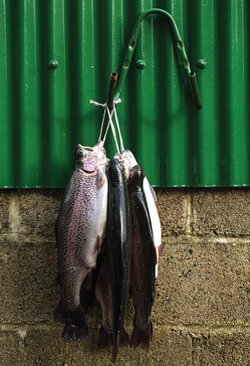
 Dee Laffan
Dee Laffan
Hard work and passion go hand-in-hand for most small farmers and artisan producers and no truer statement could be made about Mag and Ger Kirwan of the third generation business, Goatsbridge Trout Farm. They are hard working, passionate and always looking at how to ensure that their brand and top quality products are available to as many people as possible.
It was this mindset that led them to launch their new ‘Eat Trout’ retail products, along with new branding that was created to coincide with the launch of the range. “We realised that we were never going to compete outside Ireland with fresh trout, for obvious reasons, so within Ireland we focus on growing the fresh fish counter market,” explains Mag. “I really wanted to create an ambient product with a long shelf life, giving potential to extend our brand abroad and that’s how these new products came about.”
 The first product in the range was launched early in 2014, a delicious Traditional Smoked Rainbow Trout. “Traditional smoking means curing fish by smoking it at an air temperature not higher than 33°C to avoid cooking the fish, resulting in a delicate texture.”
The first product in the range was launched early in 2014, a delicious Traditional Smoked Rainbow Trout. “Traditional smoking means curing fish by smoking it at an air temperature not higher than 33°C to avoid cooking the fish, resulting in a delicate texture.”
The next was Barbequed Rainbow Trout, which has also been available in specialist shops since 2014, following into supermarkets in spring/summer 2015. The hot smoking process means that the fish has a firmer texture.
Next in the range was their famous Trout Caviar, which is available only through specialist food shops. This award-winning product has a very mild fish taste and is a true delicacy.
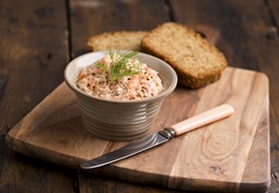 Taking a very different tack, two exciting products, Tinned Smoked Trout and Barbecued Trout Paté, are both available through the Goatsbridge website, and will also be in supermarkets nationwide spring/summer 2015.
Taking a very different tack, two exciting products, Tinned Smoked Trout and Barbecued Trout Paté, are both available through the Goatsbridge website, and will also be in supermarkets nationwide spring/summer 2015.
“We are really excited to be able to bring these new products to supermarkets because we really feel that trout is something special that everyone should taste. The Tinned Smoked Trout is preserved in sunflower oil, so it’s great for salads and pasta dishes. The Paté is absolutely delicious and is something we’ve been making for years at home, but just decided to bring it to the market as we think it will be very popular. The flavours are fantastic.”
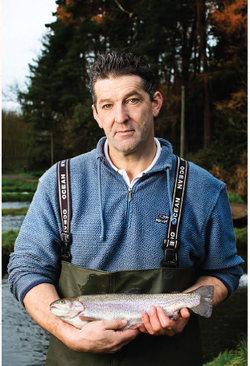 High quality is paramount at Goatsbridge, where the fish are taken daily from The Little Arrigle River at Thomastown (designated Town of Food; www.townoffood.com). The crystal clear waters of the river have been fished since the foundation of nearby Jerpoint Abey in 1180, and this is what gives Goatsbridge trout its unique taste and texture. It’s no wonder that their products fly off the shelves - Mag and Ger deserve every success with them.
High quality is paramount at Goatsbridge, where the fish are taken daily from The Little Arrigle River at Thomastown (designated Town of Food; www.townoffood.com). The crystal clear waters of the river have been fished since the foundation of nearby Jerpoint Abey in 1180, and this is what gives Goatsbridge trout its unique taste and texture. It’s no wonder that their products fly off the shelves - Mag and Ger deserve every success with them.
For more information and to buy products online, visit www.goatsbridgetrout.ie
---
 Dee Laffan is a freelance food writer and editor. Formerly editor of Easy Food magazine, she has written for the Irish Independent and Sunday Independent. She is a proud supporter of Irish producers and their products, and takes part in judging for food competitions including Blas na hÉireann and the Great Taste Awards. She is a member of the Irish Food Writers' Guild and secretary for Slow Food Dublin. Twitter @deelaffan
Dee Laffan is a freelance food writer and editor. Formerly editor of Easy Food magazine, she has written for the Irish Independent and Sunday Independent. She is a proud supporter of Irish producers and their products, and takes part in judging for food competitions including Blas na hÉireann and the Great Taste Awards. She is a member of the Irish Food Writers' Guild and secretary for Slow Food Dublin. Twitter @deelaffan
Burren Smokehouse - Special Irish Foods & The People Who Make Them
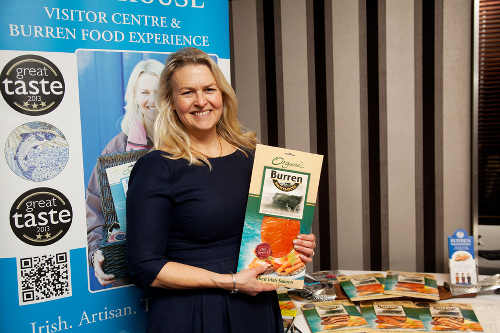
 Well deserved recipient of the 2015 Irish Food Writers Guild ‘Notable Contribution to Irish Food Award’, Birgitta Curtin is not only dedicated to maintaining the highest standards for her own famous smoked salmon - all of which is organically produced on Ireland's west coast - and other equally carefully sourced products at the Burren Smokehouse and Visitor Centre, which attracted over 30,000 visitors last season, but she is a member of the TASTE Council, which set up an Artisan Food Production module for transition year students.
Well deserved recipient of the 2015 Irish Food Writers Guild ‘Notable Contribution to Irish Food Award’, Birgitta Curtin is not only dedicated to maintaining the highest standards for her own famous smoked salmon - all of which is organically produced on Ireland's west coast - and other equally carefully sourced products at the Burren Smokehouse and Visitor Centre, which attracted over 30,000 visitors last season, but she is a member of the TASTE Council, which set up an Artisan Food Production module for transition year students.
Internationally, Birgitta is an extraordinarily energetic ambassador for Irish produce at international trade fairs and promotions at events like the One Fest in Boston, devoted to showing all that is best in Ireland, and the Speciality Food Fair in London, where she never misses an opportunity to raise the profile of Irish food. Burren Smokehouse products are available in a number of European countries and the UK where, over the years, the salmon has been available in establishments like Harrods, Selfridges and Fortnum & Mason.
As Chairperson of Slow Food Clare, Birgitta was involved in establishing The Burren Food Festival and is the main organiser of the annual event. The Burren Smokehouse is a member of the Burren Ecotourism Network.
Each year in May, the Burren Slow Food Festival takes place in Lisdoonvarna with some satellite events nearby. Featuring cookery demos, food-related talks by well-known personalities, kids’ workshops and a Farmers’ and Artisan Food Producers’ Market, it is a festival that's not just for foodies. Find more information on http://www.slowfoodclare.com/
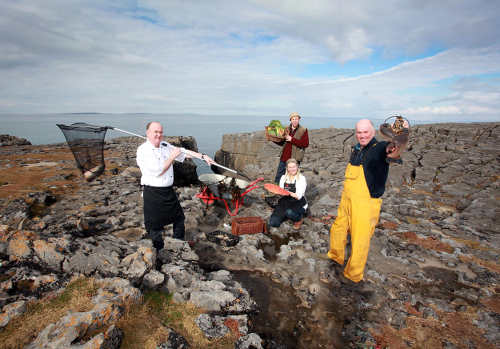 [Image shows John Sheedy of Sheedy's Restaurant, Birgitta Hedin Curtin of Burren Smokehouse, Jason Horner of Leen Organics and Gerry Sweeney of Burren Seafoods photographed in the Burren]
[Image shows John Sheedy of Sheedy's Restaurant, Birgitta Hedin Curtin of Burren Smokehouse, Jason Horner of Leen Organics and Gerry Sweeney of Burren Seafoods photographed in the Burren]
Teeling Whiskey Distillery - Special Irish Foods and Drinks & The People Who Make Them
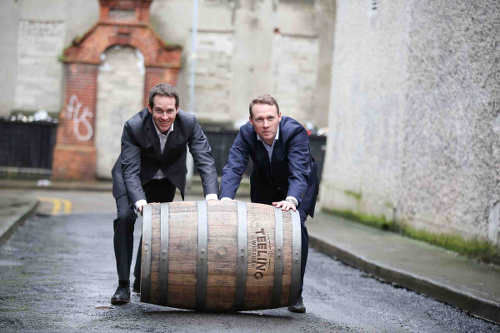
 Dee Laffan speaks with Stephen Teeling of the new Teeling Whiskey Distillery in Newmarket Square, Dublin 8, which opens its doors this month.
Dee Laffan speaks with Stephen Teeling of the new Teeling Whiskey Distillery in Newmarket Square, Dublin 8, which opens its doors this month.
It is one of the most keenly anticipated openings of a Dublin attraction for many years. Far from being just another tourist attraction, the new Teeling Whiskey Distillery in Newmarket Square, Dublin 8, signals a new era for the Irish whiskey industry, and the return of a great Dublin tradition that has long been gone – whiskey making.
It is the only working distillery in the city, and the first in Ireland to offer an access-all-areas tour of the production process from start to finish. Not since the Guinness Storehouse has an attraction anything like this opened in Dublin.
Work has been under way for some time, however, and it was originally expected to open at Easter… So what has been the delay?
“We’re not just the only attraction in Dublin where you can see a real working distillery, but also you won’t get this access-all-areas anywhere else in the country,” explained Stephen.
“Figuring out how to do it properly and safely for visitors was a challenge - hence the delay. But we’ve won a few major tour contracts, with people who bring visitors here on an annual basis, and they are booked in for mid-May, so now it really needs to be ready!”
 The team at the new distillery includes some of the production team from the old Cooley distillery, and the General Manager of the visitor centre is Sheila Baird, formerly of The Marine Hotel, Sutton. “The main basis of any visitor centre is customer service and my brother Jack and I had been with people in Kilbeggan who were from the hospitality industry and we could see the benefits of getting someone like that who has worked in that industry for many years. It’s a different skill set; we know how to make whiskey and the whiskey business, but the visitor centre is very different - especially when you are putting in retail and a café.”
The team at the new distillery includes some of the production team from the old Cooley distillery, and the General Manager of the visitor centre is Sheila Baird, formerly of The Marine Hotel, Sutton. “The main basis of any visitor centre is customer service and my brother Jack and I had been with people in Kilbeggan who were from the hospitality industry and we could see the benefits of getting someone like that who has worked in that industry for many years. It’s a different skill set; we know how to make whiskey and the whiskey business, but the visitor centre is very different - especially when you are putting in retail and a café.”
The location of the distillery was key in making it work, for many reasons, and as it turns out, the location has genealogical significance also.
“Our family background is in that area. We had a distillery there in the Liberties back when that whole area was a centre of distilling and brewing. In that whole catchment area, there were 34 separate documented distilleries and breweries, owing to a number of factors: there was access to water, that was where most of the grains came into the city, and there were other industries there like tanneries, malting houses and a lot of the textiles were made there too. So we knew there was a rich history in the Liberties; but more recently, our grandfather had a shop on Stephen’s Street and generations of Teelings have had involvement in the city centre. It is just the right spot for us.”
“People thought we were bonkers trying to set up in Dublin city centre because a) you wouldn’t get the property and b) you wouldn’t get the planning. We were fortunate with timing in terms of the property market; if we had looked around the time of the Celtic Tiger we wouldn’t have been able to do it.”
“One thing we really wanted to showcase was a real functioning, traditional pot still distillery of the kind that Dublin was famous for, and key to that was to get trucks in off the street for delivery for malt and barley, and also to take away your whiskey for storage. Newmarket Square is perfect for this.”
“We recognised a big gap in the market for a Dublin city approach to Irish whiskey. While Jameson has the museum and old distillery to go and visit, it is actually made in Cork. Where we saw the gap was taking more of an urban approach, putting a Dublin personality behind the brand – it was the old tradition of putting your family name on it – and with that in mind, we were creating an ode to the past, but with a more contemporary approach. We didn’t go down the standard approach with green bottles and focusing on rural Ireland, we wanted to do something a little grittier. Just like Dublin and that old part of the town, where whiskey distilling used to be so prolific.”
The main offering will be a tour, where visitors will experience the entire whiskey distilling process from start to finish.
 “I think people don’t know that much about whiskey because they don’t know how it’s made, but once it is broken down into the 5-6 processes, it will be clear and they will be really responsive. From the grain to the hopper and fermentation tanks, right up to the three beautiful pot stills… it will open people’s minds and hearts to the story of a Dublin whiskey.”
“I think people don’t know that much about whiskey because they don’t know how it’s made, but once it is broken down into the 5-6 processes, it will be clear and they will be really responsive. From the grain to the hopper and fermentation tanks, right up to the three beautiful pot stills… it will open people’s minds and hearts to the story of a Dublin whiskey.”
The distillery is laid out over three floors, with the main company offices on the third floor - and this is also an event space, to hire for a private function or that VIP experience.
On the first floor is an area with a rotating art/craft exhibition and a café offering pastries and coffees. Visitors assemble here before their tour begins and, from there, you go into a mezzanine that brings you into the distillery and right up to the pot stills where the whiskey is being made.
On the second floor, there is a maturation area, showing all the different casks that are involved in the production of whiskey, also some tasting docks and a second bar and lounge, where you can have a premium tasting or a cocktail.
There’s also a retail space offering some exclusive items for sale, typically collaborations with local craft-makers, to show the link back to the local community – key to their story and ethos.
“It is a fascinating time for Irish whiskey, but also for us, with the amazing response we’ve received for bringing a new attraction to the city and also jobs to the area,” commented Stephen.
For more information, visit: www.teelingwhiskey.com/teeling-distillery/
View some really nice videos of the pot stills arriving into Newmarket Square on their Vimeo channel here: https://vimeo.com/teelingwhiskey
---
 Dee Laffan is a freelance food writer and editor. Formerly editor of Easy Food magazine, she has written for the Irish Independent and Sunday Independent. She is a proud supporter of Irish producers and their products, and takes part in judging for food competitions including Blas na hÉireann and the Great Taste Awards. She is a member of the Irish Food Writers' Guild and secretary for Slow Food Dublin. Twitter @deelaffan
Dee Laffan is a freelance food writer and editor. Formerly editor of Easy Food magazine, she has written for the Irish Independent and Sunday Independent. She is a proud supporter of Irish producers and their products, and takes part in judging for food competitions including Blas na hÉireann and the Great Taste Awards. She is a member of the Irish Food Writers' Guild and secretary for Slow Food Dublin. Twitter @deelaffan
Farrelly's Butchers and Abattoir - Special Irish Foods & The People Who Make Them
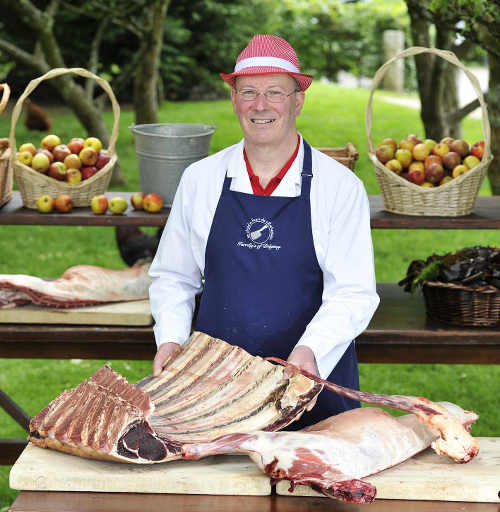
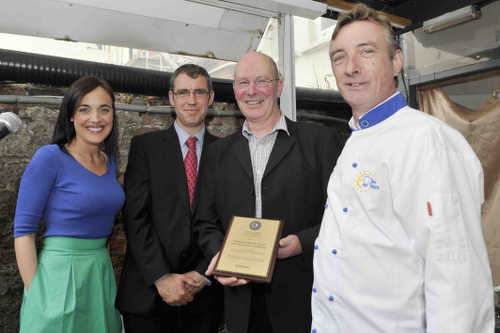 Following an apparently unstoppable onslaught by the multiples and their promise of convenience and low prices, the family butchers shop has undergone a remarkable renaissance in recent years - greatly helped by the support of quality, fair price and local provenance driven groups such as Euro-Toques Ireland, which has shouted loudly about the vital role of local foods since its foundation by Myrtle Allen and a group of likeminded industry professionals in 1986.
Following an apparently unstoppable onslaught by the multiples and their promise of convenience and low prices, the family butchers shop has undergone a remarkable renaissance in recent years - greatly helped by the support of quality, fair price and local provenance driven groups such as Euro-Toques Ireland, which has shouted loudly about the vital role of local foods since its foundation by Myrtle Allen and a group of likeminded industry professionals in 1986.
The annual EirGrid Euro-Toques Food Awards took place in June at Dublin’s Residence Members Club, and attracted a record number of nominations from member chefs this year. Among just five winners selected by the Food Council of Euro-Toques Ireland was a very special County Wicklow business, Farrelly’s Butchers, of Delgany (T: 01 287 4211), which was established in 1958 and still has its own abattoir and beef farm.
Giving their reasons for the choice, the Euro-Toques Food Council - which is chaired by Evan Doyle of The BrookLodge Hotel at Macreddin Village - said that brothers Anthony and Padgraig Farrelly run a progressive butcher’s shop that ticks all the boxes for restaurants and consumers, with butchered to order cuts that have true provenance. While Ireland is losing its small abattoirs to large-scale facilities every year, Farrelly’s continues to demonstrate the advantages of a small independent operation.
 Responding to the award, Tony Farrelly, of Farrelly’s Butchers, commented: “Having our own abattoir means we work with the whole animal, we can give the customer exactly what they, no matter cut they’re after. We can also stand over the quality because we go to the farms and source the animals ourselves. This allows us to see what breeds are out there and try new things, with the confidence of knowing that we can guarantee the customer that quality.”
Responding to the award, Tony Farrelly, of Farrelly’s Butchers, commented: “Having our own abattoir means we work with the whole animal, we can give the customer exactly what they, no matter cut they’re after. We can also stand over the quality because we go to the farms and source the animals ourselves. This allows us to see what breeds are out there and try new things, with the confidence of knowing that we can guarantee the customer that quality.”
Joe's Farm Crisps - Special Irish Foods & The People Who Make Them
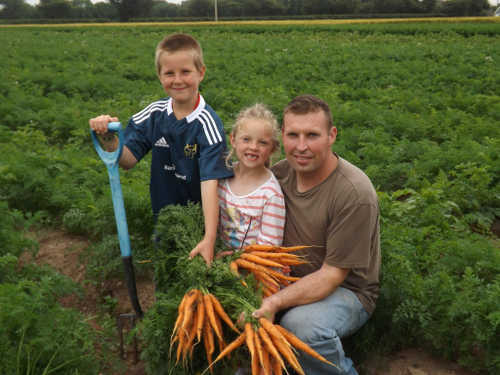
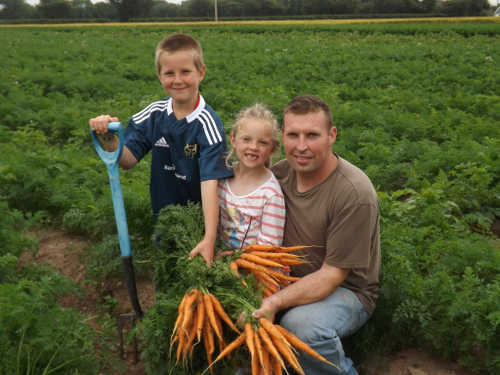 In what you might think is a saturated market, one Irish product has managed to find a niche and edge its way into the top ranks of people’s tastes, and is even found as a garnish in a well-known five-star resort in Cork. Dee Laffan gets to know the people behind the successful artisan product – Joe’s Farm Crisps.
In what you might think is a saturated market, one Irish product has managed to find a niche and edge its way into the top ranks of people’s tastes, and is even found as a garnish in a well-known five-star resort in Cork. Dee Laffan gets to know the people behind the successful artisan product – Joe’s Farm Crisps.
Crisps are definitely a part of Irish food culture. More recently it is the artisan variety that has been winning over consumers’ taste buds. Potato and vegetable farmers looking to add more value to their business have turned their home grown produce into a tasty, savoury snack. This is exactly why Joe and Sandra Burns, vegetable farmers from County Cork, started to make Joe’s Farm Crisps.
“We’ve been growing vegetables for about 8-9 years and started selling our first packets of crisps in March 2014,” explained Sandra. “We were only in business two weeks when the head chef in Castlemartyr Resort contacted us to ask if he could use them as a garnish with their sandwiches. We couldn’t believe it!”
“We sell our vegetables at farmers’ markets and it came to a point when we knew we had to do something different to increase our offering. The last straw really was when the supermarkets had given a ‘five cents offer’ two years ago at Christmas and then the weather was bad that year too for growing, so it was the worst Christmas ever for us. We just knew we had to change to survive,” she explained.
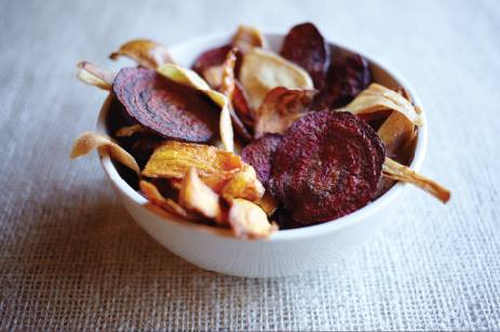 Vegetable crisps are not a new idea, but there are only a few Irish producers making them and with most farmers producing potato crisps, Joe and Sandra identified a significant gap in the market for their product.
Vegetable crisps are not a new idea, but there are only a few Irish producers making them and with most farmers producing potato crisps, Joe and Sandra identified a significant gap in the market for their product.
“It is something different from potato crisps. We do grow potatoes, but we said we wouldn’t go down that route as so many others have. We got the idea from visiting Boston. Joe’s sister lives there and we had seen and tasted them there, and also in the UK. I guess also we just wanted to do something totally different and a bit off the wall!”
Joe’s Farm Crisps are made up of beetroot, parsnip and carrot crisps, with a sprinkle of sea salt. Hand made and packaged, the product is definitely artisanal with distinctive packaging and branding.
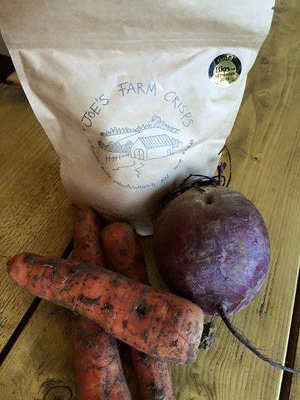 “We didn’t want to use a standard bag, so they are actually coffee bags that we hand stamp ourselves. I just wanted something completely different, no bright colours, but a unique selling point. The brown bag has an earthy look and it gives that connection between the veg and soil. They are re-sealable too (although I’ve yet to have any left to reseal a bag!), which is something I really wanted. It just gives people the choice if they only want to use some for a sandwich or have a few as a snack. Another reason we picked the coffee bags is we wanted to seal in the freshness and give them a longer shelf life of up to six months. Vegetables go out of season, so we need to manage that constantly to make sure we have stock for the whole year. For example, our vegetables started coming into season again in mid-July (they’re a little bit delayed because of the weather this year), but our season is normally March-end of June.”
“We didn’t want to use a standard bag, so they are actually coffee bags that we hand stamp ourselves. I just wanted something completely different, no bright colours, but a unique selling point. The brown bag has an earthy look and it gives that connection between the veg and soil. They are re-sealable too (although I’ve yet to have any left to reseal a bag!), which is something I really wanted. It just gives people the choice if they only want to use some for a sandwich or have a few as a snack. Another reason we picked the coffee bags is we wanted to seal in the freshness and give them a longer shelf life of up to six months. Vegetables go out of season, so we need to manage that constantly to make sure we have stock for the whole year. For example, our vegetables started coming into season again in mid-July (they’re a little bit delayed because of the weather this year), but our season is normally March-end of June.”
Much like every element of this product, the story behind the hand stamp is a unique one.
“Darina Allen’s daughter Lydia designed the graphics on the bags for us. Her husband Rupert runs farmers’ markets and we are at the one in Mahon Point and I was telling him about how we had been to a few designers, and we were getting frustrated because they didn’t seem to capture what we were about in the design. Not to mention the cost! He invited us down to their house and said Lydia would sketch something for us. We went down for tea one day and while she had her baby in one hand and a pencil in the other, she sketched, and I just saw it and said ‘That’s it! That’s exactly what we want.’ We sent it to a place in Dublin to get rubber stamps made and we use those to stamp each bag by hand.
Hopefully one day we will get them printed, but for now it is easier to do them by hand.”
Joe and Sandra are truly inspirational and their hard work and dedication to keeping the quality of their product as high as the first packet is commendable. Proof of the quality is in the eating! Customers can’t seem to get enough as their sales have increased from day one. Although, the learning curve has been a massive one for both of them and Sandra admitted that the first packets were even minus a critical ingredient!
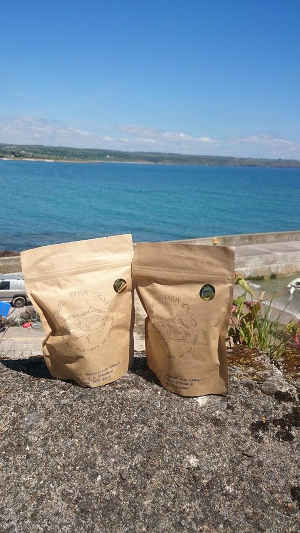 “I actually forgot to salt them! It took us two days to make 27 bags and we were at the market with them for the first time and they were sold out within two hours. I turned to Joe and I said, ‘We’ll never sell any more… I forgot to salt them!’ But those people came back next weekend looking for more! It quickly grew from 27 bags to 100 bags and we’ve been growing ever since.”
“I actually forgot to salt them! It took us two days to make 27 bags and we were at the market with them for the first time and they were sold out within two hours. I turned to Joe and I said, ‘We’ll never sell any more… I forgot to salt them!’ But those people came back next weekend looking for more! It quickly grew from 27 bags to 100 bags and we’ve been growing ever since.”
Perfecting a recipe didn’t come easily either, with lots of testing and three years of work behind the scenes before the launch last March.
“We hadn’t a clue how to make veg crisps!” she laughs. “We googled ‘how to produce veg crisps’ and it kept showing us these mass production machines, which we couldn’t afford let alone know how to use, so we just started simply. We used our deep fat fryer at home to cook them ourselves. We cooked them, undercooked them, overcooked them, burned them and everything in between until we go them right! Then we started making them for our kids’ birthday parties, for friends, and we brought them to the farmers markets to test them out. We knew that people there would give us their honest opinion and that was invaluable.”
The veg crisps will soon be part of a range as they intend to bring out a couple of other bags this year. “Last November we brought out a beetroot only bag, which was extremely popular, and we’ll be starting to make them again once beetroot is back in season in a few weeks. It’s the natural sweetness that makes them taste so good. Plus, we have different varieties of carrots, so we hope to have a rainbow bag of carrots out in October/November in time for Christmas.”
Joe’s Farm Crisps are available in 70 shops nationwide, including off-licenses (especially those selling craft beers) and specialty food shops.
Find them on facebook at www.facebook.com/joesfarmcrispscork
---
 Dee Laffan is a freelance food writer and editor. Formerly editor of Easy Food magazine, she has written for the Irish Independent and Sunday Independent. She is a proud supporter of Irish producers and their products, and takes part in judging for food competitions including Blas na hÉireann and the Great Taste Awards. She is a member of the Irish Food Writers' Guild and secretary for Slow Food Dublin. Twitter @deelaffan
Dee Laffan is a freelance food writer and editor. Formerly editor of Easy Food magazine, she has written for the Irish Independent and Sunday Independent. She is a proud supporter of Irish producers and their products, and takes part in judging for food competitions including Blas na hÉireann and the Great Taste Awards. She is a member of the Irish Food Writers' Guild and secretary for Slow Food Dublin. Twitter @deelaffan
Drummond House Irish Garlic - Special Irish Foods & The People Who Make Them
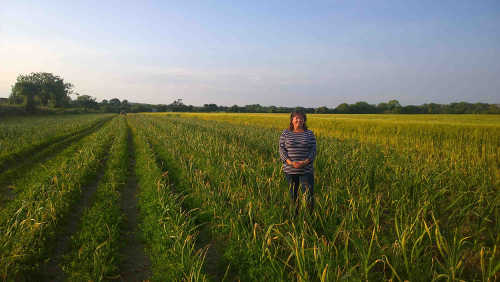
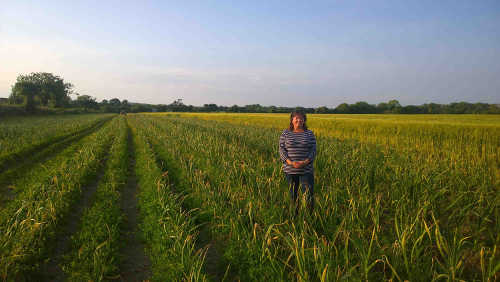 Since Michael Kelly’s famous ‘Eureka’ moment - when confronted by garlic all the way from China in his local supermarket - there’s been a strangely emotive connotation to the provenance of garlic in Ireland. In his case, it inspired him to start up the phenomenally successful GIY movement, while others see potential in the product itself.
Since Michael Kelly’s famous ‘Eureka’ moment - when confronted by garlic all the way from China in his local supermarket - there’s been a strangely emotive connotation to the provenance of garlic in Ireland. In his case, it inspired him to start up the phenomenally successful GIY movement, while others see potential in the product itself.
Take Drummond House Irish Garlic for example, a new enterprise by Peter and Marita Collier, on a 100 acre Co Louth farm that’s been farmed by Peter’s family for over 150 years and is now 'The Home of Irish Garlic'. When he inherited the farm, Peter recognised the need to diversify into new and sustainable production - and a ‘love of real fresh home grown food and an amazing trip to India’ inspired the couple to focus on garlic.
Anyone who has only tasted imported garlic will be amazed by the difference in the texture and flavour of the locally grown produce - and the many variations available. Having started with four varieties in 2013, they have since extended the range to produce ten varieties - Spanish Morado Garlic; Red Czech Garlic; Mikulov Garlic; Messidor Garlic; Bohemian Rose Garlic; Red Duke Garlic; Solent Wight Garlic; Vallelado Garlic; Carcassonne Wight Garlic - all of which sound impossibly exotic for a County Louth farm.
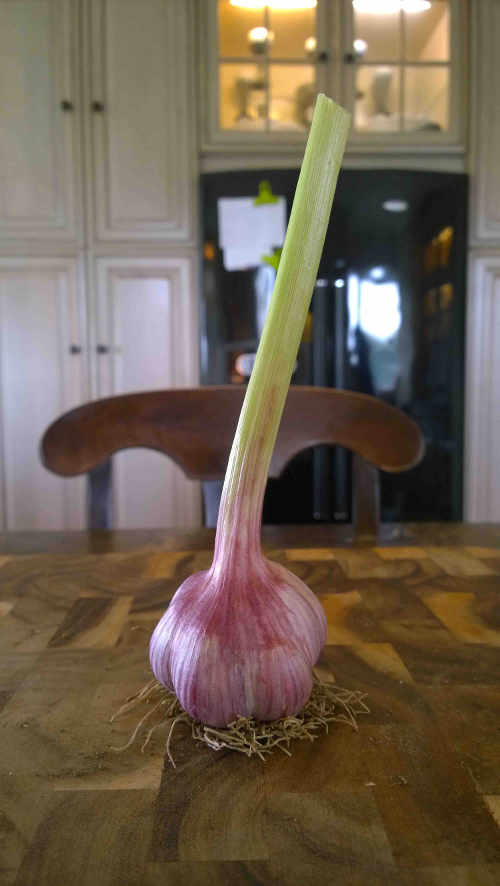 Full details of each variety - and also Elephant Garlic (which is actually a garlic-like member of the leek family, and not a true garlic), Green Garlic (the young plant of any of the garlic varieties), and Garlic Scapes (see below) - are given on their website. Garlic ‘scapes’ (the flower stalk of hard neck garlic varieties, a by-product which is usually wasted) have proved an unexpectedly successful seasonal extra, available only for a few weeks in late May/early June and popular for garlic pesto.
Full details of each variety - and also Elephant Garlic (which is actually a garlic-like member of the leek family, and not a true garlic), Green Garlic (the young plant of any of the garlic varieties), and Garlic Scapes (see below) - are given on their website. Garlic ‘scapes’ (the flower stalk of hard neck garlic varieties, a by-product which is usually wasted) have proved an unexpectedly successful seasonal extra, available only for a few weeks in late May/early June and popular for garlic pesto.
2014 also saw another very exciting new development, with the planting of four acres of asparagus. The Colliers’ sandy coastal soil provides ideal growing conditions for asparagus, which will be an annual treat for food lovers to look forward to in late spring and early summer, and a real education for many.
Tara Walker, of East Coast Cookery School at Termonfeckin, was an early champion of the Colliers' enterprising business and never misses an opportunity to introduce these premium local products to students attending her courses. She has a great recipe for Garlic Scape Tempura on her website, and it's made with Dan Kelly's Cider which is also produced nearby. Some top chefs, including Ed Cooney of The Merrion Hotel, have also been quick to see the potential in these great new products and national distribution is planned through Redmond Fine Foods.
Locally, you will find Drummond House produce in a number of shops, including Tuites Butchers, Drogheda; Irish Farm Cheese Shop, Drogheda; The Forge Field Farm Shop and Madden's Centra, Termonfeckin; Gareth's Family Butchers, Termonfeckin and Clogherhead; Fisherman's Catch, Clogherhead (harbour). Also available at the farm.
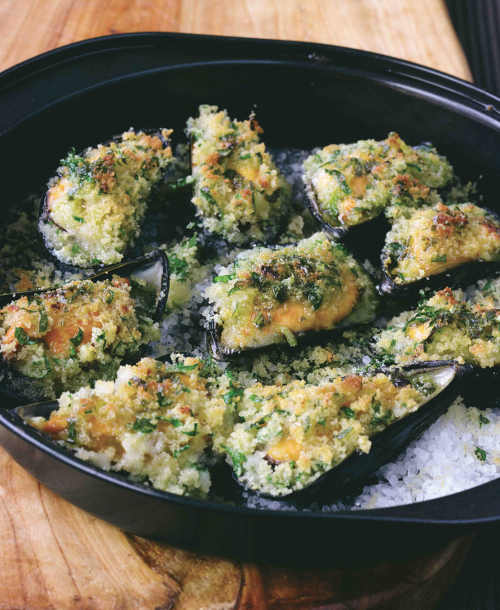 RECIPE: Garlic Stuffed Mussels
RECIPE: Garlic Stuffed Mussels
This is one of the most versatile and universally popular garlic and seafood combinations - and what better dish to make with garlic that’s grown on an Irish seaside farm? Mussels are plentiful, good value for money and perfect as a starter, to hand around at parties or just as a snack. Always wash in plenty of cold water and scrub the shells with a stiff brush. Use a knife to scrape off any barnacles. Discard any open mussels that do not close when lightly tapped on the work surface. Pull out the tough, fibrous beards protruding from the tightly closed shells.
SERVES 4
1kg/21/4lb fresh Irish mussels
about 50g/2oz coarse rock salt
150g/5oz butter
4 Irish garlic cloves, crushed
1 tbsp chopped fresh flat-leaf parsley
squeeze of fresh lemon juice
25g/1oz fresh white breadcrumbs
To Serve: lemon wedges
Preheat the grill. Place the mussels in a shallow, heavy-based pan (no liquid is necessary). Cover with a tight fitting lid and cook over a high heat for 3-5 minutes, shaking occasionally until they have opened. (Discard any that do not open.)
Remove the top shell from each mussel and arrange the bottom shell and flesh on a bed of the rock salt in individual ovenproof dishes.
Melt the butter in a small pan; add the garlic, parsley and lemon juice. Add the breadcrumbs and mix well. Place a little of the mixture onto each of the mussels.
Place the garlic stuffed mussels directly under the grill for 3-5 minutes until the breadcrumbs are golden brown. Serve at once with lemon wedges.
VARIATION You can also make this recipe with clams or cockles.
Camerino Bakery - Special Irish Foods & The People Who Make Them
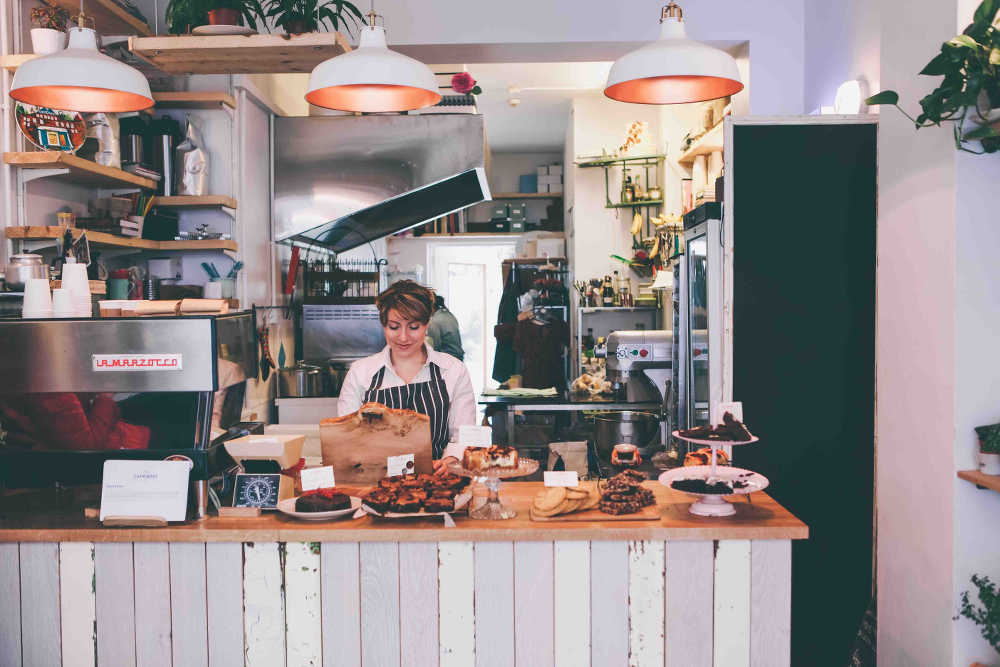
 Camerino Bakery celebrated one year in business on November 1st and, as Dee Laffan discovered when talking to the lady behind the baked treat emporium on Capel Street, Dublin 1 about her success, her love of baking is surpassed only by her love of Ireland.
Camerino Bakery celebrated one year in business on November 1st and, as Dee Laffan discovered when talking to the lady behind the baked treat emporium on Capel Street, Dublin 1 about her success, her love of baking is surpassed only by her love of Ireland.
Admittedly, I am favourably biased towards the person and products in this month’s column. Caryna’s Raspberry Cheesecake Brownies are by far the best in Dublin; I have a slight addiction in that I cannot pass the bakery without nipping in to have one!
Caryna has been baking now for 10 years, her wholesale baking business, under the name Caryna’s Cakes, has been a great success. She is currently stocked in 27 places in Dublin including Clement & Pekoe on South William Street and Nick’s Coffee in Ranelagh. She also holds regular baking workshops for private groups, makes bespoke occasion cakes, is a long-time stall holder at Dublin Food Co-Op and other markets.
The aforementioned Raspberry Chocolate Brownies were awarded Gold in Blas na hÉireann 2014 and she was shortlisted for The Irish Times Best Shops 2015, the only shop on the northside of Dublin city to be included. This girl is on a roll!
However, Caryna’s story of how she came to live in Ireland and how her business came about is definitely an interesting and slightly unconventional one.
“I graduated in Communication Studies from university in Montreal and started a backpacking trip through Europe,” Caryna recalled. “The plan was that I was supposed to go home after the trip and be a grown-up! We travelled through England, Scotland and Wales and then the plans was for two days in Ireland and proceed to Portugal and Spain… I’m now in Ireland 12 years!”
“I worked as a temporary administrator in an engineering company and the week I started someone resigned from that department. The result was they offered me a permanent job and sponsorship to stay. I worked for four years with them on a working visa. At first the job was really interesting because I was working for a construction company in the middle of a financial boom, so I was really in the heart of it. When the recession hit in 2007, my job in human resources shifted and my main duty was to make people redundant – it was awful! While the job was tough, I couldn’t leave until I had stayed in Ireland long enough to apply for my residency, which I really wanted to do as I had fallen in love with Ireland at this stage and wanted to stay.”
“In order to balance the stress of this day-to-day horrible job of basically making grown men cry when I told them they were losing their job, I started baking as a hobby and stress reliever. The worse the job got the more I was baking! One day I decided to take a stall at a farmers market. There was one on Sundays at the back of the multi-denominational school in Ranelagh. I would bake all day Saturday and sell on the stall all day Sunday. That’s when things really started to change for me.”
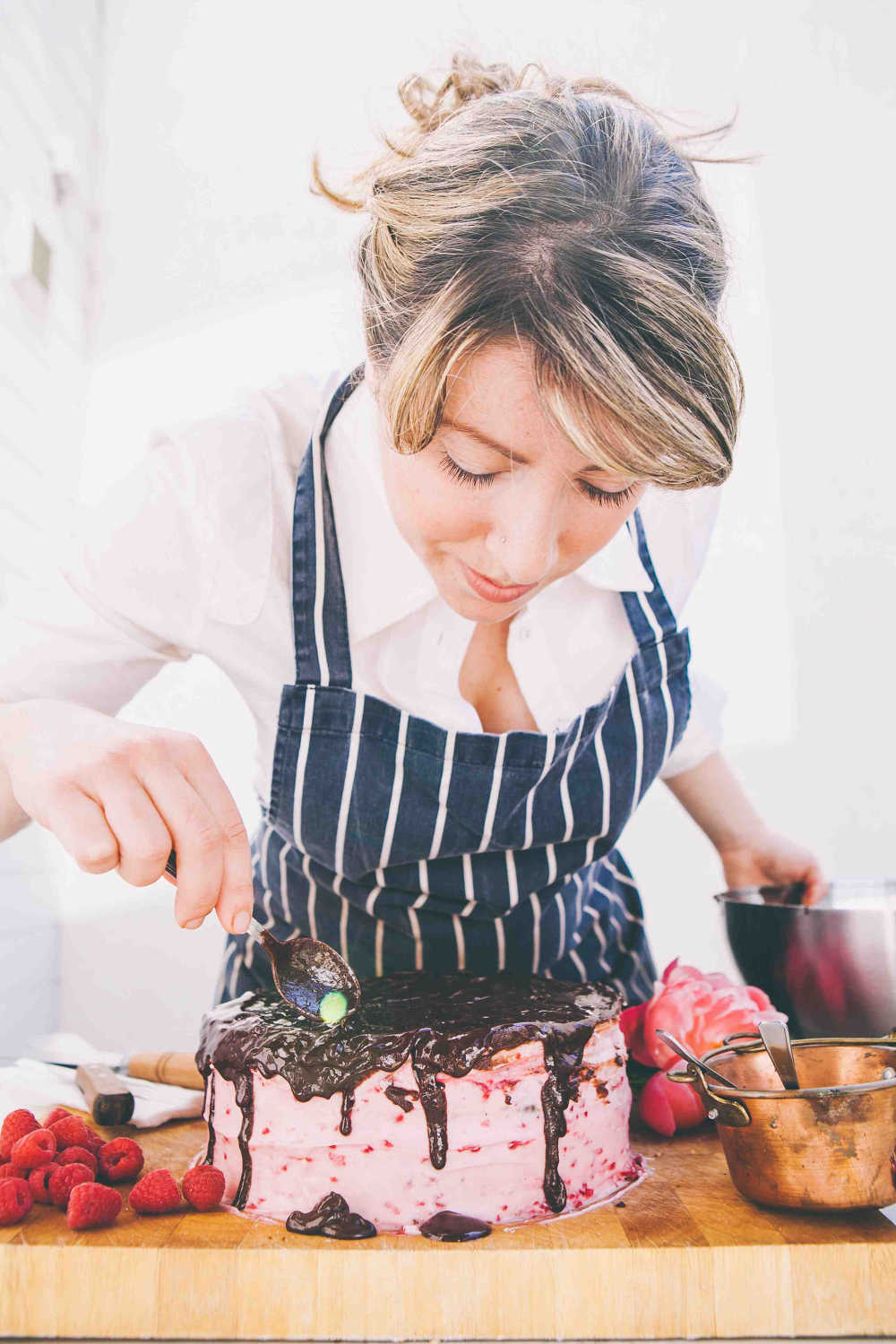 Admitting that she had never really baked before, Caryna was as surprised as anyone that she took to it so quickly and in fact excelled at it.
Admitting that she had never really baked before, Caryna was as surprised as anyone that she took to it so quickly and in fact excelled at it.
“Baking was a massive learning curve that improved the more I baked. I have a very multi-cultural family, mum is from Israel, dad is from Italy, grandmother is from France, grandfather is from Romania and I have a Greek uncle too! At home, food was always really important. We wouldn’t really go out to eat, we would always have family meals and everyone cooked their own traditional foods. Baking, however, was never really very important at home because there weren’t any bakers among us so it wasn’t something I had experience doing.”
For someone who never really had intentions to stay in Ireland, let alone set up a highly successful wholesale baking company and bakery, she has truly seen the hard work pay off.
“My business definitely grew initially because of the amazing people I met from doing the market stall, within the industry, but also regular customers who became friends. For example, Nick’s Coffee in Ranelagh, across the road from the market, had become a regular customer and were the first place I supplied to and I still supply to them today.”
“It was such hard work in the beginning, I found myself doing more and more wholesale work, which meant I was working Monday to Friday in my office job, going home every evening at 5pm and baking until midnight and then get up at 5am and do my deliveries before starting work again at 8.30am. It was a lot of work! But the more I did it, I realized I loved the baking side of my work and hated the human resources side of it, so as soon as I had enough residency to apply for my citizenship, I did and quit my office job and began baking full time.”
Part of Caryna’s success, but also credibility in producing and delivering high quality baking to her customers and their customers, is down to her choice of clients and a commitment to quality.
“I’m very particular about who I supply to because I need to know that they are going to mind the cakes and they are not going to sell them beyond when they are good because they don’t want to make a loss on what they’ve bought. To have suppliers who are not just tempted by the profit side of it, but who care about what they are serving their customers.”
“I always felt that no one would be able to showcase my cakes better or sell them better than me. There were some places that were great, but they just didn’t have the same love of the cakes as I do to really communicate how great they are. I had always been looking for the right place to open my own bakery and I had been building the business in such a way that one day that it was going to have a shop front and window.”
Camerino Bakery is as Caryna describes it a bakery, cakery and coffee shop. The style of her cakes and food is that everything is homemade and of the highest quality.
“We try to source the best ingredients, we never use margarine and as much as we can, we make ourselves, for example, we make our own jam and butter for the scones we sell. We don’t even use stock in our soups, even natural stock. Every morning we bake fresh muffins, scones, bread and challah rolls.”
Challah rolls are Jewish recipe and are one of a few traditional Jewish breads they bake. These rolls are exclusive to Camerino, you can’t get them anywhere else in Dublin. They also use challah bread for their sandwiches on the lunch menu.
“Challah is similar to a brioche, but not as sweet and soggy. I think I decided to bake it because it is part of my heritage and also as it is a really delicious thing that you can’t really get in Dublin and I thought why shouldn’t we have it here? In Montreal, you can get it at all the bakeries and it is the most delicious bread for sandwiches. Plus it is something different.”
Camerino Bakery has a lunch menu with soups, sandwiches and salads, plus a light breakfast menu is available daily. Cookies, brownies, cakes and other treats are available in store also.
Camerino Bakery,158 Capel Street, Dublin 1. www.camerino.ie
For more on Caryna’s workshops and baking, visit: www.carynascakes.com
---
 Dee Laffan is a freelance food writer and editor. Formerly editor of Easy Food magazine, she has written for the Irish Independent and Sunday Independent. She is a proud supporter of Irish producers and their products, and takes part in judging for food competitions including Blas na hÉireann and the Great Taste Awards. She is a member of the Irish Food Writers' Guild and secretary for Slow Food Dublin. Twitter @deelaffan
Dee Laffan is a freelance food writer and editor. Formerly editor of Easy Food magazine, she has written for the Irish Independent and Sunday Independent. She is a proud supporter of Irish producers and their products, and takes part in judging for food competitions including Blas na hÉireann and the Great Taste Awards. She is a member of the Irish Food Writers' Guild and secretary for Slow Food Dublin. Twitter @deelaffan
Cool Beans - Special Irish Foods & The People Who Make Them
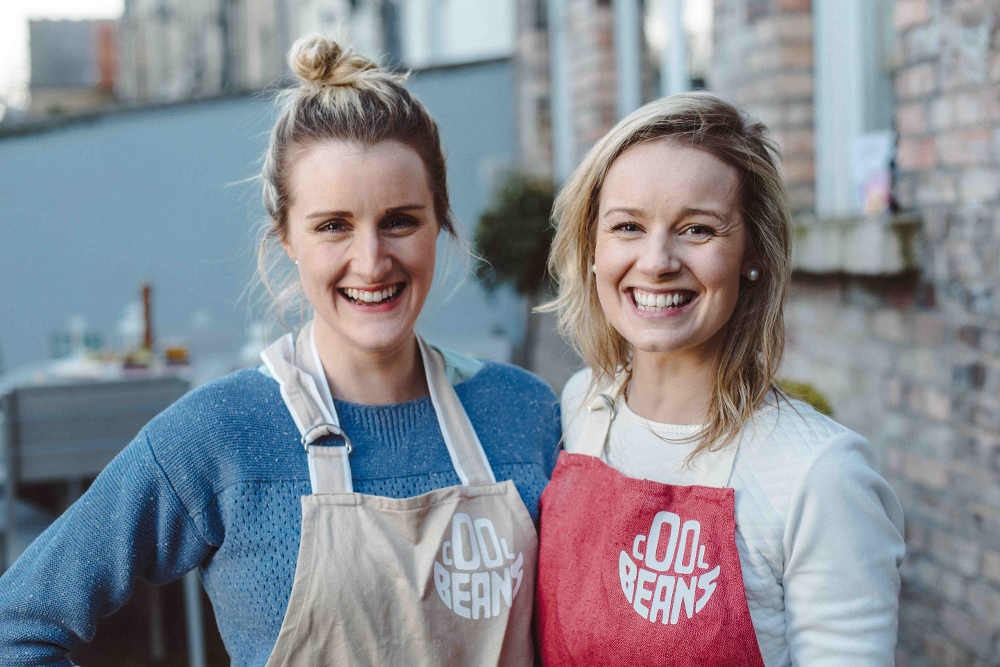
 Dee Laffan chats to the two entrepreneurial women behind Irish food company Cool Beans about their success story, love of beans and their desire to start Ireland’s Bean Revolution!
Dee Laffan chats to the two entrepreneurial women behind Irish food company Cool Beans about their success story, love of beans and their desire to start Ireland’s Bean Revolution!
There’s no doubt that the enthusiasm around food in Ireland has mushroomed in the last couple of years with new start-ups popping up across a broad spectrum of fields – new product development, technology, hospitality, etc. New product development is one of the areas that has given birth to some of the most exciting start-ups with innovative and clever products making their way onto supermarket shelves.
One such product that I came across earlier this year is Cool Beans. As described on the pots, they are ‘Very Fancy Beans’ that are presently available in three flavours – Tomato, Smokey Paprika and Hot Chilli. The funky bright packaging caught my eye in the chilled aisle and upon reading the label I was delighted to see it was made in Ireland, Dublin to be precise. Cool Beans is the lovechild of two friends Sarah O’Connor, from Cork, and Isolde Johnson, from Tipperary.
“Sarah and I were working really long hours and were becoming more and more conscious of the food we were putting in our bodies and our desire to eat healthily, but not having enough time to cook and prepare food in advance,” explained Isolde Johnson, co-founder of Cool Beans.
“When we would both get home at the end of the day around 9pm and go to the local shop to get food, we weren’t inspired by any of the available meals on offer. Everything was full of preservatives or sugars and we really just wanted something healthy and convenient. We both love beans and we had noticed a trend of gourmet beans popping up on brunch menus around Dublin eateries, e.g. Cake Café and Herb Street. We even noticed Gordon Ramsay was selling them in his restaurant for £20! We felt that there was a gap in the market, and supermarket shelves, for a product of that kind.”
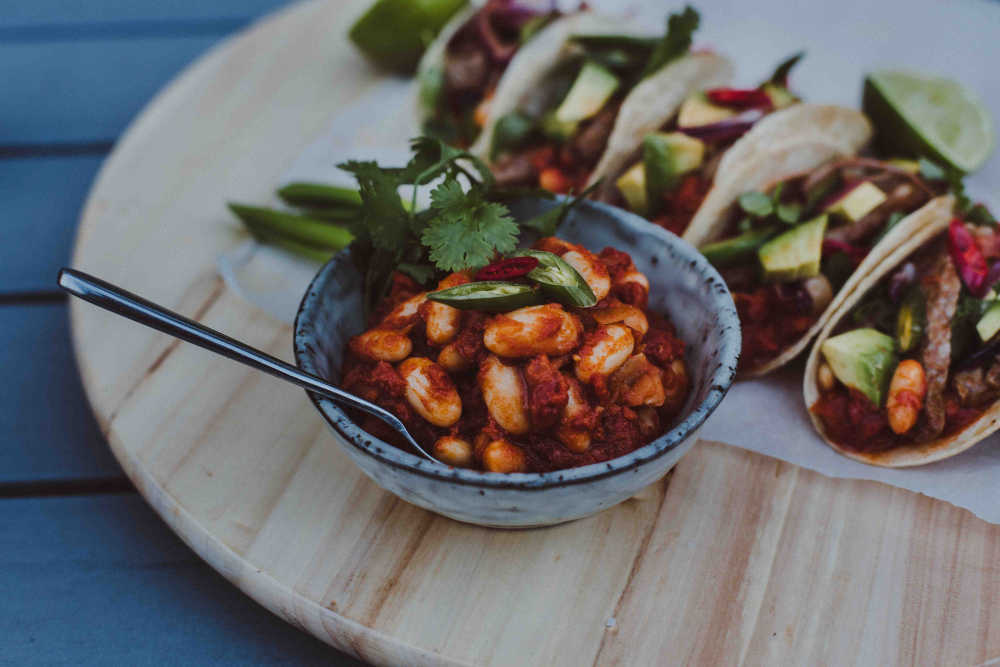 “After identifying this gap in the market, we started doing lots of market research. Beans are really good for you because they are full of protein and soluble fibre, which is really good for your digestive system, and they are proven to lower cholesterol and to help fight against obesity and diseases like cancer. There are so many benefits of eating beans and adding them into your diet, but people just don’t really know what to do with them. What we tried to do with Cool Beans is create an accessible product that people could eat that is really healthy and tasty, but also to get them thinking about adding beans to their diets. We have created a term for it Beaneology, which is about educating people on the benefits of beans.”
“After identifying this gap in the market, we started doing lots of market research. Beans are really good for you because they are full of protein and soluble fibre, which is really good for your digestive system, and they are proven to lower cholesterol and to help fight against obesity and diseases like cancer. There are so many benefits of eating beans and adding them into your diet, but people just don’t really know what to do with them. What we tried to do with Cool Beans is create an accessible product that people could eat that is really healthy and tasty, but also to get them thinking about adding beans to their diets. We have created a term for it Beaneology, which is about educating people on the benefits of beans.”
“Unfortunately we can’t get Irish grown cannellini beans. We try to use as many Irish ingredients as possible, but the beans, chilli flakes and spices come from abroad. When we were sourcing beans, which we get from Italy, we realised there is a massive variation between price and quality and we tried lots of different combinations, but we are really happy with our supplier at the moment. The beans are very high quality and give amazing flavour and texture to the product.”
Sarah and Isolde both come from business backgrounds. In their former jobs, Sarah managed the Ernst Young Entrepreneur of the Year programme and Isolde worked for an investment company that specialised in the food sector, which meant doing research into the food industry in Ireland, UK and across Europe and the various trends that were coming up. It is obvious speaking to the girls, who are so full of fun and enthusiasm, that is their passion of food that has quickly turned them into ambitious food entrepreneurs.
“We’re not trained chefs,” expressed Sarah. “But we do love food and we’ve both cooked all our lives. When we came up with our idea, we tested it hundreds of times until we got recipes and flavours that we felt really worked.”
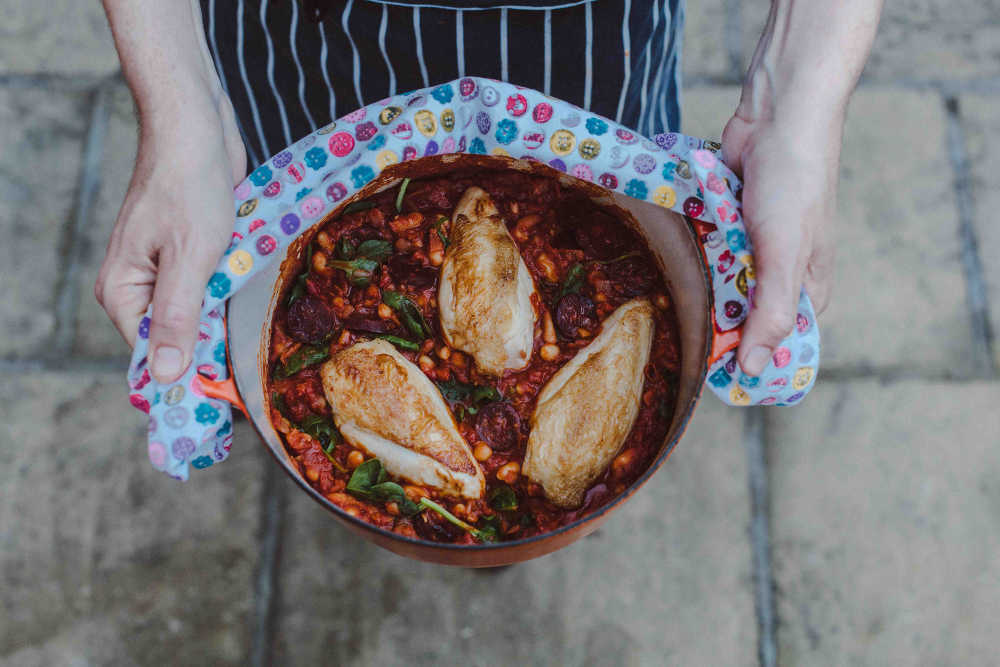 “We initially wanted to trial the product so we pooled all our savings together and bought a mobile catering unit called The Bean Machine. It was tiny! We brought it around the Irish music festivals, e.g. Body&Soul and Electric Picnic and got brilliant feedback. People are very honest, especially at 4am when they are hungry after a few pints! After that, we made the product gluten free. We took out ingredients like Worcestershire Sauce and we also replaced sugar with honey because, again, people are so conscious of refined sugars. We really cleaned up the ingredients list and changed some of the flavour profiles. We were then eager to take it from there onto the supermarket shelves as a retail product.”
“We initially wanted to trial the product so we pooled all our savings together and bought a mobile catering unit called The Bean Machine. It was tiny! We brought it around the Irish music festivals, e.g. Body&Soul and Electric Picnic and got brilliant feedback. People are very honest, especially at 4am when they are hungry after a few pints! After that, we made the product gluten free. We took out ingredients like Worcestershire Sauce and we also replaced sugar with honey because, again, people are so conscious of refined sugars. We really cleaned up the ingredients list and changed some of the flavour profiles. We were then eager to take it from there onto the supermarket shelves as a retail product.”
“At this point, we were both still working full time and using all our spare time and annual leave to work on Cool Beans. We were wrecked, Sarah admits honestly. “Something had to give, so Isolde quit her job and joined the business full time. People thought we were nuts starting a baked bean company, so we stopped telling people what we were doing!”
“Our whole ambition is to do what Cully & Sully did for soup, to take it out of the ambient, tinned aisle in the supermarket and on to the fresh chilled aisle. They’ve actually been amazing to us. We contacted them and they asked us to come down and spend a day with them going through everything. We spent time in their kitchen working with their development chef Ivan, who is so nice and helpful, it was incredible. We can’t thank them enough for the support.”
As mentioned already, it was the unique and fun branding of Cool Beans that made it stand out on the shelf and peak my attention. The branding is thoughtful and you get a sense of the producers’ personalities and story before you even get a taste!
“We knew early on that we were going to have to invest a lot in the branding,” said Isolde. “It is such an important part of the whole product and we did so many focus groups on the various elements, so much research went into it. We knew we wanted the product to be a reflection of us and our ethos and values and the finished branding is amazing – we still love it so much!”
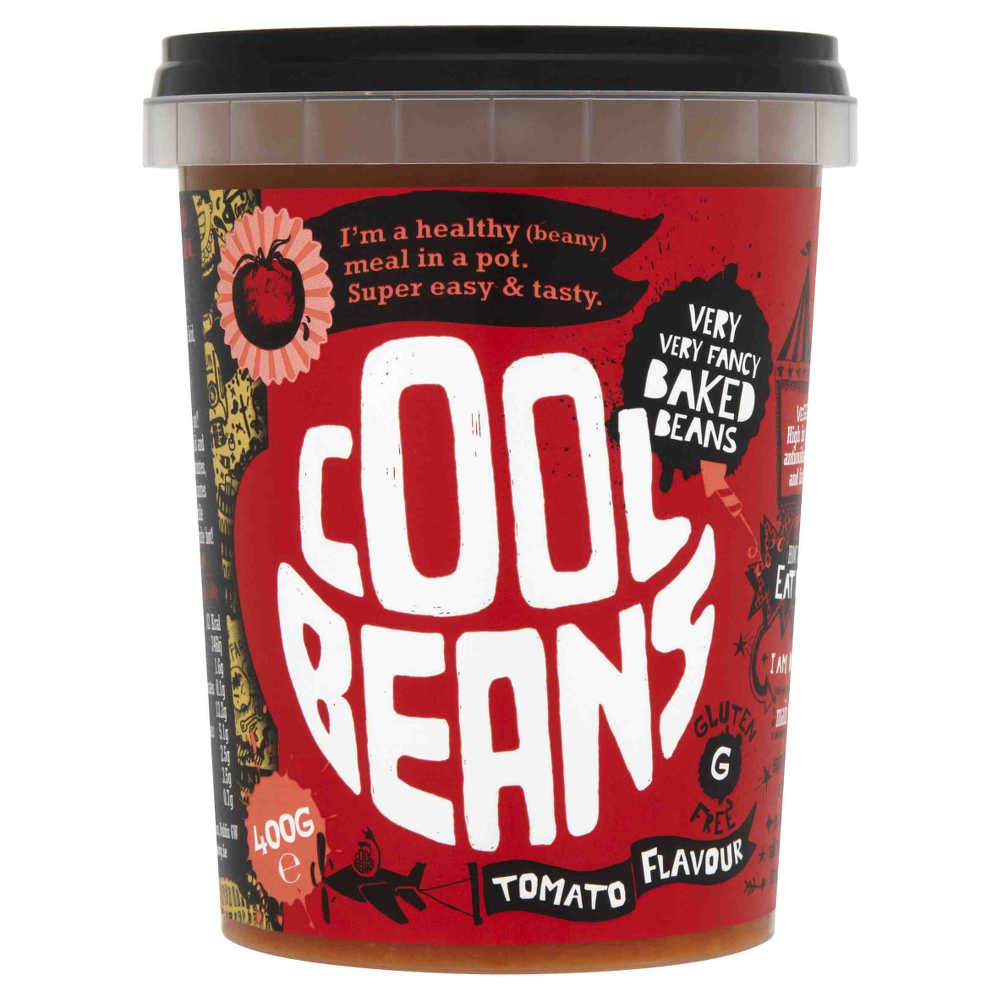
“Our heart and soul went into the branding, even in terms of the tone of voice and the animations/illustrations on the packs. The latter are so great because a friend did them for us. We sat down with her and told her our entire story, the highs and lows, the people who have helped us… We poured our hearts out to her! She then created animations for all of that, even the people we mentioned are represented on there. It’s literally our story!”
So what’s next? Sarah has just joined the business full time also so now both girls are fully committed to making Cool Beans a global revolution.
“2016 is the International Year of the Pulse, so we have created a hashtag around that #beanrevolution and we are setting up the Irish committee for the International Year of the Pulse, which we hope to chair and organise some great events. We’ve been talking to the guys in New York who organised it to see how we can start the bean revolution in Ireland and convert everyone!”
“We’re also always working on new flavours and there are many in the works, but we want to wait and see what comes out best in testing and focus groups. We do have a lemon, basil and garlic bean hummus in development at the moment that we are excited about. It has 100 calories less than normal hummus.”
Cool Beans has just launched in Waitrose stores throughout the UK a few weeks ago and is available in Ireland in SuperValu nationwide. Plus, you can find it in some independent food shops.
For more information, visit: www.coolbeans.ie
---
 Dee Laffan is a freelance food writer and editor. Formerly editor of Easy Food magazine, she has written for the Irish Independent and Sunday Independent. She is a proud supporter of Irish producers and their products, and takes part in judging for food competitions including Blas na hÉireann and the Great Taste Awards. She is a member of the Irish Food Writers' Guild and secretary for Slow Food Dublin. Twitter @deelaffan
Dee Laffan is a freelance food writer and editor. Formerly editor of Easy Food magazine, she has written for the Irish Independent and Sunday Independent. She is a proud supporter of Irish producers and their products, and takes part in judging for food competitions including Blas na hÉireann and the Great Taste Awards. She is a member of the Irish Food Writers' Guild and secretary for Slow Food Dublin. Twitter @deelaffan
Abernethy Butter - Special Irish Foods & The People Who Make Them
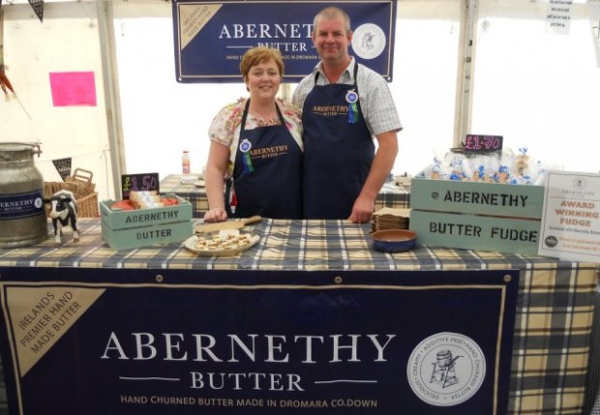

Abernethy Butter is one of the great recent success stories of Northern Ireland’s artisan food revival.
Since turning their hand-churned butter making hobby into a business in 2005, and initially selling at markets, Will and Allison Abernethy’s delicious and handsomely presented products are now on sale at some very prestigious shops indeed (including Fortnum and Mason, in London) and they have the distinction of being offered at Heston Blumenthal’s Fat Duck Restaurant in Berkshire and Marcus Wareing in Knightsbridge, as well as many of the best tables in Ireland including our Restaurant of the Year, James Street South in Belfast. (Full list here)
Will and Allison’s company at Dromara, Co Down, is the only one in Northern Ireland producing hand made butter and, while it is the result of a lot of hard work and skill, it is a beautifully simple product, containing nothing but fresh cream and salt - except the speciality dulse and smoked butters, which are naturally flavoured. The cream is supplied by the pasture-grazing cows of a local farmer in the Lagan valley, who pasteurises his own milk.
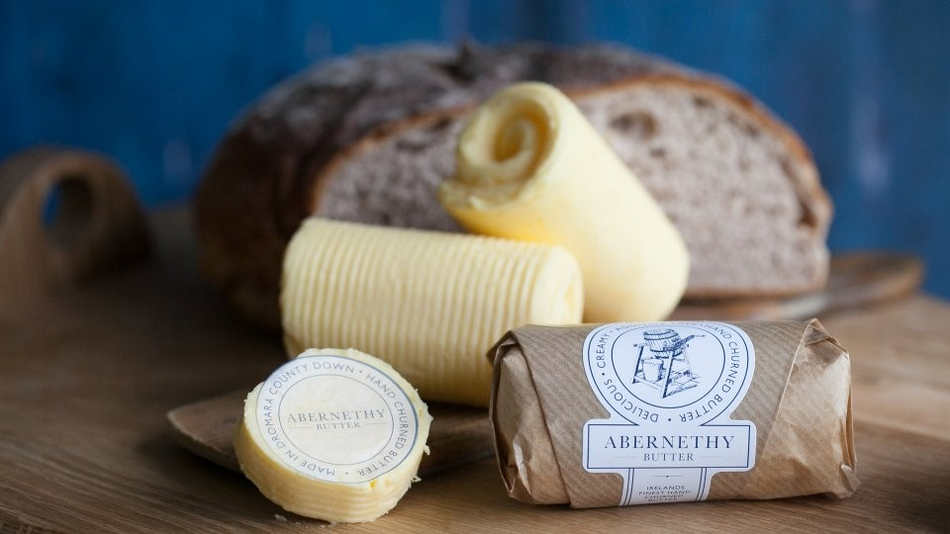
The cream is churned in the traditional way to separate the butter from the buttermilk, rinsed by hand to remove any remaining buttermilk, lightly salted and then patted into shape by hand. Simple as it is, there is great interest in this process, which was until recently a part of everyday life on every farm, and the Abernethys are available to do demonstrations at shows or other events (a small fee is charged).
Their beautiful creamy butter is also beautifully packaged, in rustic greaseproof and brown paper - and you will spot their distinctive little blue and white greaseproof disc on butter dishes in good restaurants around the province, and in specialist shops throughout Ireland and the UK. (list of outlets here).
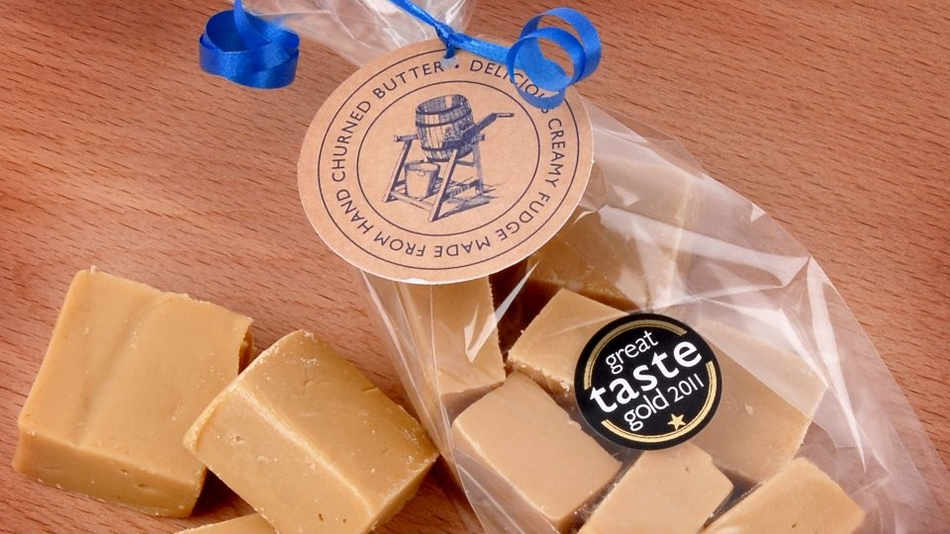 In addition to the butter (which has a shelf life of 12 weeks and can be frozen if required), Will and Allison use their butter to make their delicious Abernethy Butter Fudge and Brandy Butter, a seasonal product that keeps for six months.
In addition to the butter (which has a shelf life of 12 weeks and can be frozen if required), Will and Allison use their butter to make their delicious Abernethy Butter Fudge and Brandy Butter, a seasonal product that keeps for six months.
The butters, fudge and the newer Sea Salted Caramel (made with their butter by En Place Foods in Cookstown, Co Tyrone) are also available online, along with butter dishes and traditional butter pats (buy here)
Wonderful foods, made with heart and soul - the Arbernethy products have gained well earned recognition at the Great Taste Awards and are a real credit to the region.
Punjana Tea - Special Irish Foods & The People Who Make Them
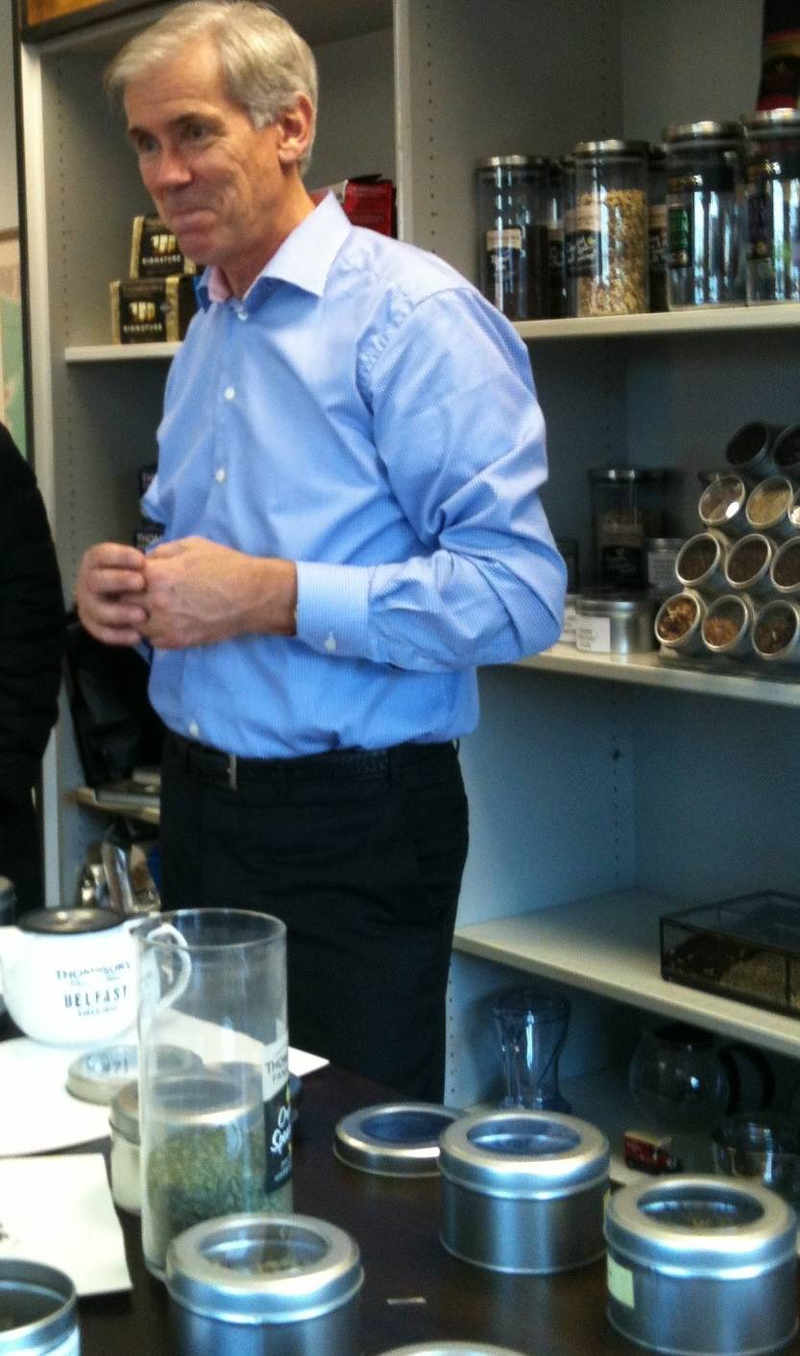

Georgina Campbell
Ask anyone in Northern Ireland about Punjana Tea and you’ll be in no doubt that you’ve touched on something central to the culture - even people who never drink tea (and there aren’t too many of those) will probably break into the famous jingle that goes back decades and crosses several generation gaps.
Although set up in fine modern premises in East Belfast since 1995, the company actually goes back a century earlier when it was established in the docklands by Robert Thompson, grandfather of brothers Ross and David Thompson who run it today - and it was their mother, Lillias, who came up with the name Punjana in 1949.
So what makes it so special? There’s the family ethos for a start - the ‘tea tasting gene’ is good and strong and their enthusiasm and passion for quality is infectious. Just listening to Ross and David talking animatedly about the best tea gardens, their own favourite products and their pride in the Gold Stars they’ve won in the Great Taste Awards is inspiring … And then there’s their mission, “to create the ‘Perfect Everyday Cuppa’ a tea that has superior taste and flavour whilst representing great value for money”, which pretty much says it all.
Emphatically not just a ‘budget tea’, this ethically sourced blend of the finest Assam and Kenyan teas is expertly selected with the aim of giving ‘real depth of flavour whilst displaying a bright refreshing cup’. And it does what it says on the tin.

Northern Ireland tea drinkers vote with their shopping lists, and there’s no doubt that the Thompsons themselves believe passionately in their product. But it’s always gratifying to get an independent endorsement and well-earned recognition has come from the Guild of Fine Foods’ Great Taste Awards over several years, notably 2014 when they achieved 2 Gold Stars - and not just for the Punjana blend, but also two other teas from the Thompson Family’s Teas range, the Signature and Breakfast blends. (I discovered the Signature range for myself at the UK Guild of Food Writers’ Awards last June, and very nice it is too; Thompsons sponsored the 2015 Restaurant Reviewer of the Year Award, won by Marina O’Loughlin of The Guardian Weekend Magazine, and we all got a lovely tin of Thompson’s Signature tea to take home.)
The number and diversity of teas produced by Thompson Family’s Teas may surprise fans of the original Punjana blend, impressive as that is (and available as loose tea as well as the ubiquitous tea bag - which, of course, is preferred by the vast majority of customers).
The Irish Breakfast Blend and Titanic Tea are understandably popular too, also a Decaf tea and the intriguing Scottish Soft Water blend that’s successfully produced specifically to suit a particular market and its local conditions. Curiously, though, a mysterious twist to the ‘local water’ story emerged from the Great Taste Award judging, which took place in a number of areas - with different types of water - and yet came out with the same consistently high marks…very interesting.
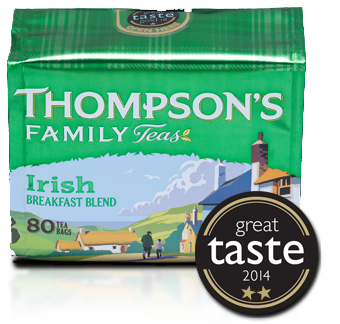 Other products in the range include speciality flavoured teas like Jasmine and Earl Grey, flavoured with flowers; green teas (which go through a different drying process from the regular black teas and should not be made with fully boiling water, which is too hot and will scorch the leaves); and ‘teas’ that are not teas at all, but tisanes, like peppermint tea and the exotic sounding Turkish Apple Tea which is made with apple and blackberry leaves, and was a One Gold Star winner in the 2014 Great Taste Awards.
Other products in the range include speciality flavoured teas like Jasmine and Earl Grey, flavoured with flowers; green teas (which go through a different drying process from the regular black teas and should not be made with fully boiling water, which is too hot and will scorch the leaves); and ‘teas’ that are not teas at all, but tisanes, like peppermint tea and the exotic sounding Turkish Apple Tea which is made with apple and blackberry leaves, and was a One Gold Star winner in the 2014 Great Taste Awards.
It is no secret that the Thompson brothers are purists and their personal preference lies with the traditional black - and, of course, loose leaf - teas, but another USP at Thompson Family’s Teas is that they’re highly sensitive to the voice of the market, so development of new products is undertaken with the same quality-conscious enthusiasm that they devote to their favourite blends. No wonder this reassuringly youthful centenarian brand is fast finding international popularity, and, just to put that in context, over 100,000 cups of Punjana tea are now enjoyed every hour…day and night! .
Today, not only are Thompson Family teas widely available in England, but their teas - and other products, including the coveted teapots that make loose leaf teas so much more desirable, especially to younger tea lovers - are available from their excellent and highly educational website, http://punjana.com
Bushmills Whiskey
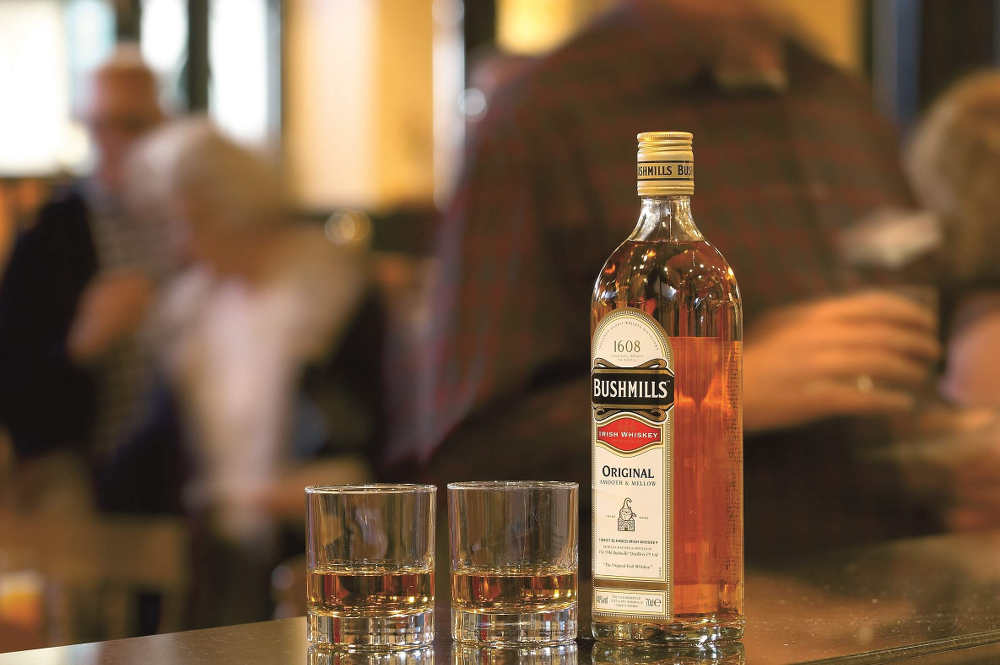
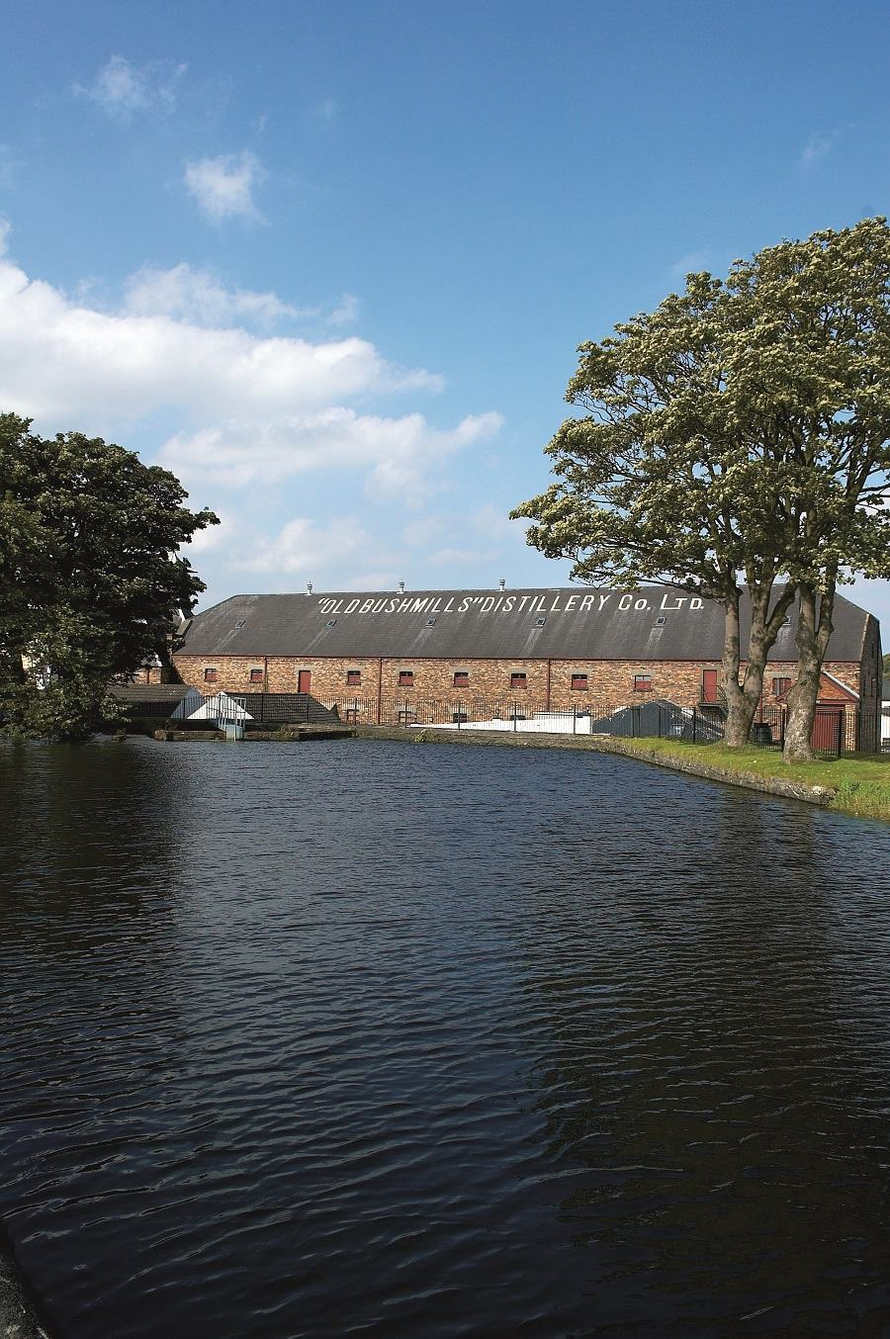 Marking the third month of Northern Ireland’s Year of Food and Drink 2016, we salute one of the region’s most iconic brands, Bushmills Whiskey - a product that seems to sit happily in almost any month of the celebratory calendar, being equally at home with February’s ‘Love Local’ theme, the ‘Heritage and Traditions’ focus for March - or of course ‘Brewing & Distilling’ which follows in April.
Marking the third month of Northern Ireland’s Year of Food and Drink 2016, we salute one of the region’s most iconic brands, Bushmills Whiskey - a product that seems to sit happily in almost any month of the celebratory calendar, being equally at home with February’s ‘Love Local’ theme, the ‘Heritage and Traditions’ focus for March - or of course ‘Brewing & Distilling’ which follows in April.
Located on the beautiful Causeway Coast, in the little town of Bushmills on the River Bush, the aptly named Old Bushmills Distillery lays claim to being the oldest licensed distillery in the world. With a history dating back to 1608, when the original grant to distill was signed in by King James 1st, it is unarguable old, and - although there have been numerous changes of ownership - there has been distillation on the site ever since, always using their own water from Saint Columb's Rill (a tributary of the Bush), and Irish barley.
In recent decades The Old Bushmills Distillery (http://www.bushmills.com) has been owned by drinks giants: Irish Distillers, Pernod Ricard, Diageo and, currently, Jose Cuervo, the world’s biggest tequila manufacturer - which, despite its size, is a family business and regarded as a safe pair of hands for this historic gem.
Bushmills claims to be the only distillery in Ireland making triple-distilled single malt whiskey, a proud tradition that creates its ‘unique combination of smoothness and richness’. There are currently five whiskeys in the portfolio: Bushmills Original (aka ‘White Bush), Black Bush, Bushmills 10 Year Single Malt, Bushmills 16 Year Single Malt and Bushmills 21 Year Single Malt.
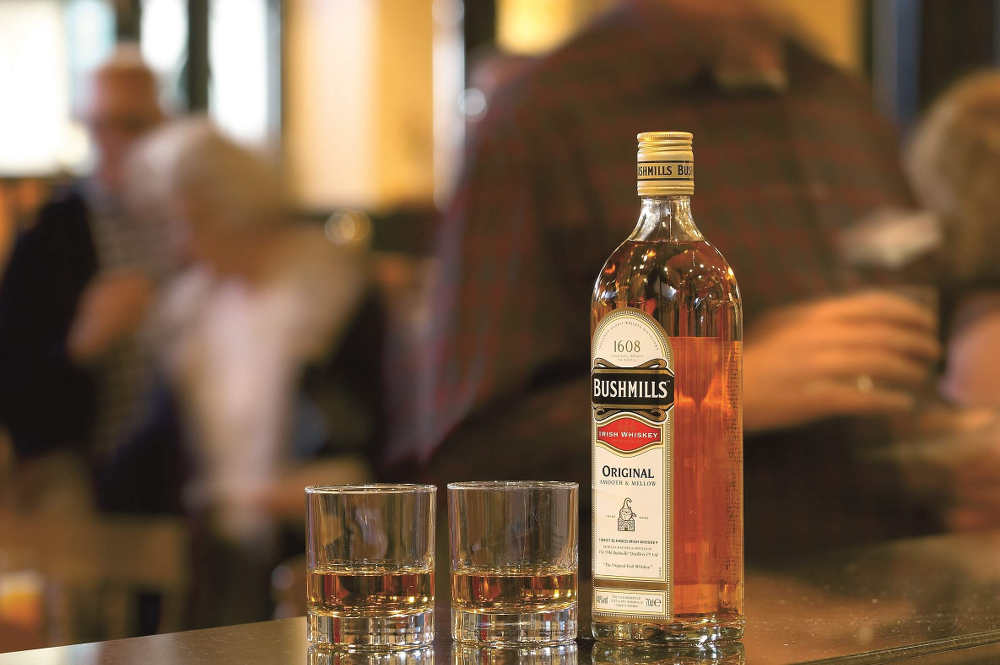
In addition, exclusively for visitors to Bushmills, Distillery Reserve is a 12 Year Single Malt available to taste and buy only from the Distillery (where the label can be personalised). Otherwise the range of whiskeys is widely available, and can also be bought online (UK and Ireland) at mail.order.bushmills@bushmills.com.
Tours of the working distillery (not just a visitor centre) are offered, with time to admire the copper pot stills, hear all about passion and dedication that producing fine whiskey inspires, the production process and casks, ‘the angel’s share’ (the alcohol which evaporates from the casks during maturation) and the differences between the various whiskeys produced - and, saving the best bit until last, the tour ends with a whiskey (or a soft drink) in the 1608 Bar. Tutored whiskey tastings are available too, and there’s a specialist whiskey shop, a gift shop and a restaurant serving lunches.
Mairead Finnegan, Roll It Pastry - Special Irish Foods & The People Who Make Them
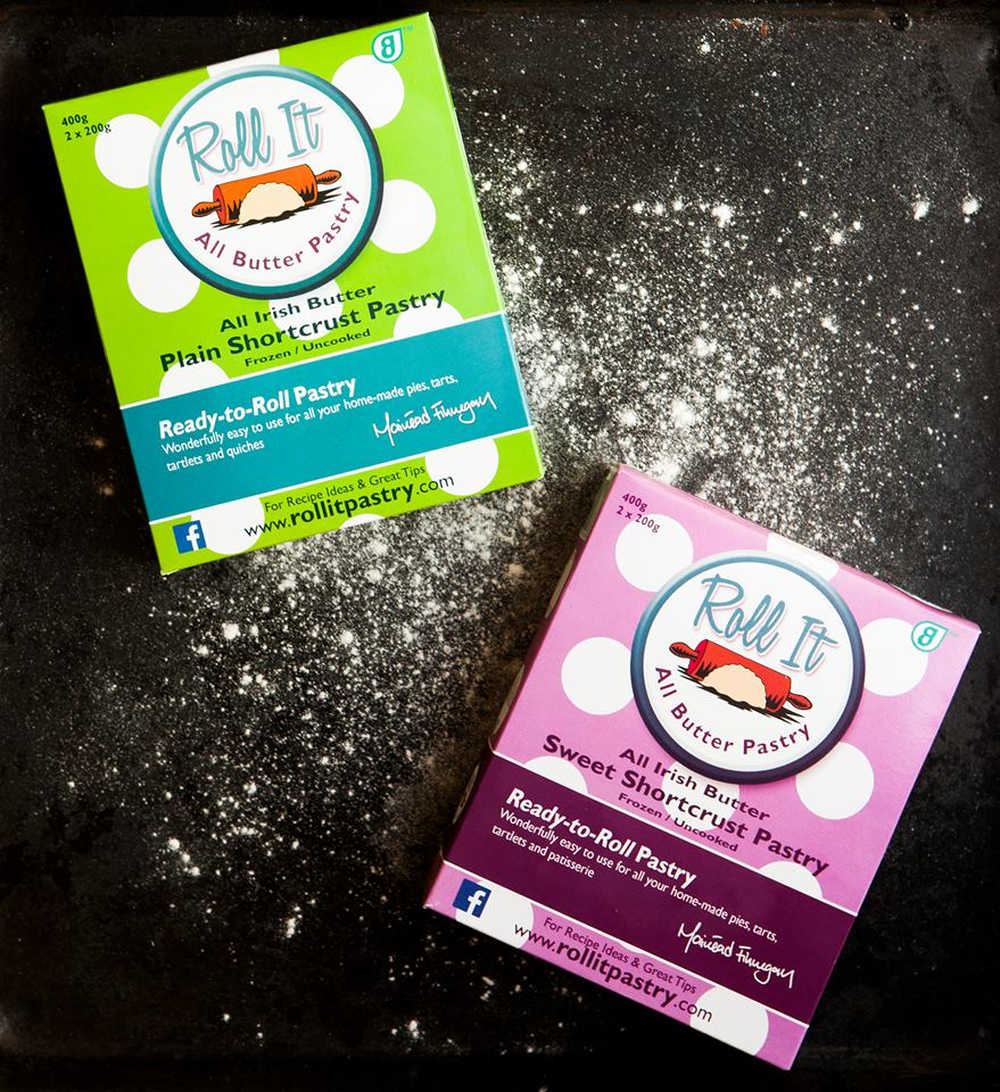
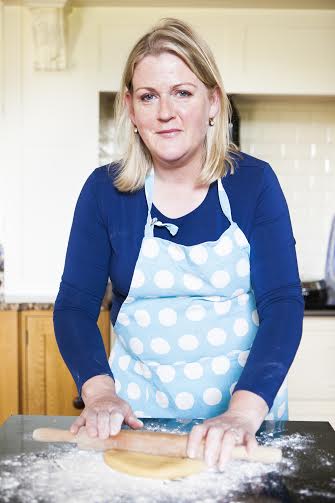 Dee Laffan talks to the woman behind the all-butter convenience pastry, which is made in Co Meath
Dee Laffan talks to the woman behind the all-butter convenience pastry, which is made in Co Meath
Learning to make pastry is one of my earliest food memories. Standing on a chair to reach the kitchen counter, my sister would let me help rub the butter into the flour or roll the dough out, spreading it across the surface. The aroma of the baking in the kitchen would drive your excitement and the anticipation of eating the treat inside the oven.
Freshly baked pastry tastes delicious, regardless of what you put on it, under it or wrap it around. It can be a rhubarb tart (my favourite) or a quiche lorraine… the main key to success with these simple delicious dishes is the pastry.
Times have changed. Time has changed. We all seem to be short on time. It is the biggest enemy of home cooking and baking and often time wins. Hence, shortcuts have been made and ready-made solutions are contemporary ingredients for home baking. There are many brands of ready-made pastry, but none has impressed me as much as Roll It Pastry.
Roll It Pastry is an all-butter, ready-made, frozen shortcrust pastry created by Mairead Finnegan. Mairead says that the idea for the business came from her love of baking and a lack of availability of good-quality product.
“I was working as a property manager in Dublin when I came up with the idea for the business, explained Mairead. “I was always very into cooking and anything to do with food. I remember it was around Christmas time four years ago and I wanted to make beef wellington. I couldn’t find any decent whole butter pastry in the shops. I tried in a lot of places and couldn’t find anything and even then it was limited in quality as to what was available.”
“I decided to teach myself how to make puff pastry and that led onto learning the other pastries too. I noticed there was no Irish pastry on the market and only a limited amount of butter pastry. Even though all the cookbooks and TV shows tell consumers to make sure it’s a butter pastry they buy, it was hard to get.”
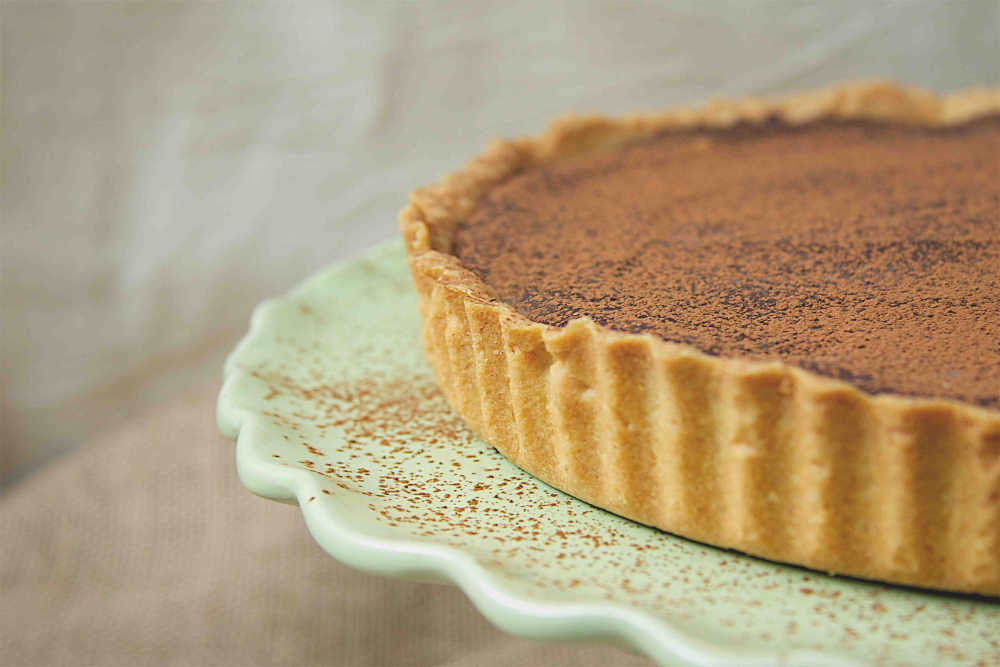 What sets Roll It Pastry apart is that it is such good quality that it tastes homemade. You could definitely pull the wool over your dinner guests’ eyes by hiding the packet and passing it off as one you made earlier! The quality is down to Mairead’s strict ethos on ingredients and method.
What sets Roll It Pastry apart is that it is such good quality that it tastes homemade. You could definitely pull the wool over your dinner guests’ eyes by hiding the packet and passing it off as one you made earlier! The quality is down to Mairead’s strict ethos on ingredients and method.
“What makes it special is that it is made from real butter. I make it all in relatively small batches and there are no preservatives in it, which is why it is frozen. I do this to give it a nice homemade quality rather than the mass-produced types that don’t taste of anything. I use free-range eggs and good quality flour and a lot of the process is done by hand and that’s what makes it unique.”
“When I started off in my home kitchen I was still working at the time. Because I worked in property, I was going from contract to contract so I knew I ought to look for something else. I did a few food fairs and farmers markets with the first batches and I got great feedback and it sort of took off from there. That was over three years ago now and I haven’t looked back.”
“We live in the country and we have plenty of space here including a big garage space at the back, which I have converted into a commercial kitchen. I got some funding from LEADER and LEO to help with that and have invested in some commercial equipment, like large commercial mixers, but a lot of it is still done by hand. There is no production line or anything like that. It is very much a hands-on process and a lot of work in it. While it is just me normally, I need someone on stand by to help at busy times.”
However, things are about to change for Mairead as she is extending the range to include a puff pastry and a gluten-free option. This means she will be employing someone to help with production.
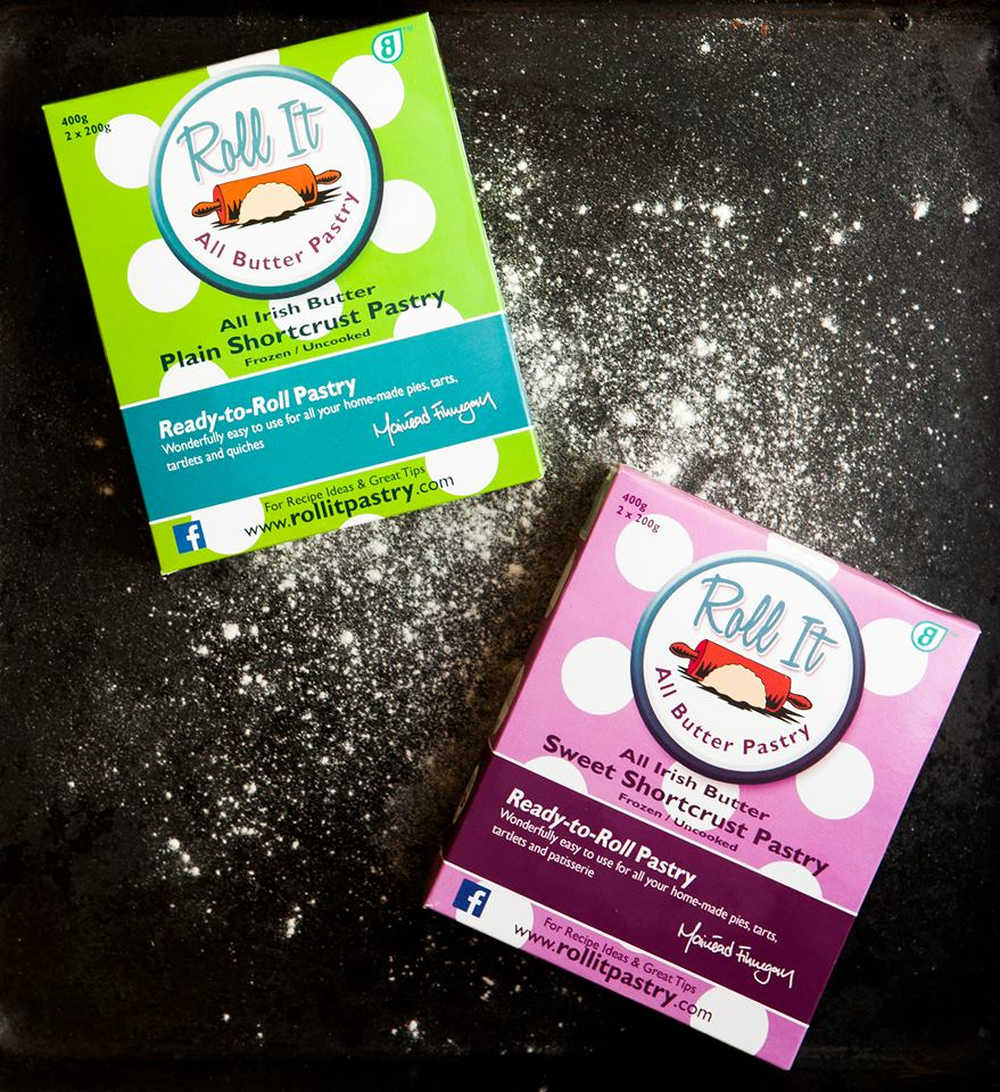
“I got some funding from LEADER recently for a large pastry machine that does a lot of the folding needed to make puff pastry. It will help speed things up as it takes some of the work out of it for me, but there are still lots of parts that I will need to do by hand. I also invested in some more big freezers and fridges for production and storage.”
I’ve outsourced the production of the gluten-free pastry to a bakery in Cork. So many people have asked me for it, so I decided to do it. I can’t make it in my kitchen because of the health and safety issues; it has to be a separate premises. I’ve picked someone who I knew would uphold my own standards and quality and who I admire myself. There is a demand for this pastry as no one else is doing it, so that’s the reason for it.”
Mairead’s pastry has already gained recognition and not just from consumers, as it has won awards from the Irish Quality Food Awards, the Great Taste Awards and Blás na hÉireann (the National Irish Food Awards).
With the new developments in her range and taking on staff, there will be busy times ahead and, no doubt, more success.
“With expanding the business, I have to make sure that I can remain as hands-on as possible to ensure quality. The whole basis of my business is the quality and I have to be able to maintain that at all costs.”
Visit: www.rollitpastry.com for more information and stockists.
-----

Dee Laffan is a freelance food writer and editor. Formerly editor of Easy Food magazine, she has written for the Irish Independent and Sunday Independent. She is a proud supporter of Irish producers and their products, and takes part in judging for food competitions including Blas na hÉireann and the Great Taste Awards. She is a member of the Irish Food Writers' Guild and secretary for Slow Food Dublin. Twitter @deelaffan
Tipperary Food Producers - Special Irish Foods & Drinks & The People Who Make Them
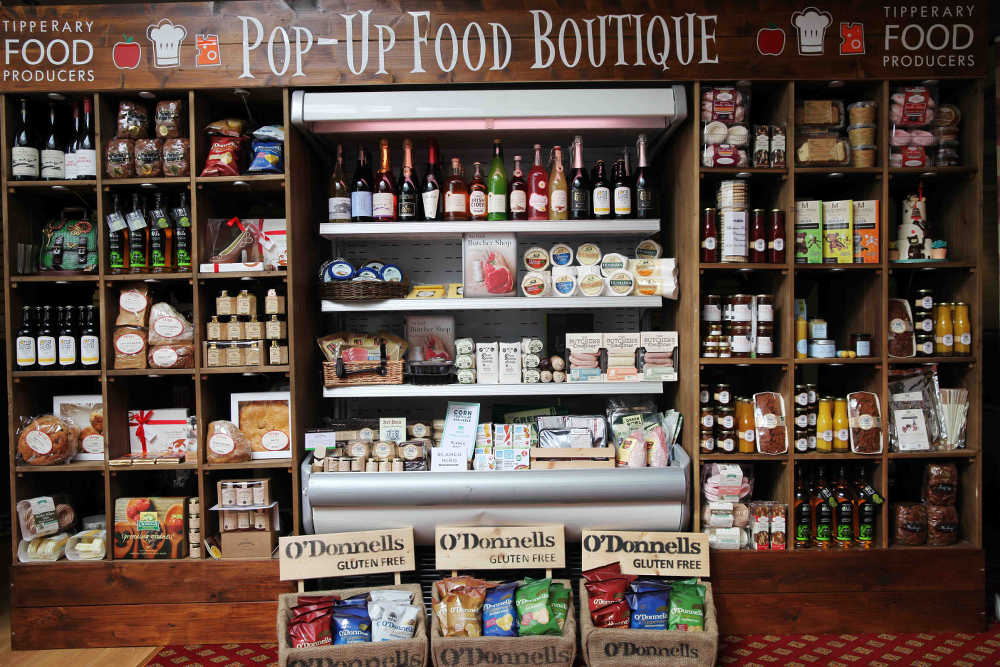
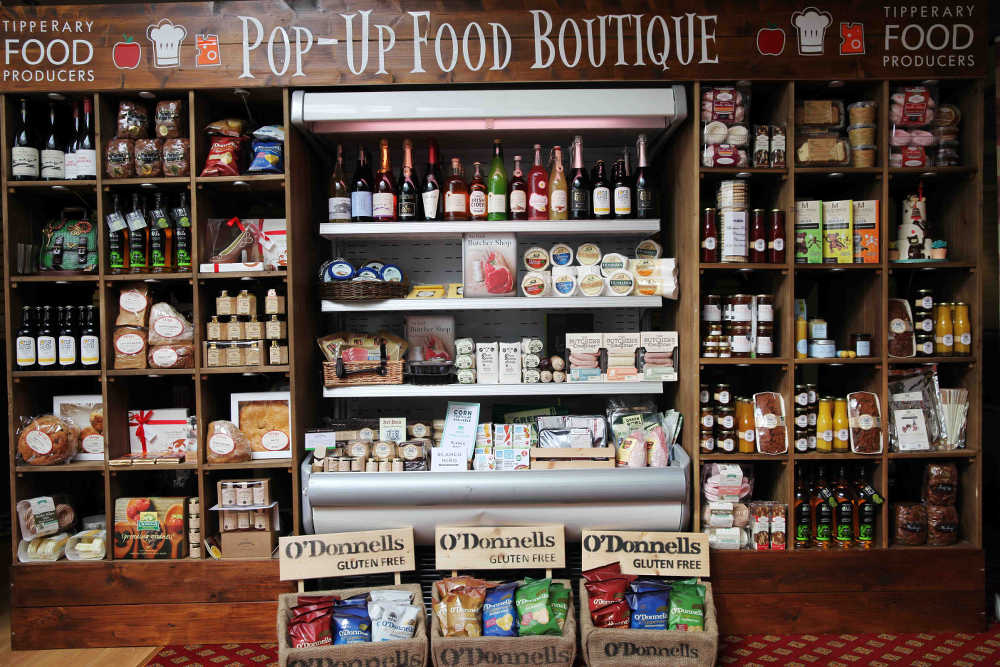
Dee Laffan speaks about Networking Success with Pat Whelan, chairman of Tipperary Food Producers and winner of the Supreme Champion title at the 2015 Great Taste Awards
Community networks are commonplace in Ireland but, more recently, food networks have become more prevalent. One such network is the Tipperary Food Producers and, as they hosted the recent, prestigious, Great Taste Awards in Hotel Minella, Clonmel, it is clear that their efforts are being noticed not just at home but also abroad.
Meitheal is an ancient Irish tradition of a group coming together for a common purpose, working together and for each other to ensure that all succeed in achieving their goal. It is the Irish word for a work team, gang or party and denotes the co-operative labour system in Ireland where groups of neighbours help each other in turn with farming work, such as harvesting crops. At the heart of the concept is community unity through cooperative work and mutually reciprocal support. Meitheal is the Irish expression of the ancient and universal appliance of cooperation to social need.
Meitheal sums up in one word the aims and means of the Tipperary Food Producers, a community of businesses working in the food and beverage sector in County Tipperary. Their 30 current members cover a range of products including preserves, bakery, meat, fruit and vegetables, dairy and sweets and crisps. Some well known brands include Crossogue Preserves, O’Donnell Crisps, Cashel Irish Farmhouse Cheesemakers, Crowe’s Farm and Irish Piedmontese Beef.

“All our members work to extremely high quality standards with many of our members producing for the ‘Specialty Foods, Organic Foods and/or Slow Food’ sector,” according to Pat Whelan (pictured right), chair of the Network.
“We really want the public simply to consider buying food produced in Tipperary, visiting the local baker, butcher, farm shops, cheese monger, retailers and farmers market. With the natural linkages that the food sector have with the social, economic, tourism and cultural aspects of life in Tipperary, our network is keen to develop further into a regional brand that will highlight what Tipperary Food has to offer.”
The spirit of Meitheal was seen to be very much alive and well during the week of the Great Taste Awards in Clonmel, where the Network welcomed the Guild of Fine Food and a host of Irish and international judges with a series of special events.
This followed the success of Clonmel’s own James Whelan Butchers, who won the title of Supreme Champion for their Beef Dripping at last year Great Taste Awards, leading the Guild of Fine Food to take their show on the road and, for the first time ever, hold the Irish judging process in County Tipperary.
Pat Whelan’s passion for the area and his enthusiasm for having the opportunity to introduce these important international opinion-makers to the best of his home county was a major factor in the decision to bring the Great Taste Awards judging roadshow to Tipperary this year.
Welcoming food experts such as Charles Campion, BBC Radio 2’s Nigel Barden and many of the best chefs, buyers, restaurateurs and writers in the business, the Great Taste roadshow was given a true taste of Tipperary and a genuine sense of Ireland’s impressive and diverse food and drink producers.
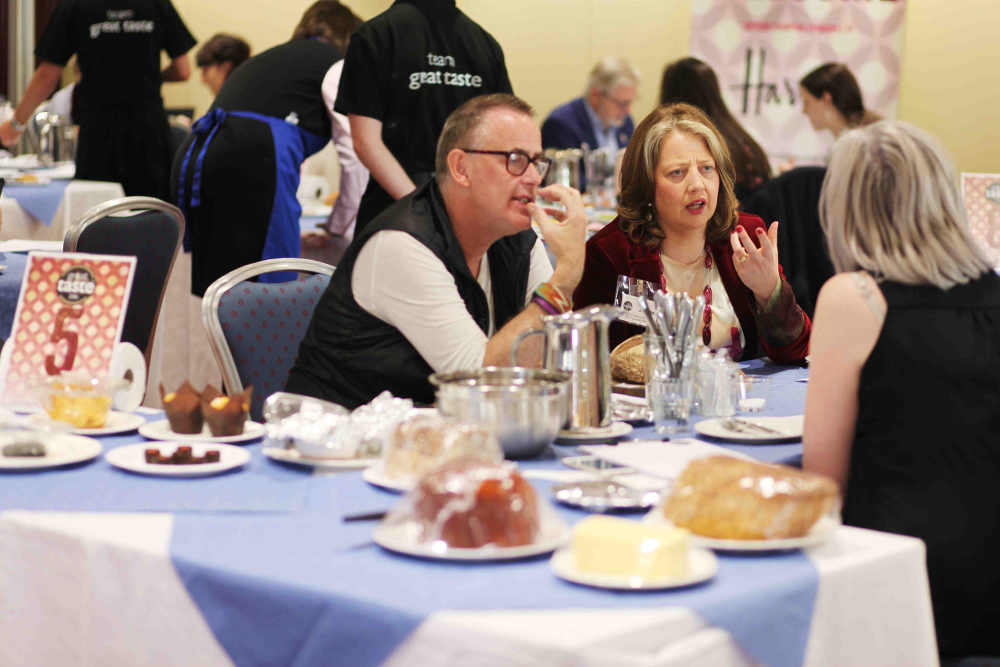
The first day’s judging on Tuesday was followed by an evening at the famous Coolmore Stud, when judges and guests were taken on a behind the scenes tour of the stud generally acknowledged to be the world’s biggest and best thoroughbred racehorse breeding operation.
During their tour they were treated to a special audience with Galileo, the crown jewel of Coolmore. Galileo is said to be the most prized stallion in the world, costing a whopping half a million euro per cover per mare! The champion stud can even muster up to five covers a day so, when you do the sums, it’s not a bad day’s work!
The tour of the stud was followed by a relaxed BBQ supper featuring local products such as the famous James Whelan Butchers burgers and The Butcher’s Daughter sausages, freshly made corn tortillas from Blanco Nino, breads and from Mag’s Home Baking and meringues from The Tipperary Kitchen, all accompanied by delicious wines selected by Gary Gubbins of Clonmel’s own Red Nose Wine. After supper, guests were brought to the atmospheric McCarthy’s of Fethard for some craic agus ceol in the form of the rousing Pheasant Pluckers who soon had the whole crowd singing along.
Aside from the evening entertainment and feasting, there was serious business to attend to during the day. The UK’s annual Great Taste Awards, organised by the Guild of Fine Food, are considered the ‘Oscars’ of the food world, being an acknowledged benchmark for fine food and drink.
The business of judging is a thorough and rigorous one. The Great Taste Awards entries are capped at 10,000 and over 1300 products were entered into Great Taste 2016 from Ireland, including cider, beer, tea, preserves, meats and cheeses. There has been a large increase in Irish companies entering the awards - since last year alone, a jump from 157 in 2015 to 215 in 2016, and over 850 products were judged in the Tipperary week alone.
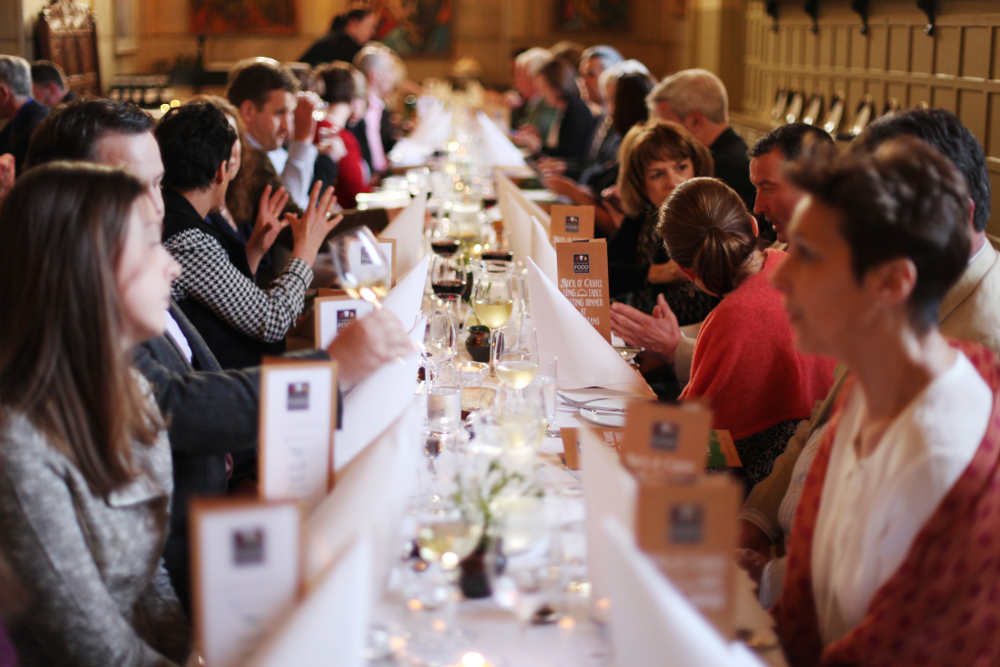
On Wednesday evening, following the second day of tasting, guests enjoyed a tour of the spectacular Rock of Cashel and some traditional Irish dancing by local children. A five-minute stroll downhill and guests arrived at Chez Hans for a Long Table Dinner featuring a stunning six-course tasting menu. Set in a converted Victorian Gothic church, Chez Hans was the perfect setting in which to showcase the excellent quality of Tipperary produce.
The menu included pulled pork ravioli using magnificent Crowes Farm pork, with swede purée, almonds and lovage butter. One of the key dishes was a fillet of Irish Piedmontese beef, with beef dripping fondant potato, made using the famous James Whelan Butchers Beef Dripping, winner of the Harrods Trophy Supreme Champion 2015, a coveted Golden Fork and three gold stars.
“The judges, from all corners of the food world, have had busy days of judging in Tipperary, but have also had three evenings packed full of flavour, colour, welcome and fun in the capable hands of Tipperary Food Producers,” says Pat Whelan.
“This was a wonderful project to be involved with, and it has been made possible by the generous support of all the local and national agencies whose collaboration is immensely appreciated by all at Tipperary Food Producers. Our sincere thanks go to Tipperary County Council, Bord Bia, Local Enterprise Office Tipperary, Tipperary Tourism Company, Department of Agriculture Food & the Marine, North Tipperary Leader Partnership, and South Tipperary Development Company.”
The results of the 2016 Great Taste Awards will be announced later in the year, culminating in a gala prize giving event in September.
For more information and a list of producers, visit: www.tipperaryfoodproducers.com.
-----

Dee Laffan is a freelance food writer and editor. Formerly editor of Easy Food magazine, she has written for the Irish Independent and Sunday Independent. She is a proud supporter of Irish producers and their products, and takes part in judging for food competitions including Blas na hÉireann and the Great Taste Awards. She is a member of the Irish Food Writers' Guild and secretary for Slow Food Dublin. Twitter @deelaffan
Ardkeen Quality Food Store - Special Irish Foods & The People Who Make Them
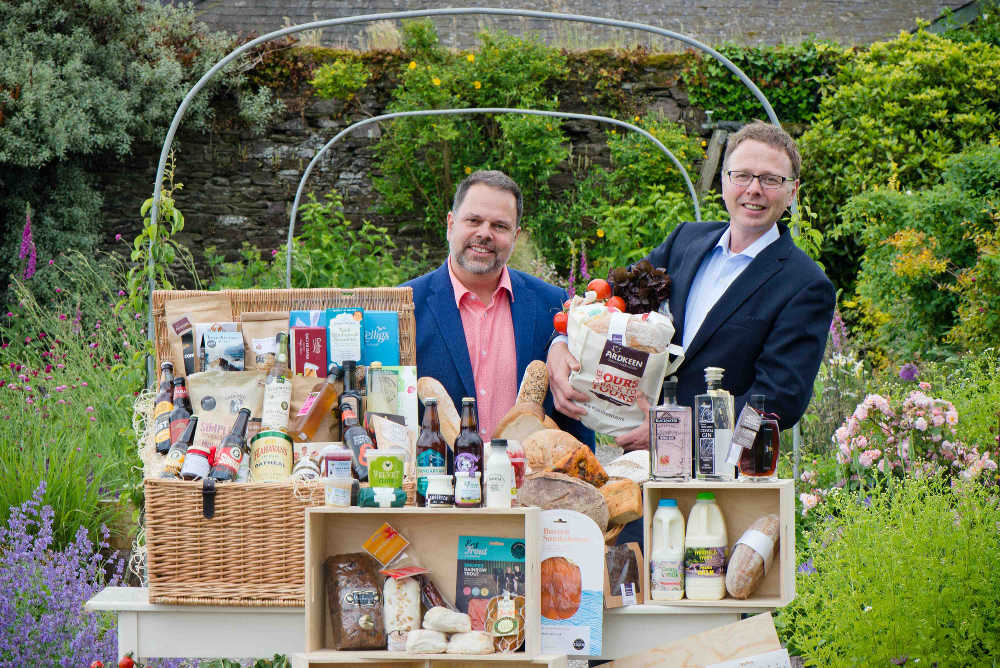

At the 2016 Euro-Toques EirGrid Food Awards, held at Ballymaloe House, Co Cork, in June, it was pointed out that there are currently over 3,500 small to medium sized food businesses operating in Ireland: “Euro-Toques chefs work directly with the small producers and credit this produce that comes through their kitchen doors every day with the success of their award-winning restaurants. Furthermore, supporting small local food businesses benefits the local economy too: A study by the New Economics Foundation in London found that every €14 spent at a local food business is worth €35 for the local area, compared with just €20 when the same amount is spent in a supermarket or wholesaler.”
Supporting independent producers is what Euro-Toques is all about, of course, and over the last three decades member chefs throughout Europe have played a key role in nurturing local produce and introducing lucky diners to special foods and ingredients that might not have been able to survive without them.
But retail opportunities are equally vital to their success, and many small producers have particular reason to be grateful to the speciality stores who champion them.
So it was great to see that, for the first time this year, Euro-Toques presented not only several annual awards to producers but also a Special Commendation to Colin and Kevin Jephson (see image above) of the independent food retailer Ardkeen Quality Food Store in Waterford, for their tremendous support of Irish artisans and speciality food producers.
Ardkeen Quality Food was founded as a small grocery store by Robert and Pamela Jephson in 1967 and today is run today Robert and Pamela’s three sons, Colin (a Failte Ireland food ambassador), Kevin and Gerald. In the early 2000’s, finding themselves literally surrounded by international retail giants like Tesco and Lidl, they took the decision to become more specialised and focus on their strengths: a commitment to quality, an appreciation of provenance and good relationships with their suppliers.
In 2015 the Jephsons launched ardkeen.com, bringing artisan foods to a much broader audience. With a product listing of over 1100 items and growing, the website offers the world’s best selection of Irish artisan food. In 2016 the store was accepted into the Real Bread Ireland network as not only do they support Irish artisan bakers, they also bake their own classic sourdough, focaccia and other specialist breads.
Euro-Toques commended Ardkeen for their unstinting commitment to supporting the best of Irish producers - an especially appropriate gesture on the 30th anniversary of Euro-Toques Ireland, which was founded by Myrtle Allen in 1986.
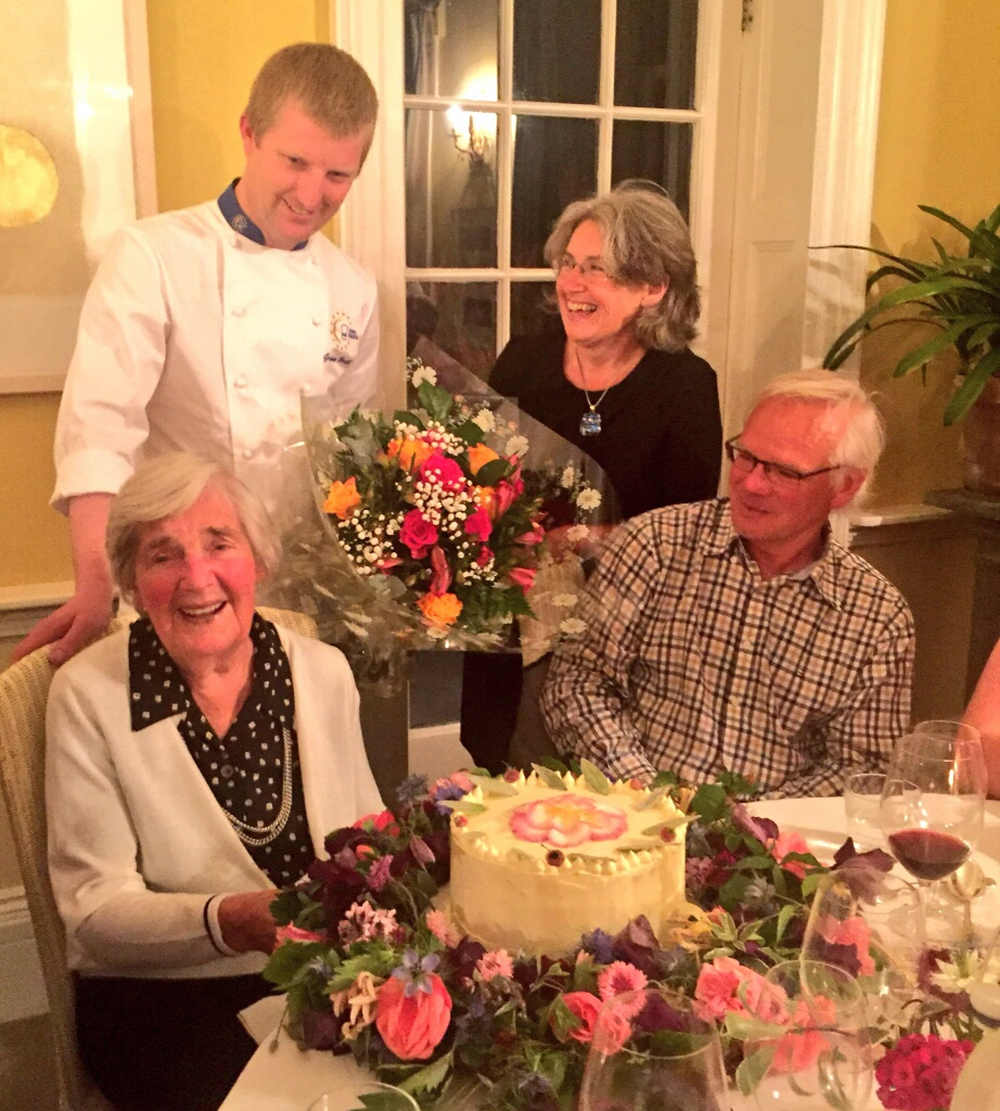
In her honour, the 2016 Awards were moved from Dublin to Ballymaloe and a celebration dinner was cooked for Mrs Allen at Ballymaloe House by several Euro-Toques chefs including current Commissioner General Graham Neville (Residence and Restaurant Forty One), former Commissioner General Feargal O'Donnell (The Fatted Calf), and Euro-Toques chefs Kevin Aherne (Sage in Midleton), Rory O'Connell (Ballymaloe House) and Bryan McCarthy (Greene’s in Cork).
It was a wonderful occasion, rounded off in time-honoured fashion with the presentation of a bouquet and a beautiful cake, which was made by renowned Ballymaloe pastry chef, JR Ryall, and cut by Myrtle herself.
Achill Oysters - Special Irish Foods & The People Who Make Them
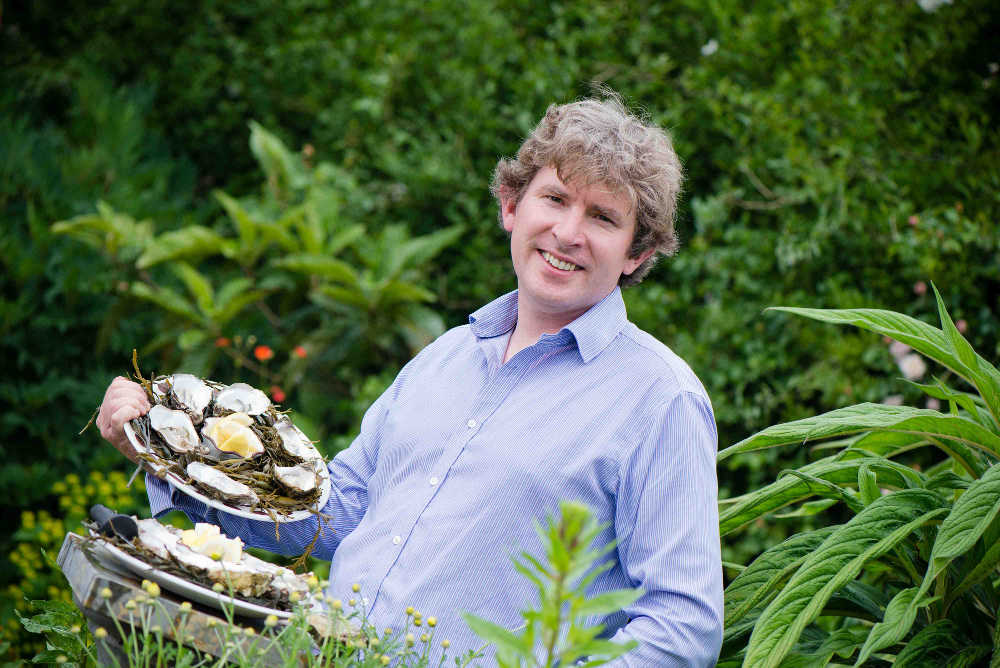
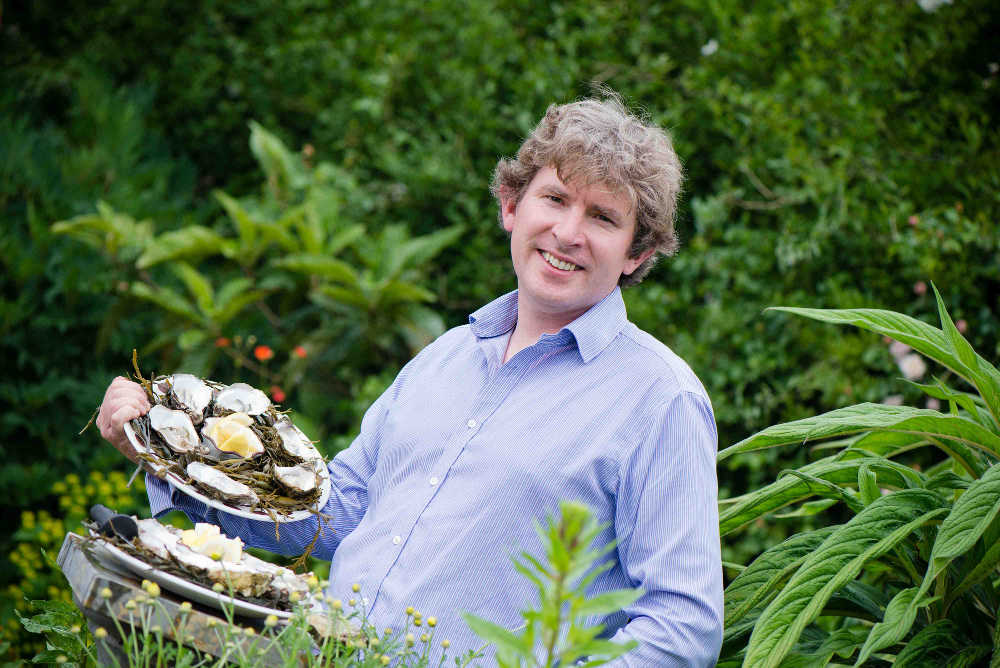
September is synonymous with the beginning of the native oyster season in Ireland and, whether or not they are native, all Irish oysters benefit from the PR boost that the “months with an ‘r’ in them” bring - and all varieties are at their best in the colder months.
Achill Island, Co Mayo, is a wonderful holiday destination but living in any remote area all year has its challenges and the enterprising nature and community spirit of the people are the qualities that make it possible to make such an island home.
Small food producers, such as Garry Hassett (Keem Bay Fish Products), the Calvey family (Achill Mountain Lamb) the O’Malley family (Achill Island Sea Salt) - all of whom are members of the Gourmet Greenway group and supporters of Achill Tourism, are earning a reputation for the island as a food destination.
Another is Hugh O’Malley (pictured) of Achill Oysters, who was the first seafood producer to win an award from Euro-Toques, at their 2016 Euro-Toques EirGrid Food Awards, where he described the history of his oyster farm as ‘achieving a dream.’ His venture is about creating a family business that stands for quality, sustainability and good practice with Achill Island at the centre of it.
Hugh is the fifth generation of his family to harvest oysters from the sea around Achill. The oysters he produces are Pacific Oysters (Crassostrea gigas) and they have a unique flavour owing to the peat landscape surrounding the farm and the high level of salinity in the water.
The oysters are the product of progressive sustainable aquaculture, making the most of the natural marine environment. ‘Taste the sea in every mouthful’ is the proud claim - and tasting is believing, so add a visit to Achill to your must-do list now.
Cloonconra Cheese - Special Irish Foods & The People Who Make Them
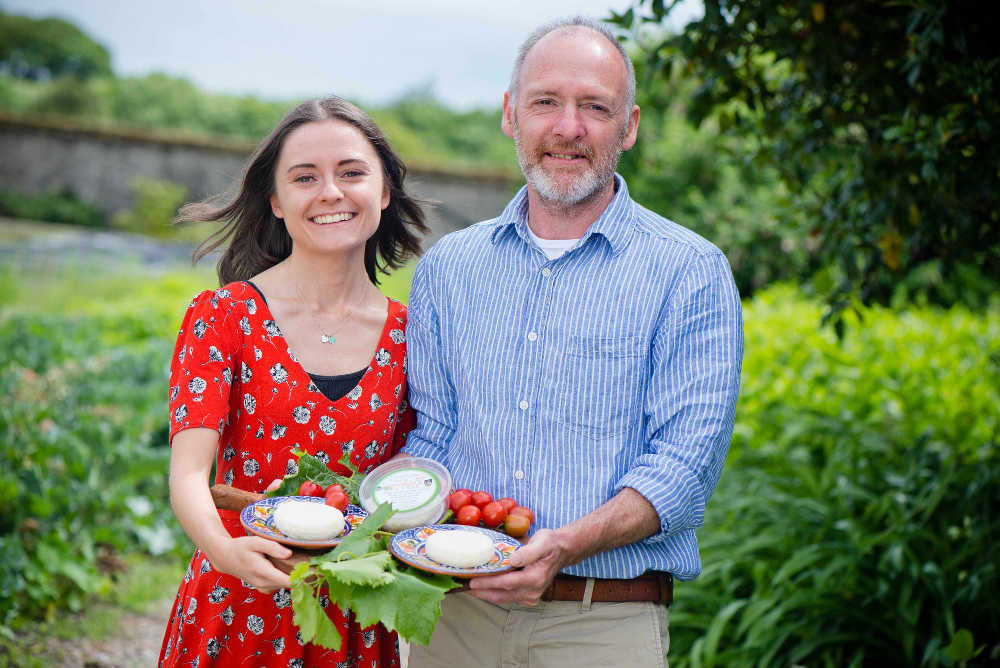

As the raw milk debate rumbles on, it is encouraging that producers have the support of so many groups dedicated to safeguarding traditional farming methods, including Euro-Toques Ireland, which lobbies tirelessly on their behalf and supports small producers in many ways, including their annual food awards.
One of the “important yet challenged” categories that the 2016 EirGrid Euro Toques Food Awards focused on was raw milk cheese, which has been shrinking year on year in the face of regulatory and economic barriers.
Speaking at the awards, Darina Allen said: “Perhaps no artisan product expresses the place and people that produce it as much as raw milk cheese. Each one is unique and almost certainly a labour of love by the cheesemaker, especially as they are increasingly facing challenges in today’s heavily regulated industry.”
According to the judging team their winner in this category, James Gannon of Cloonconra Cheese in Co Roscommon (www.facebook.com/Cloonconra-Cheese), is “especially rare, producing not only the cheese but also the milk from which it is made”.
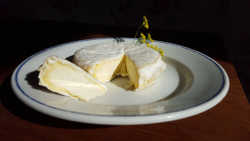
Although it is made using raw milk from their pedigree herd of one our most ancient breeds, the endangered native Irish Moiled Cow or ‘Maol’, Cloonconra is one of the newest of Ireland’s farmhouse cheeses, having first been produced by James Gannon on the family’s dairy farm in West Roscommon in 2015.
This breed has been a feature of Irish agriculture for thousands of years and was traditionally famous for the quality of its milk. They are the only farmers milking the Moiled Cow for cheese in Ireland today - which, as the Euro-Toques judges pointed out, is an accolade in itself.
Cloonconra Cheese’s original product is a soft farmhouse cheese with a delicate citrus flavour and rich, creamy texture. The traditional recipe used, which does not involve pasteurisation, allows for a soft cheese to develop in just a few days, while maintaining the freshness and complexity of flavour from the Irish Moiled Cow milk.
Cloonconra Cheese has featured in season on the menus of some very special restaurants including The GreenHouse and Forest Avenue in Dublin, where stockists include Honest2Goodness, Sheridan's and Clontarf Wines.
Yellowman - Special Irish Foods & The People Who Make Them
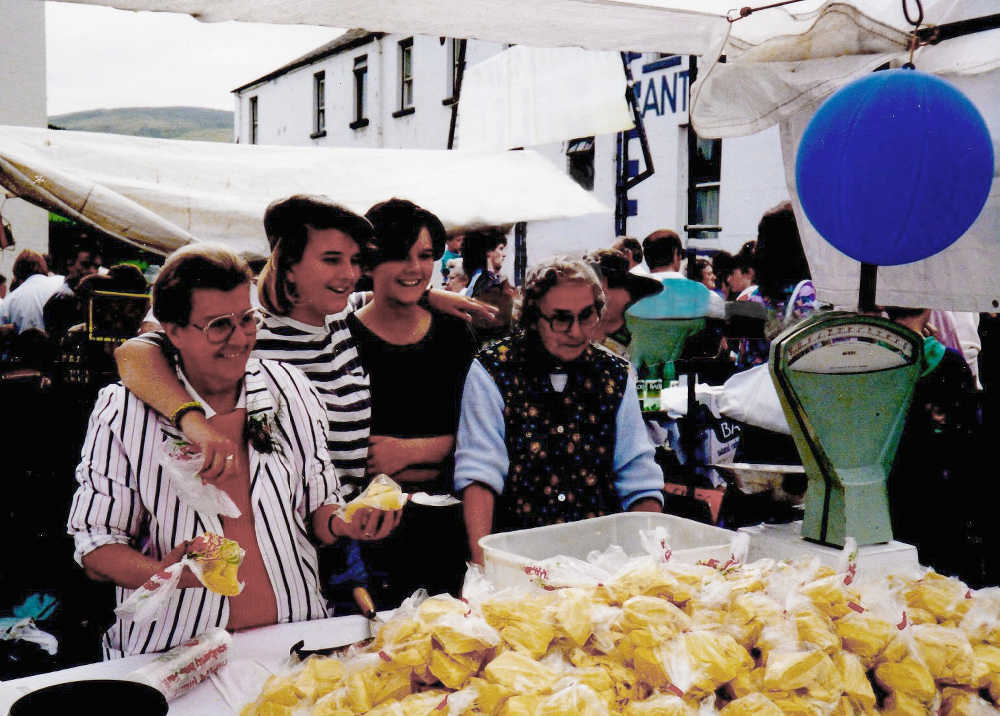

Georgina Campbell
Yellowman (aka Yellow Man, or Yellaman) is inextricably linked to the Auld Lammas Fair, which has been held in Ballycastle, Co Antrim on the last Monday and Tuesday of August since the 17th century, and is Ireland’s oldest fair. But, with the NI Year of Food 2016 calendar theme for November being ‘Legacy & Learn to…’, what product could be more appropriate to highlight this month?
While this North Antrim speciality is famous throughout Ulster, where it is also associated (somewhat bemusingly for visitors, perhaps) with the dulse that is foraged along the nearby shores and equally famous at the Fair, it is not particularly well known elsewhere in Ireland - and, not only would a surprising number of people in the South be hard to put to say what it is at all but, of those who are familiar with it, most would think of the bright yellow honeycomb confection that is sold as Yellowman today.
Even the official website discovernorthernireland.com refers to it as ‘a sweet honeycomb candy’ (see recipe below), yet those who know its history describe it differently - the traditional version is a toffee mixture that is hung up on a hook before setting and ‘pulled’ repeatedly to lighten it to a golden colour and, once cold, it is so hard that it needs to be broken up with a hammer.

There are probably plenty of secret recipes hidden away in Co Antrim and there’s at least one in Newcastle West, Co Limerick too, where Ballymena native Sharon Noonan (née Devlin), the presenter of West Limerick 102 FM’s food programme ‘Best Possible Taste’, is the guardian of the Devlin family recipe.
An unexpected encounter with Yellow Man on the petits fours menu at The Mustard Seed in Ballingarry brought a flood of memories back to Sharon, inspiring her to investigate the traditional sweet and its variations in a radio documentary Devlins’ Yellowman - A Taste of Childhood.
In this excellent production, which was supported by the Broadcasting Authority of Ireland, Sharon goes back to her roots, remembering the three Antrim families - the Devlins, the McKeowns, and the Agnews - who were the main producers of yellowman, and interviewing her father about the annual ritual of making their own Devlins’ Yellowman (literally) by the ton coming up to the Lammas Fair.
Although best known for their greengrocers shops (one of which is still run by a family member, in Broughshane), producing Yellowman for the Lammas Fair was an important diversification for the Devlins in summer, and all the family had a role to play in the making - which was hard physical work - and the selling.
Sharon interviewed chefs with fascinating connections to Yellowman - Kerry chef John Fitzmaurice (a Euro-Toques Young Chef finalist in 2015, currently cooking at Moloughneys in Dublin), who made it for her family on that fateful night in The Mustard Seed; and Co Derry native Noel McMeel, a lifelong ambassador for the foods of Northern Ireland, who famously included it on his menu for the 2013 G8 Summit at Lough Erne Resort.
Sharon also spoke to Will Taylor of Glastry Farm in Co Down, whose Yellowman Honeycomb Icecream is a Great Taste Awards 2 Gold Stars winner and one of the most popular in their range; and Jim Gilmore of the legendary Belfast handmade sweet factory, Aunt Sandra’s…and, perhaps most fascinating of all, she even got a legal opinion on whether a recipe can be patented.
To find out - and to find out whether Sharon has decided it’s time to share the traditional Devlins’ Yellowman recipe, listen to her documentary:
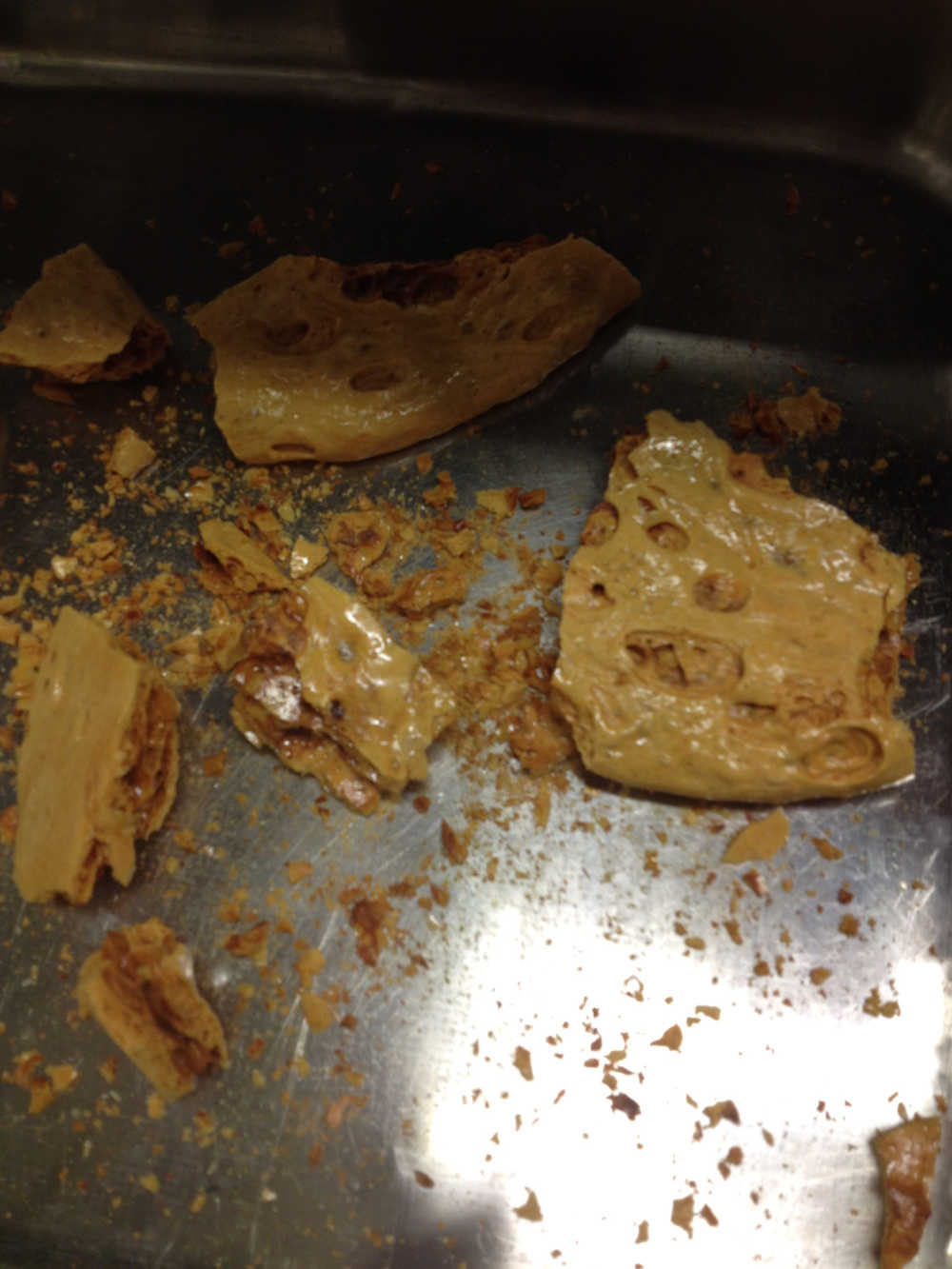
Yellowman Recipe - a modern version, from discovernorthernireland.com:
This sticky delicacy is a true Northern Ireland speciality and it's even immortalised in folk song with the lyric: "Did you treat your Mary Ann to some dulse and Yellow Man / At the Ould Lammas Fair in Ballycastle-O'. It can be found at Aunt Sandra's Candy Factory in Belfast and delicatessens around Northern Ireland, but here's how to make your own.
Ingredients
11/2 cups golden syrup
1 cup brown sugar
50g (2oz) Irish butter
2 tablespoons white vinegar
1 tablespoon bicarbonate of soda
Method
1. Take great care with this one as boiling sugar can be very dangerous!
2. Gently mix the syrup, sugar, butter and vinegar together in a large saucepan. Then bring it slowly to the boil (do not stir).
3. Boil until a drop hardens in cold water, then carefully stir in the baking soda (the mixture will foam up when the soda goes in).
4. Pour out on to a lightly greased slab and when cool enough to handle, work the edges into the centre. Keep doing this until the mixture turns to a pale yellow colour.
5. Pop it into a lightly greased flat tin and leave to cool and set. When cold, break it into bite size chunks with a clean hammer.
6. Bag-it-up, then off you go to the Ould Lammas Fair.
Man of Aran Fudge - Special Irish Foods & The People Who Make Them
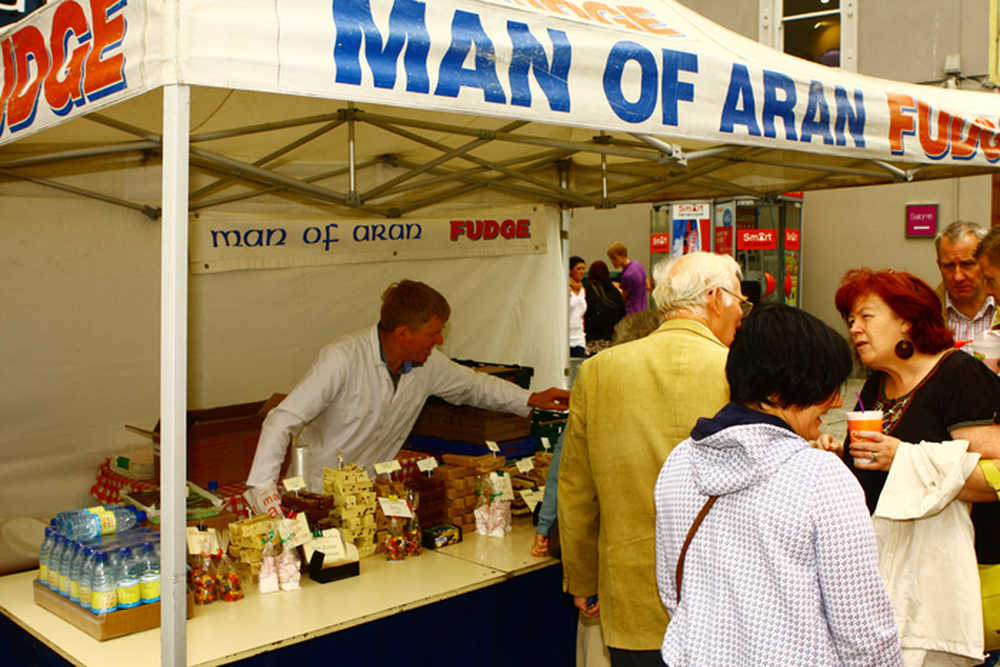
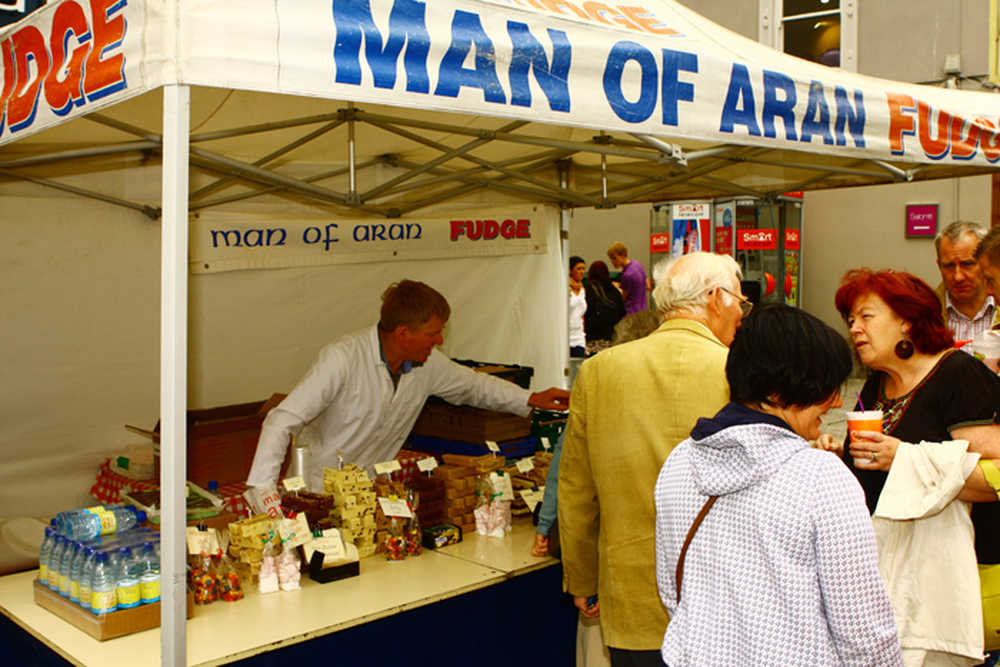 Georgina Campbell
Georgina Campbell
Christmas wouldn’t be Christmas without some sweet treats to hand round after dinner and you can’t beat good old fashioned fudge, made with pure butter.
It’s a nostalgic treat for many - not least Tomás Poil, the man behind the evocatively named Man of Aran Fudge.
Born on the small island of Inis Oirr on the Aran Islands, where there was no secondary school, his love of fudge all began with the treats his granny used to send him when he went away to school on the mainland.
He qualified in agriculture but, many years later, the time came when he needed an alternative to farming rented land. And inspiration came from those childhood memories, which he decided to share by recreating the treats he had enjoyed so much - and also, by selling them from a stall in the traditional way, at markets and shows, reliving the trading atmosphere of the old fairs.
Now based in County Meath, Tomás started to make fudge commercially in 1996 and he has since developed the concept to a point that must have seemed unimaginable at the start. He currently offers over 20 varieties - and counting - all handmade to the same high standard.
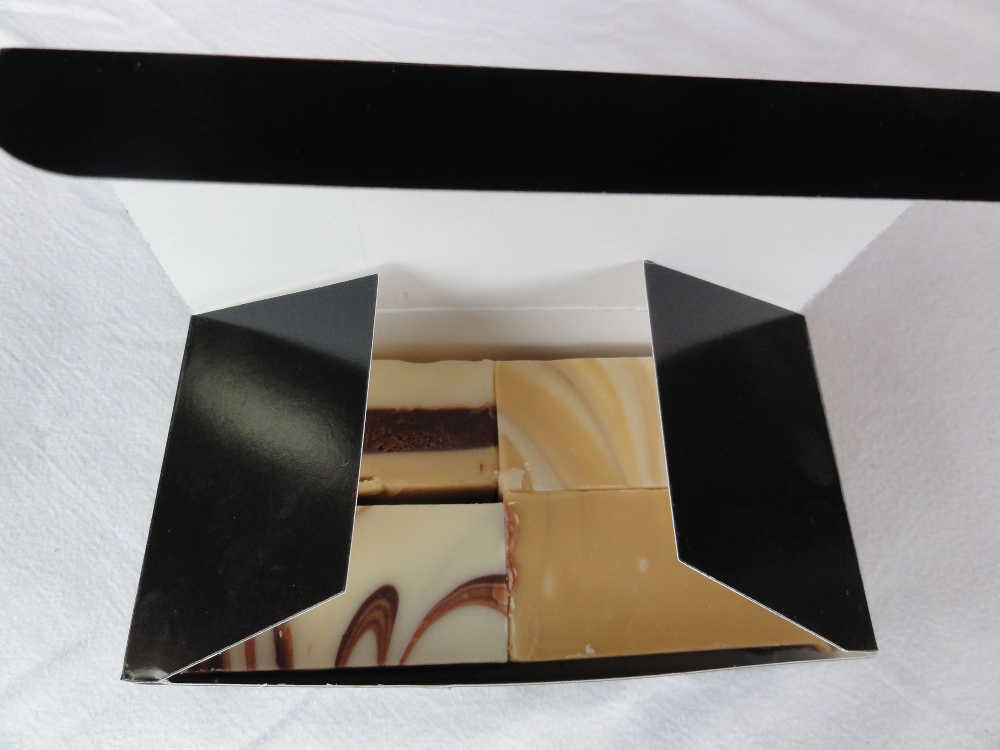
And, while fudge is definitely ‘the one’ for Tomás, he has permitted one other, equally nostalgic, sweet treat to take its place on his product list: real old-fashioned Turkish delight, flavoured with rosewater...
You can't miss him at markets and events such as Bloom and regional food festivals, where (unlike many traders, who erect stalls with little or no branding on them) his stall is invariably the most recognisably branded and simply leaps out from the crowd.
And there he'll be himself, selling award winners like Granny's Nutty Fudge and Irish Coffee Fudge, and many others - some of them, such as the Christmas Pudding Fudge are seasonal, while others like the Tiger Butter Fudge and Caramel Beurre Salé Fudge are not only delicious but have some curiosity value as well.
There is no limit to Tomás's imagination and energy - and this, plus the quality of his ingredients, including real Irish butter and fresh cream, are the secrets to Man of Aran's success.
• Meet Tomás at markets (Galway Continental Christmas Market, on Eyre Square, Galway City, runs until 22nd December 2016),
or buy online from here
Free Range Pork by Pigs on the Green and Andarl Farm - Special Irish Foods & The People Who Make Them
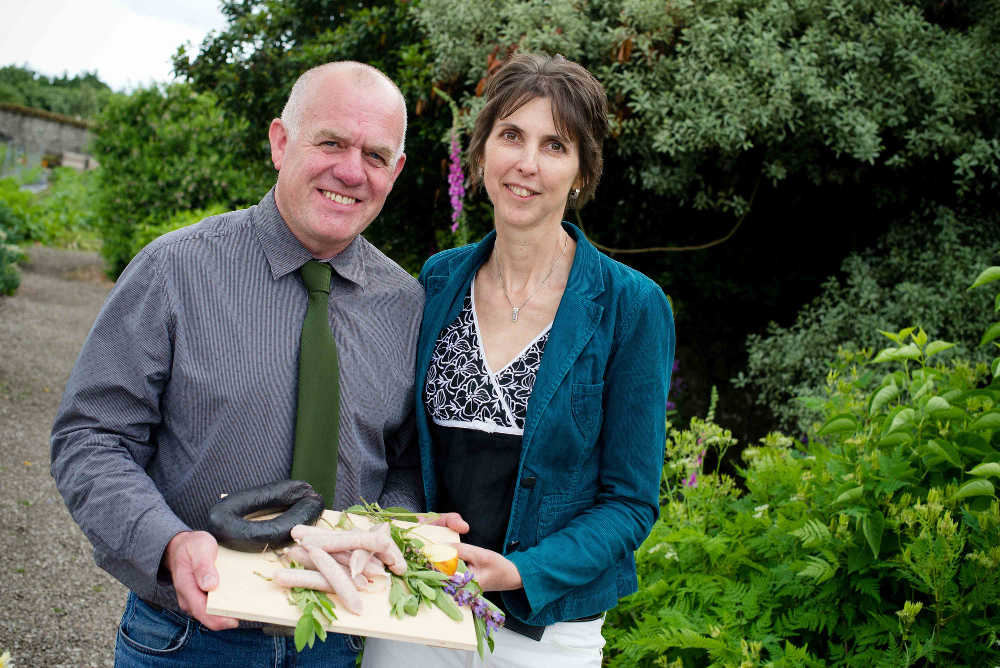
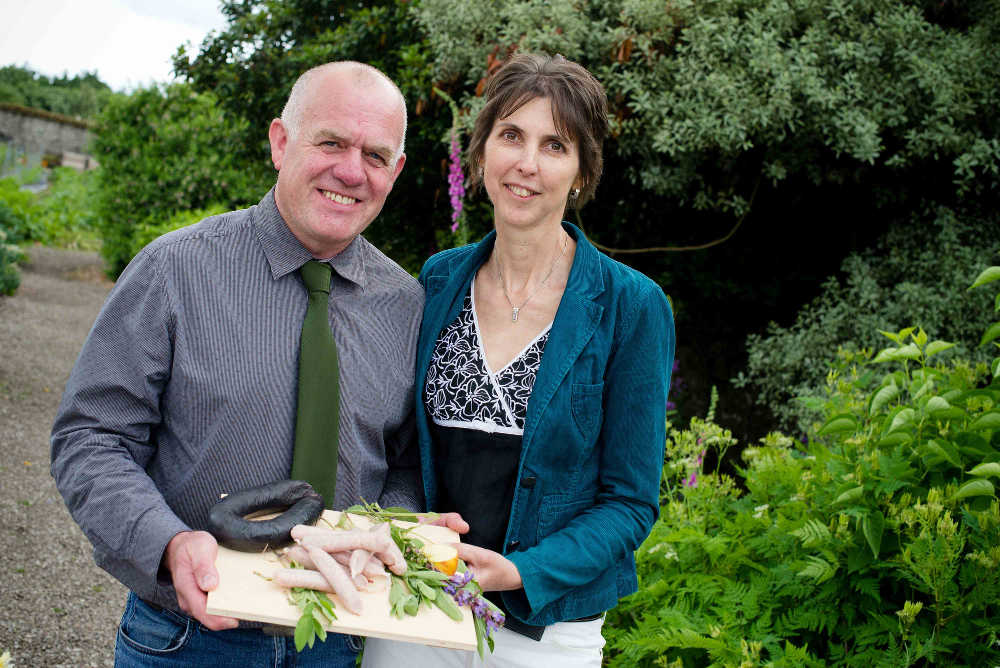
Georgina Campbell
The Euro-Toques EirGrid Food Awards are always special and 2016 was a vintage year, when they celebrated the 30th Anniversary of Euro-Toques Ireland and also marked Myrtle Allen’s legacy with a wonderful event at Ballymaloe House in high summer.
And now, in the colder months, it’s the traditional time to make the most of delicious free range pork - a product that was especially praised at the event, and rightly so. “Shrinking year on year in the face of regulatory and economic barriers”, free range pork production in Ireland is all too rare.
It is, as Darina Allen said, “…a challenging occupation that takes patience, skill and sensitivity to the needs of the animals in order to produce a good product”, so it was encouraging for the sector to see a joint Euro-Toques award for free range pork going to two enthusiastic couples, Fergus and Sandra Dunne, Pigs on the Green, Co Offaly; and Dave and Diana Milestone, Andarl Farm, Co Mayo.
On their small farm near Tullamore, former organic vegetable farmers Fergus and Sandra Dunne now rear free range Tamworth pigs. A hardy native breed once known as the Irish Grazer, Tamworths are famous for their feisty nature - and great taste. The Dunnes’ ‘Pigs on the Green’ brand took off from the get-go, thanks to the succulence and flavour of the meaty sausages, black pudding, dry-cured bacon and fresh pork cuts that quickly earning a following at leading restaurants.
Discerning shoppers weren’t slow to give them the vote of approval either, and Pigs on the Green products can be found at quality-led shops including McCambridges, Mortons and Joyces of Knocknacarra in Galway, Swans of Naas and Wilde and Green in Milltown, Dublin.
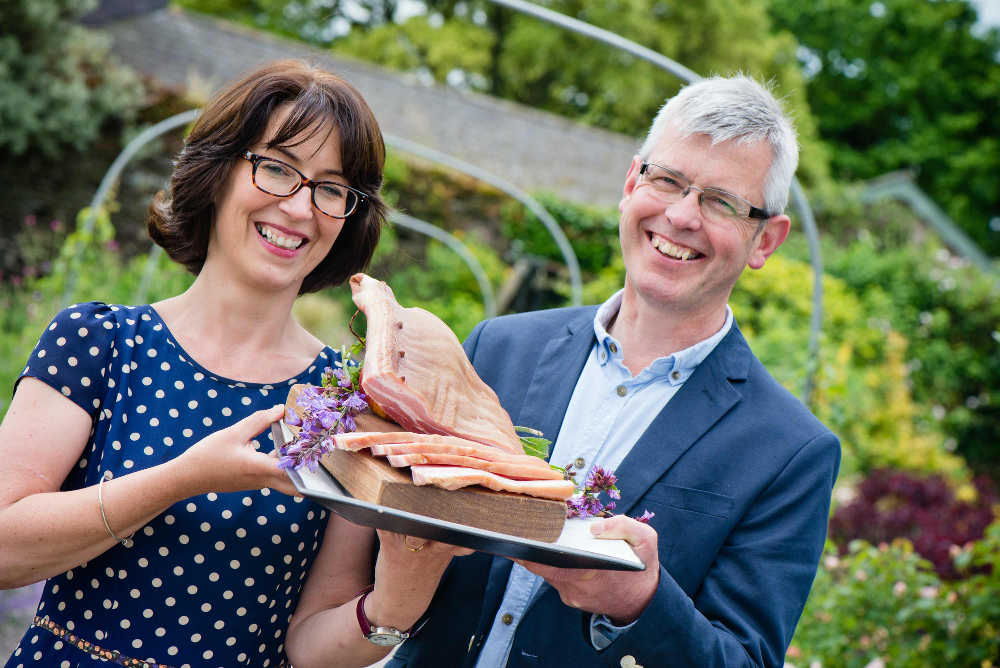
Over at Claremorris, Co Mayo, Dave and Diana Milestone of Andarl Farm (andarlfarm.ie) famously started off on their ‘great pig adventure’, with a Great White sow called Doris, and they then spent several years working towards the perfect partnership for the right fat to lean ratio and the hardiness needed for the outdoor life. Then along came a Hyroc boar called Harry, and the deliciously tender Andarl ‘Velvet Pork’ was born.
You can buy it in specialist shops such as Castlebar’s De Búrca’s Traditional Butcher Shop - Seán Bourke and Sarah Ní Shúilleabháin’s extraordinary ‘whole animal butcher shop’ - and enjoy it (eat or buy) nearby in the McMahon family’s equally extraordinary Rua (where the pork and apple burger and dry cured bacon are special favourites) and other selective outlets. Bred for its cooking qualities, it’s well worth seeking out.
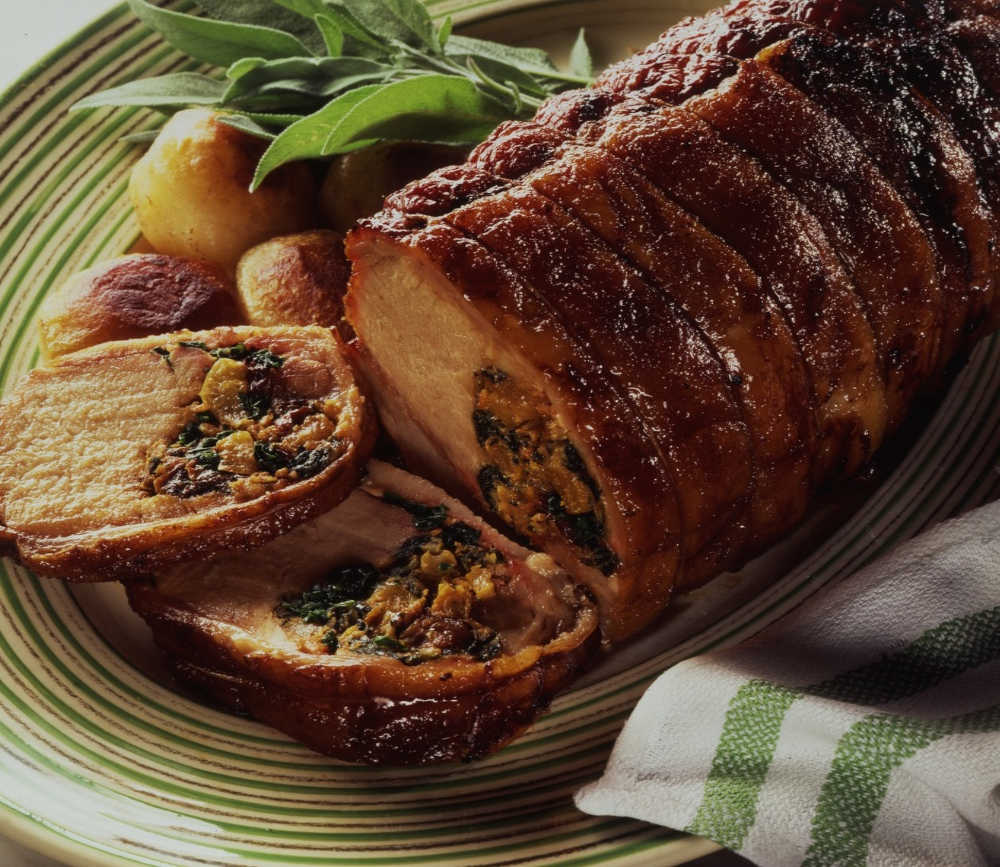
RECIPE: Roast Loin of Pork with Apple & Spinach Stuffing
Serves 6-8
2kg/41/2 lb loin of free range pork
Salt and freshly ground black pepper
l onion, peeled and sliced
60ml/4 tbsp water
Juice of l orange
Stuffing:
50g/2oz dried apricots, chopped
50g/2oz spinach, blanched and chopped (or use 2-3 tbsp chopped parsley)
50g/2oz hard Irish farmhouse cheese, grated
l cooking apple, eg Bramley’s Seedling, peeled and grated, or finely chopped
Grated rind of 1/2 of the orange
Topping:
15ml/l tbsp mild wholegrain Irish mustard
30ml/2 tbsp Demerara sugar
Preheat the oven at 350ºF, 180ºC, gas mark 4.
Prepare the stuffing, by putting all the ingredients into a bowl and mixing well together.
If the joint has the skin on, remove it to cook separately for crackling.
Place the meat, fat side down, on a chopping board and spread the stuffing over it. Roll up and tie neatly with cotton string; season.
Put the joint in a roasting tin with the peeled and sliced onion and the water. Cook uncovered for about 35 minutes per 450g/1 lb.
If making crackling, score the pork skin, rub in a little salt and roast in a separate tin until brown and crunchy. The drippings are perfect for cooking roast potatoes in.
40 minutes before the end of the cooking time, pour off the liquid into a small saucepan and discard the onion. Add the orange juice to the liquid.
Spread the joint with mustard and sprinkle with the Demerara sugar. Return the joint to the oven and turn the heat up to get a crisp finish.
Boil up the juices, thicken if you like and serve with the sliced meat, roast potatoes and fresh vegetables.
The Little Milk Company - Special Irish Foods & The People Who Make Them
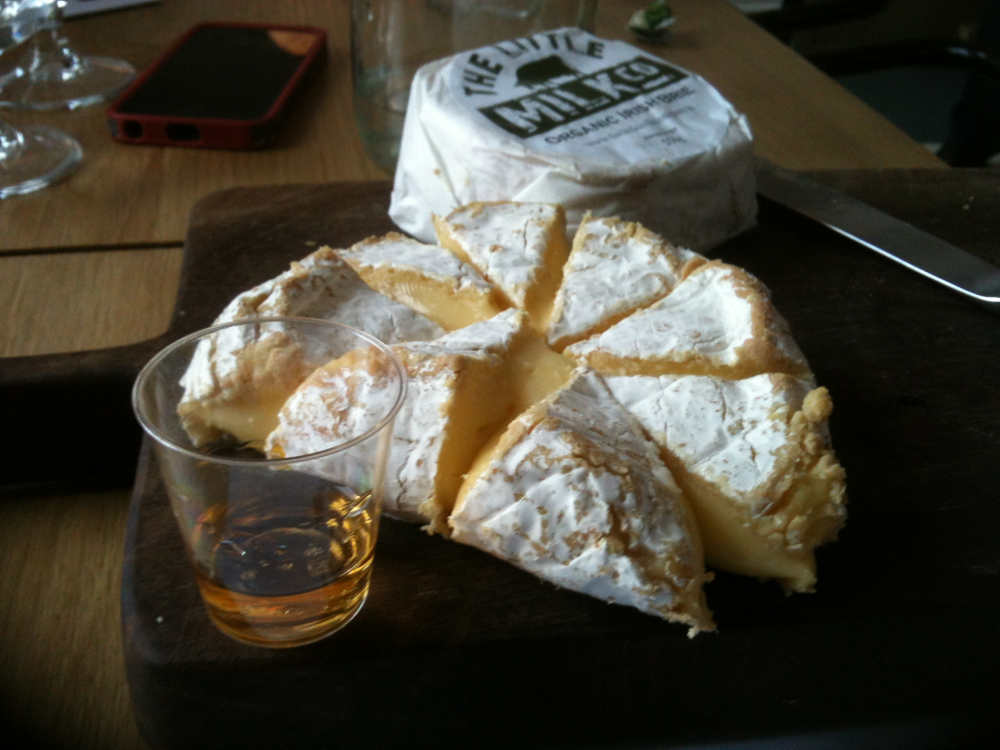

Georgina Campbell
The Little Milk Company is an innovative cooperative demonstrating that environmentally responsible small producers can thrive by working together – and they are the winners of the Irish Food Writers’ Guild 2017 Environmental Award.
In 2008, ten organic dairy farmers from Munster and Leinster came together as a discussion group chaired by Pat Mulrooney to consider the sustainability of their family farms.
Recognising that economic sustainability lay in adding value to their primary product, the group experimented in 2011 with a raw milk cheddar produced for them by Knockanore Irish Farmhouse Cheese.
Encouraged by positive feedback, each of the farmers invested in the company the following year. In 2013, they brought Conor Mulhall, of Cappagh in West Waterford, on board as a full-time CEO of The Little Milk Company.
Today they produce eight different organic cheeses, including three styles of cheddar, a brie, a blue and Brewer’s Gold, a washed-rind cheese that uses Dungarvan Brewing Company’s Copper Coast beer.
Their cheeses are exported to 16 countries and use 70% of all the milk produced on their ten family farms. This is projected to rise to 100% by 2018 and the company is currently recruiting local farmers to convert to organic production in order to meet their future demand.
By collaborating with local cheese-makers The Little Milk Company farmers are supporting small Irish craft food producers whilst securing a future for themselves and their families on their own farms.
Irish Charcuterie - Special Irish Foods & The People Who Make Them

AOIFE CARRIGY celebrates Irish charcuterie
 Maybe it’s an islander thing, but we Irish have always had a curiosity for what lies beyond our shores. Marry that with our loyal love of the land – another islander quirk – and its world-class meat and dairy, and perhaps it was inevitable that an Irish take on continental-style charcuterie would eventually become the latest food trend to take our collective fancy.
Maybe it’s an islander thing, but we Irish have always had a curiosity for what lies beyond our shores. Marry that with our loyal love of the land – another islander quirk – and its world-class meat and dairy, and perhaps it was inevitable that an Irish take on continental-style charcuterie would eventually become the latest food trend to take our collective fancy.
Kevin Sheridan thinks so. As one half of Sheridan’s Cheesemongers, the fine food emporium that played a pivotal role in reviving our buoyant Irish food culture, he says that “the question is why has it taken so long.”
The success of Irish farmhouse cheese, non-existent 40 years ago, has spurred entrepreneurial producers to seek new territory. “Our strong culture of animal husbandry and fondness for pork makes cured meats an obvious next step.”
Of course any foodie worth their curing salt can tell you that today’s trend has its roots in the 1990s, when pioneers Fingal Ferguson of Gubbeen Smokehouse (above right) and Frank Krawcyck of West Cork Salamis became heroes of an innovative Irish charcuterie trolley that heralded Dublin’s Chapter One as Ireland’s hottest fine-dining restaurant.
Fast forward 20 years, and Gubbeen’s range of 50-plus products feature on the best menus and deli counters throughout the land. And their success has made way for a new breed of modern Irish charcutiere who are only getting started on their experiments with all things cured.

“Ireland produces some of the best meat in the world” says fourth-generation north Dublin butcher, Rick Higgins, “yet we are still importing charcuterie”. Higgins recently teamed up with Italian charcutier Antonio Princigallo to launch Forage & Cure.
Their Irish prosciutto, breasaola and 90-day salamis are being snapped up by chefs before they’ve left the temperature-controlled curing room that makes these continental-style dry-cures possible in our damp climate. They are even producing a range of small salamis for SuperValu’s Food Academy promotion of artisan producers – a testament to our newfound appetite for these flavour-packed foods.
Specialists like Sheridan’s, who are longtime supporters of Gubbeen Smokehouse, are expanding their selection of Irish charcuterie to reflect this growth. What Kevin Sheridan describes as The Wooded Pig’s “interesting little salamis” are stocked in Sheridan’s stores, as well as markets like Dublin’s Green Door Market. Produced in Co Meath by Eoin Bird and his mother Miriam, from ethically reared free-range pigs that have the run of mature forests of ash, beech and oak, the range includes a subtle garlic salami and a feisty chorizo, and will soon include coppa (whole-cured eye of the shoulder) and pancetta. “I wanted to establish myself as a reputable producer of standard charcuterie and then try to develop an Irish style with flavours that are specific to Ireland,” Eoin says, flagging the possibility of whiskey or seaweed-flavoured salamis down the line.
Former antique dealer turned cattle breeder, Eavaun Carmody of Killenure Dexter Gourmet in Tipperary is collaborating with Dingle-based French charcutier Olivier Beaujouan. Their range of Dexter beef charcuterie amplifies the unusual flavours of this near-lost indigenous Irish breed. “Although Dexter Beef is completely unique in its original form with an earthy, yet slightly nutty taste, I wanted to offer a choice of experiences” Carmody says of their Dexter beef jerky, braesola and chorizo.

Some chefs are turning their own hand to this age-old skill. “Charcuterie represents my heritage,” says Frank Krawcyck’s son Rob. Twice-named Best Leinster Chef while running the kitchen at Tankardstown House in Co Meath, he will head up his own restaurant in Dublin this autumn in a hotly anticipated partnership with food writer Caroline Byrne. The open kitchen at Có (Irish for ‘combined’) will include a purpose-built smoker and temperature-controlled hanging room to display the hams, pancetta, coppa and salamis created in-house by this ambitious young chef with the help of his father.
Another rising star, chef Ciaran Sweeney sees charcuterie as an extension of our Irish food heritage – and a perfect fit for the laid-back surroundings of Dublin’s Forest & Marcy ‘wine room and kitchen’. His house-produced charcuterie board features continental-style cures like lamb neck coppa cured with rosemary and garlic, or pigeon ham brined in anise and orange and air-dried for three weeks. But these sit alongside house-made black pudding or corned and smoked ox tongue: traditional Irish offerings rooted in a time when most farming families kept a pig or two and all cuts of available meat were used frugally. “You want to maximise your whole animal.”
Along with our love for casual dining, appetite for minimising food waste and revival of food preservation skills like fermentation, that nose-to-tail philosophy is driving charcuterie's comeback. In Ireland, it is being met with a creativity (Carmody is even developing a side range of Dexter bone china and leather handbags) and confidence that suggests this hot trend is here to stay. “I think our charcuterie can gain a worldwide reputation just as the Italians and Spanish have done,” says Rick Higgins. And why not?
A version of this article appeared in The Sunday Times’ Style Ireland, 12th March 2017.
---

Chairwoman of the Irish Food Writers’ Guild, Aoife Carrigy is a freelance food and wine writer and editor. She is a regular contributor to FOOD&WINE Magazine, The Irish Independent, The Herald and Cara Magazine, amongst others, and was co-author of The Ard Bia Cookbook and general editor of The ICA Cookbook, The ICA Book of Home and Family, The ICA Book of Tea & Company and, most recently, The ICA Book of Christmas. In 2015, she teamed up with Great Irish Beverages to launch the inaugural Dublin Wine Fest and Irish Cider & Food Day.
Ballinwillin Venison and Wild Boar - Special Irish Foods & The People Who Make Them
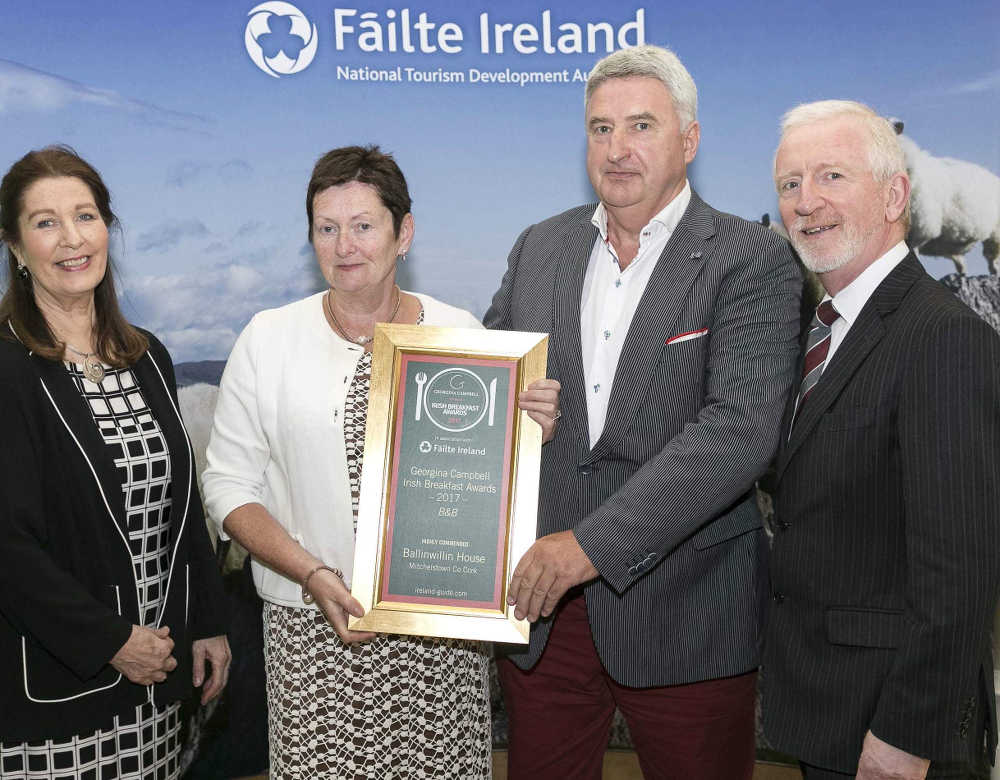
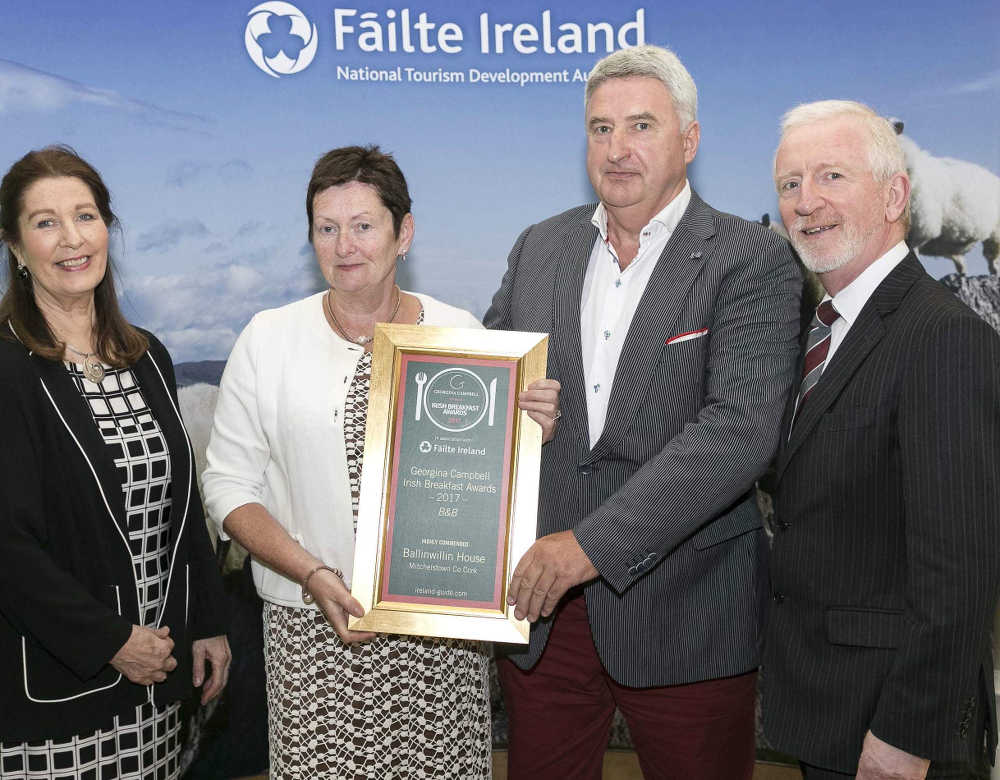
Georgina Campbell
It is the quality of their products that leads many to Pat and Miriam Mulcahy’s farm on the edge of Mitchelstown in Ireland’s Ancient East, as their tender Ballinwillin venison and free range wild boar features on many leading hotel menus - and, in April 2017, this included the Five Star InterContinental Dublin, which was the host venue for the Georgina Campbell Irish Breakfast Awards - In Association with Failte Ireland.
The menu for the occasion was built around produce that was highlighted for its quality at the Awards, including O’Neill’s Dry Cure Bacon and Inch House Black Pudding as well as the superb Ballinwillin wild boar sausages - which, of course, are also on the breakfast menu at their farm B&B.
This extraordinary place is right on the edge of Mitchelstown, with the Galtee Mountains close by; you approach through a suburban cul-de-sac which ends in a security gate – leading into a different world.

Once inside the 80-acre estate, you see deer grazing and the driveway opens up to reveal a substantial 18th century country house and outbuildings – where there is some unexpectedly modern and luxurious accommodation in an attractively converted courtyard.
Virtually everything on the Ballinwillin breakfast table comes from the farm. The full Irish, for example, will include the famous venison or wild boar sausage, eggs from their hens, rashers and black and white puddings from their free range pigs. The full Irish doesn’t get any more Irish than that
Pat is a familiar figure at food events around the country and also sells his organically produced meats - which include pork and beef as well as the more exotic wild boar and venison - online.
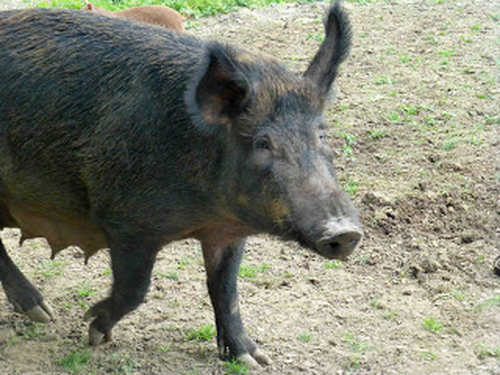
As if their unusual farm produce wasn’t enough, Pat and Miriam also own the Chateau Mulcahy vineyard in Hungary, and another unexpected feature of Ballinwillin is a characterful old stone wine cellar, where they hold tastings (for group of six or more) and other events.
Ballinwillin offers a real rural holiday for both adults and families, with farm tours available (safe walking tracks) and guests welcome to ‘roam free with the deer’.
The Mulcahys’ claim to offer “a truly unique experience that combines luxurious accommodation, wine and artisan food” is no exaggeration - everything about Ballinwillin is surprising, especially so close to the centre of a large country town.
Other points of interest in the area include the Ballyhoura Food Fair, held at Kilmallock on Bank Holiday Mondays in summer.
Sheep's Milk Yogurt - Special Irish Foods & The People Who Make Them
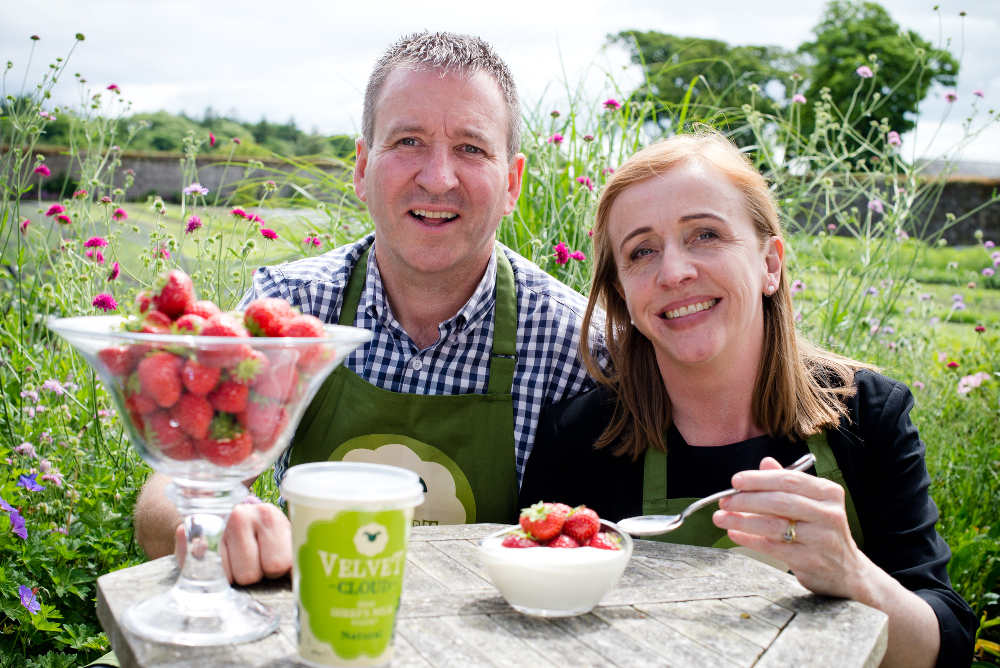
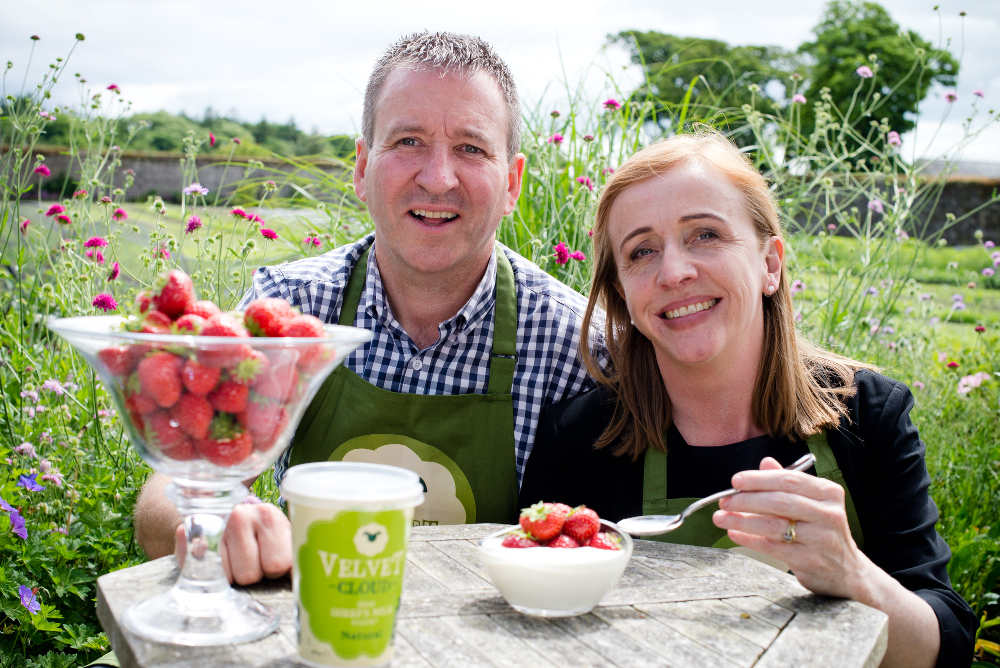
Georgina Campbell
There is only one sheep’s milk yogurt produced in Ireland and it is made by Aisling and Michael Flanagan on the Flanagan farm in Co Mayo, where the family have been farming the land for generations.
Not surprisingly, perhaps, given its special qualities, their Velvet Cloud Irish Sheep’s Milk Yogurt has grown in a very short space of time to be one of the most talked about new products - and it was a winner in the prestigious Euro-Toques EirGrid Food Awards in 2016.
Velvet Cloud sheep’s milk yogurt is a very pure food - the ultimate free-from product, it is made with only two ingredients (fresh sheep’s milk and live probiotic yogurt culture) and ‘there is nothing added or nothing strained away’. Luckily, it is also very tasty, with a creamy texture and mild, slightly sweet flavour.
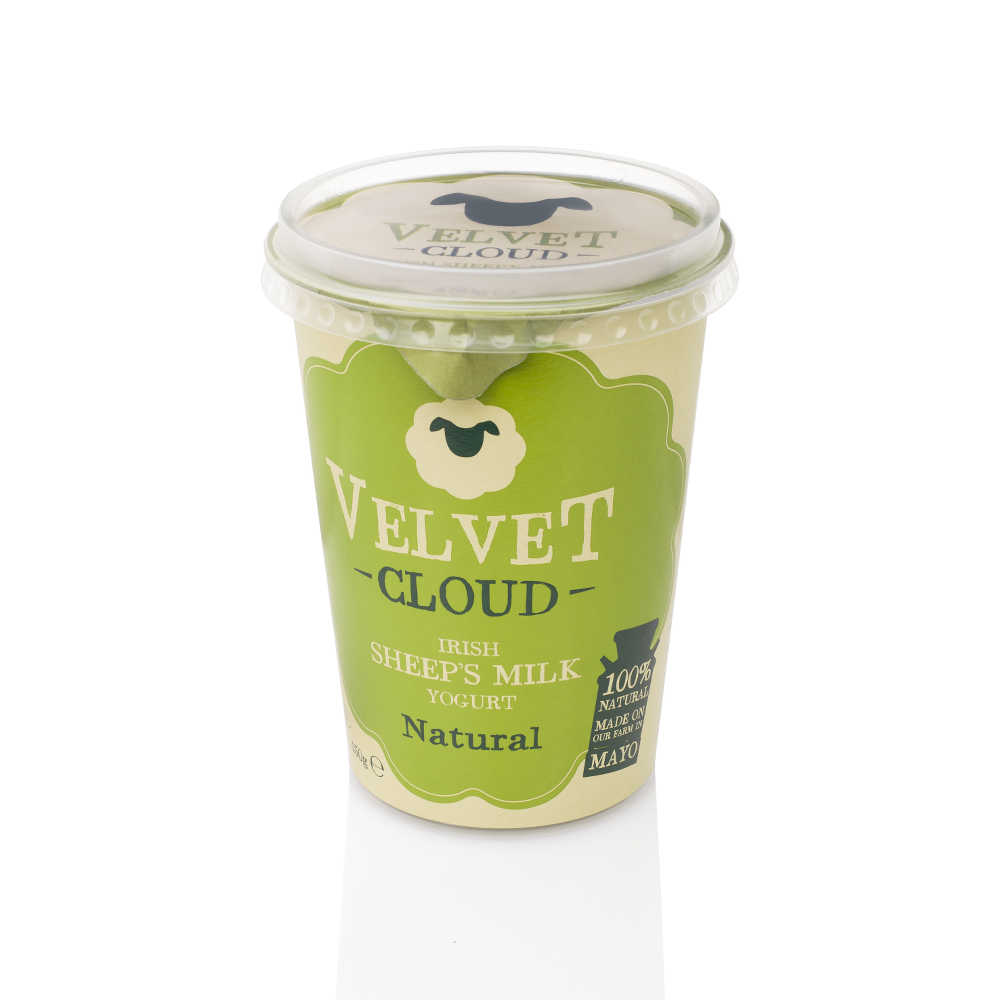
Explaining the reasons for this chefs association’s Award for “excellence and innovation in dairy”, the Euro-Toques judges said, “The properties of sheep’s milk give a particular taste and mouth feel that can be used in both sweet and savoury dishes and withstand higher temperatures, which is why this West of Ireland yogurt has become such a favourite with chefs.”
Given the health benefits and cooking qualities - and the number of sheep on this small island - it is astonishing that there are so few sheep’s milk products available here. Sheep’s milk is not only highly nutritional but it is also very palatable - and suitable for many people who are intolerant to cow’s milk. Sheep’s milk production has been growing in New Zealand and the UK and Velvet Cloud is now doing great work to develop this dairy category in Ireland.
Look out for this seasonal product in selected SuperValu stores and in speciality food shops such as Nolans of Clontarf, Mortons of Ranelagh and Donnybrook Fair in Dublin, and other champions of good food like Country Choice in Nenagh and Ardkeen Quakity Food Store in Waterford (full list on their informative website).
And, with a new sheep’s milk cheese in the pipeline too, there will soon be more good news to come from these enterprising people.
Euro-Toques Food Awards 2017 - Special Irish Foods & The People Who Make Them
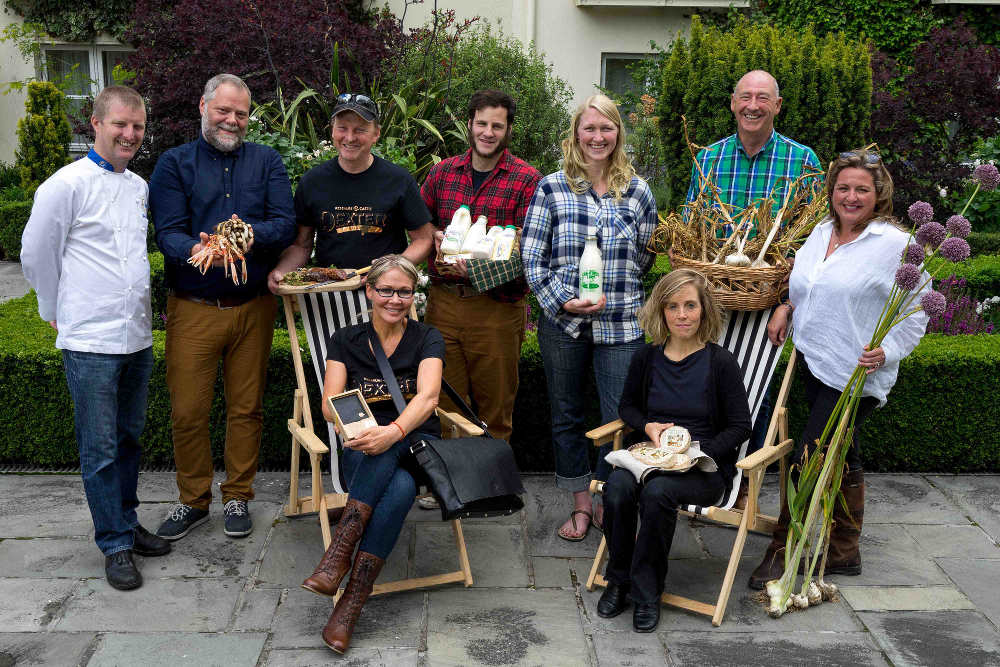
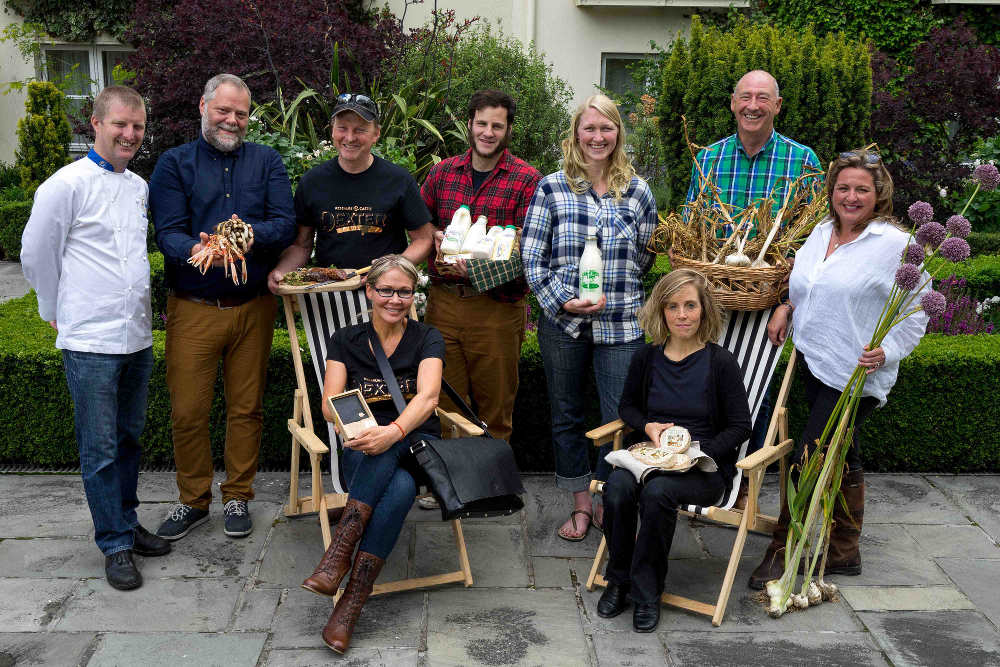
Georgina Campbell
Held annually to recognise and celebrate the very best food being produced in Ireland, the Euro-Toques Food Awards were established in 1996 by the members of the Euro-Toques Food Committee, based on an original idea by the legendary Myrtle Allen.
The Euro-Toques Food Awards honour those who produce food of notable flavour and quality. Put forward for consideration by the very chefs who use these exceptional products on their menus daily, the Euro-Toques Food Awards give Euro-Toques member chefs the opportunity to nominate the farmers, fishermen, and food producers who make it possible for them to create superb meals by providing them with the absolute best local produce.
Focusing on the foods and production methods that preserve the traditions and heritage of the Irish food, farming and fishing industries, each year Euro-Toques members are asked to nominate their favourite suppliers, creating a list that goes forward to the Euro-Toques Food Council, who then source those nominated products for tasting.
The committee arranges visits, gathers further information and then deliberates, putting a firm focus on flavour first, then how the product is made, what goes into it, what impact it has on the environment and a range of other consideration.
No producer can be in the running unless they have been nominated by a Euro-Toques chef who believes in and buys that product to put on their menu, nor can producers choose to enter the awards or canvass for consideration. This, Euro-Toques believes, is central to the integrity of these awards.
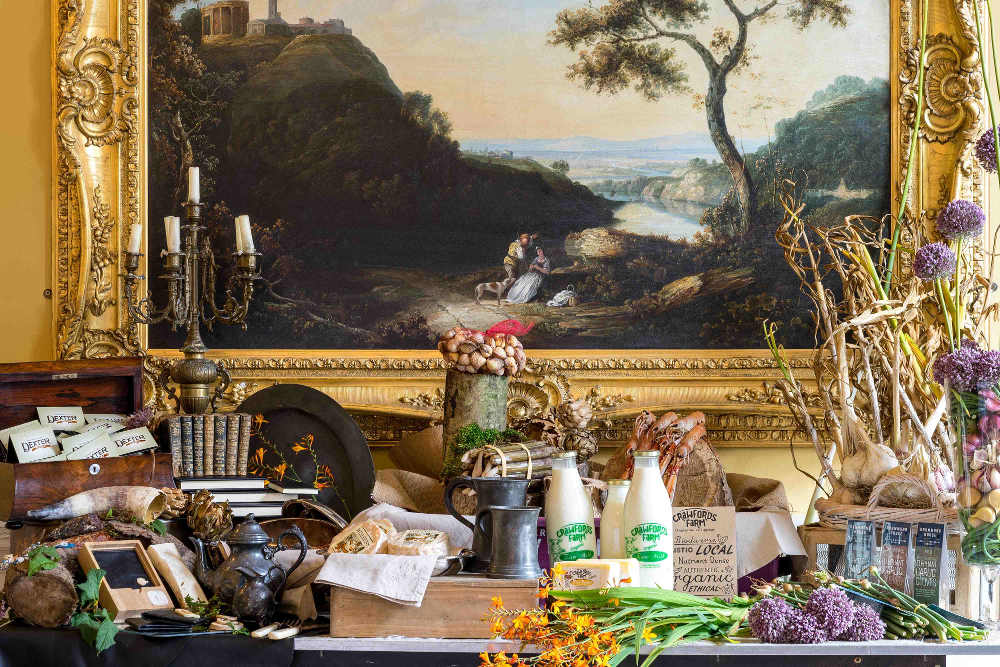
The 2017 Euro-Toques Food Awards winners are five superb producers, ranging from the professional, experienced team of fishmongers at Galway’s Gannet Fishmongers led by Stefan Griesbach who provide the best quality, best value, locally sourced, wild Irish fish to the sensational creamy raw milk from Mimi and Owen Crawford’s small herd of lovely red, white and roan pedigree Shorthorn cows (named Molly, Rosy, Penny, Lucy, Pepper, Ruby, Belle and Roxy!) from the lush pastures of their organic north Tipperary farm.
Also winners this year are the happy herd of over 600 Dexters that make up the heart of Eavaun Carmody’s Dundrum Dexter Beef, reared in a stress-free environment with the application of traditional farming techniques, who roam freely over the rich grasslands of South Tipperary. Eavaun also uses every part of the animal from bones to leather, creating beautiful artisan products and ensuring her business is zero waste, an important factor in her award win.
2017 Awards also went to Marita and Peter Collier’s innovative, tasty and intensely flavoured garlic grown from 800-year old heritage seed on their Co. Louth farm, Drummond House Garlic, and the forward-thinking Becky and Charlie Cole at Broughgammon Farm in Co. Antrim for their delicious and healthy cabrito kid goat meat.
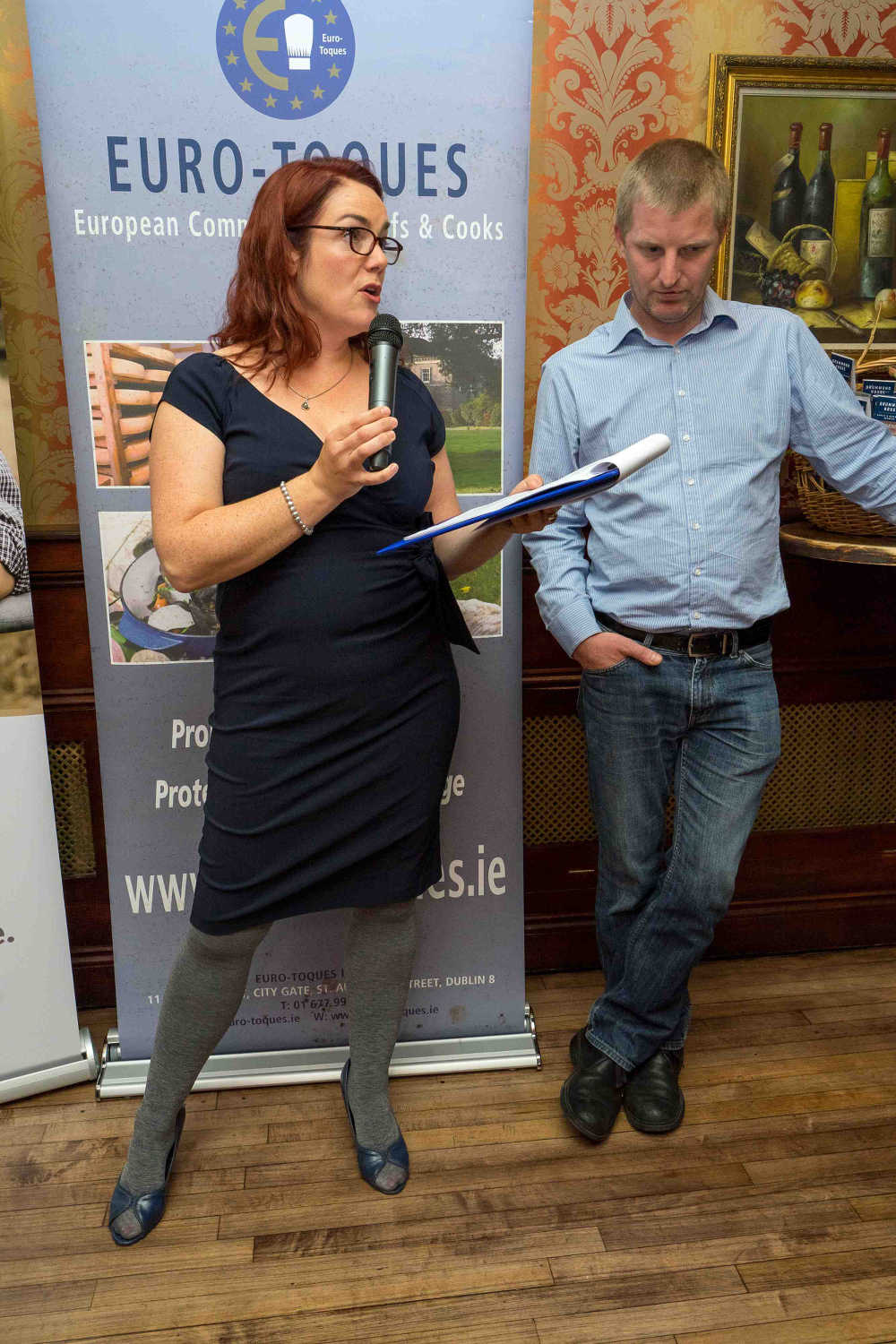
A special commendation honouring her contribution to the Irish farmhouse cheese industry was awarded to the late Veronica Steele of Milleens Cheese who died last year, accepted on her behalf by her son Quinlan Steele. A trail-blazer and the longest established producer of artisan cheese in the country, Veronica Steele almost single-handedly put Irish cheese on the international map. Generous with her time and expertise, Veronica made a significant contribution to the renaissance of farmhouse cheese-making in Ireland which greatly enhanced the country’s reputation as a food nation.
Presented at Hugo’s of Merrion Row by journalist and Chairperson of the Irish Food Writers’ Guild, Aoife Carrigy, with Euro-Toques Commissioner General Graham Neville and other representatives of Euro-Toques, the Awards are sponsored by EirGrid, operator of the national electricity transmission system
Natural Born Winners at the IFWG Food Awards 2018
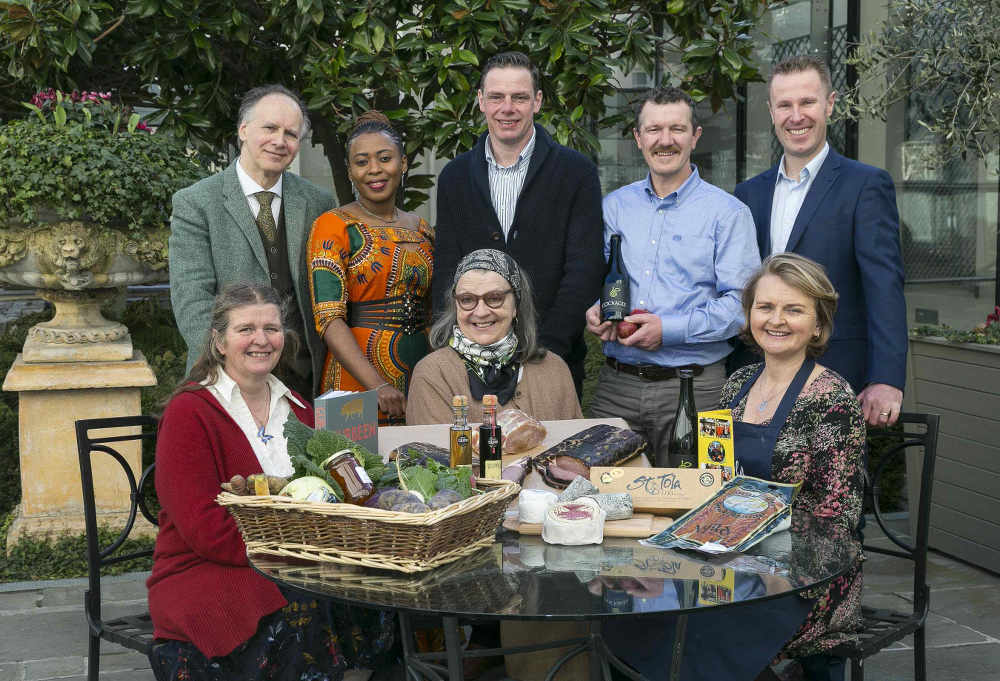

Now in their 24th year, the Irish Food Writers’ Guild (IFWG) Food Awards celebrate organisations and food producers who create, make and share great Irish produce and products while helping to develop Ireland’s growing international reputation in food and drink.
New to these awards this year is a Community Food Award, which highlights an organisation or individual working with food that has embraced an ethos of social responsibility to an exemplary level.
“Unprocessed, naturally sourced ingredients are the foundation upon which Ireland’s reputation for culinary excellence is built,” said Guild chairperson Aoife Carrigy at the 2018 IFWG Food Awards earlier this month. “The winning produce showcases the abundance of natural ingredients that is being cultivated from the Irish landscape. All of the award-winning products display a noticeable lack of additives and each producer uses traditional processes to preserve the integrity and the inherent flavour of the ingredients that they are working with.”
The awards were hosted at two-Michelin-star Restaurant Patrick Guilbaud, marked with a lunch devised and prepared by chef and co-owner Guillaume Lebrun, who incorporated the produce of each winner into a celebratory menu.
The 2018 IFWG Food Award winners are:
• Food Award: Connemara Smokehouse Smoked Mackerel, Co. Galway
Owned and run by the Roberts family since 1979, Graham Roberts and his wife Saoirse manage all aspects of the Connemara Smokehouse from its remote location on the west coast of Ireland. Selling to customers all around the world, their hot-smoked, delicately flavoured mackerel was honoured at this year’s awards. www.smokehouse.ie
• Food Award: Wildwood Balsamics range, Co. Mayo
In 2016 Mayo-based painter Fionntán Gogarty established Wildwood Balsamics to continue selling the fruit- and herb-based vinegars he has been making all his life. Fionntán now supplies more than 20 stores around the country and with 18 individual flavours and a growing range of blends, Wildwood Balsamics offer a unique and sustainable taste of Irish terroir. www.wildwoodvinegars.com
• Food Award: Baltimore Bacon, Co. Cork
A specialist plasterer turned free-range pig farmer in 2014, Nathan Wall of Baltimore Bacon now sells produce from his own pigs at weekly farmers’ markets in Bandon and Clonakilty, as well as locally reared pigs for his non-free-range bacon sold to retailers and restaurants. The range includes smoked and unsmoked bacon and ham, all of which are produced naturally, free from nitrates and additives.
• Irish Drink Award: Cockagee Pure Irish Keeved Cider, Co. Meath
Mark Jenkinson of The Cider Mill is dedicated to reviving ancient cider traditions from his organic farmhouse orchards outside Slane, Co. Meath. The only cider producer in Ireland to practise keeving, a traditional and fully natural fermentation process, he produces just 20,000 litres of Cockagee Pure Irish Keeved cider a year. www.cockagee.ie
• Organisation Award: McNally Family Farm, Co. Dublin
In the 20 years that Jenny McNally has been selling her organic farm produce at Dublin markets, she has become a local hero for many of the capital’s food lovers, including the growing number of cafés and restaurants with whom she now works. All produce grown at the McNally Family Farm is picked the day before each market, ensuring the longest possible shelf life and highest possible nutrient density. www.mcnallyfamilyfarm.com
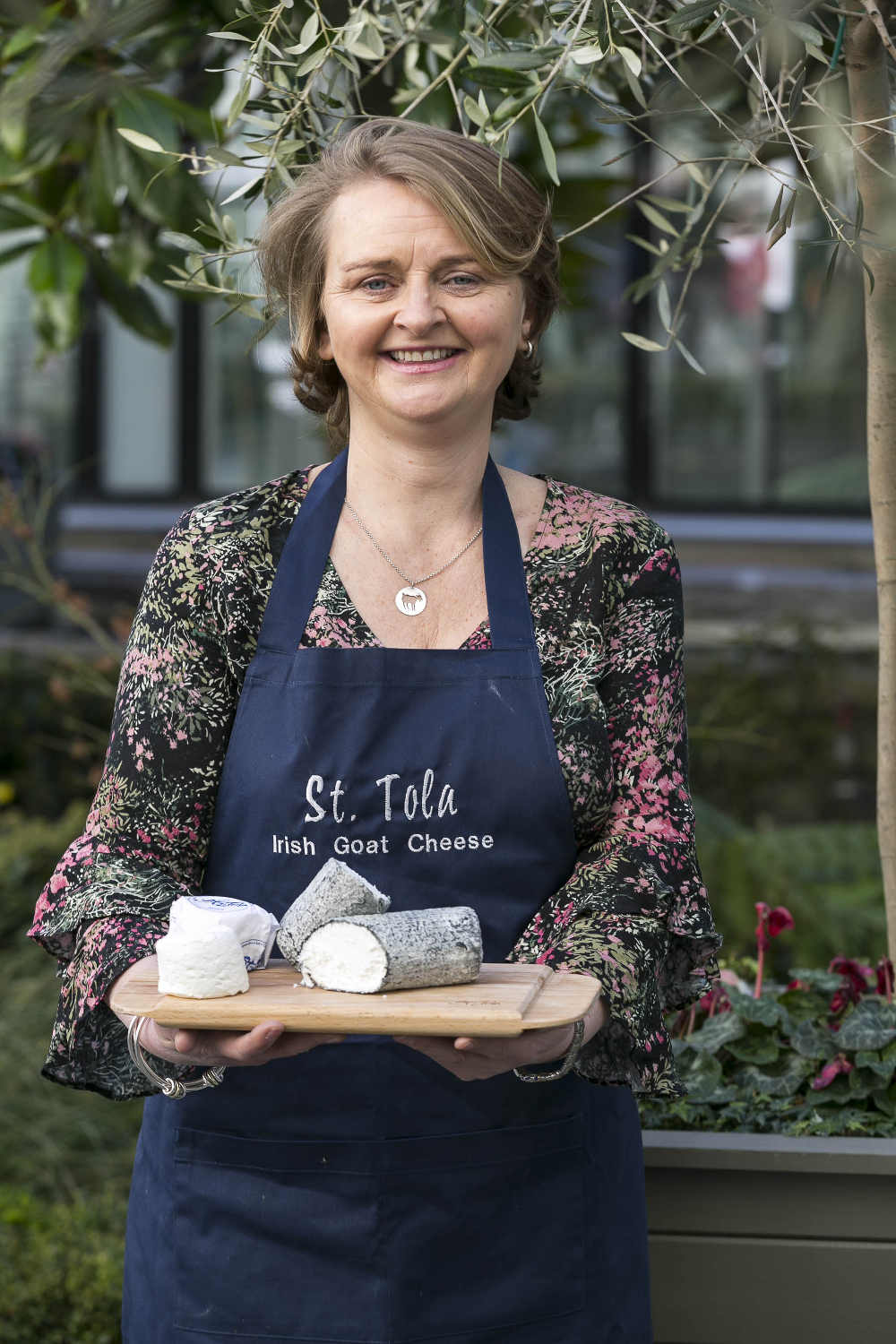
• Environmental Award: Inagh Farmhouse Cheese (St Tola Irish Goat Cheese), Co. Clare
Producing St Tola Goat Cheese on a 60-acre family farm on the edge of the Burren, Siobhan Ni Ghairbaith and John Harrington have implemented a comprehensive sustainability programme for nearly 20 years. The couple actively promote the principles of conservation and responsible farming, helping to educate and inspire the general public. www.st-tola.ie
• Lifetime Achievement Award: Ferguson Family of Gubbeen Farmhouse, Co. Cork
From their 250-acre coastal farm just outside Schull, west Cork, the Ferguson family of Gubbeen Farmhouse have been farming and producing food since the 1980s. Each member of the family has their own area of expertise and together they are one of the finest examples Ireland has of the contribution that can be made to a national food culture by a few dedicated individuals. www.gubbeen.com
Presented with the support of Slow Food Ireland, who are celebrating their 20th anniversary this year, the 2018 IFWG Community Food Award was presented by Hermione Winters, President of Slow Food Ireland:
• Community Food Award: Sligo Global Kitchen, Co. Sligo
Founded in 2014, Sligo Global Kitchen hosts communal meals for people living locally in direct provision and the general public. Artist Anna Spearman approached Cameroonian Mabel Chah to liaise with other residents in direct provision. The result is Sligo Global Kitchen, which is a proactive way of building links by facilitating people to celebrate each other’s food culture.
“The winners of this year’s awards give a great sense of what Ireland’s best food producers can achieve with the island’s ‘raw materials’: flavours that are sometimes bold, sometimes subtle, but always pure and natural in their expression from our fields, orchards, hedgerows, mountains and waters. The Guild is proud to champion these artisanal producers from all over the country,” said Aoife.
Note: The IFWG Food Awards are unique, as no one can enter themselves or their product into the awards and no company knows it has been nominated or shortlisted for an award. The Guild is the sole nominating and decision-making body. The exception to this is the Community Food Award, for which the Guild invites nominations every year from the general public as well as their own members.
Show me all Article

